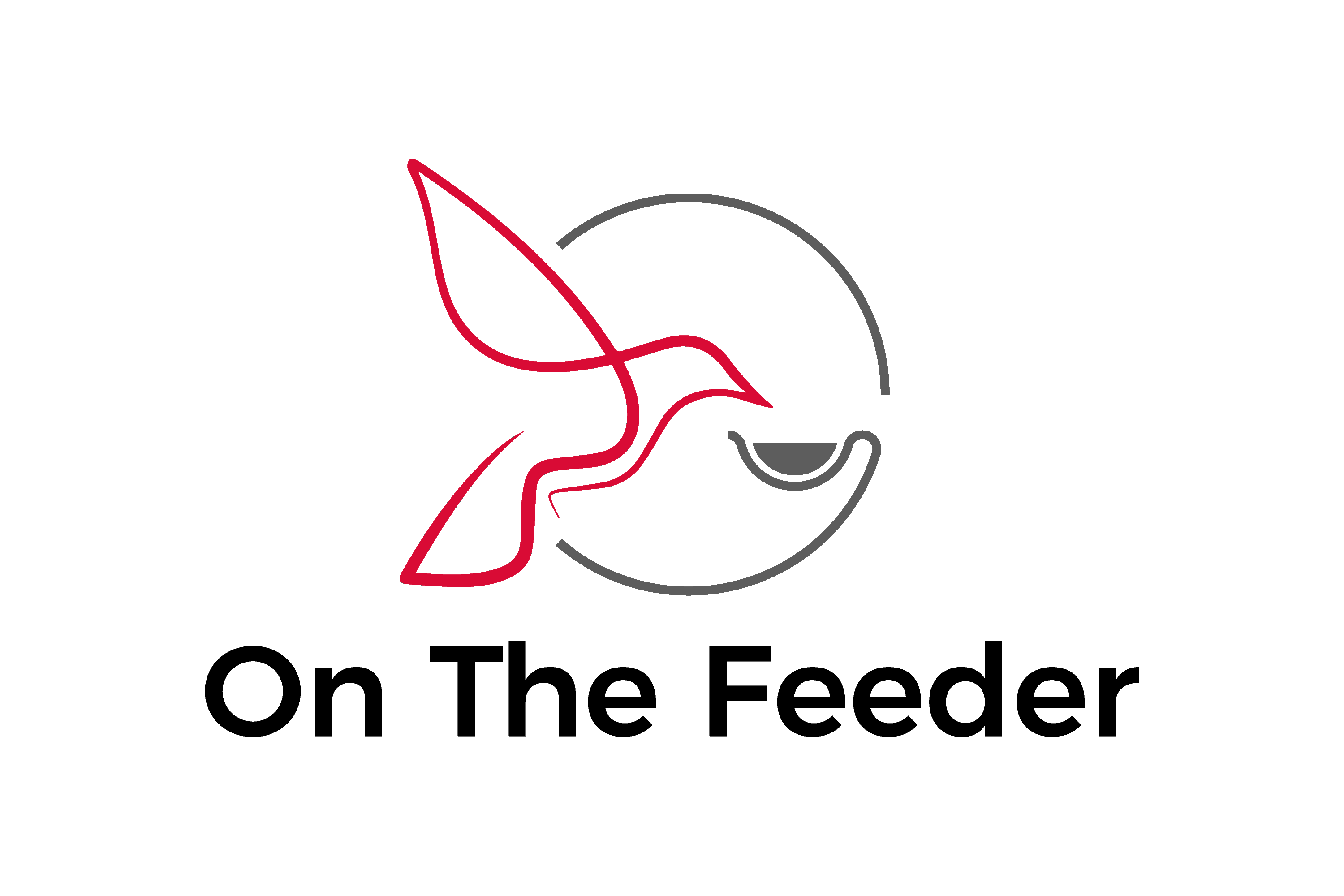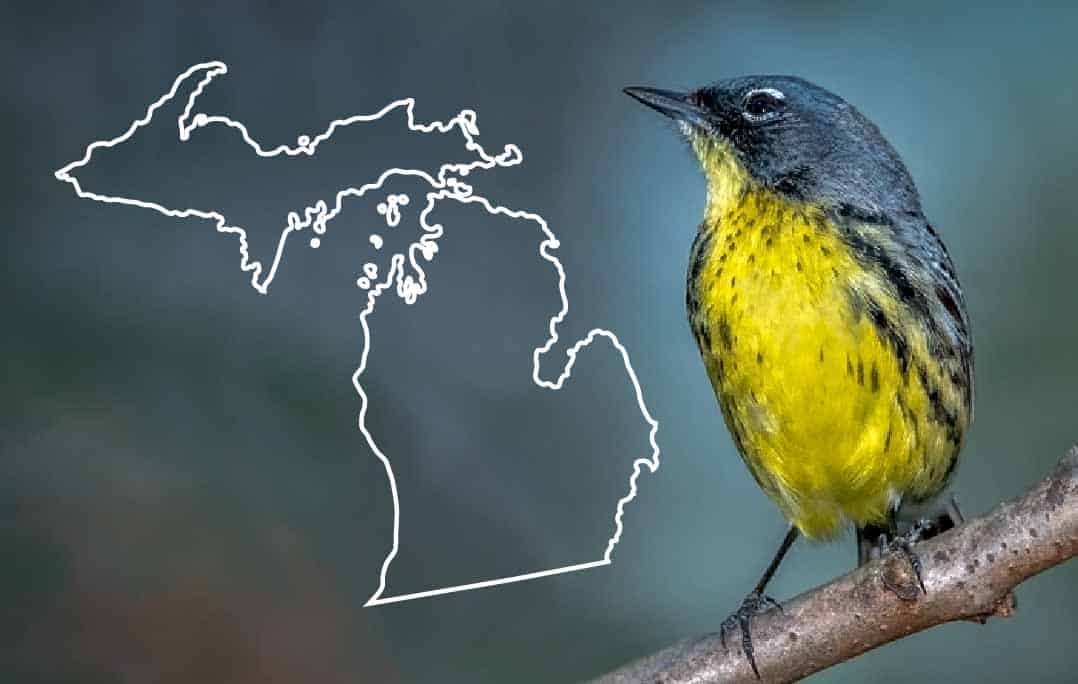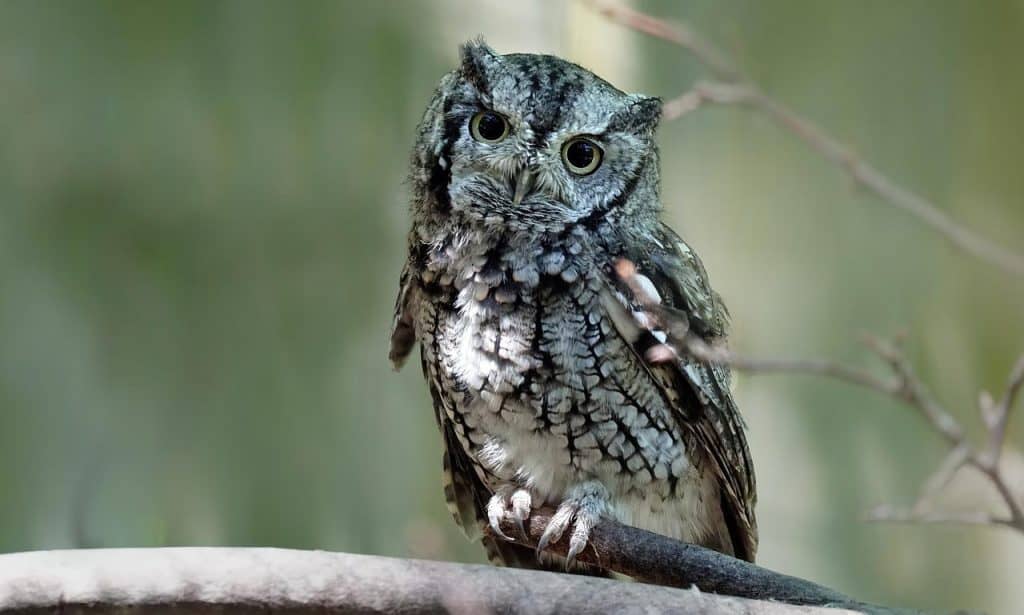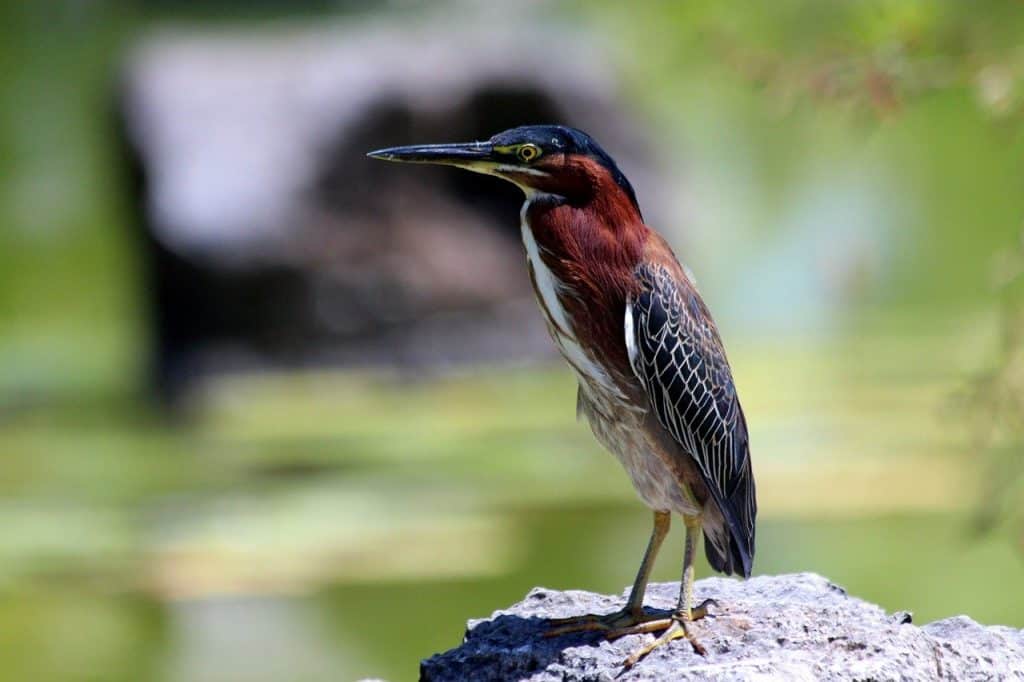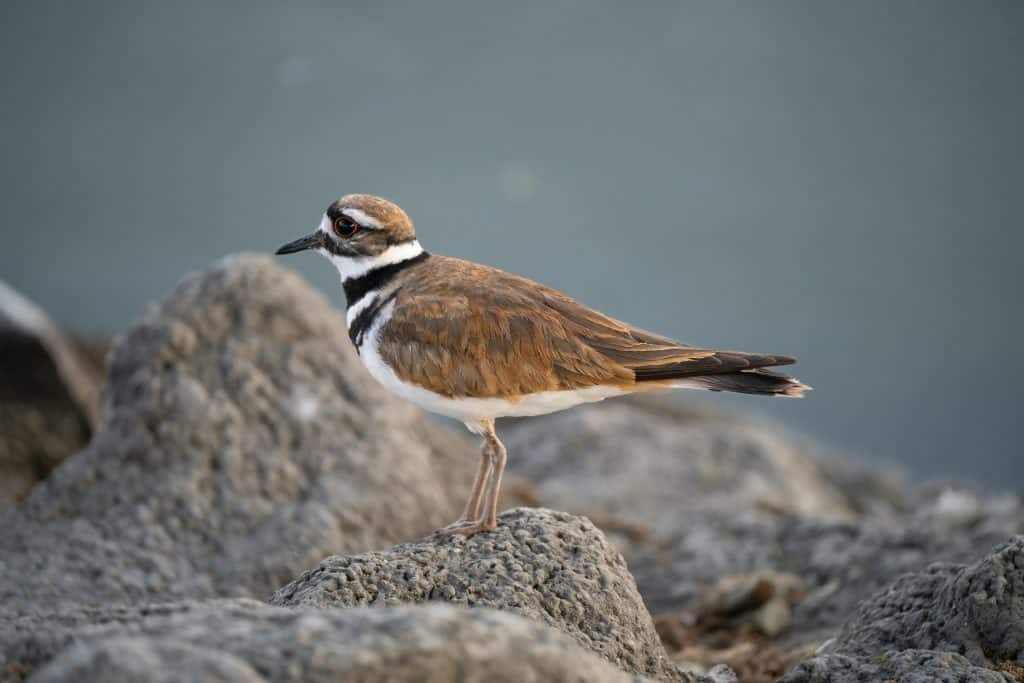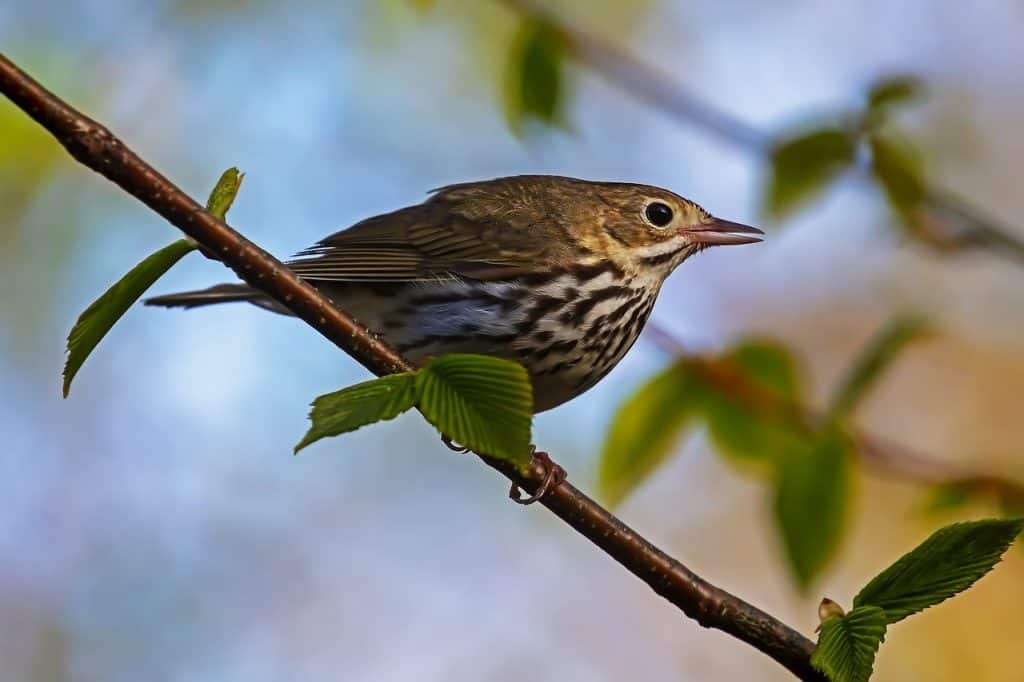Inside: List of birds in Michigan plus a color photo of each bird, details about habitat, diet, appearance, nesting habits, and a range map for accurate and fast identification.
You spotted a bird in Michigan – but what type is it? There are more than 80 species of birds in Michigan to enjoy and I’ve included them all in this complete list of Michigan birds.
With more than 20 years of experience attracting backyard birds to my yard in Wisconsin, I’ve studied many of the birds in my area, many of which can also be found in Michigan, so I have the information you’re looking for. For the remaining species, I rely on my field guides and friends at The Cornell Lab of Ornithology to guide me.
This article includes the species of wild birds in Michigan you might find in and around your backyard (excludes waterfowl). They could be red, blue, brown or some other color. They could be tiny, small, medium, large, or enormous – all size variations are here! Some wild birds live in Michigan year-round, others are here to breed, and others are just migrating through. The range maps are color-coded so you know if it’s a year-round bird, there to breed, migrating through, or there during a nonbreeding time.

I also included a beautiful closeup photo to help you identify your new feathered friends along with detail such as:
- Size + appearance description
- Diet in the wild and at the feeder
- Habitat
- Nest & eggs description
- Range map
My hope is that this article will help you easily identify the bird you saw or plan to see one day.
If it’s a blue-colored bird in Michigan you’re trying to identify, check out Blue Birds in Michigan.
American Crow
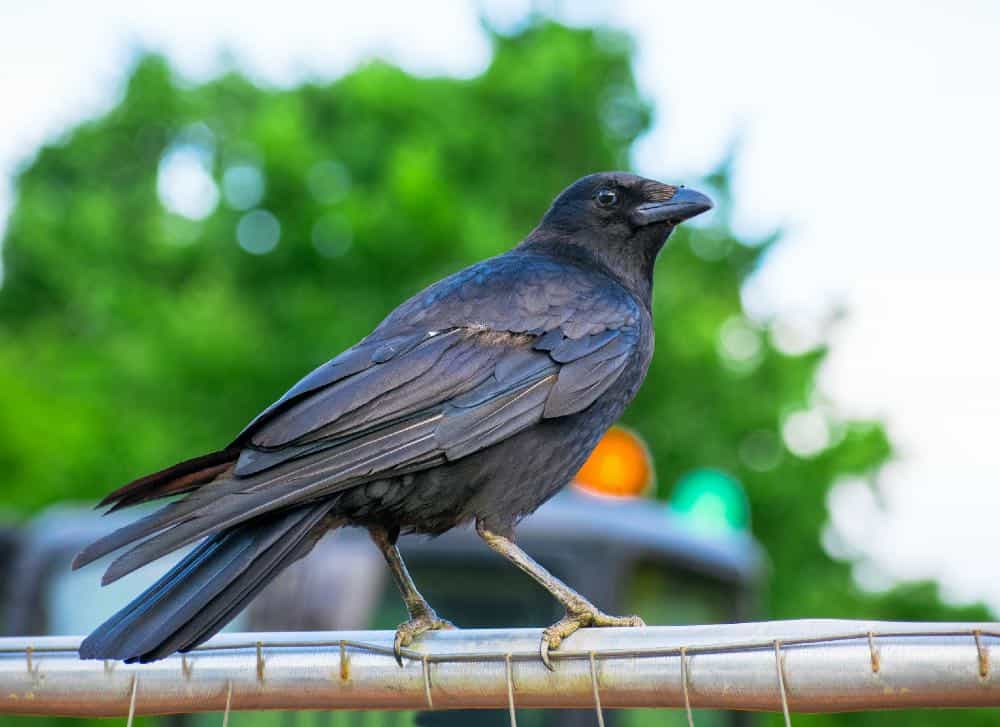
Appearance: Large all-black bird about 16-20″ long, wide neck with a long straight bill. Males and females have the same appearance.
Diet: Opportunistic scavengers eat just about anything they can find on the ground – especially garbage. Natural living fare includes insects, spiders, frogs, snakes, and other birds’ eggs & young.
Feeder food: Not likely to visit a feeder.
Habitat: American crows are common birds found in every contiguous US state and most of Canada. Types of habitat include fields, open wooded and forested areas, river edges, shores, towns, cities, parks, and more. The only place you won’t find them is in the hot desert.
Nesting:
- Nest: Builds nests in a large shrub or tree as high as 20′
- Broods: 1-2 broods/season
- Clutch: 3-9 eggs per brood
- Egg color: Ranging from brighter blue-green to a dull green or blue-gray with heavy gray and brown blotching
- Egg size: 1.4 – 1.9 inches by 1 inch
- Incubation: Both parents incubate the eggs for about 18 days.
Migration: American crows are migrators.
Year-round range: The American crow’s year-round range includes every US state except North Dakota and the pacific coast of Canada’s British Columbia.
Breeding range: While some northern flickers remain in their year-round range to breed, many others migrate north into Canada to raise their young – but only for a season.
Winter range: American crows migrate south back to their year-round range for winter while some move further south to Nevada, Utah, New Mexico, and western Texas.
Range Map
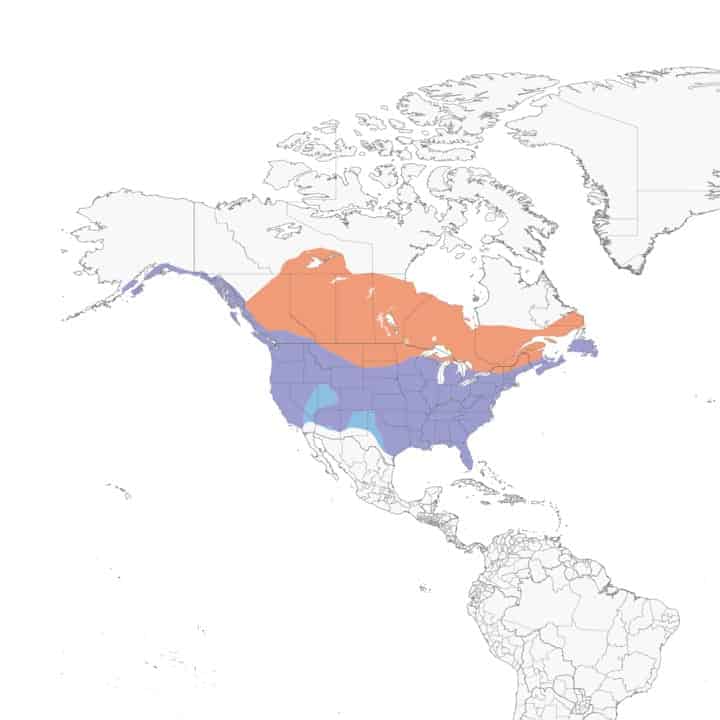
American Goldfinch
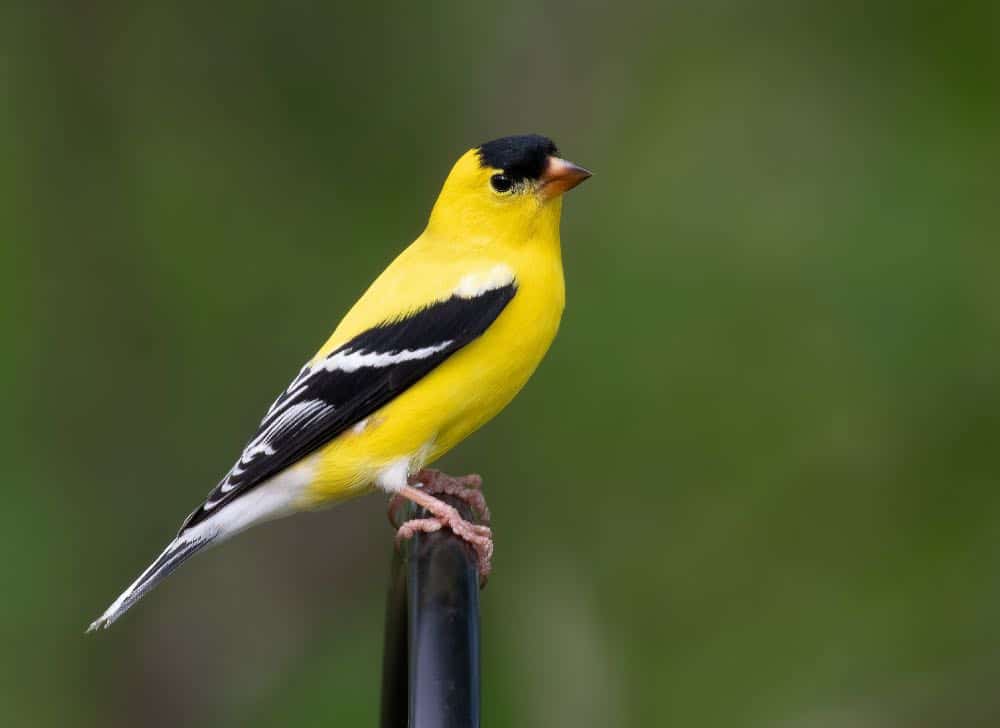
Appearance: The American goldfinch is a small bird about 4.5″ long, bright yellow body, black wings with white stripes, a black forehead, short orange beak. During winter has a dingy brown body, duller yellow head, and thicker white stripes on its wings. Breeding females are similar to males except their bodies are lemon yellow and their wings have more white tips
Diet: Seeds from flowers, weeds, grasses, and small trees. Some insects.
Feeder food: Thistle seed (Nyjer)
Habitat: American goldfinch is a common bird throughout the contiguous US and southern part of Canada. Weedy fields, roadsides, orchards, and backyards.
Nesting:
- Nest: American goldfinches build their nest in a deciduous shrub or tree, sometimes conifers, placed on a branch’s fork as high as 20′.
- Broods: 1-2 broods/season
- Clutch: 2-7 eggs per brood
- Egg color: Very pale blue to white, occasionally faint brown spots on the larger end.
- Egg size: 0.5 inches by 0.5 inches
- Incubation: The female incubates the eggs for about 12-14 days while the male brings food to the female.
Migration: American goldfinches are partial migrators. Many remain in their year-round range for all seasons of the year while others migrate north to breed in spring and then migrate south for the winter.
Year-round range: Washington, Idaho, Oregon, Montana, Wyoming, Nevada, Utah, Colorado, Kansas, Nebraska, Oklahoma, and the remaining US states to the east and south (except Florida).
Breeding range: Northwest Washington, Montana, North Dakota, South Dakota, Kansas, northern Minnesota & Michigan, as well as the southern Canada provinces.
Winter range: Western Oregon, California, southern Nevada & Utah, Colorado, Arizona, New Mexico, Texas, southern Louisiana, Mississippi, Alabama, Georgia, South Carolina, and the state of Florida.
Range Map
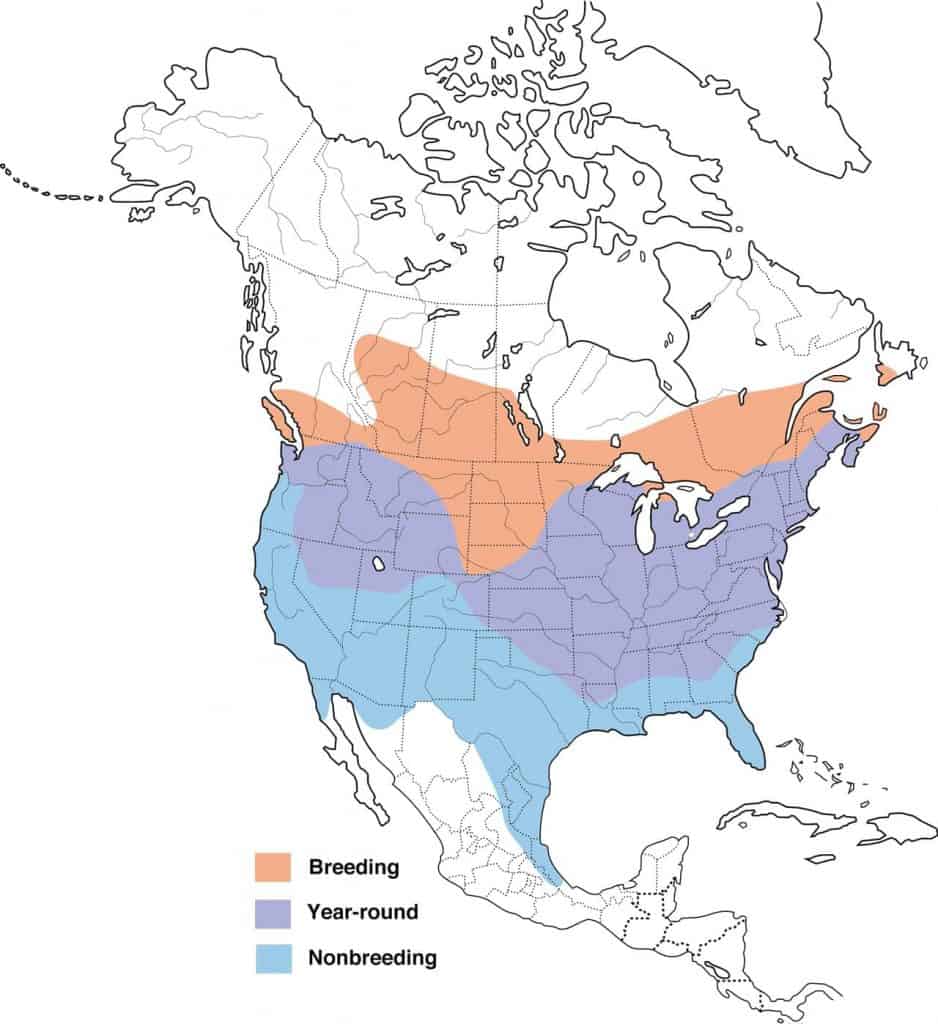
American Kestrel
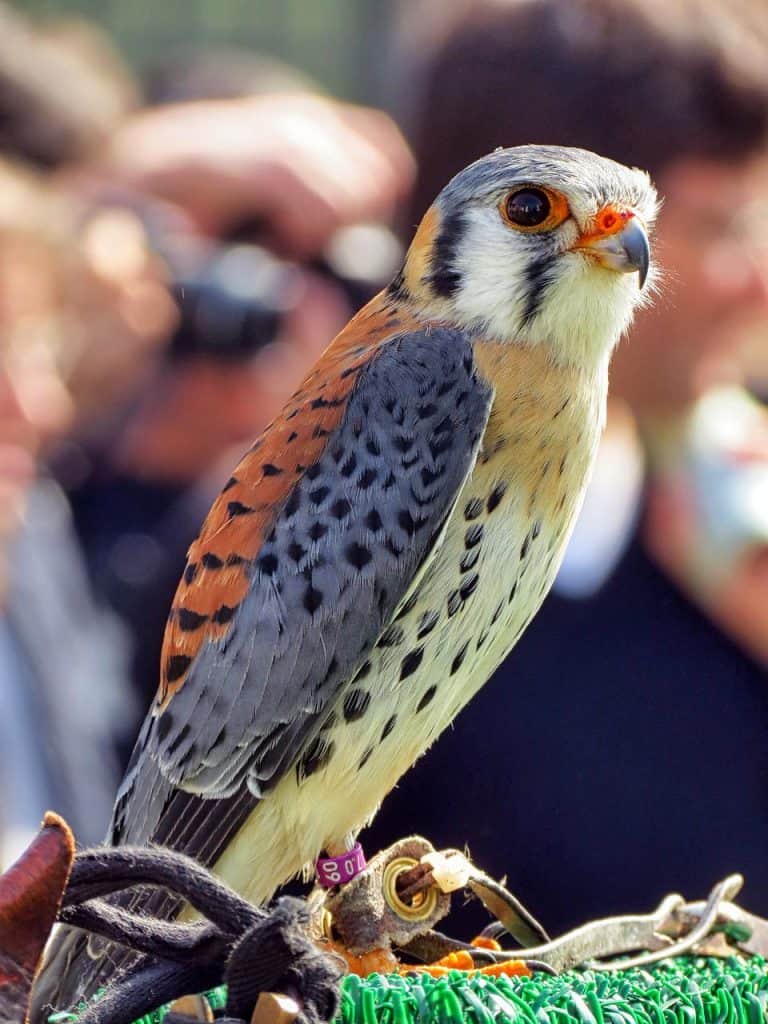
Appearance: The American kestrel is a small raptor at about 10 1/2″ in length. They have blue/gray wings, cinnamon back with black bars, cinnamon tail with a black bar near the tip, and tan underneath with dark spots. The female is the same except she has reddish-brown underparts and a tail with dark bars. And, her underparts have reddish streaks.
Diet: Large insects, lizards, rodents, and small birds.
Feeder food: They don’t visit feeders.
Habitat: Open areas especially rural and suburban fields.
Nesting: American kestrels nest in an old woodpecker hole or some other natural cavity. They have 1-2 broods/season and 4-5 eggs/brood. Eggs are white-yellow or light brown with spots. Incubation is for 29-30 days and fledglings leave the nest at 28-31 days.
Migration: American kestrels are migrators.
Year-round range: All US states except Montana, Wyoming, North Dakota, South Dakota, Minnesota, Wisconsin, Michigan, and Maine.
Breeding range: Canada and Alaska.
Winter range: While some American kestrels migrate south to southern Texas, Louisiana, and Mexico, many remain in their year-round range when the snow flies.
Range Map
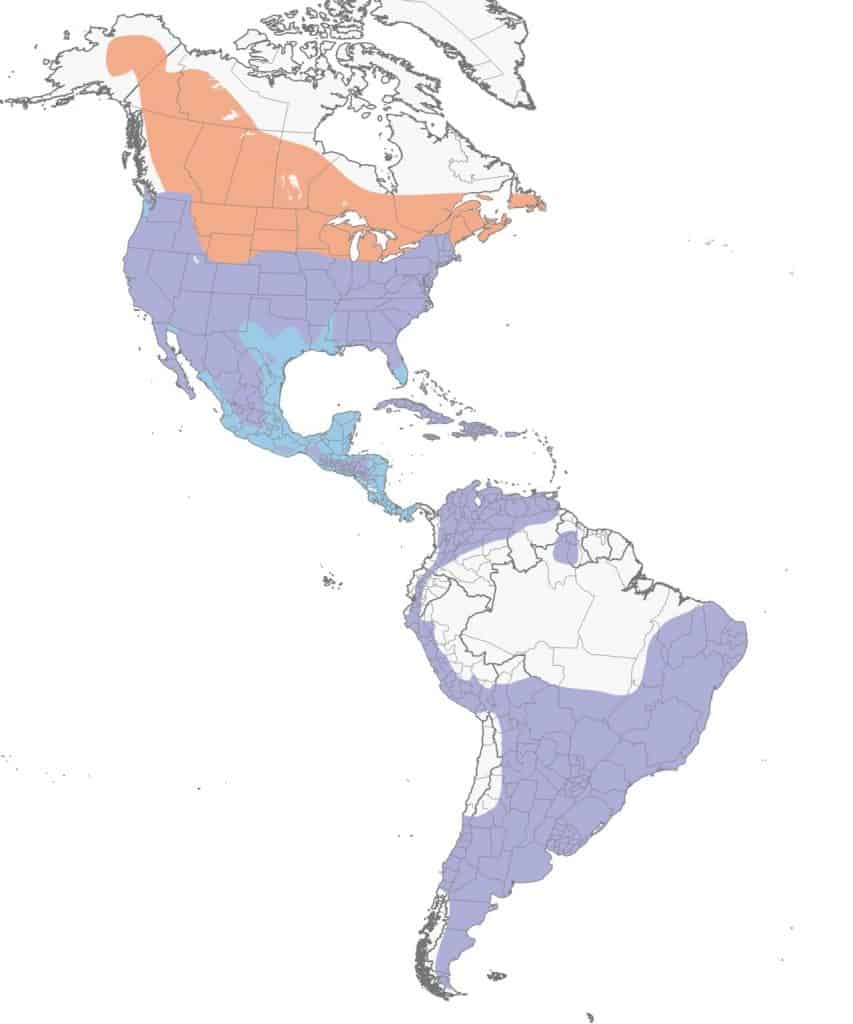
American Redstart
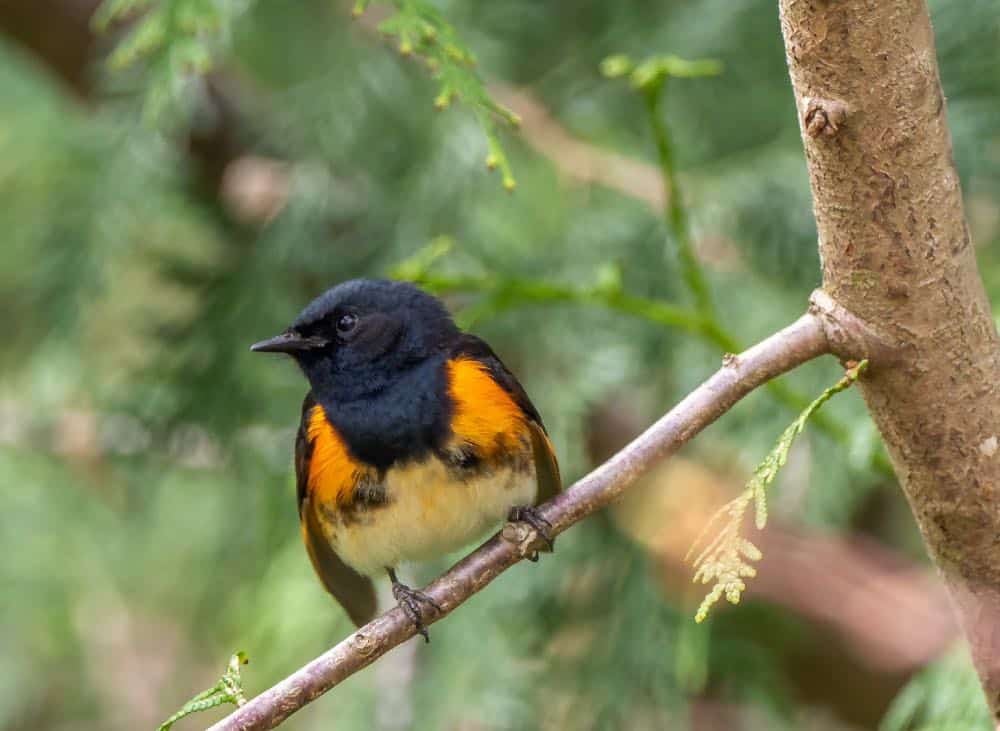
| Appearance | Medium-sized bird about 4.5-5″ long, mostly black, white belly, orange stripes and patches on the tail, wings, and side. Female have soft gray head, olive back and sings, white belly and yellow/orange stripes & patches on the tail, wings, and side. |
| Diet | Insects, small berries and fruits from shrubs. |
| Feeder Food | Unlikely to visit a feeder. |
| Habitat | Found in every contiguous US state and parts of Canada. Prefers open wooded areas especially those with deciduous trees. |
| Nesting | 1-5 eggs, eggs are white with brown or reddish spots, incubation is 10-13 days. |
Range Map
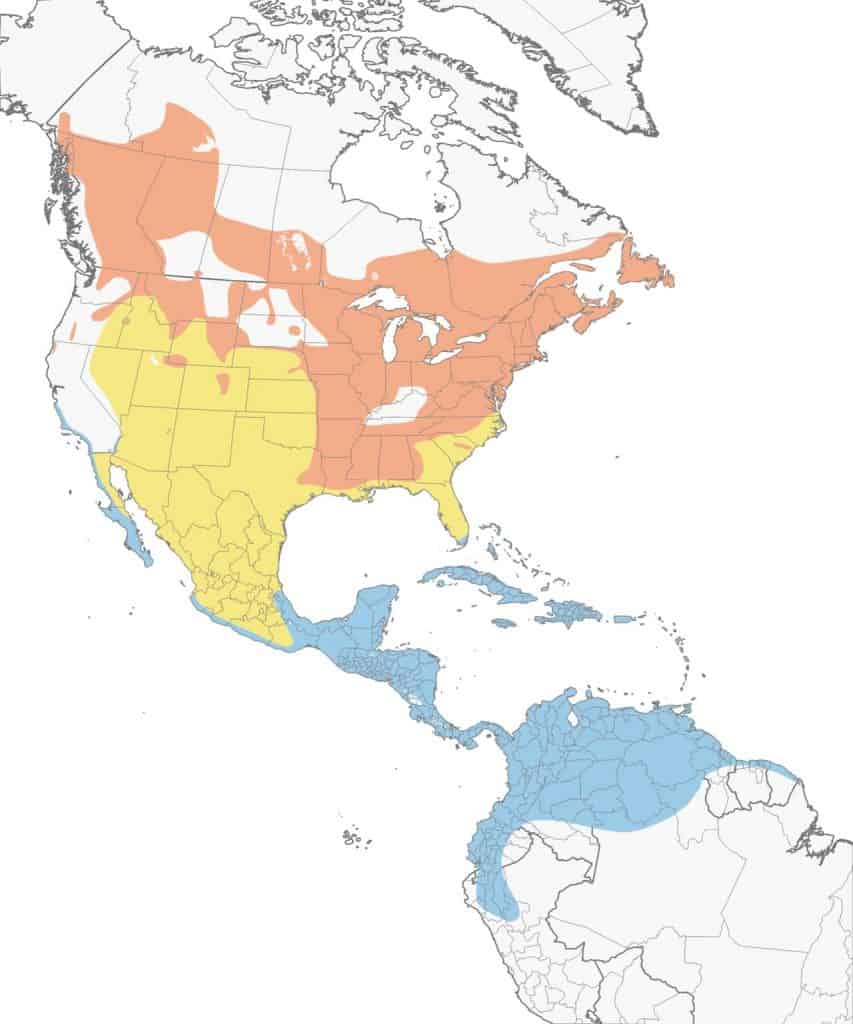
American Robin
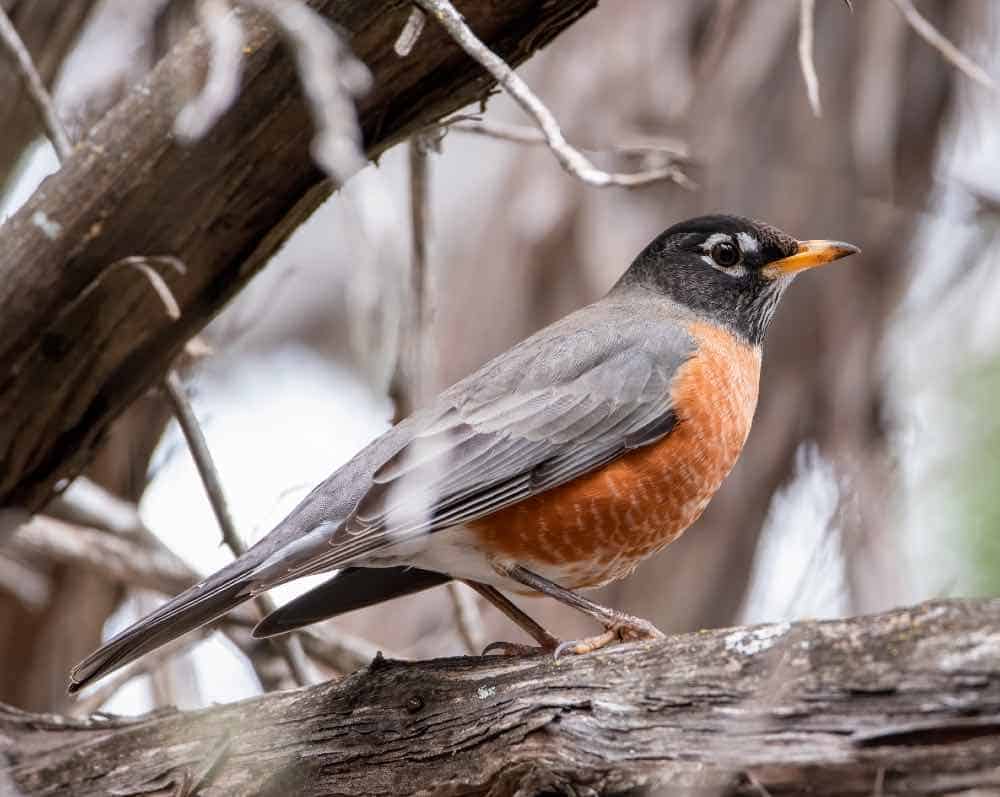
Appearance: The American robin is a medium-size bird about 10″ long, with gray/brown upper, brown/orange underparts, yellow beak, white chin, and white surrounding eyes. orange beak. The Female has a lighter head and underparts.
Diet: Earthworms, insects, and fruit.
Feeder food: Not a feeder visitor.
Habitat: Common and pervasive throughout US and Canada. Found in fields, parks, wooded and forested areas, mountains, and backyards.
Nesting:
- Nest: Nesting sites vary from the lower half of a tree to rain gutters, outdoor lights, and more.
- Broods: 1-3 broods/season,
- Clutch: 3-5 eggs/brood,
- Egg color: Bright sky blue or blue-green, without spots
- Egg size: 1.1″ long x 8″ wide
- Incubation: 12-14 days.
Migration: American robins are migrators.
Year-round range: Every US state except North Dakota, southern parts of Canada’s British Columbia, and Alberta, as well as Mexico.
Breeding range: Canada and Alaska.
Winter range: While most American robins head south back to the year-round range, others will go further into the far southern parts of Florida, California, Arizona, New Mexico, Texas, Louisiana, and Mexico.
Range Map
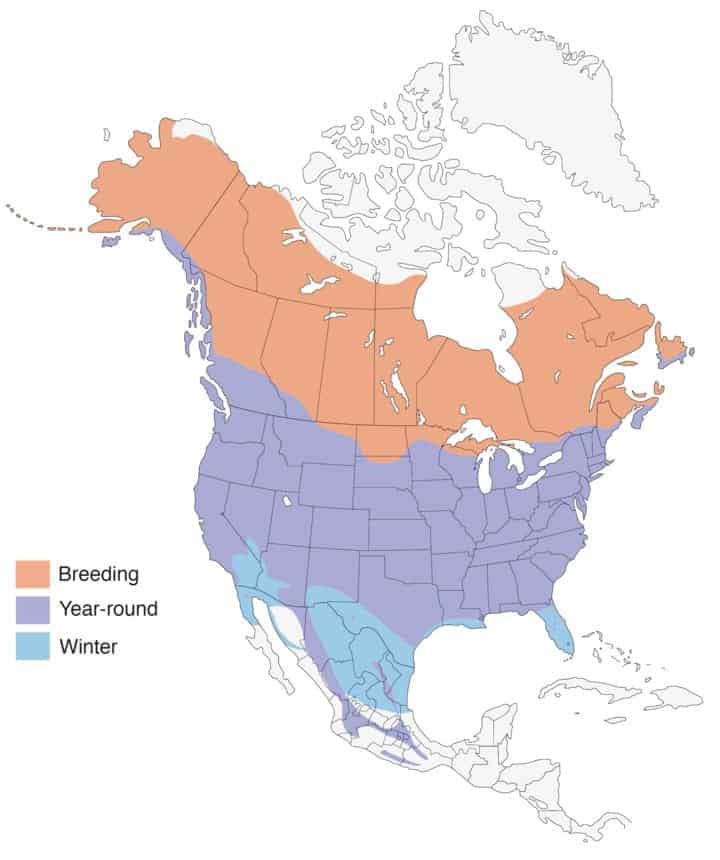
American Tree Sparrow
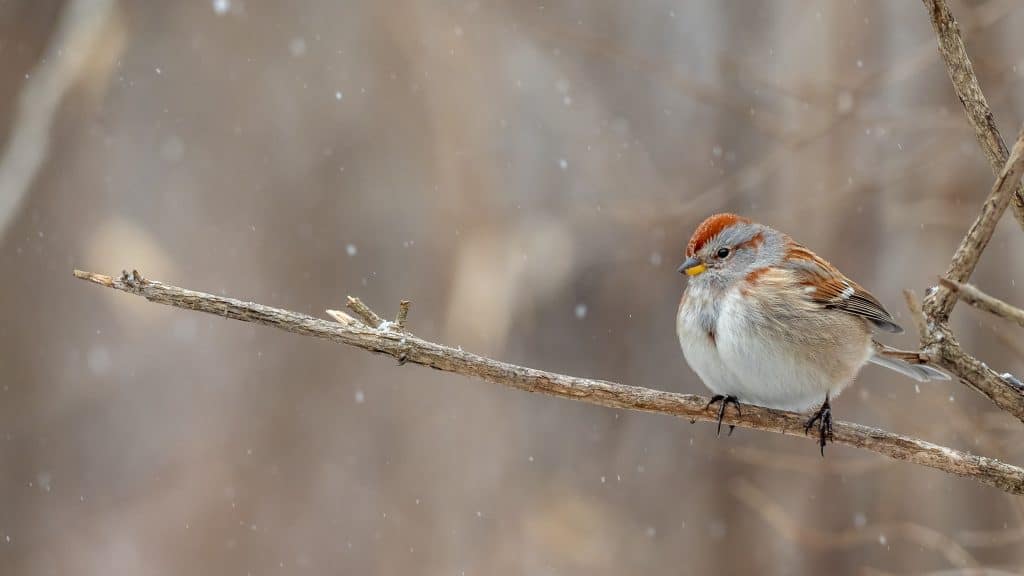
Appearance: The American tree sparrow is a small bird about 6″ long. It’s brown with a tan breast and rust-colored crown. They have a single black spot in the center of the chest, a dark upper bill, and a yellow lower bill. Eyes are accented with gray eyebrows. The female looks the same.
Diet: Insects, seeds.
Feeder food: Black-oil sunflower seeds, hulled sunflower seeds, nyjer, cracked corn, and peanut hearts.
Habitat: Wooded areas, especially on edges.
Nesting: A cup-shaped nest. They have 1 brood/season, 3-5 green & white eggs per brood with brown marketing. Incubation is for 12-13 days.
Migration: American tree sparrows are true migrators. In spring they migrate north to Alaska and the northern Canadian provinces to breed and raise their young. When fall comes they migrate south into every US state except Louisiana and Florida.
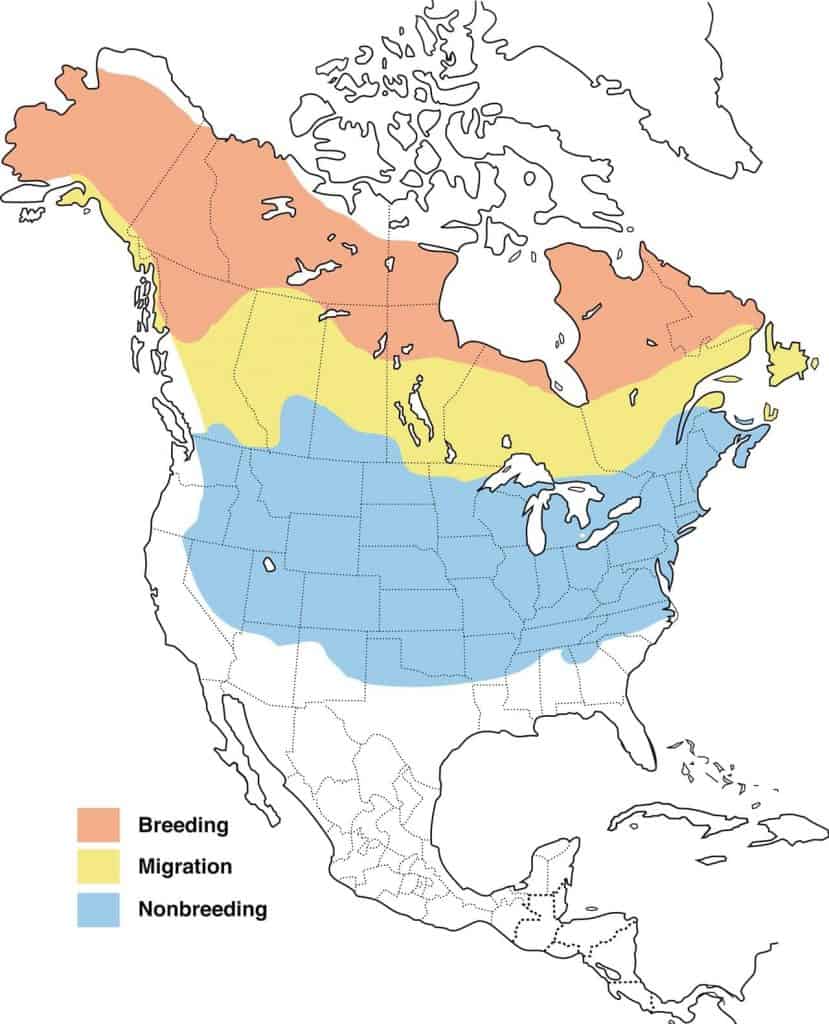
Bald Eagle
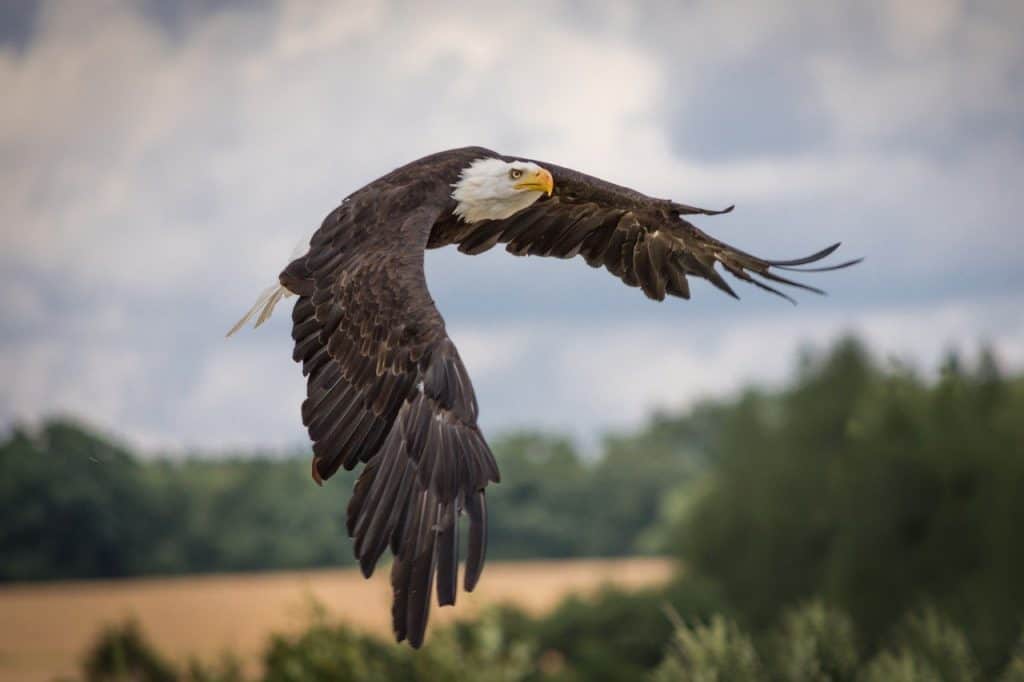
Appearance: The bald eagle is the United State’s national bird. It’s enormous at about 30-38″ in length with an equally impressive wingspan. They’re brown with a white head and tail, gold bill, and yellow eyes.
Diet: Bald eagles are opportunistic eaters but prefer fish. They’ll also eat small mammals, other birds, carrion (dead animals), and anything they can retrieve from the garbage.
Feeder food: Bald eagles do not visit feeders (Thank goodness!)
Habitat: Bald eagles are found year-round along the US east and west coast, in Canada during the breeding season, and throughout the US during winter. They prefer to be near lakes, rivers, marshes, and coasts so they can fish.
Nesting: Bald eagles build enormous nests – about 6′ in diameter and 3′ tall. Together the male & female gather materials including sticks and grasses. The female is the primary nest builder weaving the sticks with moss and other grasses and then lined with softer materials such as lichen and downy feathers. They have only 1 brood/year and 1-3 large ivory eggs. Incubation lasts for 56-98 days.
Range Map
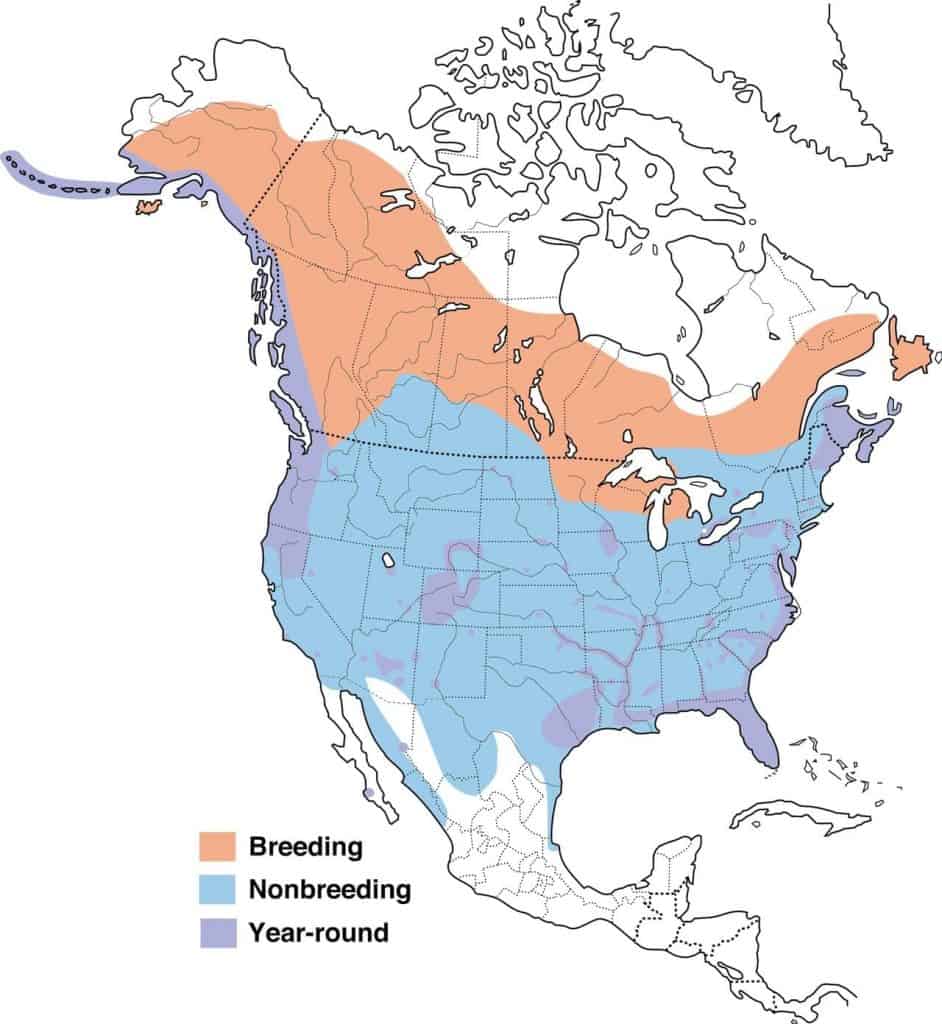
Baltimore Oriole
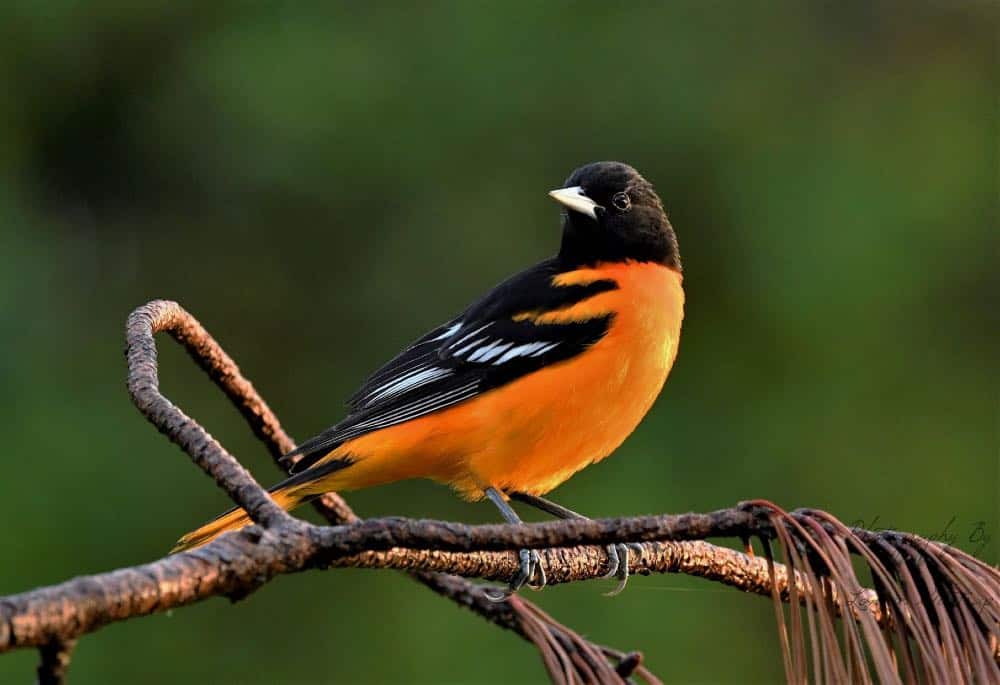
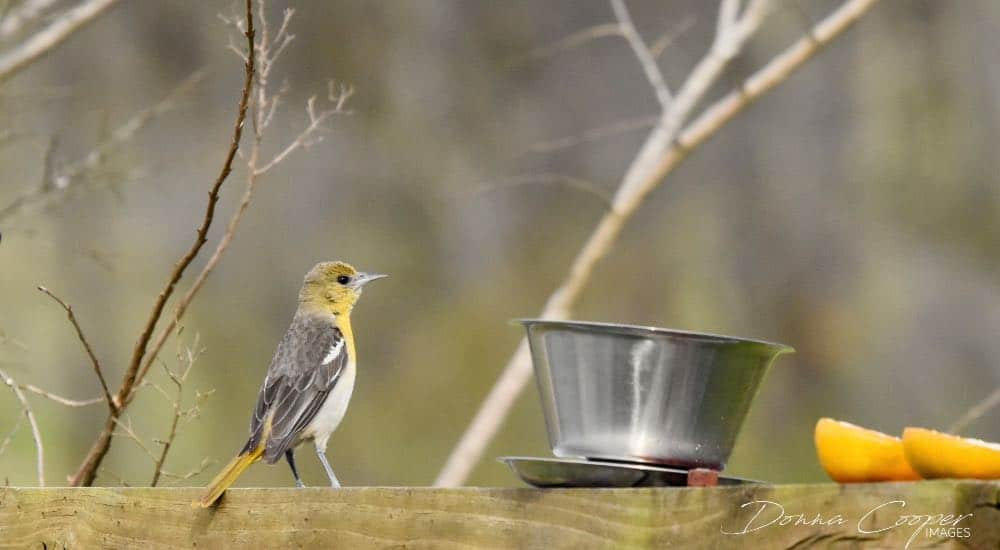
| Appearance | Medium-sized bird about 8.25″ long. Male Baltimore orioles have a flaming orange body and black head with black and white wing bars. The tail is orange with black and white streaks. The female and juvenile birds have pale yellow heads and bodies with grayish-brown wings and white wing bars. Both genders have a gray bill and dark eyes. |
| Diet | Insects, berries, and nectar from flowers. |
| Feeder Food | Baltimore Orioles will eat sweet foods such as nectar, oranges, and regular grape jelly. |
| Habitat | Baltimore orioles can be found in residential areas and wooded edges rich with high, deciduous shade trees – especially during breeding. They often nest near natural water sources such as ponds and rivers. |
| Nesting | The female builds a 4-6″ hanging long purse-style nest suspended on the end of a forked branch and only has one brood per year. About 4-5 bluish-colored eggs with brown markings are incubated for 12-14 days. |
Range Map
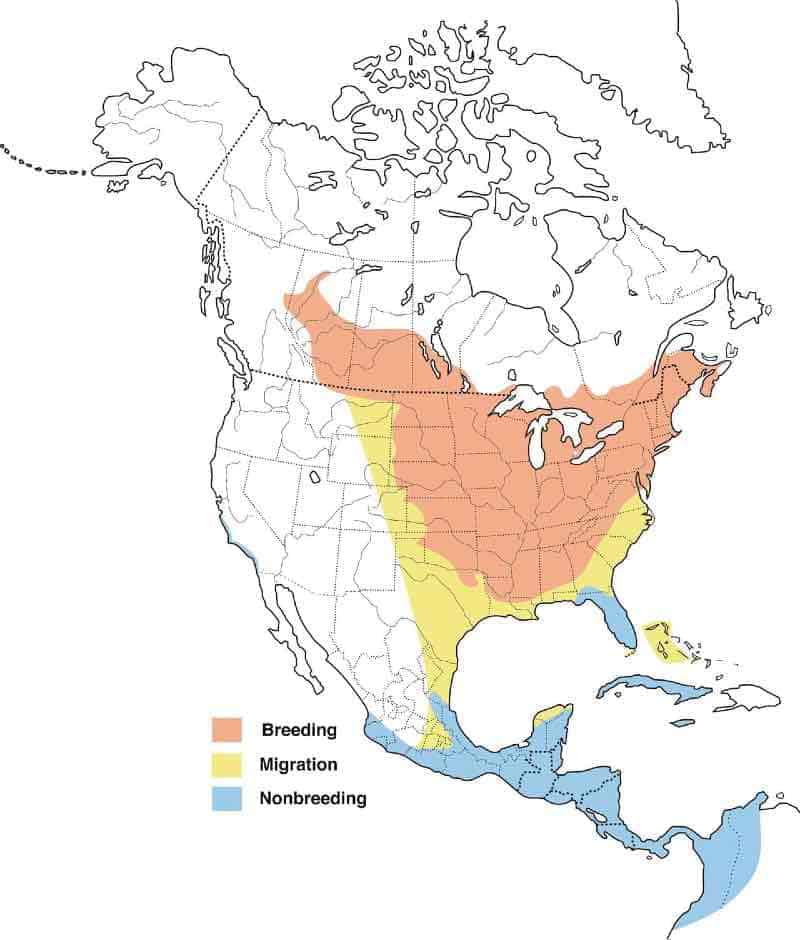
Barn Swallow
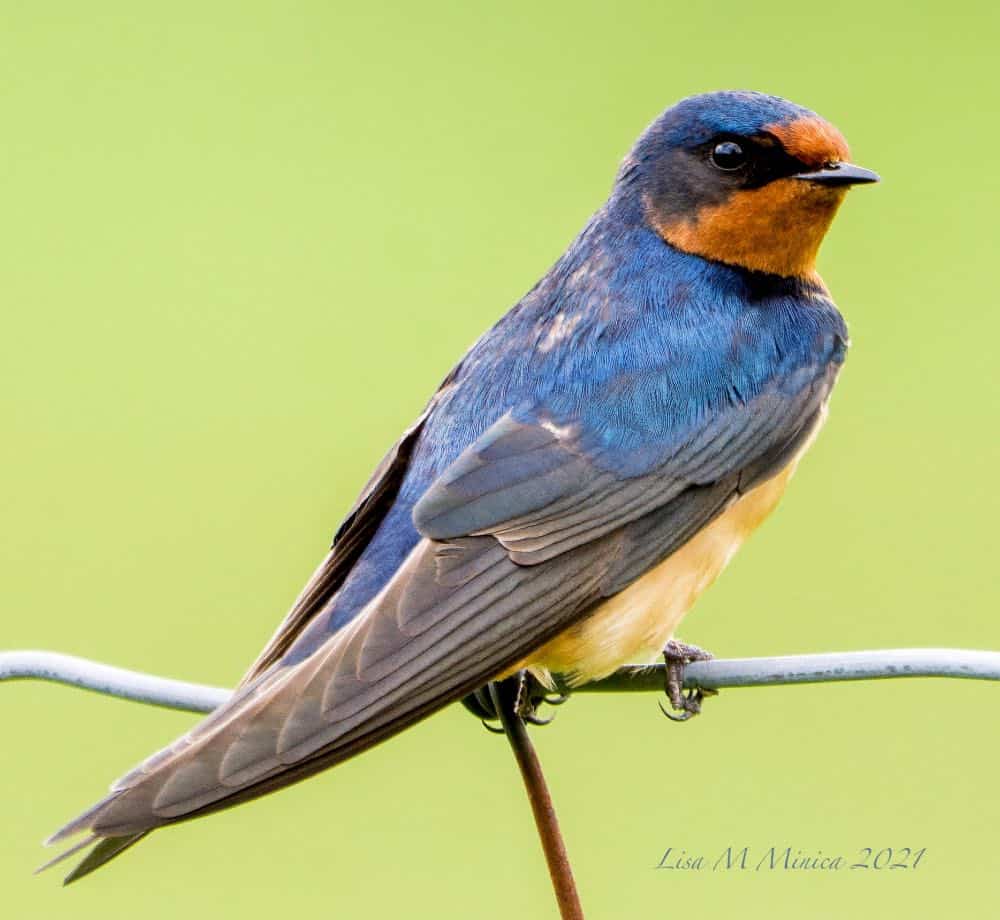
Appearance: 7″ long, steel blue glossy on top, chestnut forehead and throat, and rust-orange underparts. Long forked tail with a white base. The female’s coloring is lighter and the tail shorter.
Diet: Insects, preferably beetles, wasps, and flies. Drinks by skimming the surface of the water.
Feeder food: Not likely to visit a feeder.
Habitat: Open fields and pastures.
Nesting: A barn swallow typically nests in or on a manmade structure such as a barn. Builds nests of mud. 2 broods/season, 4-5 eggs per brood, eggs are white with brown markings, incubation from 13-17 days.
Migration: Barn swallows are migrators. In spring, they’ll migrate north into the US and Canada for breeding and to raise their young. When fall comes, they’ll head south to Mexico’s southern states. That said, they do maintain a year-round range in central Mexico where they remain for every season.
Range Map
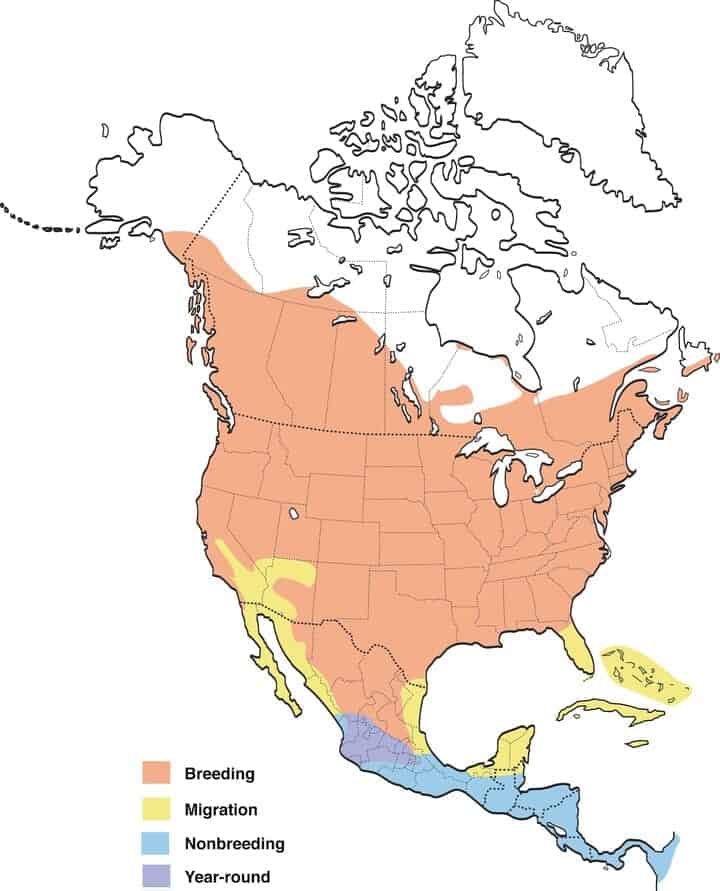
Barred Owl
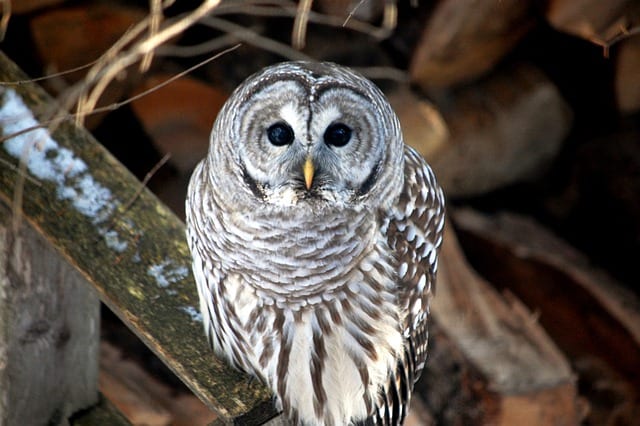
| Appearance | Barred owls are large birds about 21″ long. They have large round faces with dark eyes and yellow bills. They’re primarily brown with white spots on the upperparts and tan underneath with dark brown streaks. |
| Diet | As a bird of prey, barred owls eat small mammals, birds, reptiles, amphibians, fish, and large insects. |
| Feeder Food | Barred owls do not visit feeders. |
| Habitat | Mature forests, especially along side water sources like rivers and swamps in their southern range. |
| Nesting | They nest in a natural tree cavity, often the reused nest of another large bird such as a hawk. They 1 brood/season, 2-3 eggs/brood that are white with a rough surface, and incubate for 28-33 days. The fledglings leave the nest about 28-35 days after hatching. |
Range Map
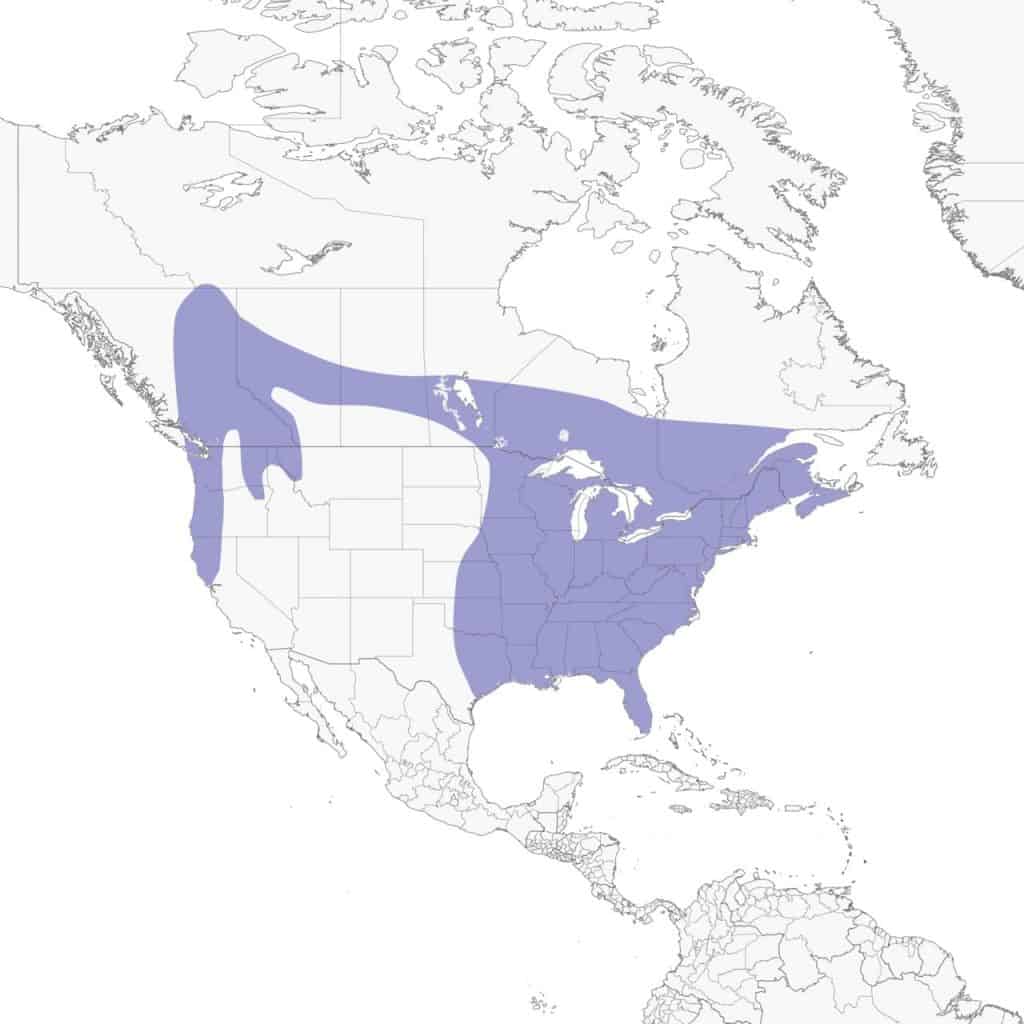
Belted Kingfisher
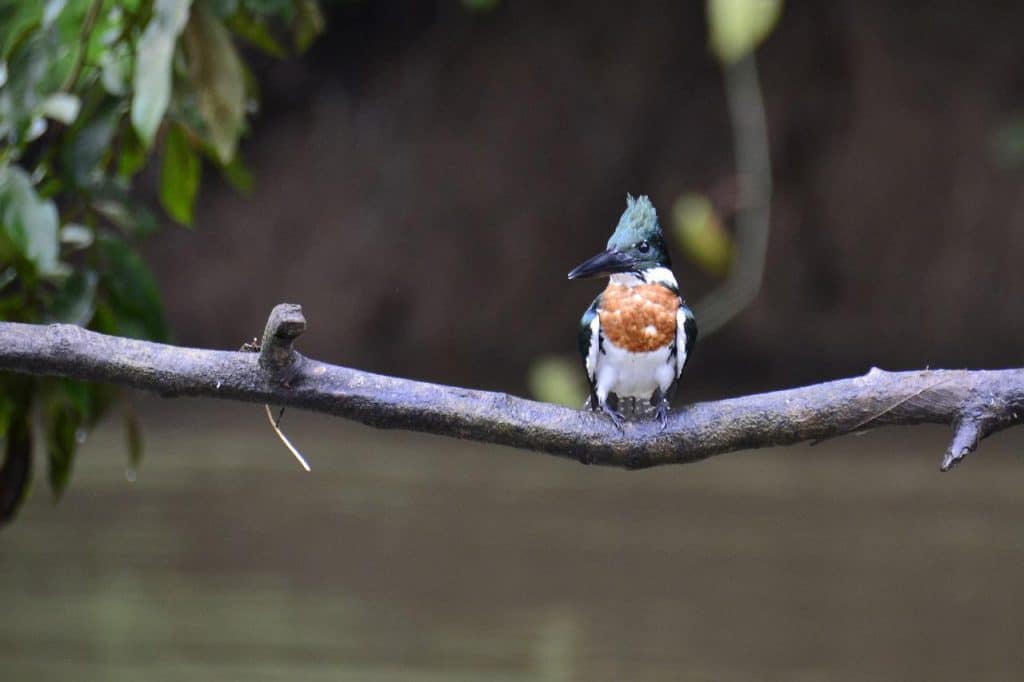
Appearance: The belted kingfisher is a large 13″ long bird with a large head, long bill, and stocky body. Blue/gray throughout with white ring around neck and white chest. The Female is the same but with an additional chestnut band on her chest.
Diet: Large 13″ long bird with a large head, long bill, and stocky body. Blue/gray throughout with white ring around neck and white chest. The Female is the same but with the additional chestnut band on the chest.
Feeder food: Unlikely to come to the feeder but often attracted to yards with streams or ponds.
Habitat: Near streams, rivers, ponds, lakes, and calm marine waters – especially unclouded water with little vegetation.
Nesting: Belted kingfishers dig burrows along the water’s edge for their nest. 1-2 broods/season, 5-8 eggs/brood – large white glossy eggs (1.5″ long), 22-24 days incubation.
Migration: Many but not all belted kingfishers are migrators. In spring, the migrators will head north into Montana, North Dakota, northern Minnesota, Canada, and Alaska to breed and raise their young. When fall comes the migrators head back south – as far south as Arizona, New Mexico, southern California, and Mexico.
Year-round range: All US states (except North Dakota and Arizona) and the pacific coast of Canada’s British Columbia.
Breeding range: While some stay in their year-round range, many others migrate north into Montana, North Dakota, northern Minnesota, Canada, and Alaska to breed and raise their young. When fall comes the migrators head back south – as far south as Arizona, New Mexico, and southern California.
Winter range: While many belted kingfishers migrate south for winter, just as many remain in their year-round range when the temperatures dip.
Range Map
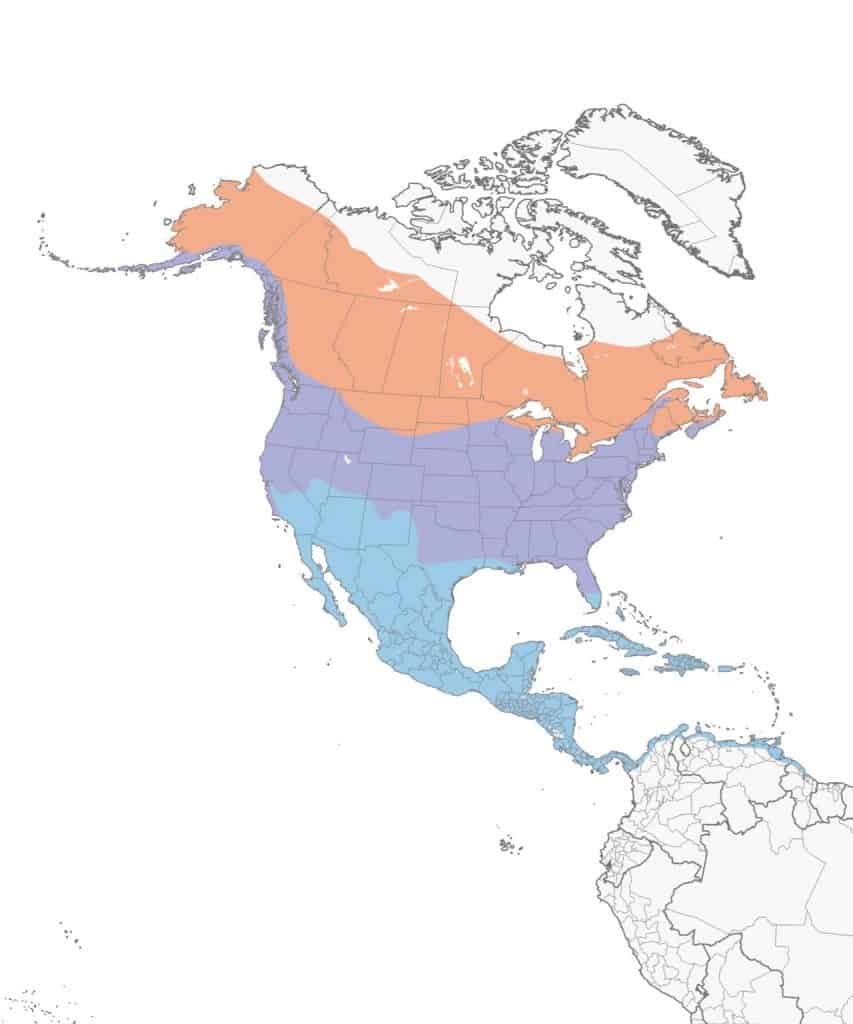
Black Throated Blue Warbler

Appearance: Black-throated blue warblers are small birds about 5″ long, midnight/steel blue back, black throat, and a white belly
Diet: Insects and fruit.
Feeder food: Suet, peanut butter, and nectar.
Habitat: Prefer mature deciduous and mixed evergreen woodlands with plenty of thick shrubs.
Nesting: They build a cup-shaped nest in a shrub made of bark and spider webs. 1-3 broods/season, 2-5 eggs/brood, eggs are small .6″-.8″, creamy white and speckled. Incubation lasts for about 12-13 days.
Migration: Black-throated blue warblers are true migrators. They head north in spring to breed and raise their young. In the fall, they migrate south to winter in southern Florida and the Caribbean.
Breeding range: Northern Wisconsin, Northern Michigan, eastern Tennessee & Kentucky, West Virginia, Pennsylvania, Pennsylvania, the New England states, and Canada’s southern provinces of Ontario and Quebec.
Winter range: Southern Florida and the Caribbean islands.
Range Map
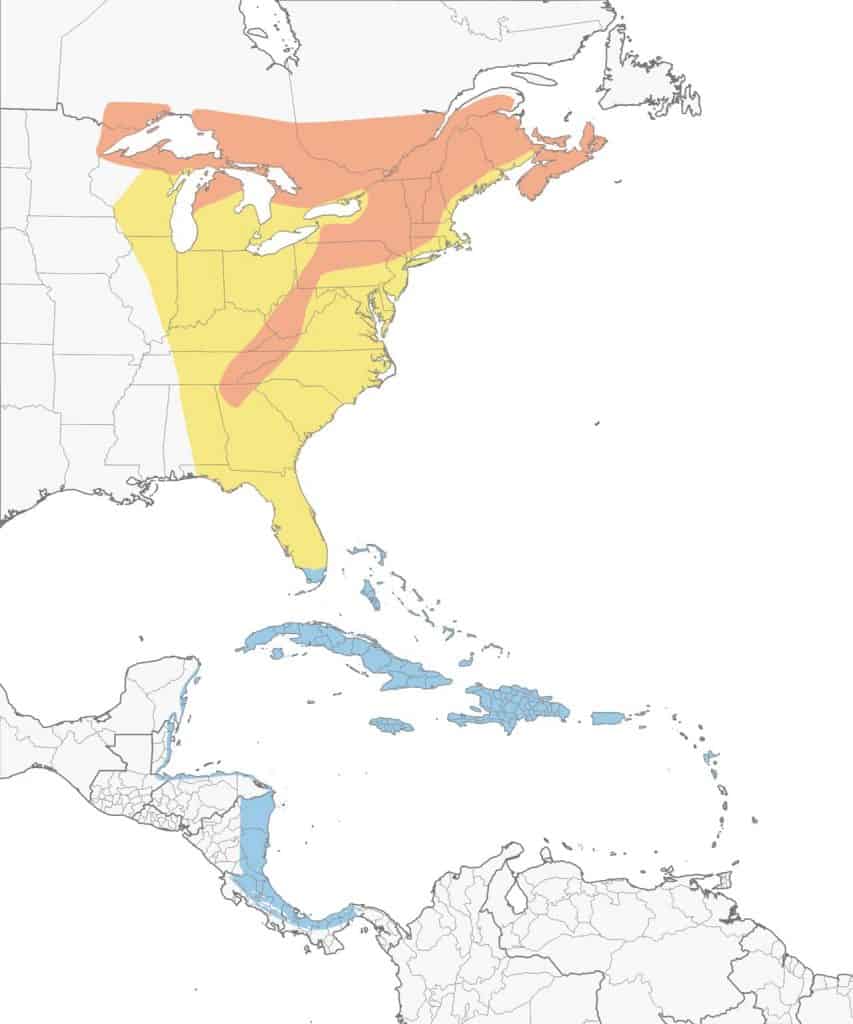
Black-and-White Warbler
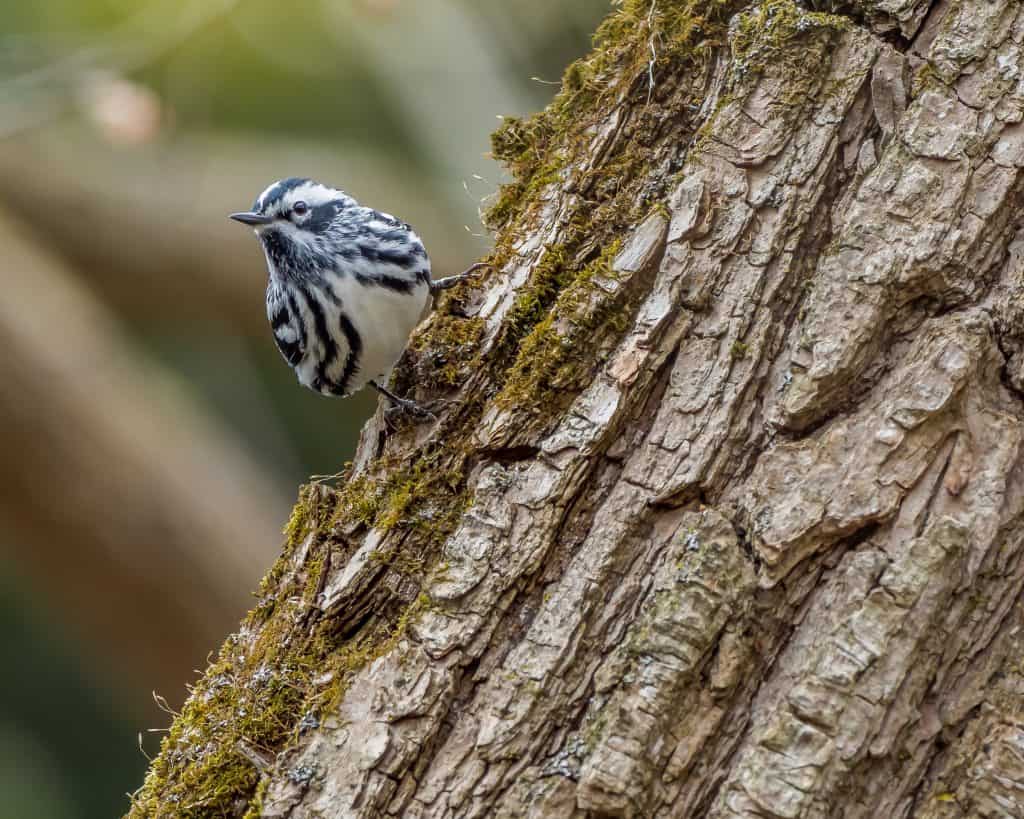
| Appearance | The black-and-white warbler is a small bird about 5″ long and has similar colorings as a zebra. They have a white belly and black chin with black-and-white stripes on the crown with a black patch on their cheek. The female is the same only duller and without the black chin and cheek patch. |
| Diet | Insects. |
| Feeder Food | Unlikely to visit a feeder. |
| Habitat | Deciduous as well as mixed forests. |
| Nesting | They build a cup-shaped nest and have 1 brood/season. There are about 4-5 eggs/brood – white with brown markings. Incubation is for 10-11 days. |
Range Map
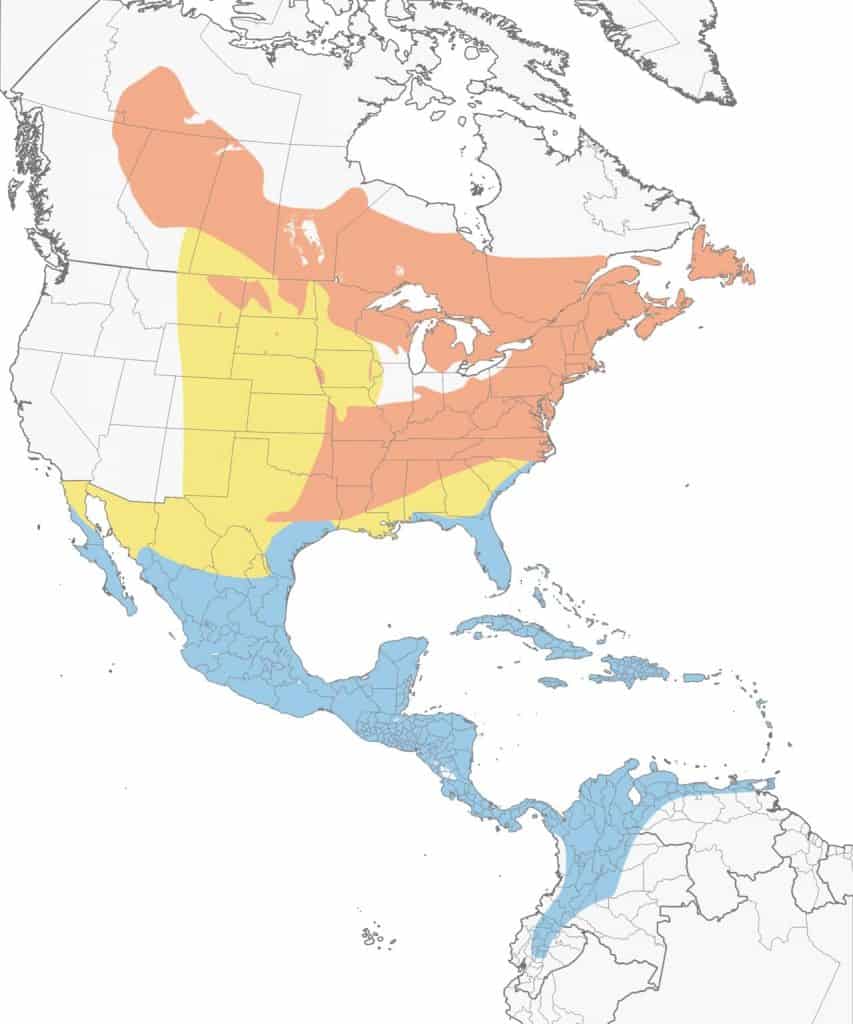
Black-Billed Magpie
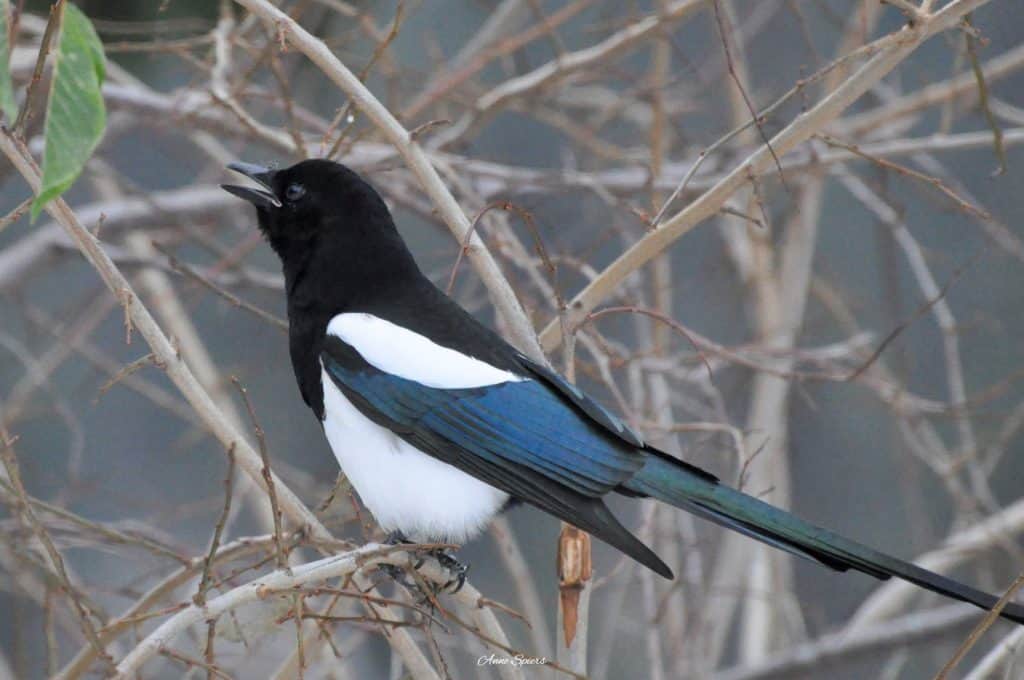
Appearance: Black-billed magpies are large birds about 19″ long. They have black bodies with glossy blue, green & violet highlights on the wings, white bellies, white shoulders, and very long tails.
Diet: This bird is an omnivore. They’ll eat animal matter from just about anywhere – carrion, human trash, roadkill, baby birds, and even other birds’ eggs. Will also eat fruit and grains.
Feeder food: Suet, black-oil sunflower seed, hulled sunflower seeds, cracked corn, peanuts, fruit, millet, milo.
Habitat: This bird prefers open woodlands, forest edges, and scrublands. They’re frequent backyard visitors as well as city parks.
Nesting: They nest in a tree or tall shrub. Nests are large and bulky made of sticks and lined with mud, dung, and animal hair. They have 1 brood/year and about 6-7 tan or olive-green eggs/brood. Incubation lasts 18 days and fledglings leave the nest at about 22-29 days.
Migration: Black-billed magpies are not migrators. Their year-round range includes southern Alaska, Yukon Territory, Canada’s southern provinces, and the northwestern and central parts of the U.S.
Range Map
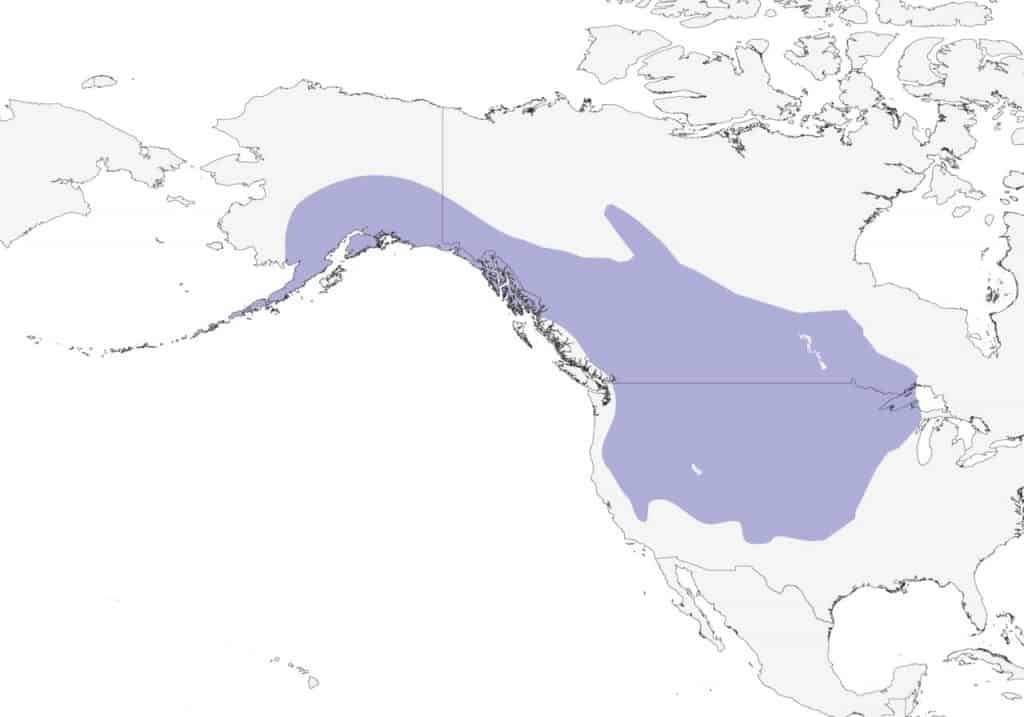
Black-Capped Chickadee
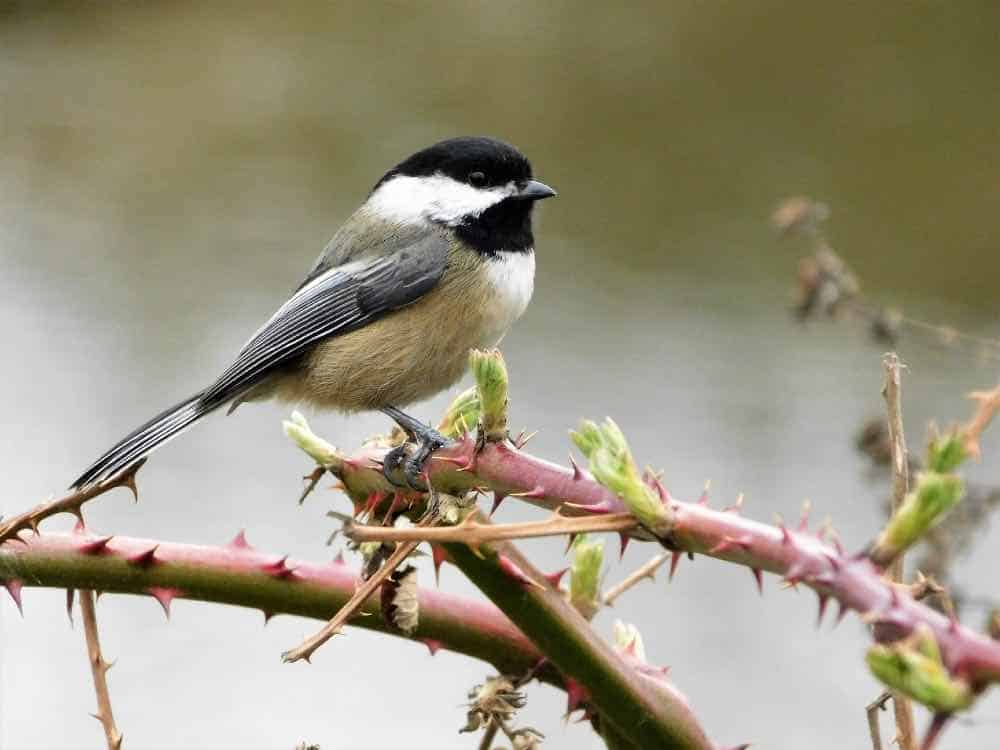
Appearance: Black-capped chickadees are small birds about 5 1/4″ long. They have a black cap – as well as a black throat and cheek. They have a white breasts and bellies, the body and wings are a gray-olive color with edges of white and the wing/belly edge is a soft “buff” tan.
During the summer, the buff area is more faded.
Diet: Insects & spiders (including their eggs & pupae), seeds, and small fruits, and berries.
Feeder food: Black-oil sunflower & safflower seeds (They peck a hole in the shell to get at the tiny seed bits inside), suet, peanut butter, and hulled peanuts.
Habitat: You’ll find this bird along the edges of forests and open wooded areas – including your backyard or even tree-lined parks in the city. They will also hang out in shrubs and willow thickets. Trees are still important for this bird because they are cavity nesters.
Nesting: Will next in an existing woodpecker hole high in a tree or man-made nesting box. They have 1 brood /season. The female lays anywhere from 1-13 eggs. Eggs are white with burgundy colored spots and about .5″ wide x .6″ long. She will incubate them for 12-13 days.
Migration: Black-capped chickadees are not migrators. They remain in their year-round range all seasons of the year.
Year-round range: Northern half of the US including Alaska, as well as all Canadian provinces except Nunavut.
Range Map
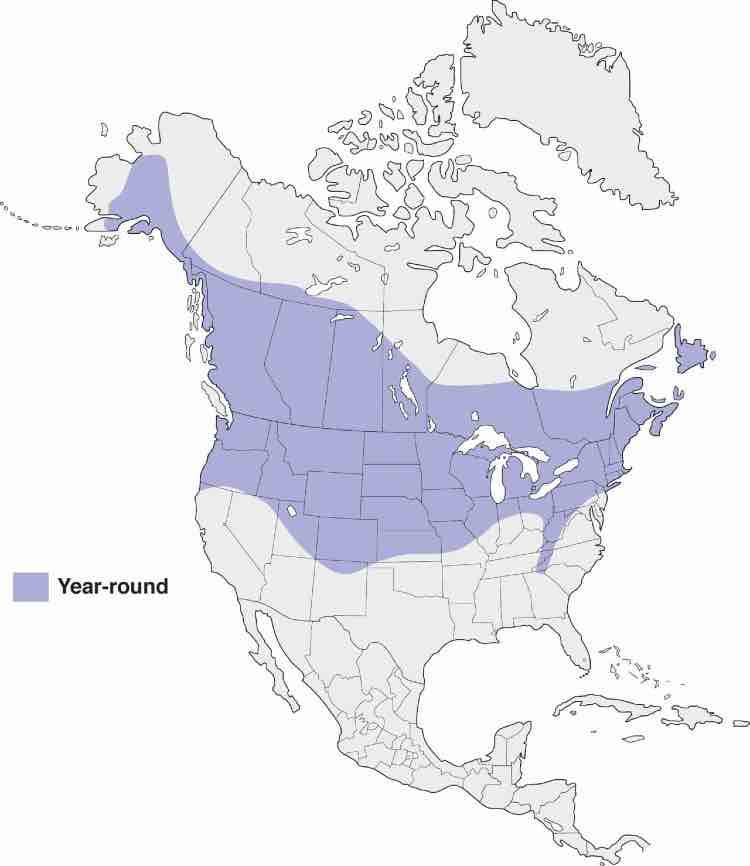
Black-Throated Green Warbler
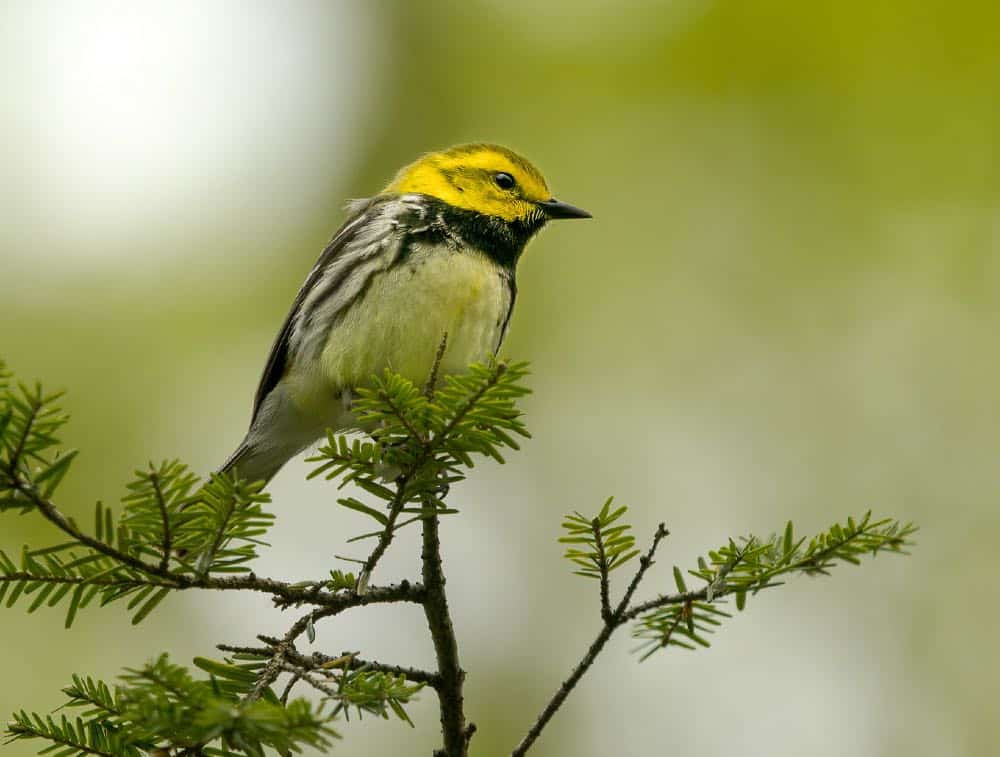
| Appearance | Small bird about 4.5″ long with a bright yellow head, black throat, and green back. Black and white streaks over the sides. The female is similar but has a white throat. |
| Diet | Primarily insects. Will dine on berries while migrating. |
| Feeder Food | Unlikely to visit a feeder. |
| Habitat | They prefer forests with a mix of coniferous and other deciduous trees. |
| Nesting | The female builds a small cup-shaped nest 3-10′ off the ground in a tree. They have one brood/year. There are about 3-5 tiny eggs, white with brown spots. Incubation is 12 days. |
Range Map
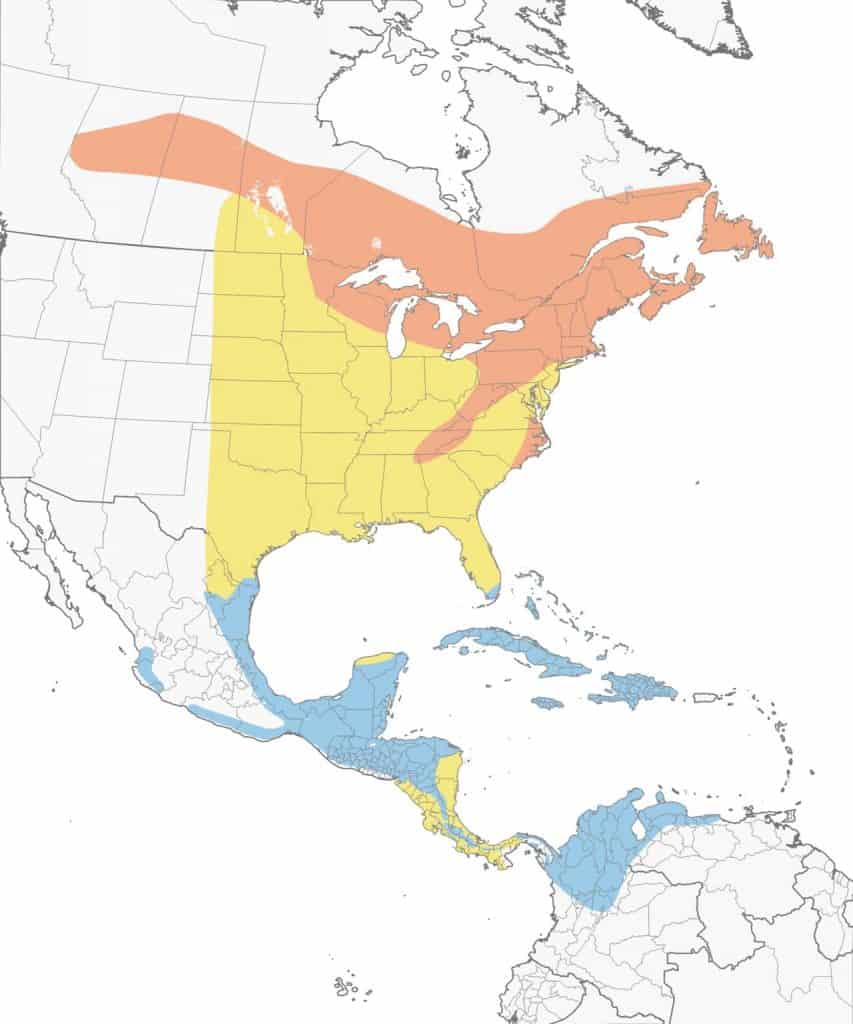
Blue Jay
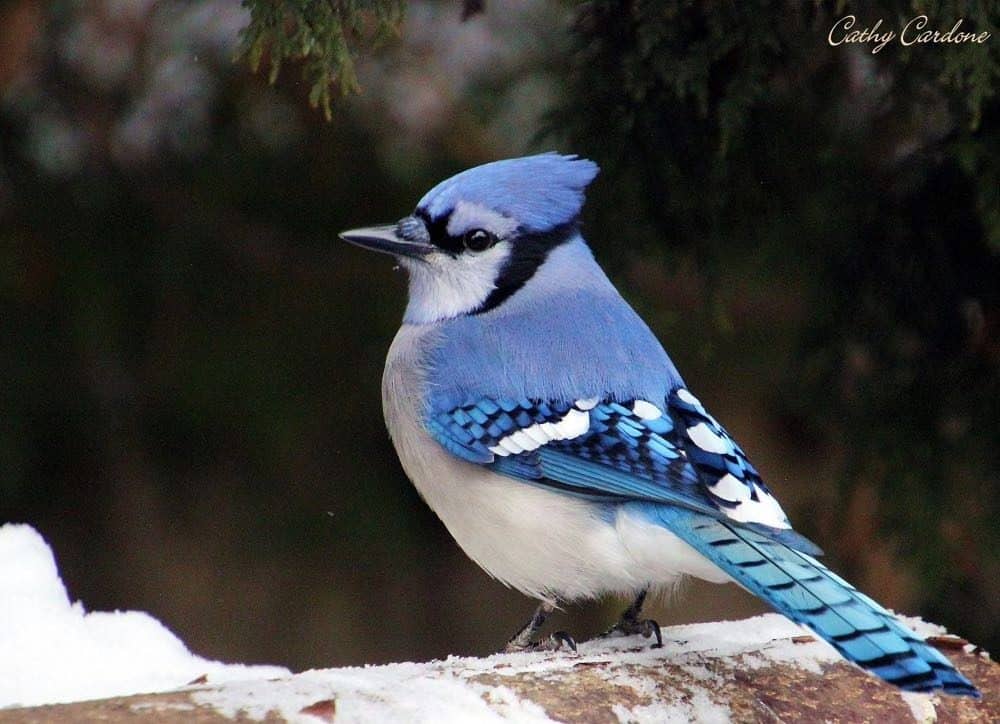
Appearance: Large bird 12″ long, medium blue & white body, blue crest (which he flattens at will), gray belly, and white face. White & blue wings with black spots. Females look the same.
Diet: Insects, fruit, seeds, nuts, other birds’ eggs, and nestlings.
Feeder food: Whole peanuts, sunflower seeds, and cracked corn.
Habitat: Forested areas with mixed tree types. Also common in suburbs and urban areas.
Nesting:
- Nest: bulky large nest made from twigs, bark, and mud resting on a tree branch about 5-50′ up.
- Broods: 1-2 broods/season,
- Clutch: 2-7 eggs/brood,
- Egg color: Pale blue to a light brown base color, and these eggs usually have brown or gray spots.
- Egg size: 1 inch by just under 1 inch
- Incubation: Both parents incubate the eggs for 17-18 days and the young fledge between 17-21 days.
Migration: In general, blue jays are not migrators. They remain in their year-round range for all 4 seasons – even during the breeding season. While they may move within their year-round range, they do not regularly head north for breeding and south for winter as some species do. That said, in rare cases, some will head west of their year-round range for the winter.
Range Map

Blue-Gray Gnatcatcher
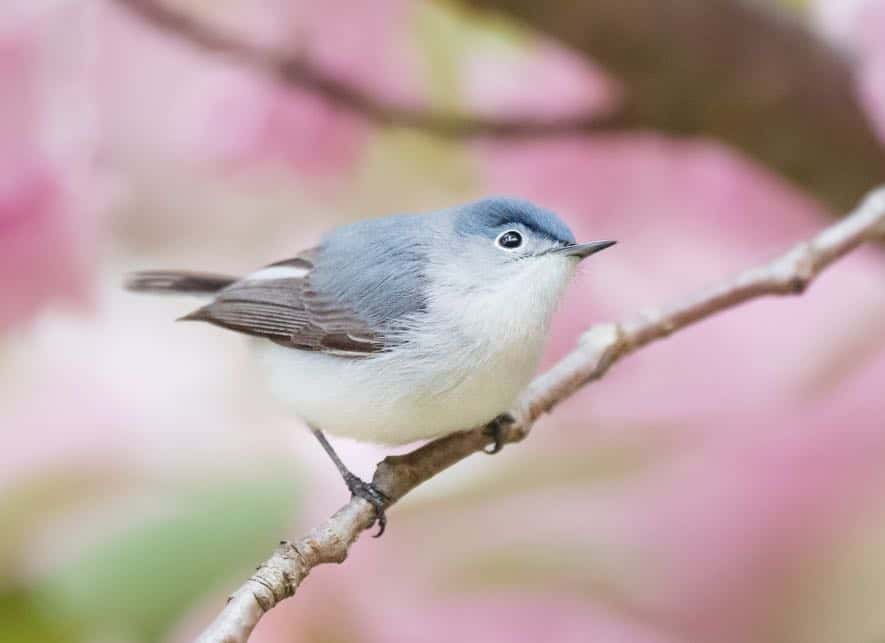
Appearance: Blue-gray gnatcatchers are tiny birds 4.25″ long, with soft blue/gray upperparts, white eye-rings, white underparts, and long black long tails with white under. The females are the same. The breeding male is accented with narrow black eyebrows.
Diet: Insects and spiders.
Feeder food: Unlikely to visit the feeder.
Habitat: Deciduous forested areas.
Nesting:
- Nest: Tidy cup-shaped nest of natural fibers, bark, and spiderweb about 3-80′ high in a tree or shrub.
- Broods: 1-2 broods/season
- Clutch: 3-5 eggs/brood
- Egg color: Pale blue with red/brown spots.
- Egg size: 0.5 – 0.6 inches by 0.4 – 0.5 inches
- Incubation: 11-15 days and the young fledge at about 10-15 days.
Migration: While many blue-gray gnatcatchers remain in their year-round range during the spring & summer, most migrate north into the US for breeding and to raise their young. The migrators then head back south in the fall and return to their year-round range or even further south along the Mexican Pacific coast, southern Florida, and the Caribbean islands to spend winter.
Year-round range: The southernmost part of these US states: California, Arizona, New Mexico, Texas, Louisiana, Georgia, Mississippi, Alabama, Florida, South Carolina, North Carolina, and Virginia.
Breeding range: Eastern half of the US as well as California, Nevada, Utah, Arizona, Colorado, New Mexico, Texas, Kansa, and Oklahoma.
Winter range: Southern California, southwest Arizona, along the Pacific coast of Mexico, the southernmost tip of Florida, and the Caribbean islands.
Range Map
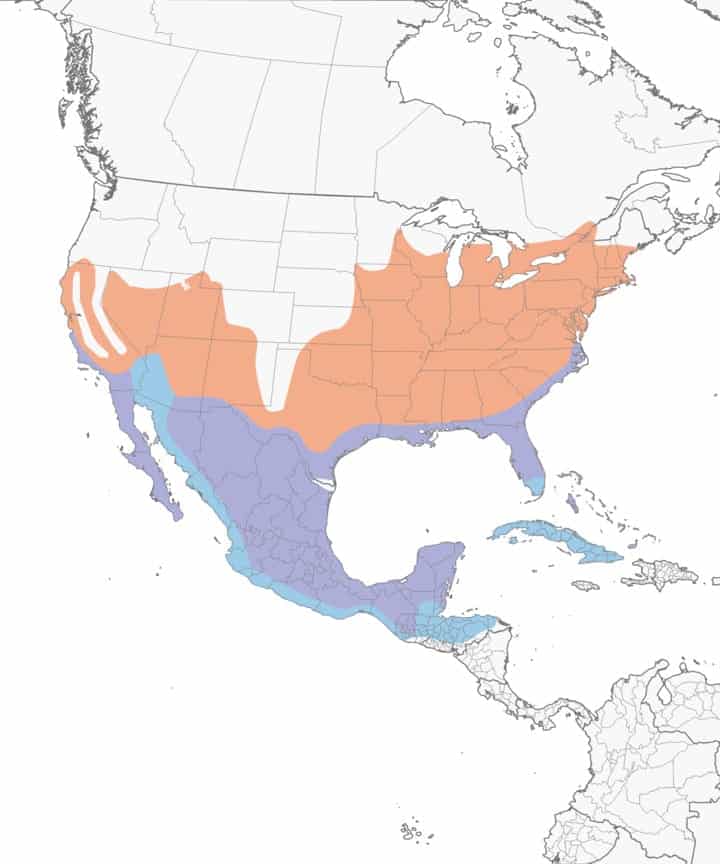
Brewer’s Blackbird
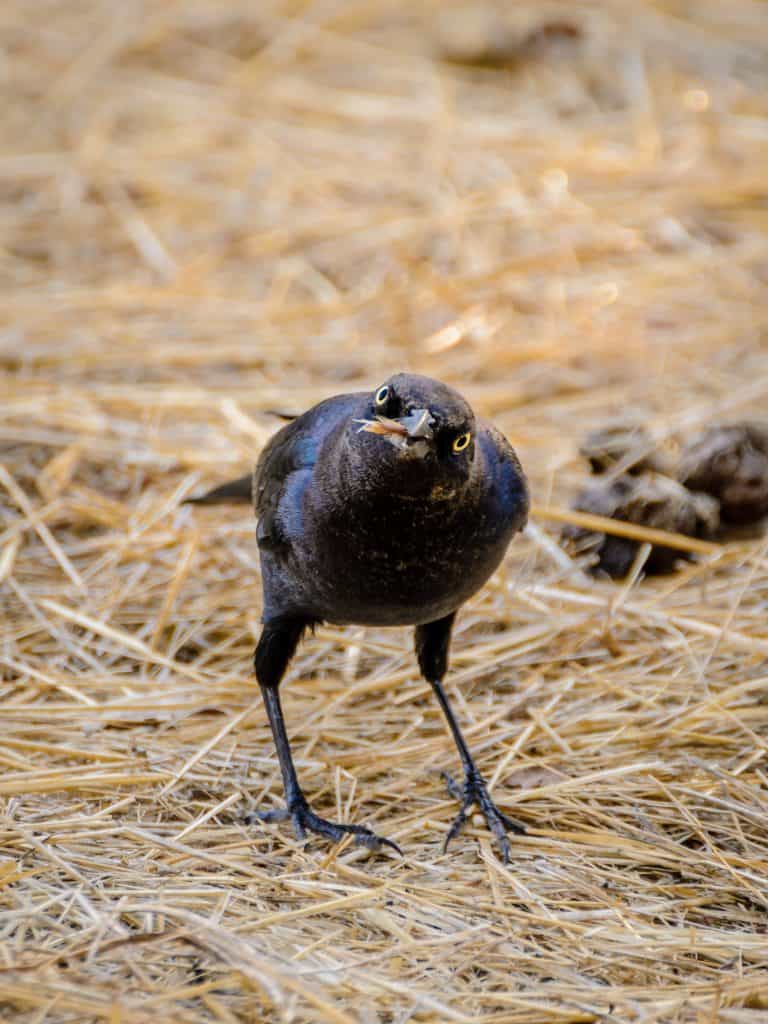
Diet: Insects, seeds, and berries.
Appearance: Brewer’s blackbird is a large bird about 9″ long. They’re all black with purple and green iridescence on the head and body. The female is dull gray/brown instead.
Feeder food: Any type of seed offered on a platform feeder or scattered on the ground.
Habitat: Inhabits a variety of habitats – open woodlands, mountain meadows, city sidewalks, and suburban backyards.
Nesting: They nest in a tree 20-40 feet up. The nest is a bulky cup shape comprised of twigs, grasses, and other plant material. They have 1-2 broods/season and 4-6 eggs/brood. The eggs are light gray to greenish/white and often spotted. Incubation is for 12-14 days and fledglings leave the nest at 13-14 days.
Migration: Brewer’s blackbirds are migrators. While some remain in their year-round range for all four seasons, many head north and east in the spring for breeding and raising their young. Then in the fall, they’ll return or head further south in the southern half of the US or Mexico.
Year-round range: Western US states and Canada’s British Columbia.
Breeding range: Montana, Wyoming, Colorado, and Canada’s British Columbia, Alberta, Saskatchewan, Manitoba, and Ontario.
Winter range: US states south of Kansas, Mexico, and the western part of Canada’s British Columbia.
Range Map
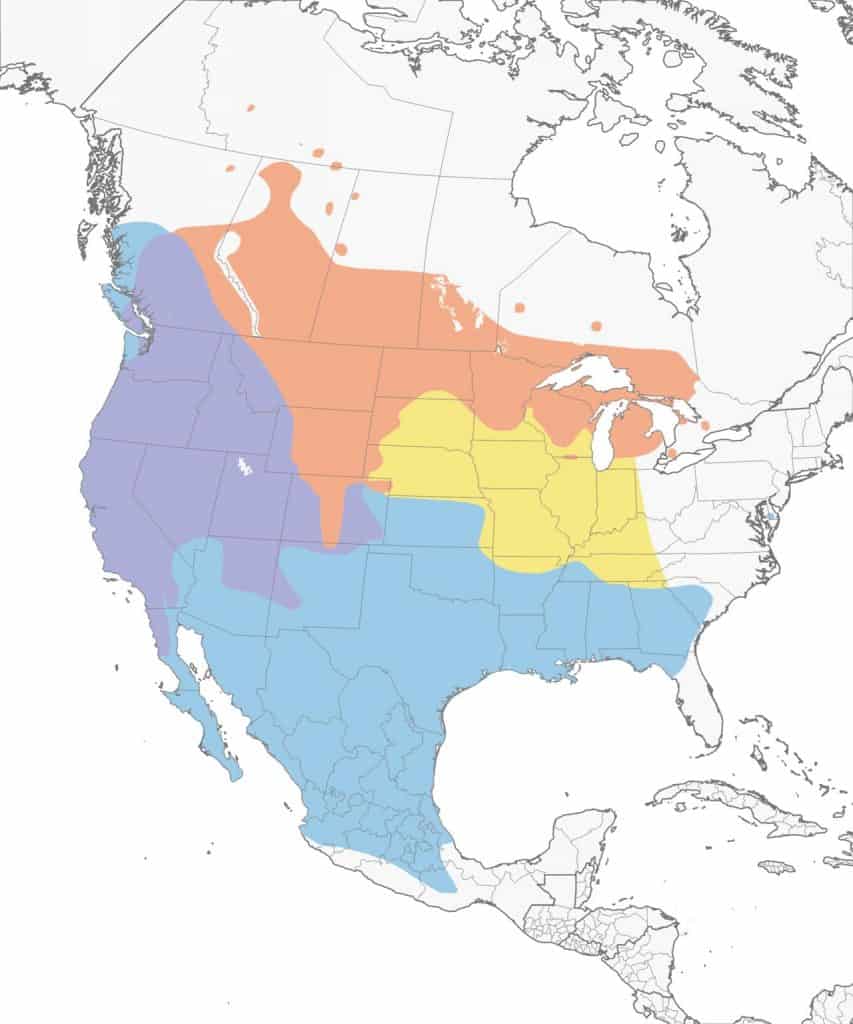
Broad-Winged Hawk
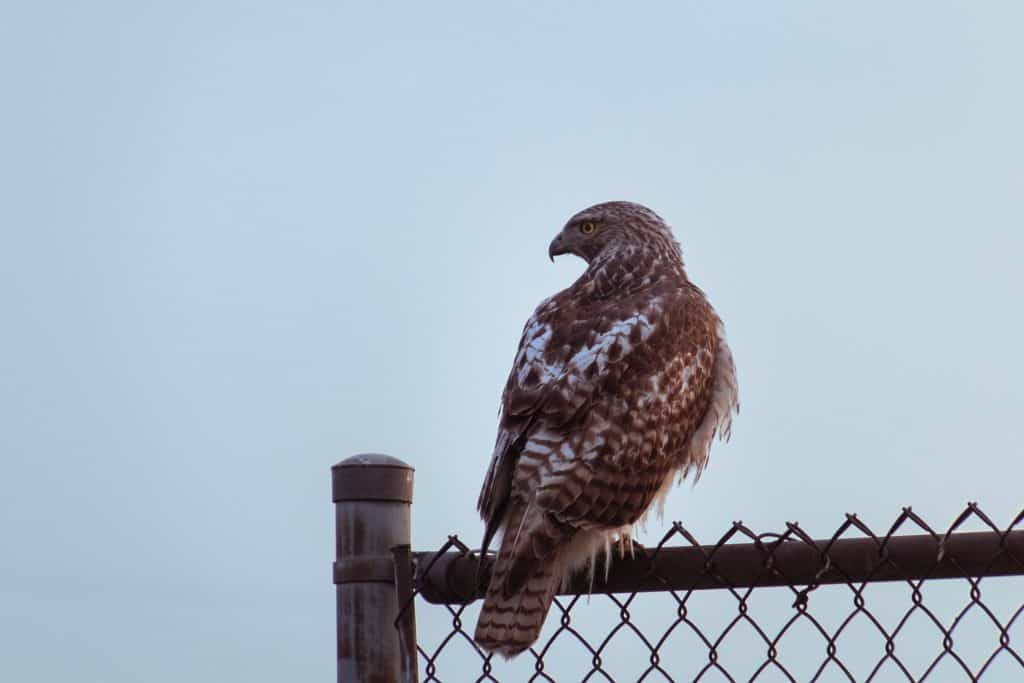
| Appearance | Broad-winged hawks are about 16″ long, brown with reddish/brown streaks underneath and a dark stripe on their cheek. They have short tails and broad-based wings with pointed tips. |
| Diet | They eat frogs, snakes, lizards, small birds, and small mammals. |
| Feeder Food | Broad-winged hawks do not visit feeders. |
| Habitat | They inhabit forested areas. |
| Nesting | Broad-winged hawks build nests made from bark chips and fresh plant twigs, corn husks, grapevine, feathers, and pine needles. They have 1 brood/season and 2-3 white, creamy or blue eggs/brood that have rough surfaces. Incubation is for 28-31 days and fledglings leave the nest about 35-42 days after hatching. |
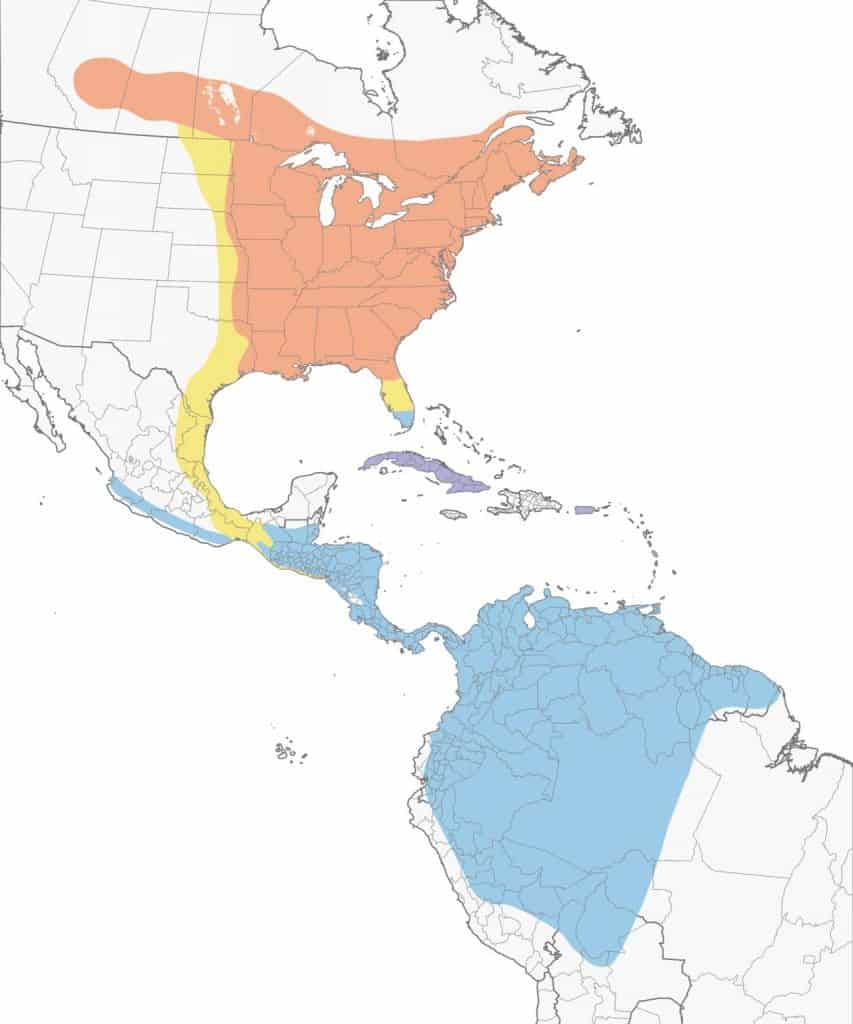
Brown Creeper

| Appearance | The brown creeper is a small bird about 5″ long. They have a brown body with a white belly, long tail, and thin curved bill. They have a white streak above each eye. The female looks the same. |
| Diet | Insects, nuts, and seeds. |
| Feeder Food | Hulled sunflower seeds, suet, and hulled peanuts. |
| Habitat | Forested areas. |
| Nesting | Cup-shaped nest They have 1 brood/season and 5-6 eggs/brood. Eggs are white with tiny brown marks. Incubation is for 14-17 days. |
Range Map
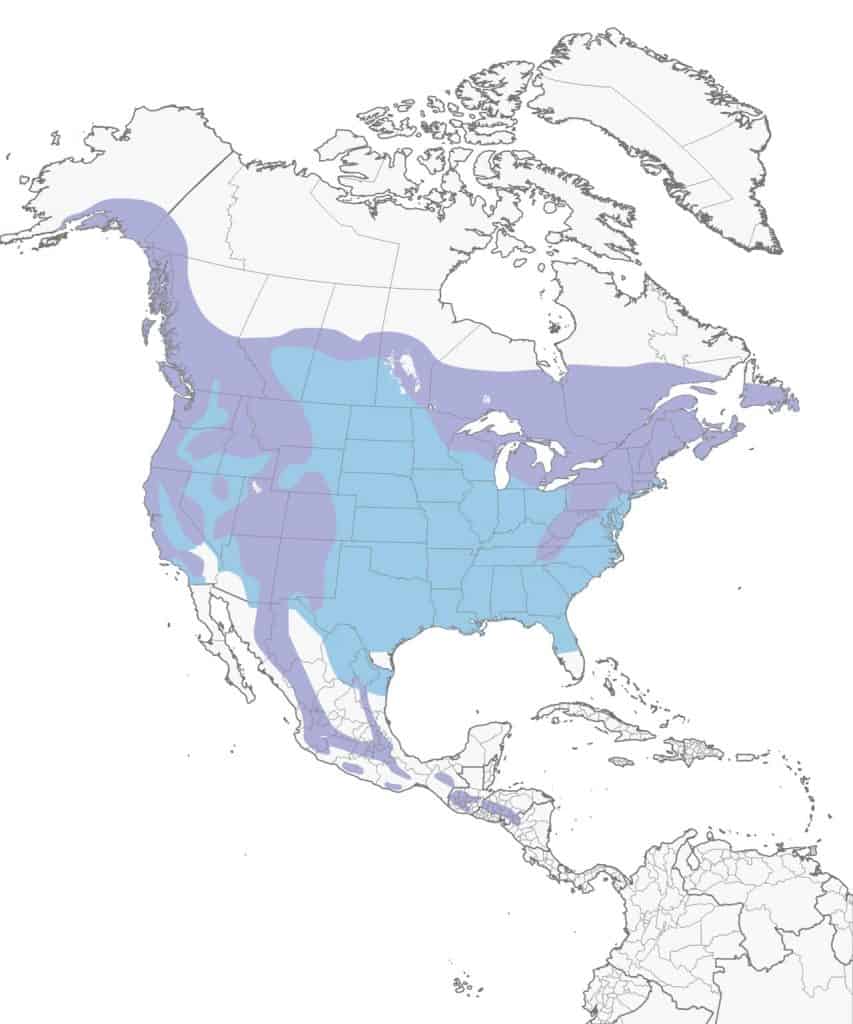
Brown Creeper in Winter

Appearance: The brown creeper is a small bird about 5″ long. They have a brown body with a white belly, long tail, and thin curved bill. They have a white streak above each eye. The female looks the same.
Winter diet: Insects hibernating beneath the bark, nuts, and seeds.
Winter feeder food: Hulled sunflower seeds, suet, and hulled peanuts.
Winter habitat: While many brown creepers remain in their year round range, some head south for the winter. As a result there are brown creepers found in every state of the US and Canada during winter. They prefer to be in forested areas.
Range Map

Brown Thrasher
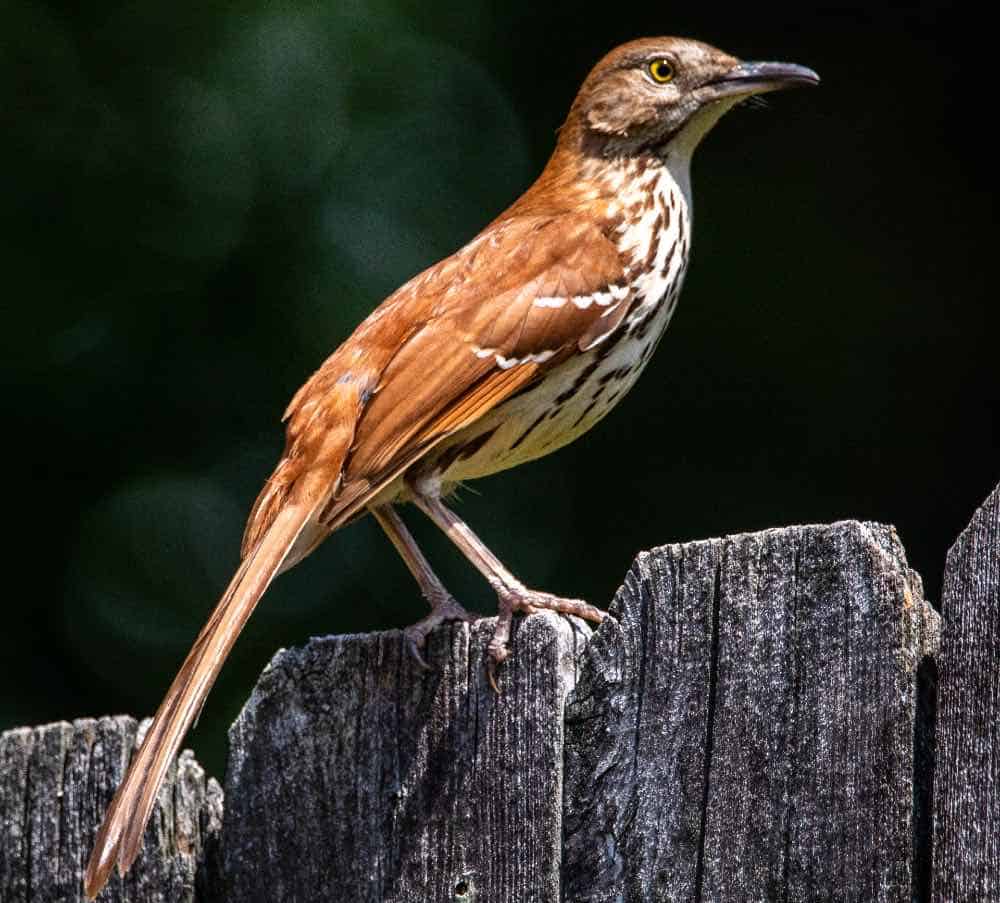
Range Map
| Appearance | Large rusty-red bird about 11″ long. Long, thin tail, heavily streaked chest and belly. Long curved bill and bright yellow eyes. Also has two white wing bars. |
| Diet | Insects and fruit. |
| Feeder Food | Not a common feeder bird but may stop to dine on fallen seeds. |
| Habitat | Thick shrubs, wooded edges, and hedgerows in the east. In the western part of the range, they can be found living in tree lines, fence rows, and woodlands. |
| Nesting | Bulky cup-shaped nest about 3.5″ in diameter located low in a thorny shrub or tree. They have about two broods per year, 4-5 pale blue 1″ eggs with brown markings. |
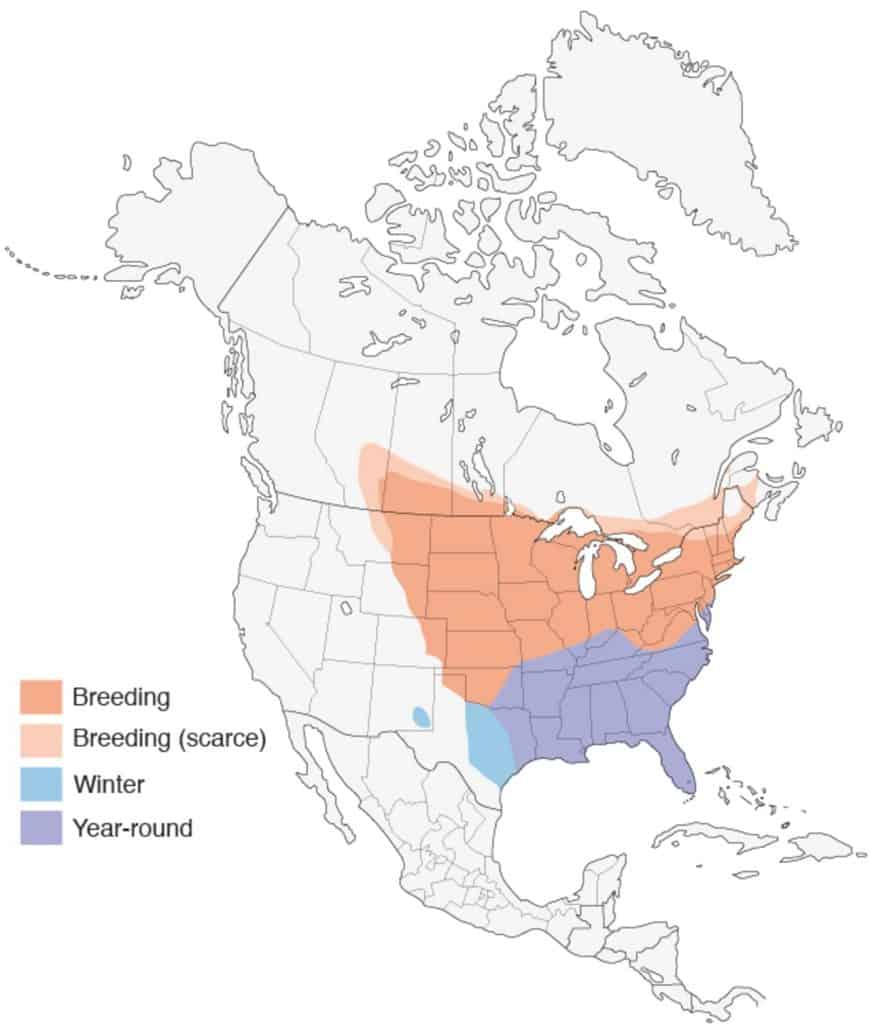
Brown-Headed Cowbird
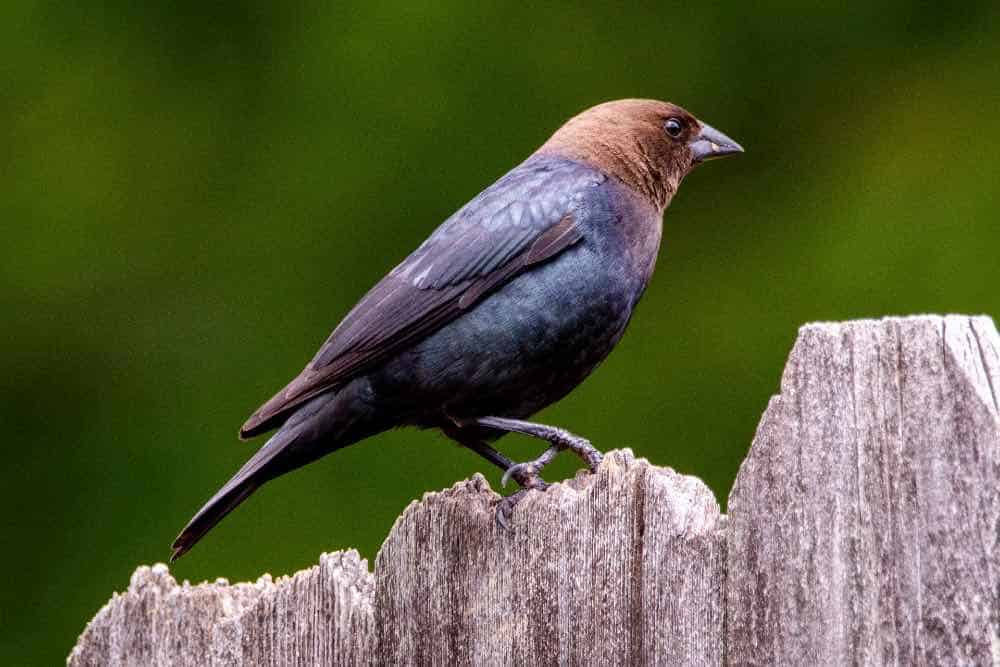
| Appearance | Medium-sized bird about 7 1/2″ long. The male is a glossy black with a chocolate brown head with a long pointed gray bill. The female is a dull brownish-gray. |
| Diet | Insects and seeds. |
| Feeder Food | Mixed birdseed. |
| Habitat | Thick shrubs, wooded edges, and hedgerows in the east. In the western part of the range, they can be found living in tree lines, fence rows, and woodlands. |
| Nesting | Brown-headed cowbirds don’t build nests. They lay about 5-7 white eggs with brown markings in other birds’ nests to incubate and raise the young. |
Range Map
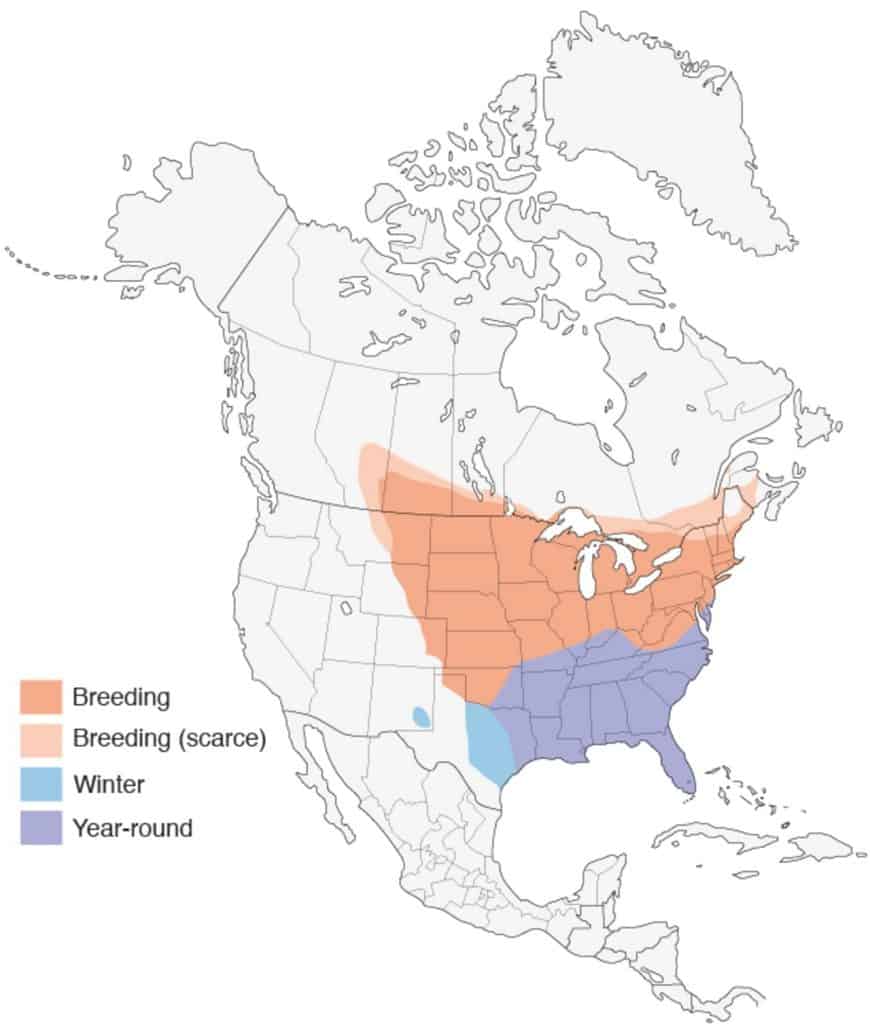
Canada Jay (Gray Jay)
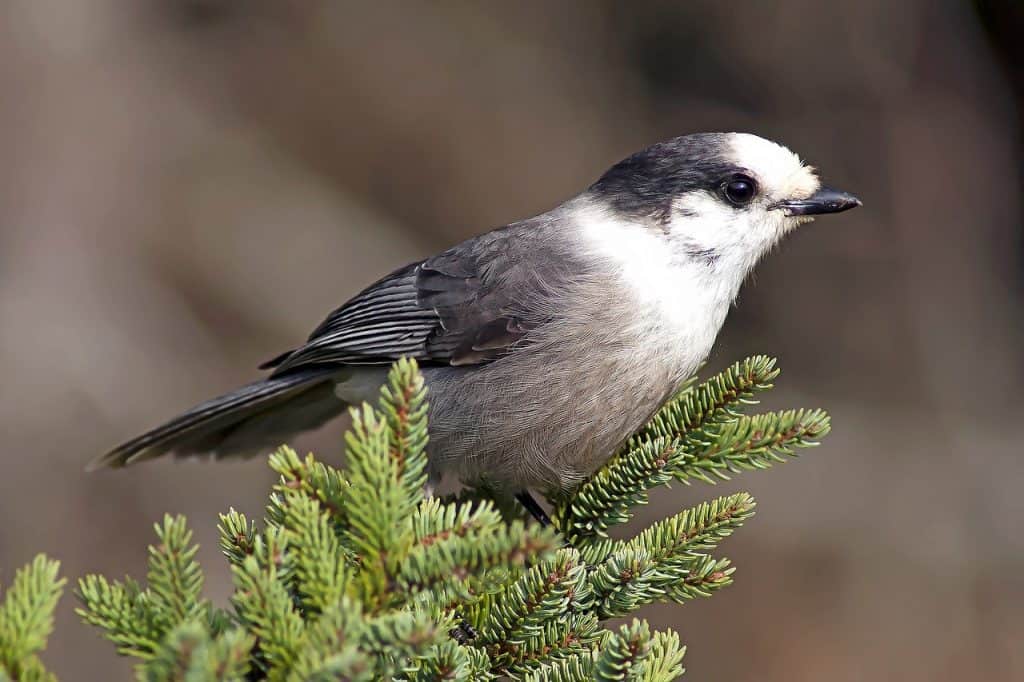
| Appearance | The gray jay often referred to as the Canada jay, is a large bird about 11 1/2″ long. It’s gray all over with black on the back of its neck, a white chest, a short bill, and a dark eye. Also sports a white patch on his forehead. The female is the same as the male. |
| Diet | Insects, seeds, fruit. |
| Feeder Food | Any kind of bird seed, peanuts, fruit, mealworms, and suet. |
| Habitat | North woods. |
| Nesting | Cup-shaped nest. They have 1 brood/season, 304 gray/white eggs/brood, and incubate for 16-18 days. |
Range Map
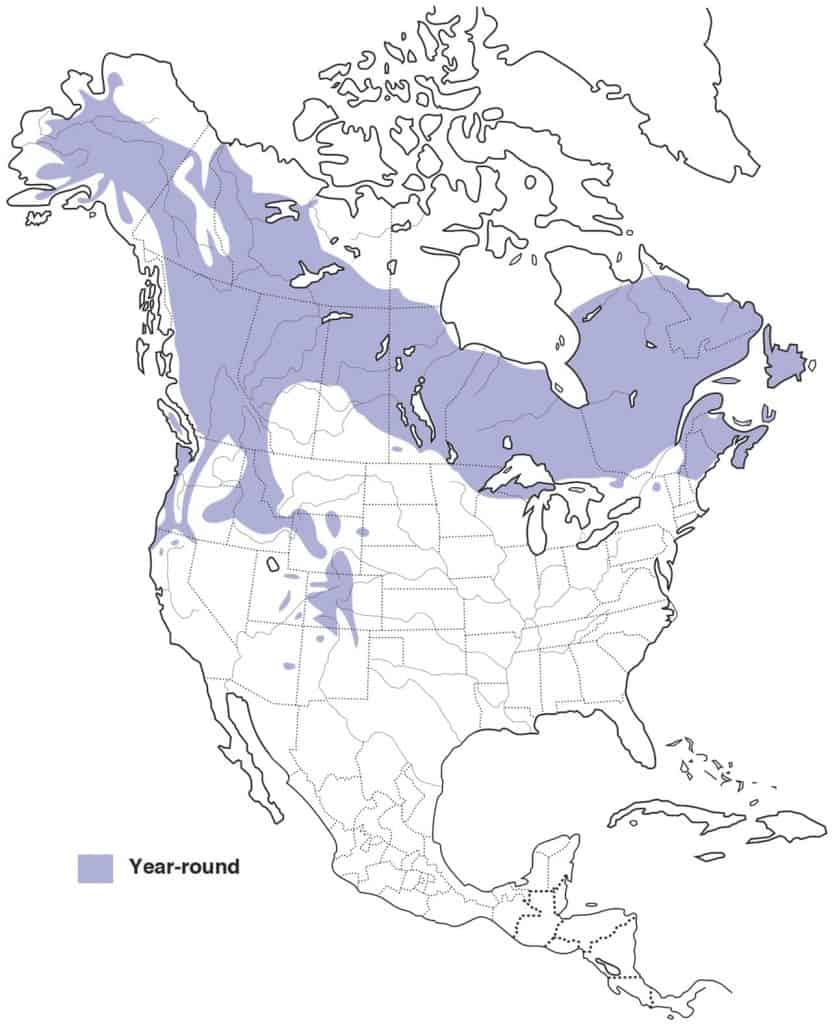
Carolina Wren
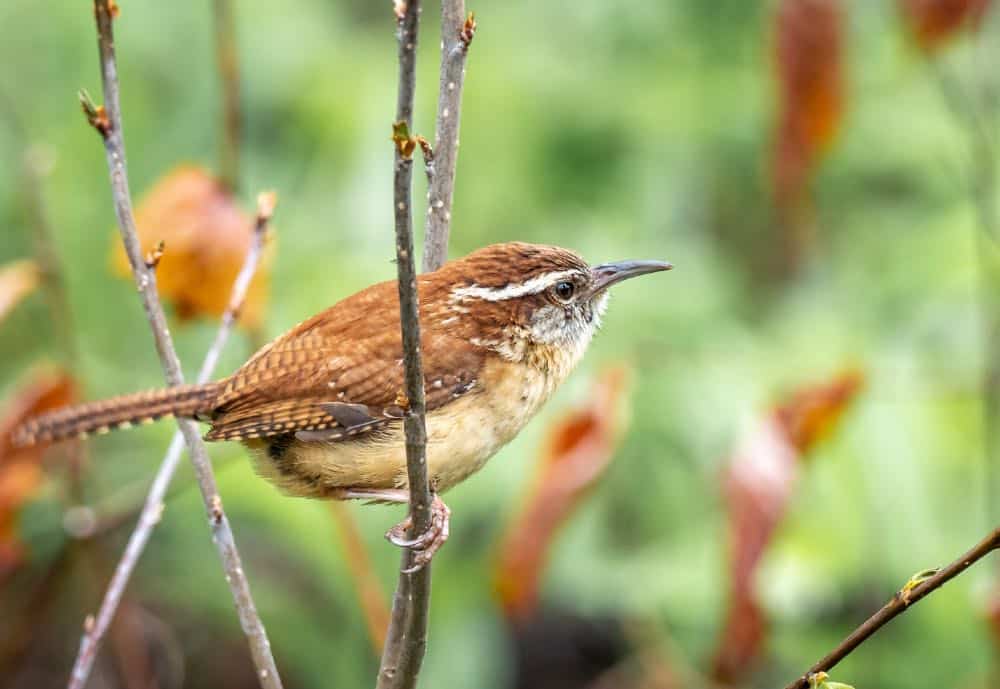
| Appearance | Small bird about 5 1/2″ long, chunky shape with deep rusty brown above and cinnamon color below. Bold white stripe above the eye and throat. Down curved bill. |
| Diet | Insects and spiders. |
| Feeder Food | Carolina wrens are common at the feeder. They enjoy hulled sunflower seeds, mealworms, peanut hearts, and suet in the winter. |
| Habitat | Brushy woods and wooded backyards. |
| Nesting | Bulky domed cup nest less than 10 up in a tree, inside an open tree cavity, in a hanging fern plant, or even in an upside-down flower pot. They have 1-3 broods/year, 4-6 eggs/brood, and incubate for 12-14 days. Eggs are a shade of white or pink/white with tiny brown spots. |
Range Map
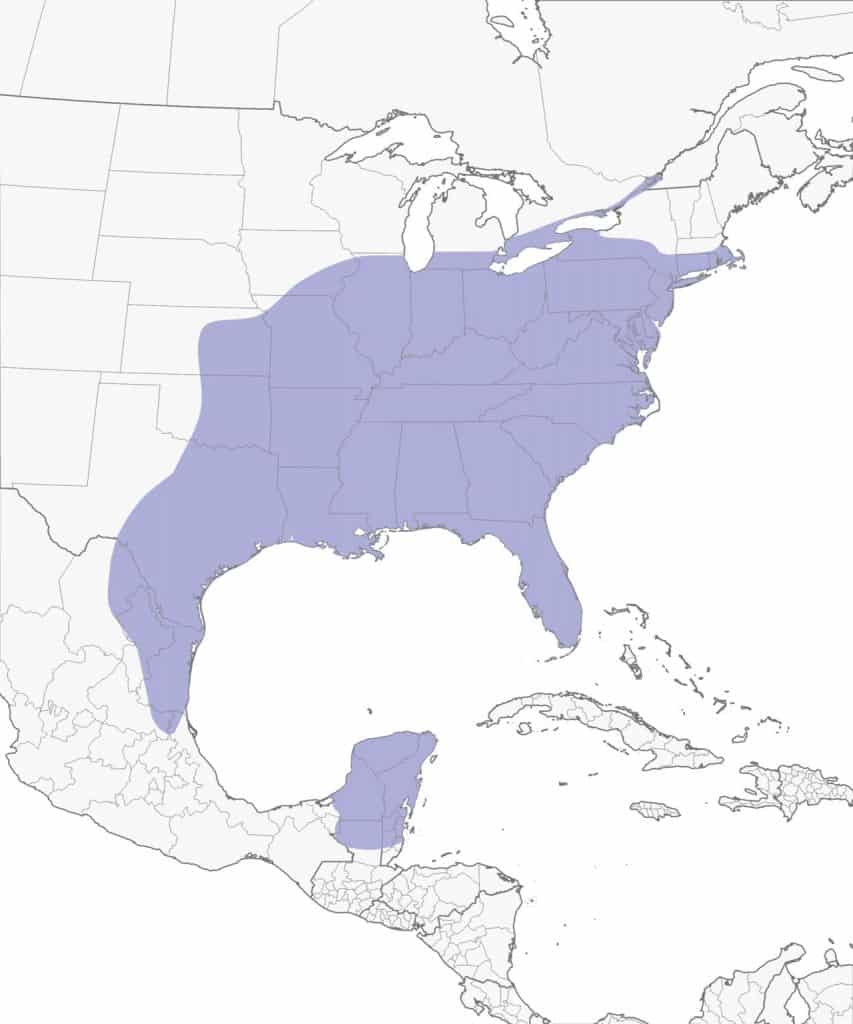
Cedar Waxwing
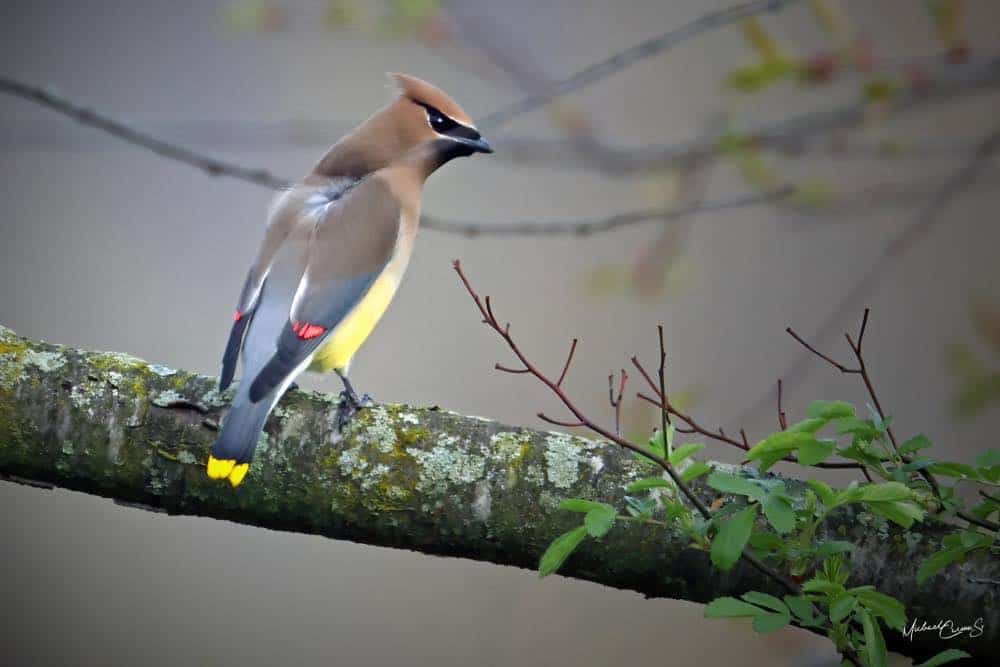
| Appearance | The cedar waxwing is about 7 1/4″ long, primarily light brown with a silky crest of the same color, yellow belly, a bright yellow tip on the tail, varying shades of brown underneath, and a touch of red at the tip of the upper wings. The beak is black, short, and pointy. Male and female adults look pretty much the same with one very subtle difference – the black on the male’s chin encompasses a slightly larger area than the female |
| Diet | Mostly fruit. Insects if no fruit is available. |
| Feeder Food | Fruit (oranges) |
| Habitat | Open forests, orchards, and wooded residential areas especially near berry bushes. |
| Nesting | The pair builds an open-cup-style nest 6-20′ high in a tree. She lays 3-5 eggs and incubates for 12-14 days. The eggs are blue-gray and often spotted with black or gray. |
Range Map
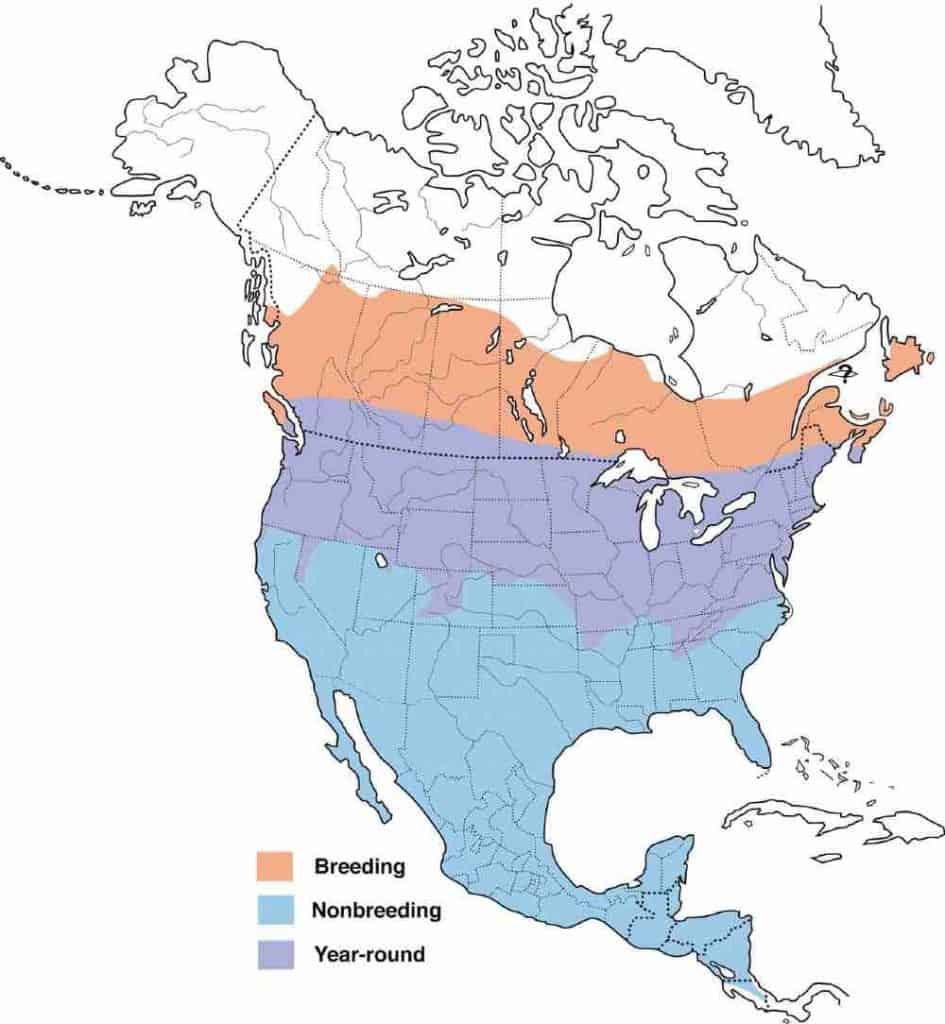
Cerulean Warbler

Appearance: Cerulean warblers are small 4.3″ long birds with sky-blue above, white wing bars, darker blue streaks on the back, white belly, steel/blue neck band & stripes on the sides. The females are light blue/green above, with soft yellow bellies, brown wings, and a bit of white under the eye.
Diet: Insects and plants.
Feeder food: Unlikely to visit the feeder.
Habitat: Deciduous forests with mature tall trees.
Nesting: Cup-shaped nests of twigs, grass, and spiderwebs placed in trees 16-115′ up. 1 brood/season, 1-5 eggs/brood, eggs are .6-.8″ long, gray/green, and speckled with brown, incubation lasts 11-12 days.
Migration: Cerulean warblers are migrators. They head north into the midwest and northeast states for spring & summer then head south to South America for the winter.
Breeding range: Eastern Minnesota, the southern half of Wisconsin & Michigan, Missouri, Illinois, Indiana, Ohio, Pennsylvania, New York, Kentucky, Tennessee, southern New York, and the far southern edge of Canada’s Ontario.
Winter range: South America.
Range Map

Chestnut-Sided Warbler
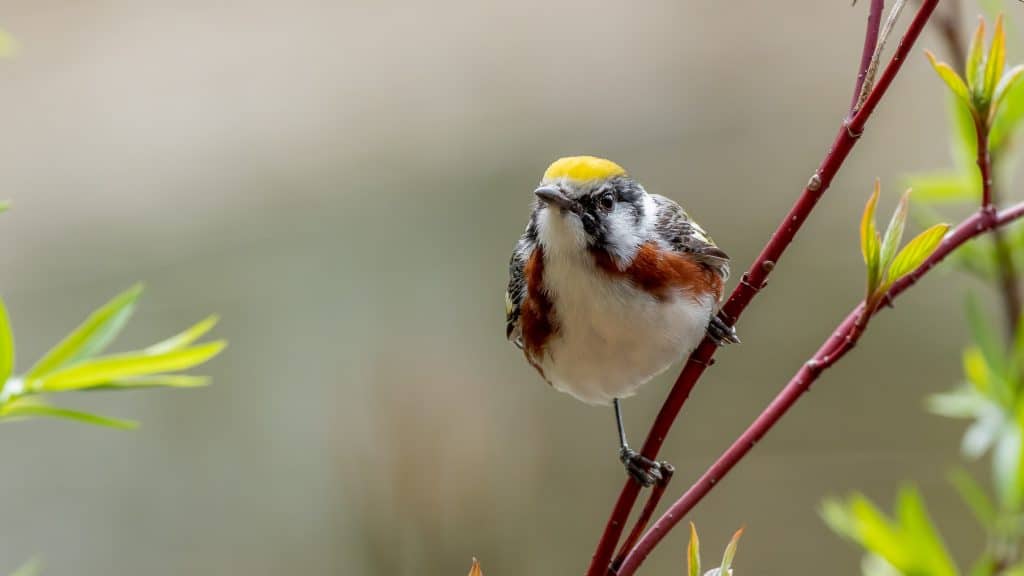
| Appearance | The chestnut-sided warbler is a small bird about 5″ long. It has an array of colors: a yellow cap, black mask, white on the face, chin, chest, and belly, yellow wing bars, and chestnut below the gray wings. The female is the same except she has brown below the wings rather than chestnut. |
| Diet | Insects and berries. |
| Feeder Food | Unlikely to visit a feeder. |
| Habitat | Thickly forested areas with young deciduous trees. |
| Nesting | A cup-shaped nest. They have 1 brood/season, and 3-5 eggs/brood that are white with brown markings. Incubation is for 12-13 days. |
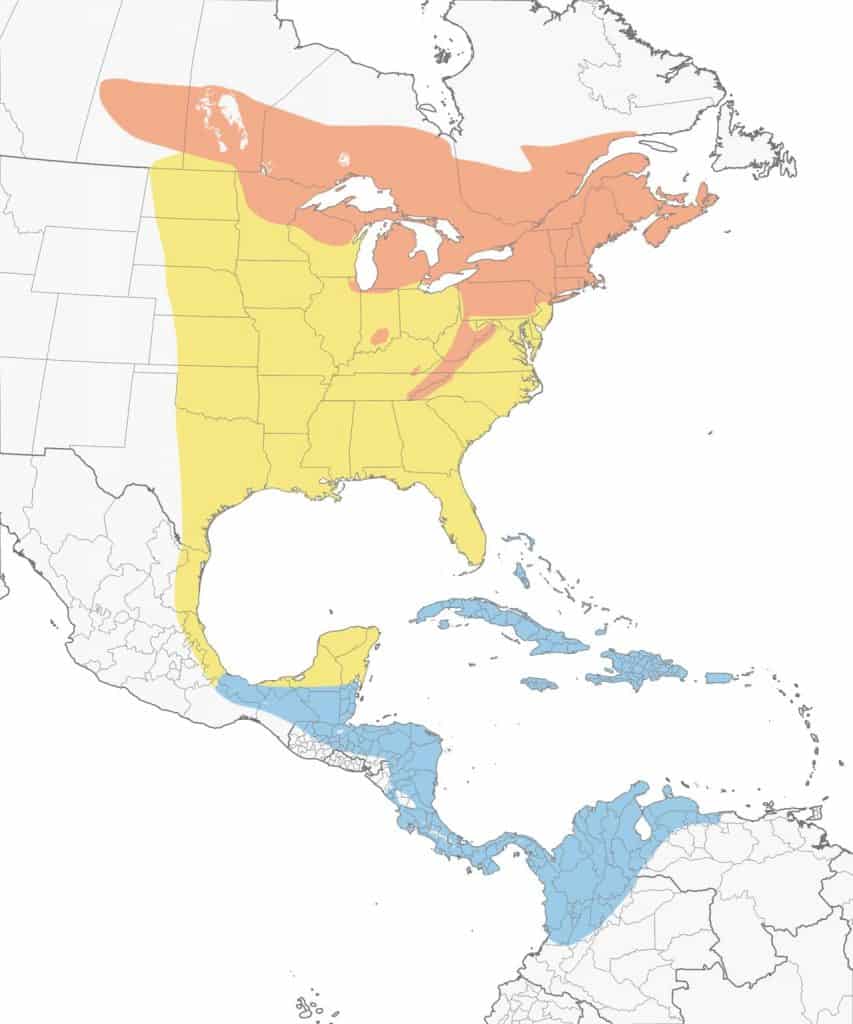
Chimney Swift
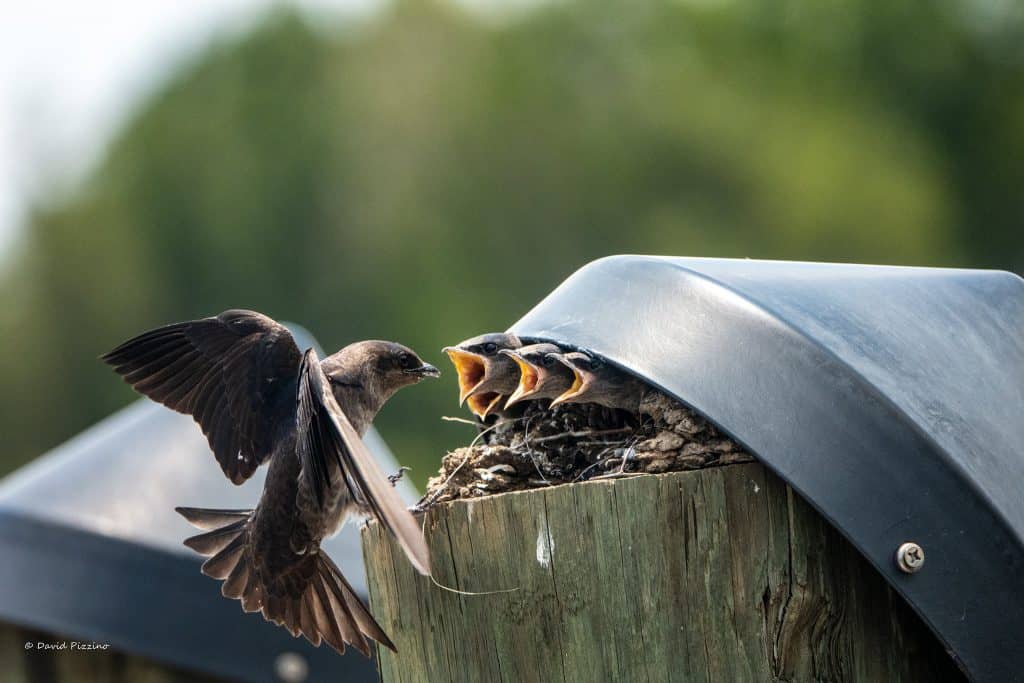
| Appearance | A small bird about 5″ long, all brown in color. The long, thin body is accented with a pointed tail and head. Male and female look the same. |
| Diet | Insects |
| Feeder Food | Unlikely to visit a feeder. |
| Habitat | Open areas within their range, especially near water. |
| Nesting | Commonly make a nest of tiny swigs, cemented in saliva and attached to the inside of chimneys or hollow trees. They have 1-2 broods/year, 3-5 eggs/brood, eggs are white with no markings, and incubation is 19-21 days. |
Range Map
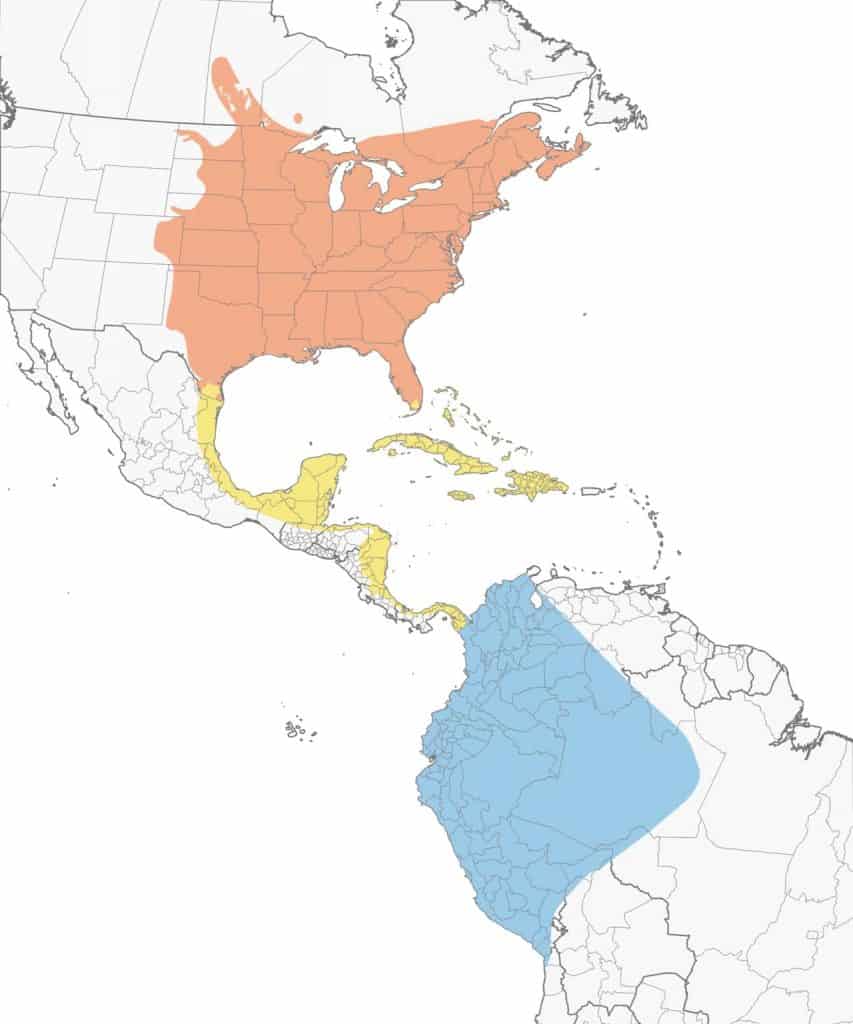
Chipping Sparrow

Appearance: The chipping sparrow is a small bird about 5″ long, gray/brown with a light gray chest and rusty crown. Eyes have white eyebrows with a black eye lining, a thin gray-black bill, and 2 wing bars. Males and females look the same.
Diet: Insects and seeds.
Feeder food: Black-oil sunflower seed, mixed seeds. Mostly a ground feeder.
Habitat: Open areas and edges of woodlands.
Nesting: The nest is placed low in dense shrubs. They have 2 broods/year and 3-5 eggs/brood that are blue/green with brown markings. Incubation lasts 11-14 days.
Migration: Chipping sparrows are migrators. In spring they migrate north into every US state and Canadian province o breed and raise their young. Then in the fall, they head back south to southern California, Arizona, Florida, Georgia, Mexico, and the Caribbean islands for winter.
Breeding range: All US states and Canadian provinces.
Winter range: Southeastern California, southwestern Arizona, the pacific coasts of Mexico, Florida, southwestern Georgia, and the Caribbean island.
Year-round range: A population of the birds remains in their year-round range in central to southern California as well as parts of Central America.
Range Map

Cliff Swallow
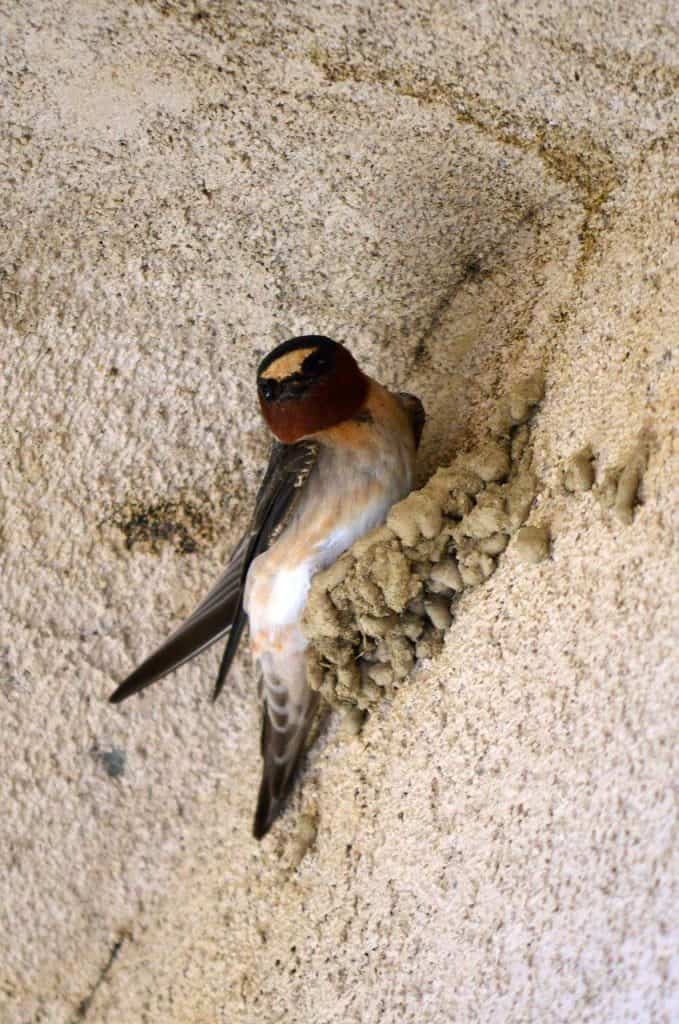
| Appearance | Cliff swallows are small birds about 5 1/2″ long with a chunky body, and short, square tail, and a short, pointy bill. They have a dark navy blue head & throat, white forehead, black wings with a navy patch, cinnamon throat, striped chest, and rump. Underparts are primarily white. |
| Diet | Flying insects. |
| Feeder Food | They don’t visit feeders. |
| Habitat | Open areas, overhanging cliffs, and man-made structures for nesting. |
| Nesting | They build their nests plastered to a sheltered rock wall of building often in large colonies with nests tightly packed in. They have 1-2 broods/season with 1-6 white, creamy or pink eggs in each brood. Incubation is for 10-19 days and nestlings fledge the nest about 20-26 days after hatching. |
Range Map
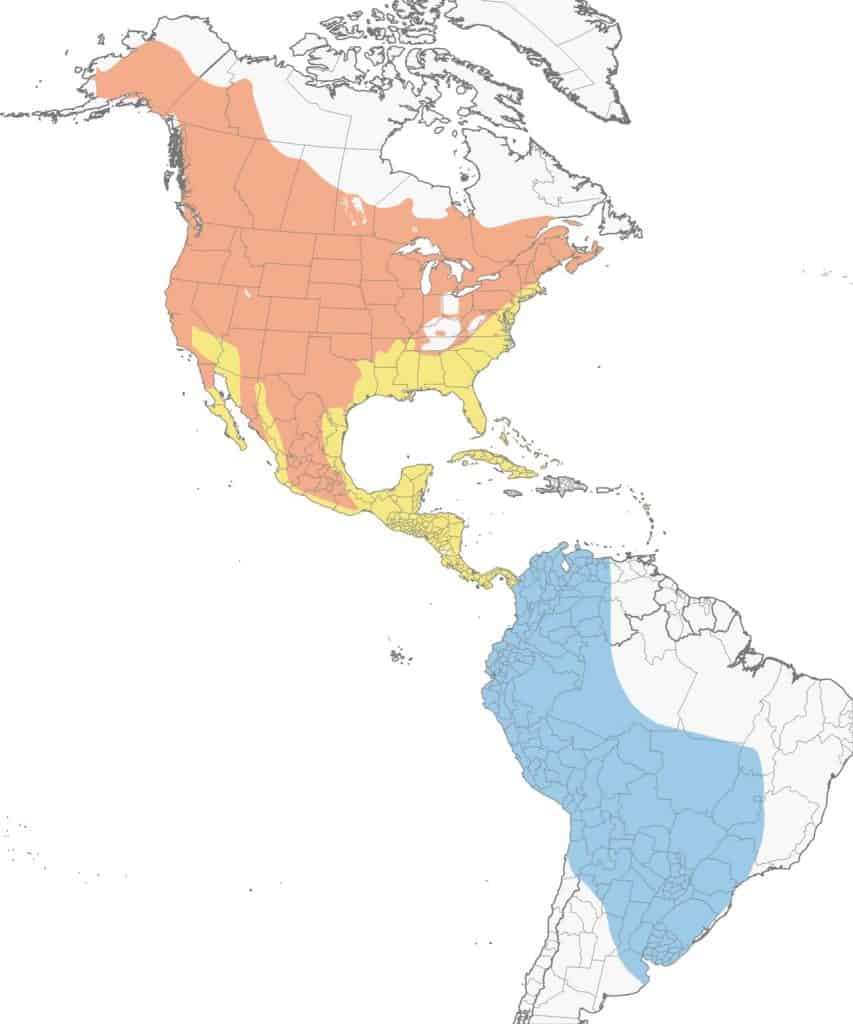
Common Grackle
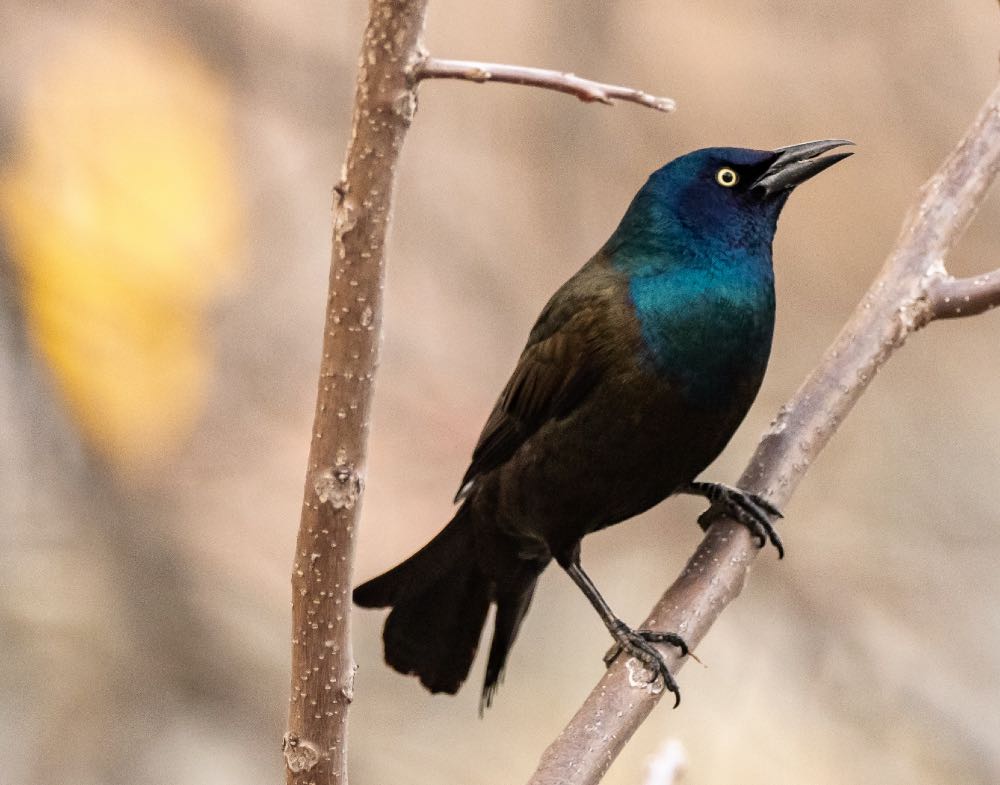
Appearance: The common grackle is a large bird about 12.5″ long bird with iridescent blue purple and bronze. Their eyes are yellow and they have long flared tails. The female is similar with less vibrant coloring (browner) and a shorter tail.
Diet: Insects, grains, seeds, fruit, scavenged garbage.
Feeder food: Sunflower seeds, black-oil sunflower seeds.
Habitat: Fields with scattered trees, open woodlands, farmlands, and marshes. Common in suburban yards.
Nesting: Bulky cup-shaped nest of twigs placed 3-20′ high in a conifer tree. 3-5 eggs incubated for 12-15 days. Young fledge at about 12-15 days.
Migration: Common grackles are migrators. While many remain in their year-round range all four seasons, many head north in spring (as far north as Canada’s Northwest Territories) to breed and raise their young. Then in the fall, they head back south into their year-round range. A small part of the population pushes further southwest of Texas.
Year-round range: Nebraska and the US states south and east of it. US states
Breeding range: Montana, Idaho, Wyoming, Colorado, New Mexico, North Dakota, South Dakota, Kansas, western Kansas, Minnesota, Wisconsin, Michigan, the New England states, and all Canadian provinces (except for Nunavut and barely British Columbia).
Winter range: Southwest edge of their Texas year-round range.
Range Map

Common Nighthawk
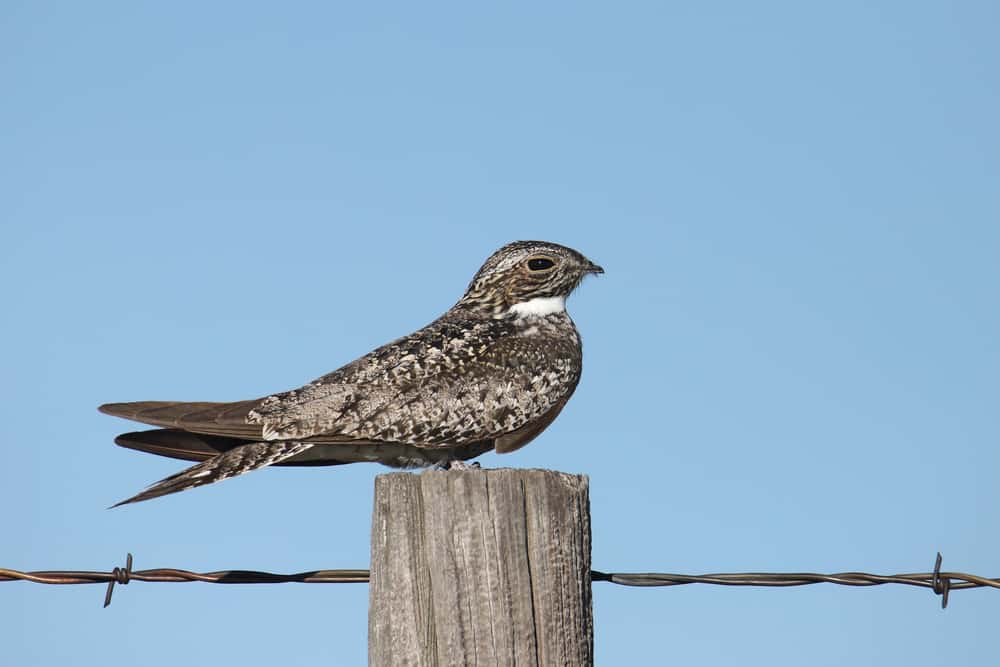
| Appearance | Medium-sized bird about 9″ long with camouflaged brown and white coloration. Chin is white and white bands displayed across wings and tail that you can only see while they’re in flight. Female same as male except for a tan chin and no white tail band. |
| Diet | Insects caught in the air. |
| Feeder Food | Unlikely to visit a feeder. |
| Habitat | They’re found throughout the US and Canada wherever open areas are found, edges of woods, residential and urban, prairies, grasslands, etc. |
| Nesting | They don’t build or use nests. They lay eggs on the ground, usually on rocks or a rooftop (when gravel vs smooth surface). 1-2 broods/year, 2 eggs/brood that is cream color with lavender spots. Incubation lasts 19-20 days. |
Range Map
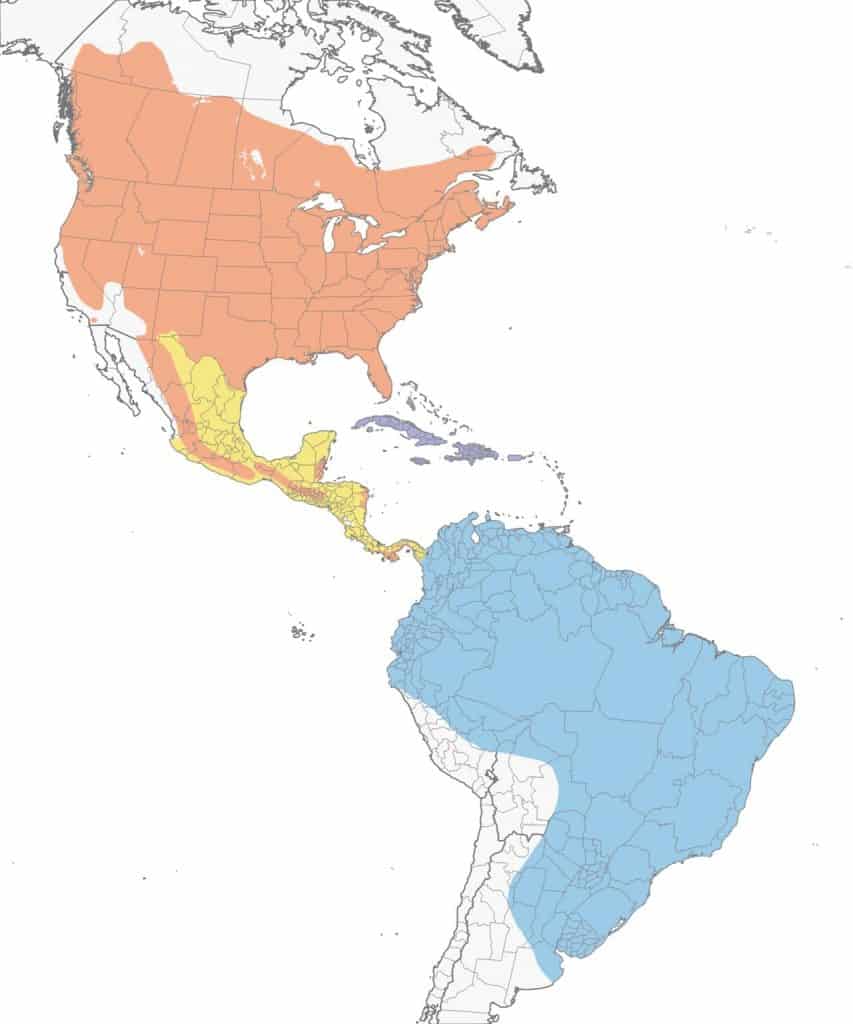
Common Raven
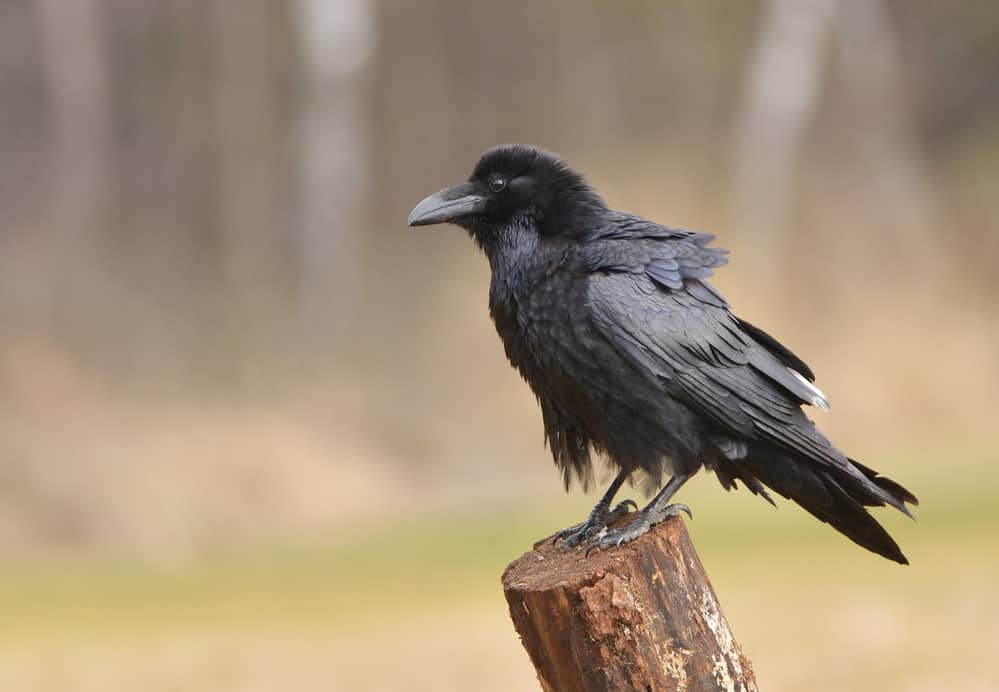
| Appearance | The common raven is a very large bird about 22-27″ long. It’s all black with a large black bill and a jagged array of feathers on its chin. The tail is also large and shaped like a wedge. The female is the same as the male. |
| Diet | Insects, fruit, small animals, carrion. |
| Feeder Food | Black-oil sunflower seed, hulled sunflower seed, suet, cracked corn, peanuts, and peanut hearts. |
| Habitat | Forested areas. |
| Nesting | They build a platform nest and have 1 brood/season. They have 4-6 eggs/brood colored pale green with brown markings. Incubation is for 18-21 days. |
Range Map

Common Redpoll
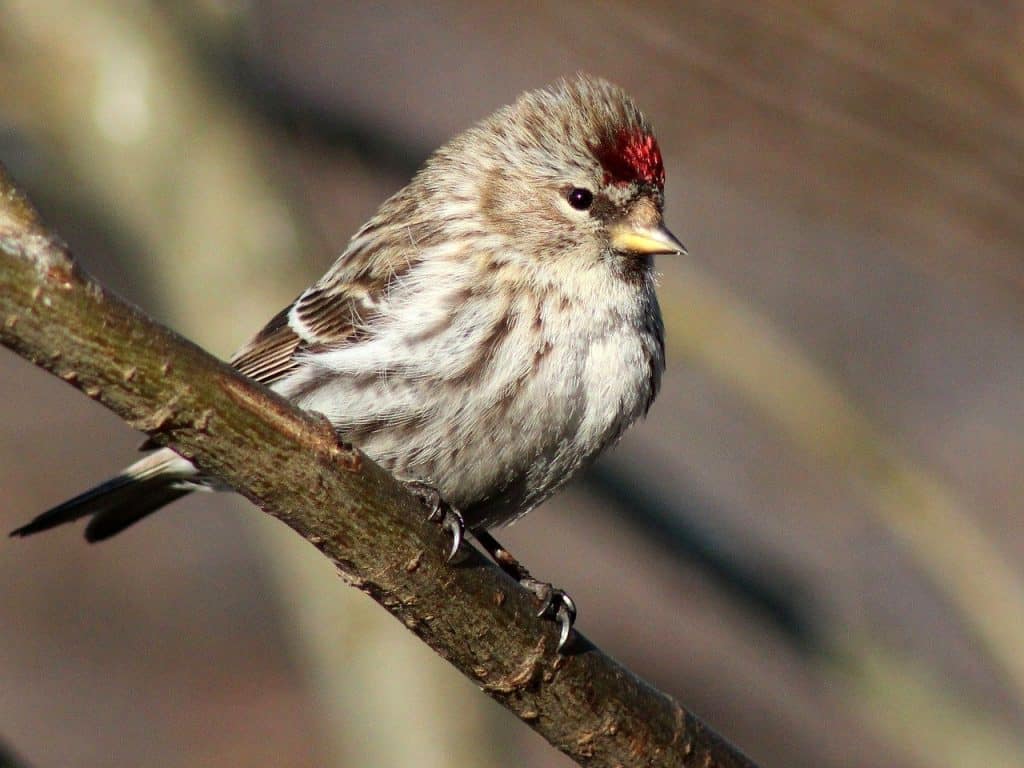
| Appearance | The common redpoll is a small bird about 5″ long. It’s a heavily streaked bird with a bright red crown, a black spot beneath the chin, and raspberry splotch on its chest. The female is similar except without the raspberry chest. |
| Diet | Seeds, insects. |
| Feeder Food | Black-oil sunflower seed, hulled sunflower seed, and nyjer. |
| Habitat | Open areas lined with trees. |
| Nesting | Cup-shaped nest. They have 1 brood/season and 4-5 eggs/brood that are pale green with purple markings. |
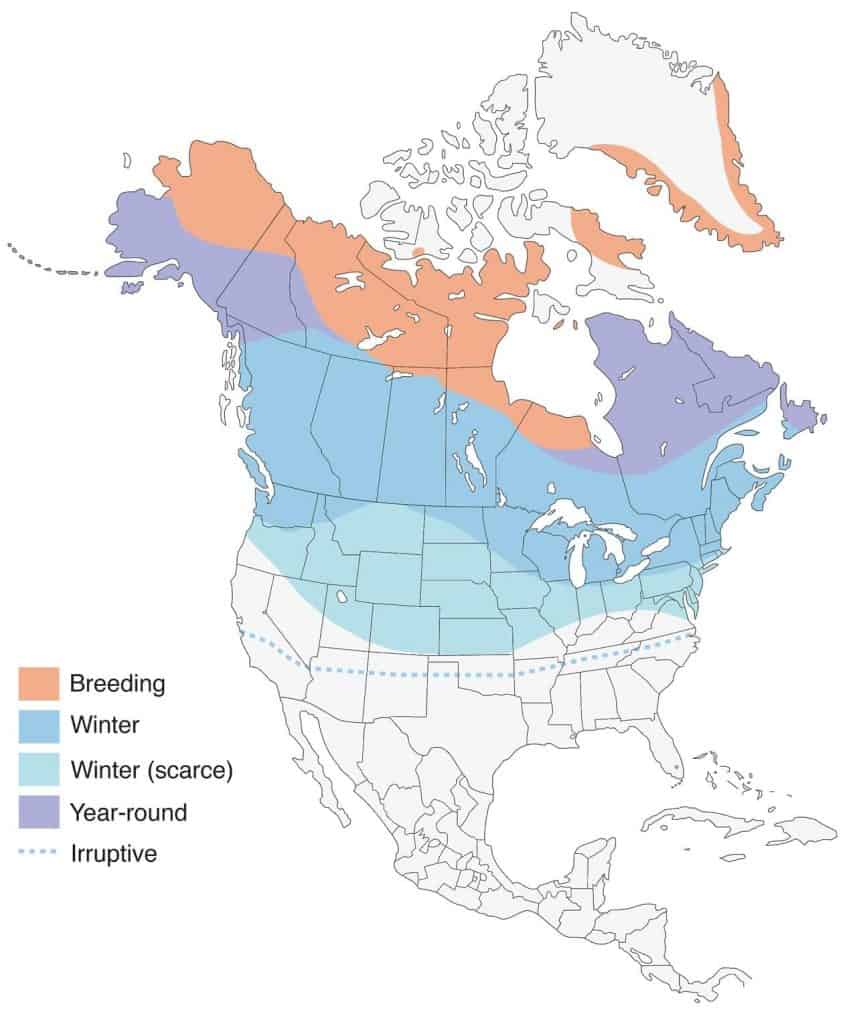
Range Map
Common Yellowthroat
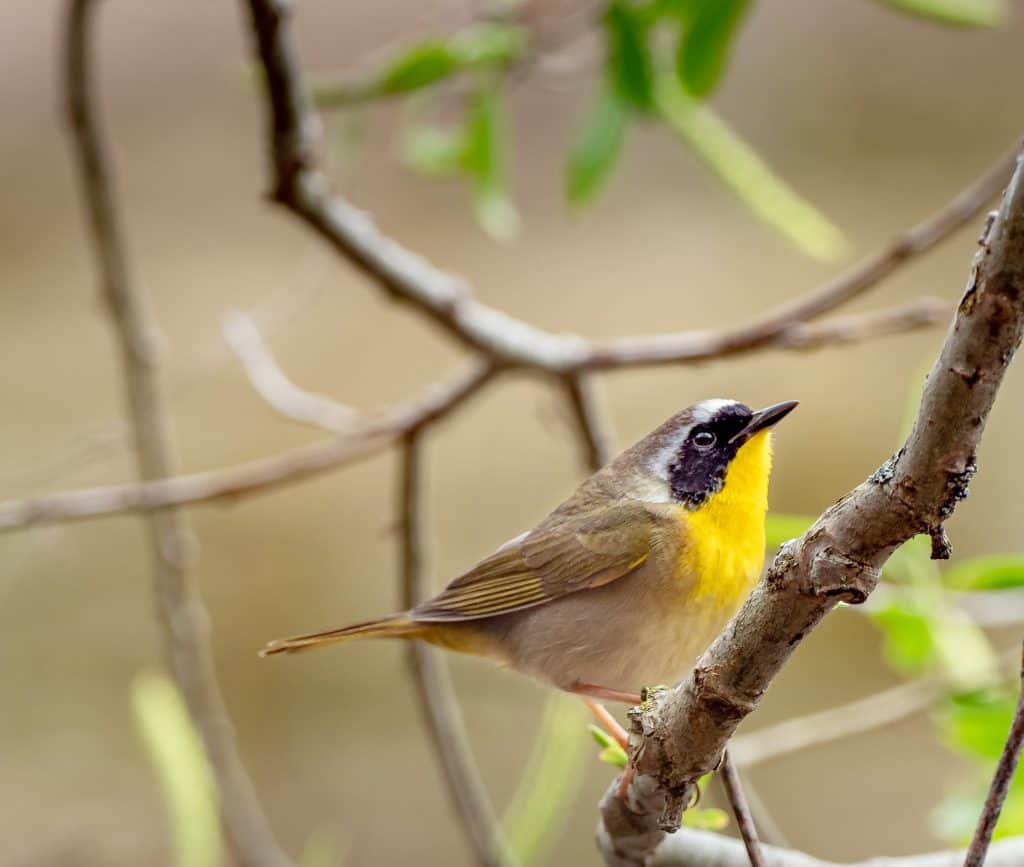
| Appearance | Small bird about 5″ long, olive-brown color with bright yellow throat and breast, and white belly. Black mask outlined in white. Long, thin, and pointy black bill. The Female is the same except with no black mask. |
| Diet | Insects. |
| Feeder Food | Unlikely to visit a feeder. |
| Habitat | Common in thick brush, open fields, and marshes. |
| Nesting | Cup-shaped nest located near the ground, often in a thick shrub. They have 2 broods/year, 1-6 eggs/brood, eggs are white with brown markings, and incubation lasts 11-12 days. |
Range Map
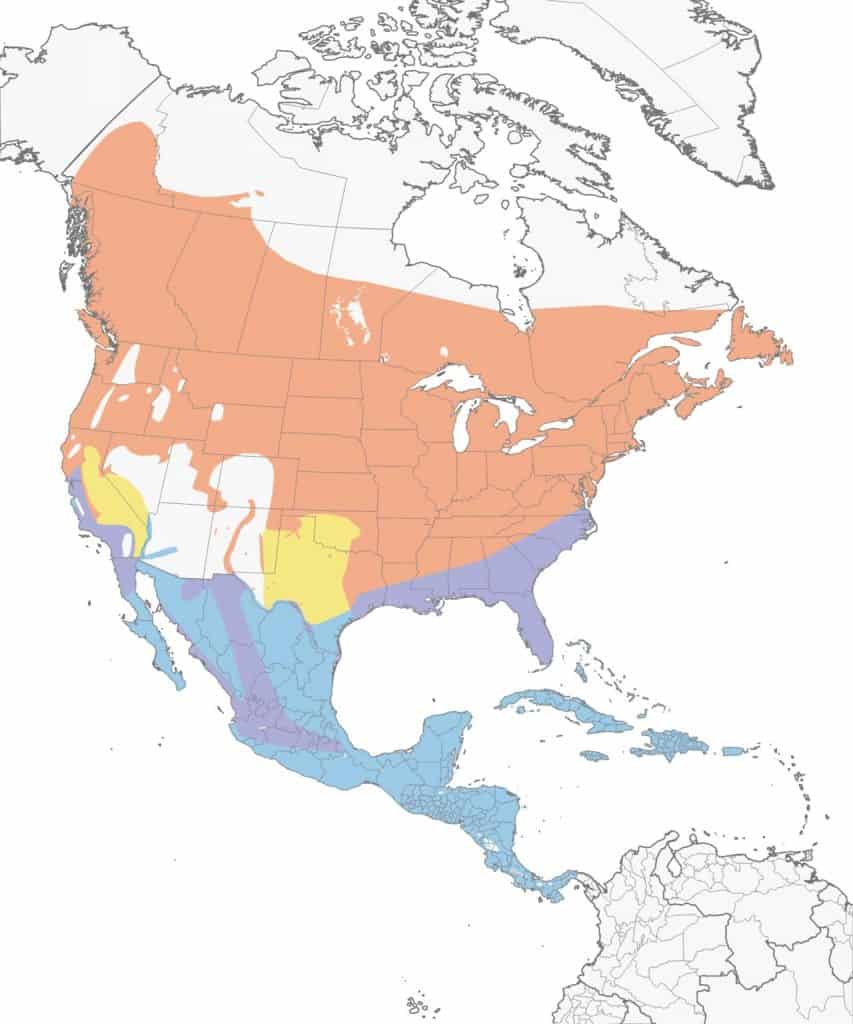
Connecticut Warbler
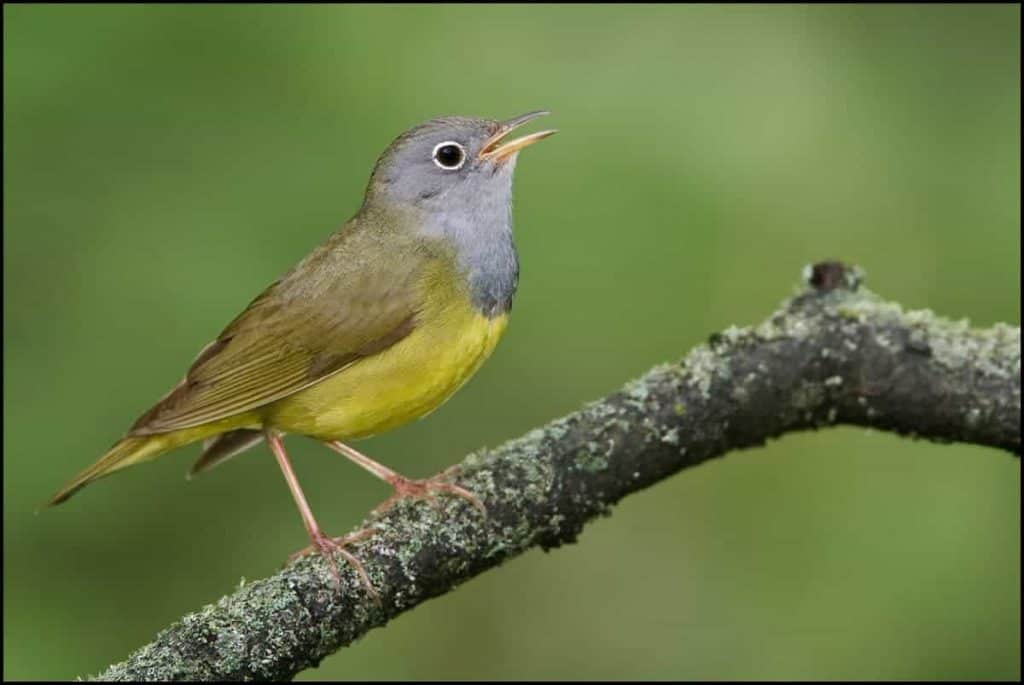
| Appearance | Small bird about 5 1/2″ long with a gray head, white eyering, yellow belly, and brownish wings. Females are a duller version of the male and tend to be more brown than gray. |
| Diet | Insects and spiders. |
| Feeder Food | Unlikely to visit a feeder. |
| Habitat | Open woodland areas, often in wet, marshy areas as well. |
| Nesting | Their cup-shaped nest is located near the ground. They have 1 brood/year with 3-5 eggs/brood. Eggs are ivory with dark spots. |
Range Map
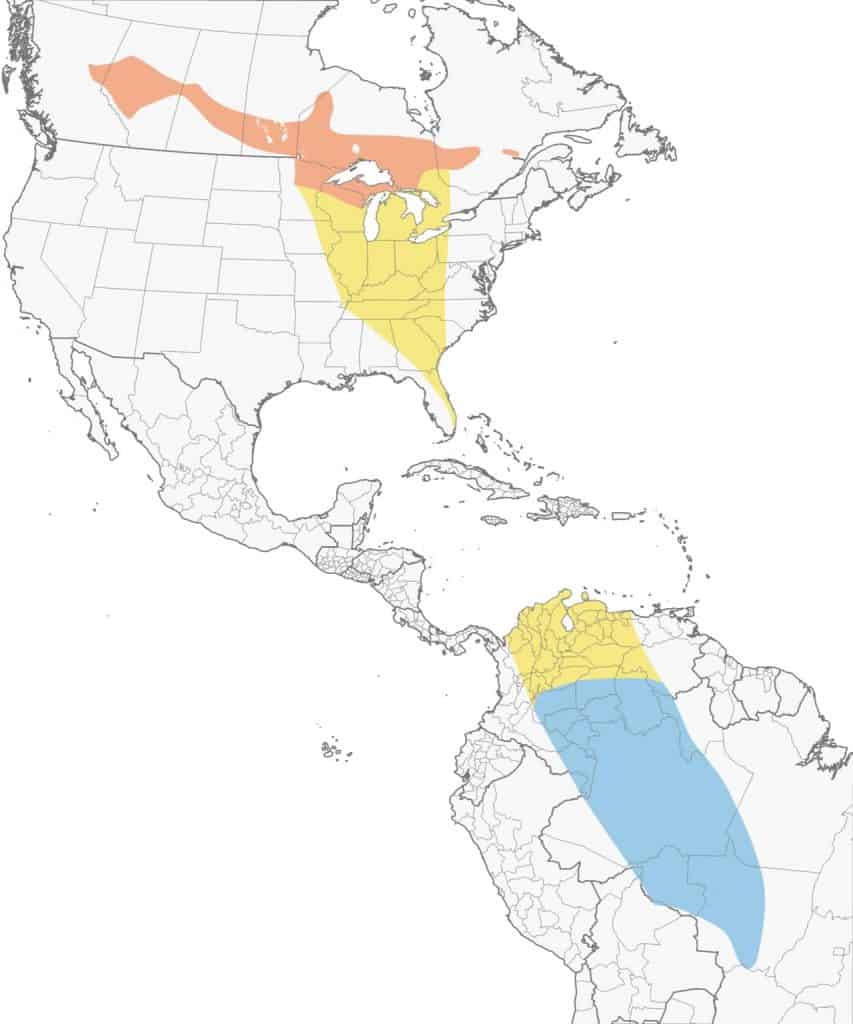
Cooper’s Hawk
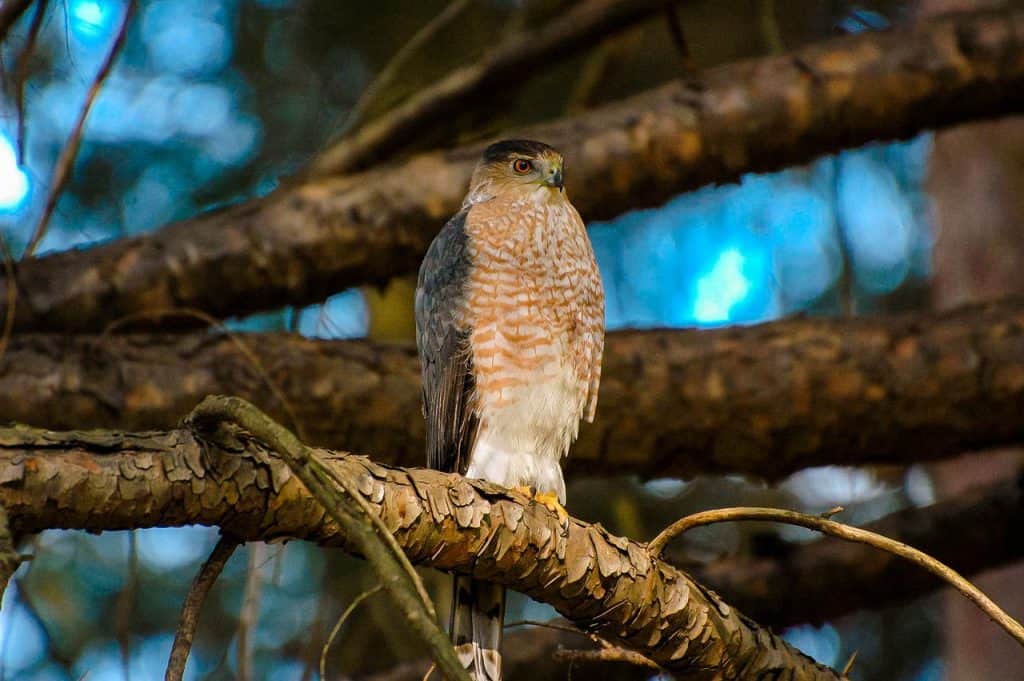
| Appearance | Cooper’s hawk is a medium-sized bird about 15-18″ long. They’re blue-gray with rusty underparts, and a black cap. |
| Diet | Birds less than 12″ long and small mammals. |
| Feeder Food | They don’t visit feeders. |
| Habitat | Forests and forested areas. |
| Nesting | They build large nests, about 27″ in diameter, in trees about 25-50 up where branches intersect in a forked manner. They have 1 brood/season, and 2-6 eggs/brood that are pale blue to blue/white. Incubation is for 30-36 days and fledglings leave the nest at about 27-34 days after hatching. |
Range Map

Dark-Eyed Junco
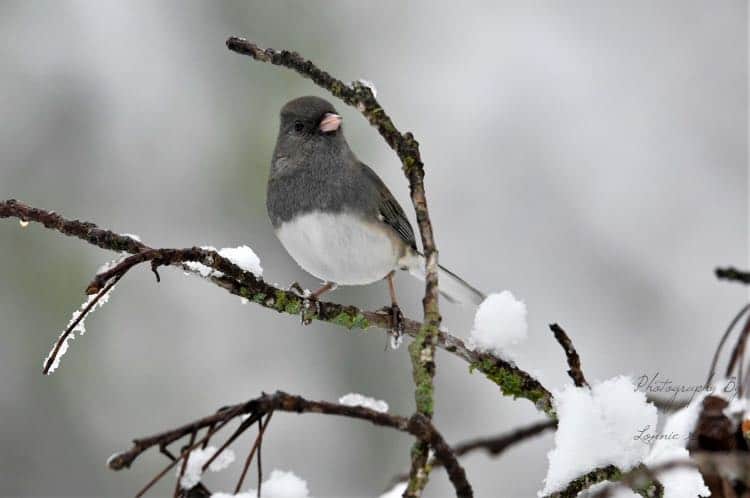
Appearance: Dark-eyed juncos are tiny birds about 5.5″ – 6.5″ long. Males are dark gray with a white underside and pink bill. Females are the same except brownish gray.
Diet: Insects, spiders, seeds.
Feeder food: Nyjer, black-oil sunflower seeds, hulled sunflower seeds, safflower seeds, cracked corn, hulled peanuts, and suet.
Habitat: Juncos are found across the US and Canada so can be found in a variety of habitats including forested areas (both coniferous and deciduous), wide-open spaces, partially wooded edges, parks, and backyards.
Nesting: Nests are located in a variety of locations from ground-level surrounded by vegetation to in a hanging basket. They have 1-3 broods/season, 3-6 eggs per brood that can be any of these colors: White, gray, pale bluish-white, or pale-greenish white speckled with brown, gray, and green. Occasionally unmarked. Incubation lasts 9-13 days.
Migration: Dark-eyed juncos are partial migrators. Some remain in their year-round range all seasons of the year while others migrate north in spring and south for the winter.
Year-round range: Southern Alaska, Washington, Oregon, Idaho, Montana, Wyoming, Utah, California, Nevada, Colorado, Arizona, New Mexico, northern Minnesota, Wisconsin & Michigan, Pennsylvania, New York, New England, and British Columbia & Alberta in Canada.
Breeding range: Alaska and Canada.
Winter range: The remaining US states (outside the year-round range above), southeast Alberta, southern Saskatchewan, far southeast Ontario, and Mexico.
Range Map
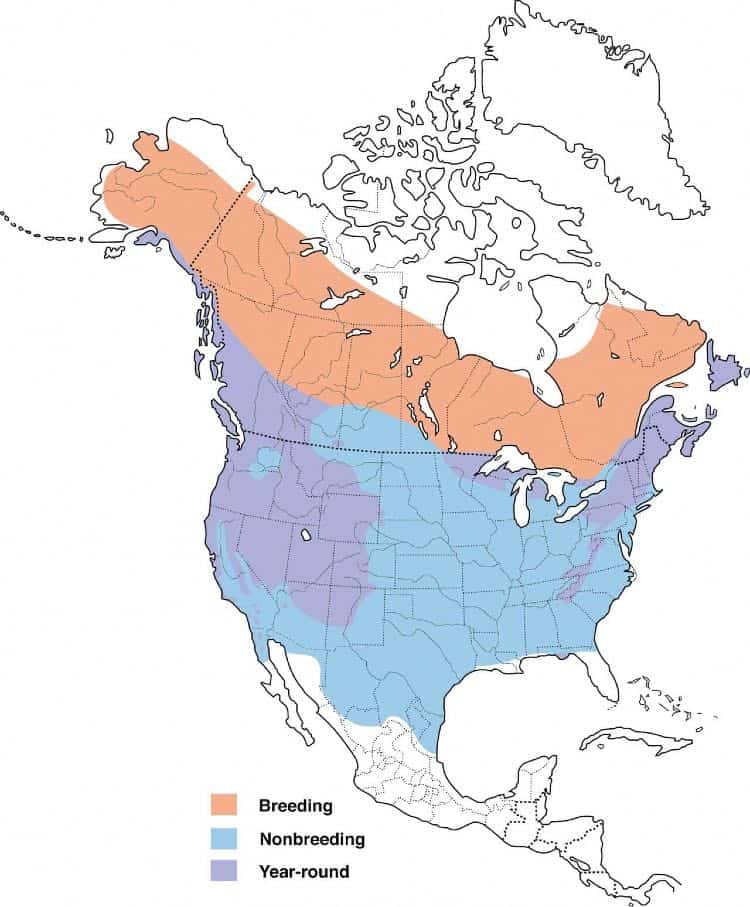
Want to see dark-eyed juncos in your yard? Check out my article: 7 Proven Ways to Attract Dark-Eyed Juncos.
Downy Woodpecker

Appearance: Downy woodpeckers are small birds 6″ – 7″ long. Males are tuxedo-black with a white stripe on the back, white belly, white outer tail feathers, some spotted areas of white on the wings, a yellow/tan spot above the beak, and the infamous red patch on his head at the back of the crown. Females are nearly identical without red coloring.
Diet: Insects, and fruit from trees/shrubs.
Feeder food: Suet, peanut butter spread, Sunflower seeds, Safflower seeds, hulled peanuts, corn, fruits, nectar (sugar water).
Habitat: Anywhere there are trees.
Nesting: Downy woodpeckers nest in cavities – either a hole in a tree trunk or a nesting box. Usually only one brood per season, 3-6 all-white eggs. Incubation is about 11-12 days.
Migration: Downy woodpeckers are not migrators. They remain in their year-round range all four seasons.
Year-round range: Every US state and Canadian province (except Nunavut).
Range Map
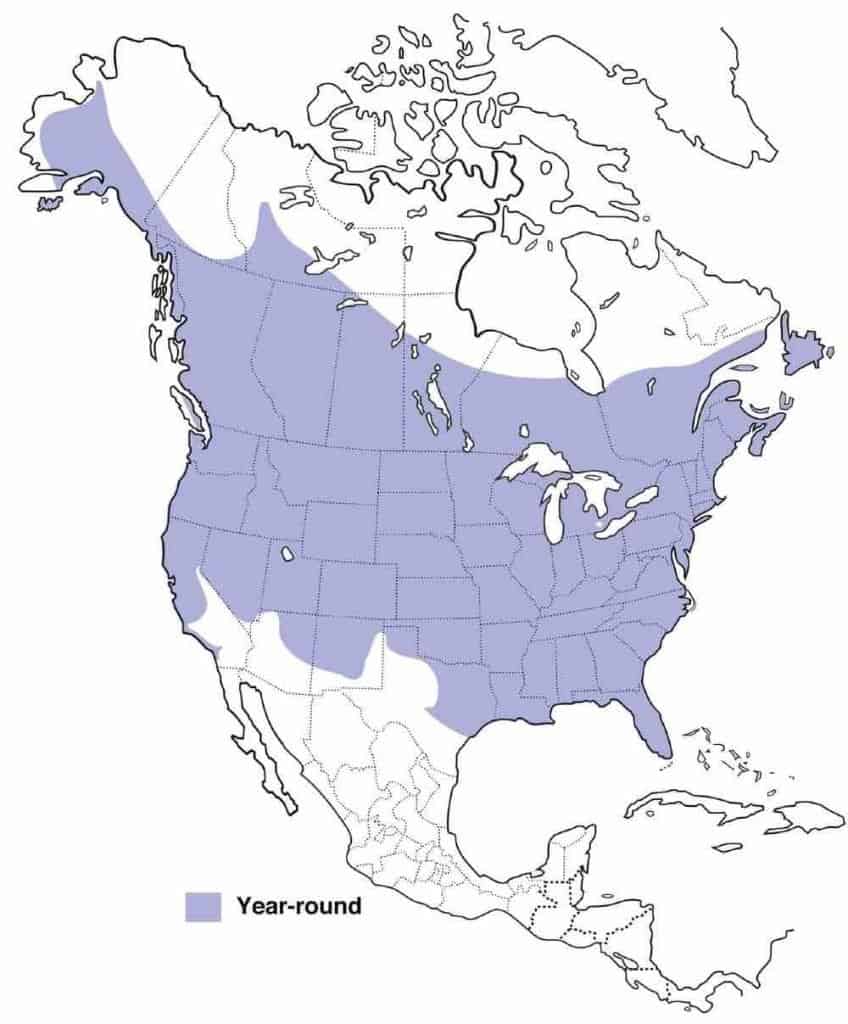
Eastern Bluebird
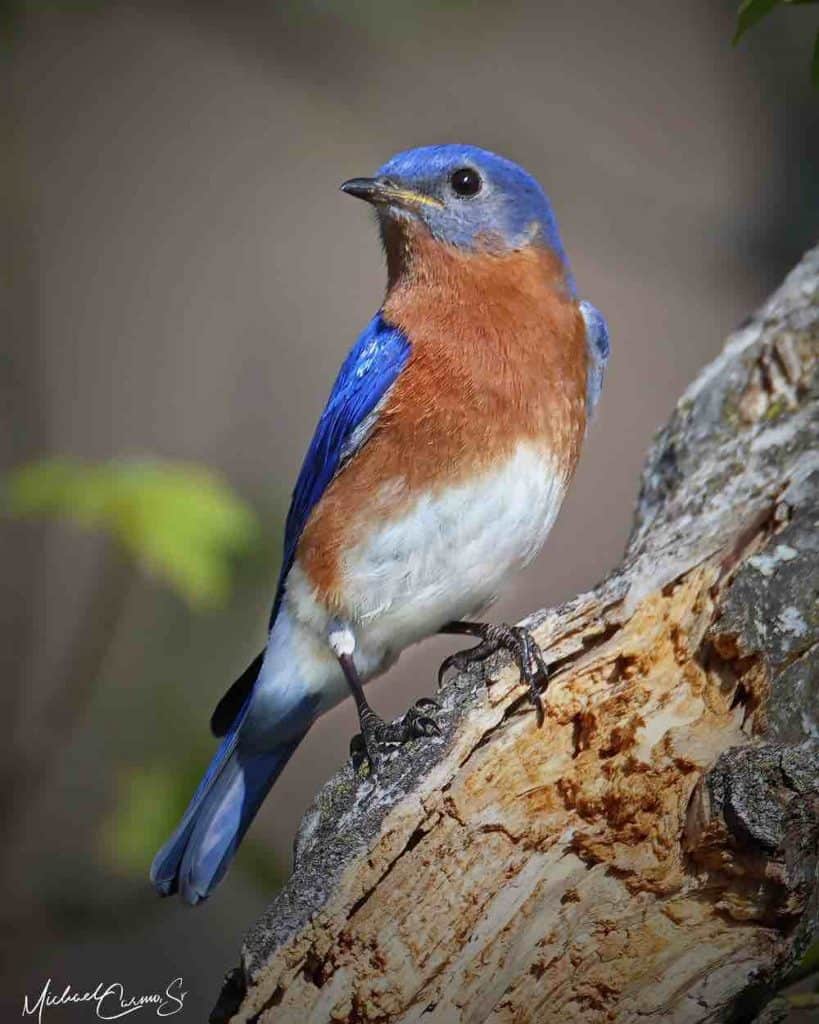
Appearance: Eastern bluebirds are small birds about 7″ long, royal blue, orange throat & breast, white belly & undertail. Female is similar but with more muted colors
Diet: Insects & spiders in spring/summer. Small fruit in Fall/Winter.
Feeder food: Suet, sunflower seeds, dried fruit, jelly.
Habitat: Wide-open spaces, fields, meadows.
Nesting:
- Nest: Cavity nesters. The male bluebird determines the nest site (an old woodpecker hole in a tree or manmade nestbox), but the female is the one who builds the nest. She keeps the nest for multiple broods.
- Brood: 2-7 broods/season
- Clutch: 4-5 eggs/brood
- Egg color: Pale blue eggs (sometimes white) with no blemishes or discoloration.
- Egg size: 0.9 inches by 0.8 inches
- Incubation: 11-19 days
Migration: Some eastern bluebirds are migrators. While many remain in their year-round range all year long, some migrate north for breeding and raising their young then head south in winter back into the year-round range or further west into Colorado, New Mexico, and western Texas.
Year-round range: The US states south and east of Nebraska, Mexico, and Central America.
Breeding range: Northwest Nebraska, South Dakota, North Dakota, Minnesota, the northern half of Wisconsin & Michigan, New Hampshire, Maine, and the southern part of these Canadian provinces: Saskatchewan, Manitoba, Ontario, and Quebec.
Winter range: Eastern Colorado, New Mexico, western Texas, and northeast Mexico.
Range Map
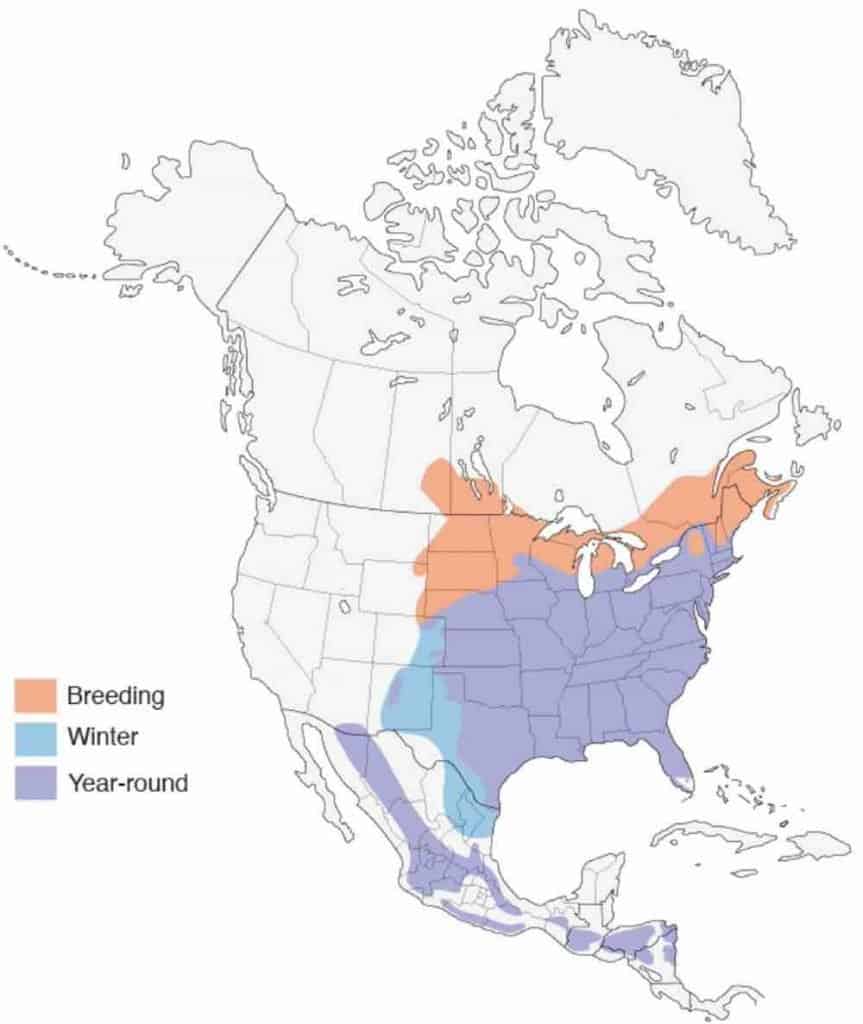
Eastern Kingbird
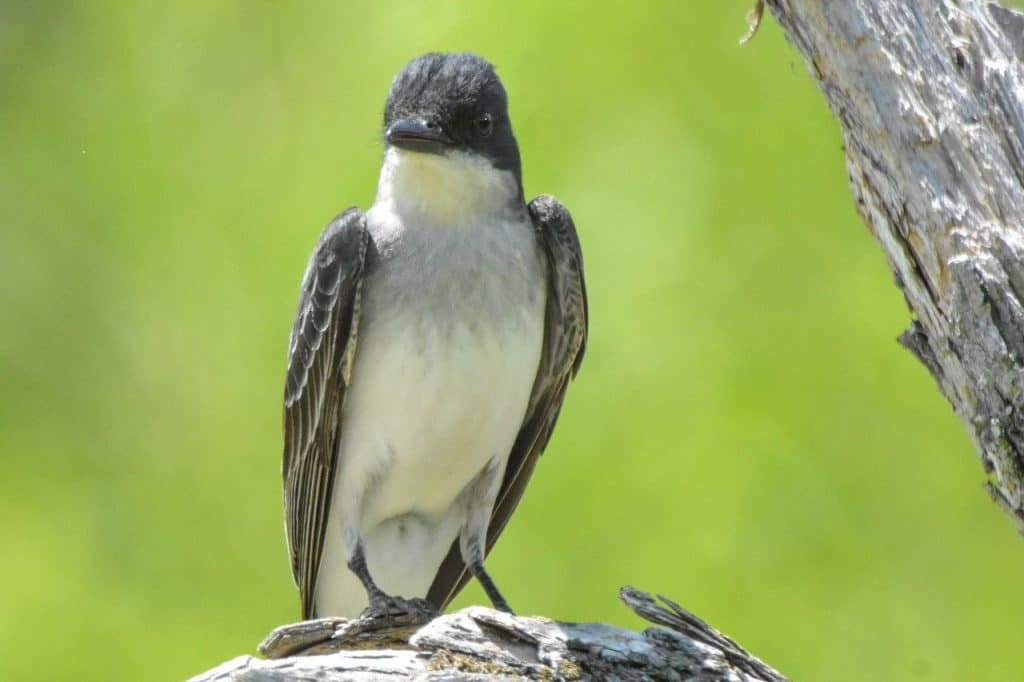
| Appearance | Medium0sized bird about 8″ long. They’re mostly charcoal gray with a black head, white belly, and white chin. A white band goes across the end of their tail and they have a red crown that is mostly concealed. |
| Diet | Insects and fruit. |
| Feeder Food | Unlikely to visit a feeder. |
| Habitat | Open fields and prairies. |
| Nesting | Cup-shaped nest. They have 1 brood/year with 33-4 eggs/brood. Eggs are white with brown markings and incubation lasts 16-18 days. |
Range Map
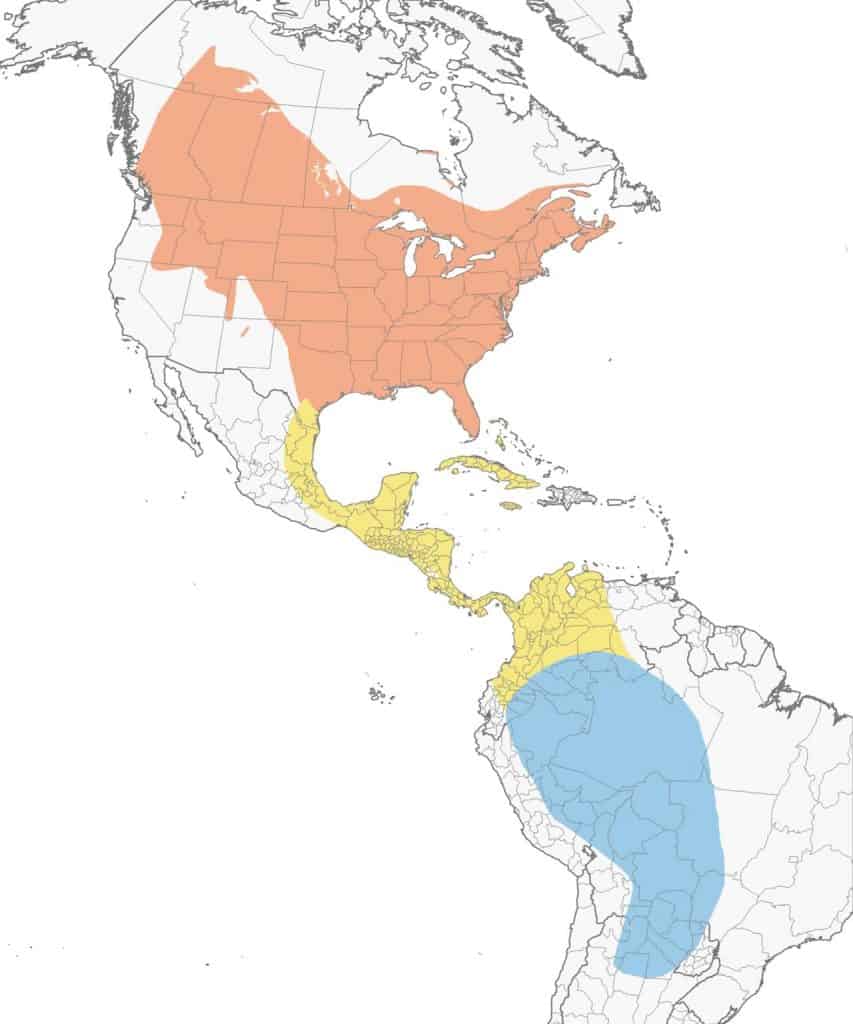
Eastern Meadowlark
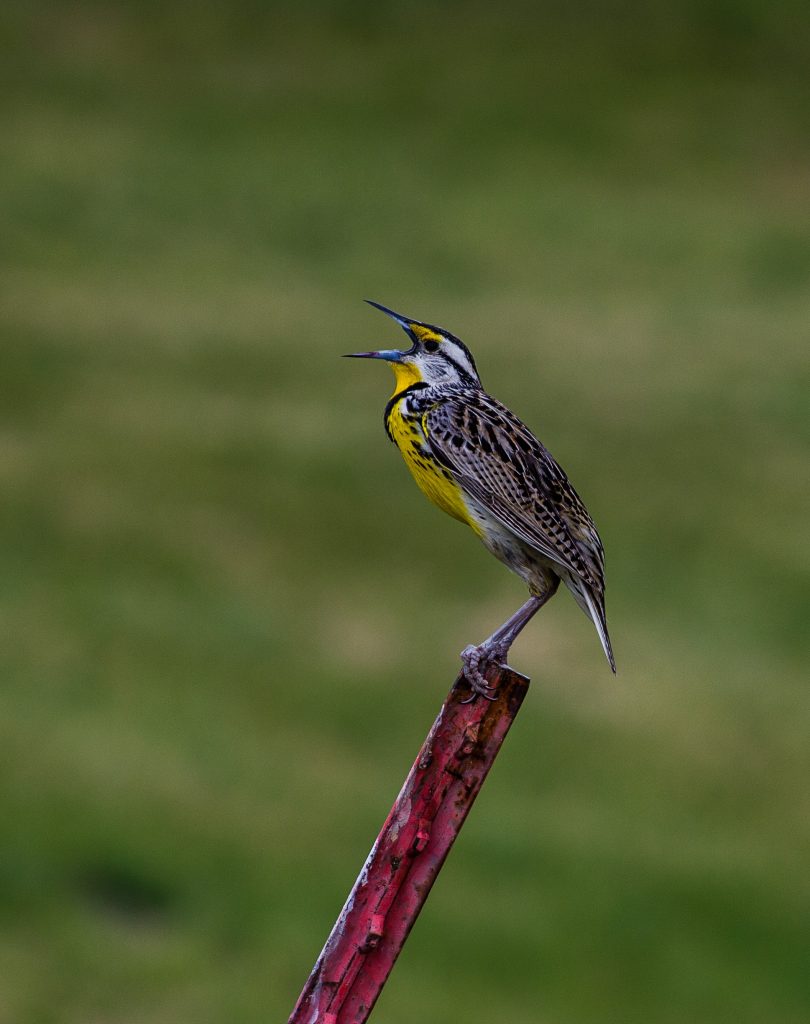
| Appearance | Large bird about 9″ long with brown back, lemon yellow-colored chest, and black v-shape around the neck. White outer tail feathers. Female and male look the same. |
| Diet | Insects and seeds. |
| Feeder Food | Hulled sunflower seeds and cracked corn. |
| Habitat | Open grassy areas. |
| Nesting | Cup-shaped nest on the ground within a dense cover. They have 2 broods/year and 3-5 eggs/brood. Eggs are white with brown markings and incubation lasts 13-15 days. |
Range Map
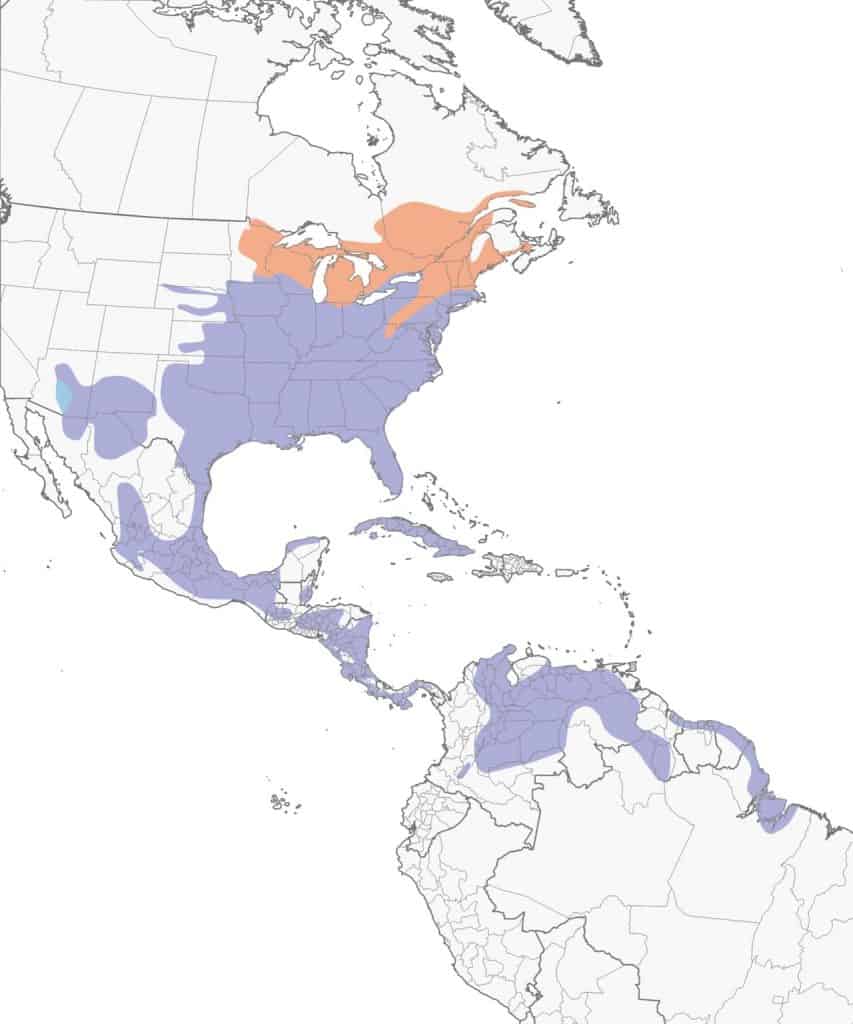
Eastern Phoebe
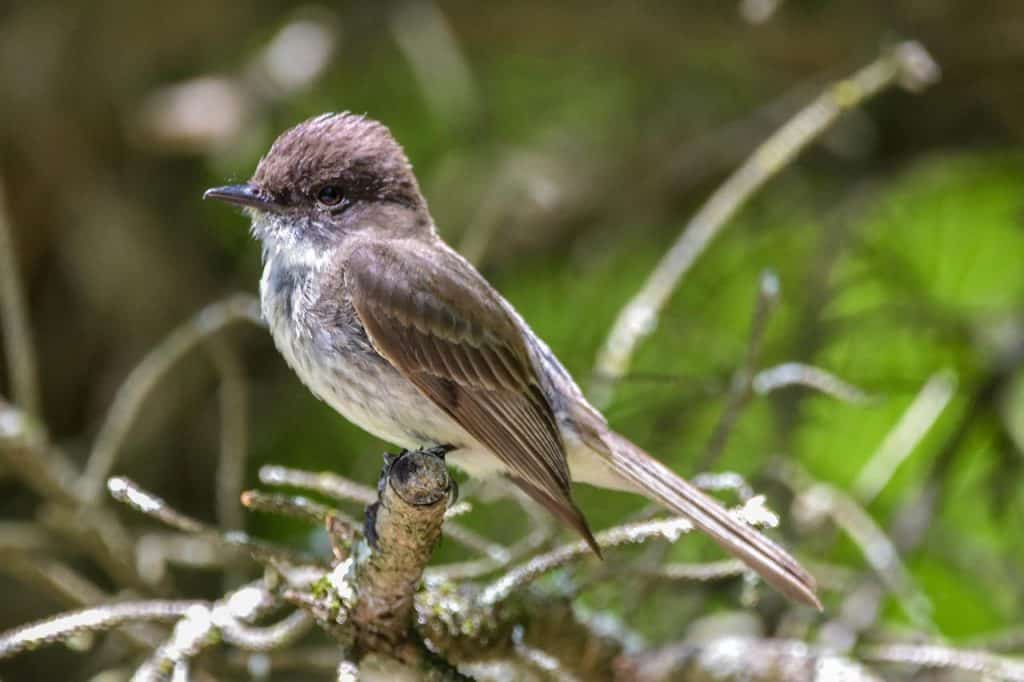
| Appearance | The eastern phoebe is a medium-sized bird about 7″ long with brown/gray above, darker on the wings & tail, white throat, and pale yellow underparts. |
| Diet | Flying insects and small fruits. |
| Feeder Food | They don’t visit feeders. |
| Habitat | Commonly found around rural homes but need some wooded area nearby as well as water. |
| Nesting | They build a cup-shaped nest and place it on a building, bridge, or other crevice-type location. They have 1-2 broods/season and usually 5 eggs/brood. The eggs are white and sometimes speckled. Incubation is for 14-16 days and fledglings leave the nest about 15-17 days after hatching. |
Range Map
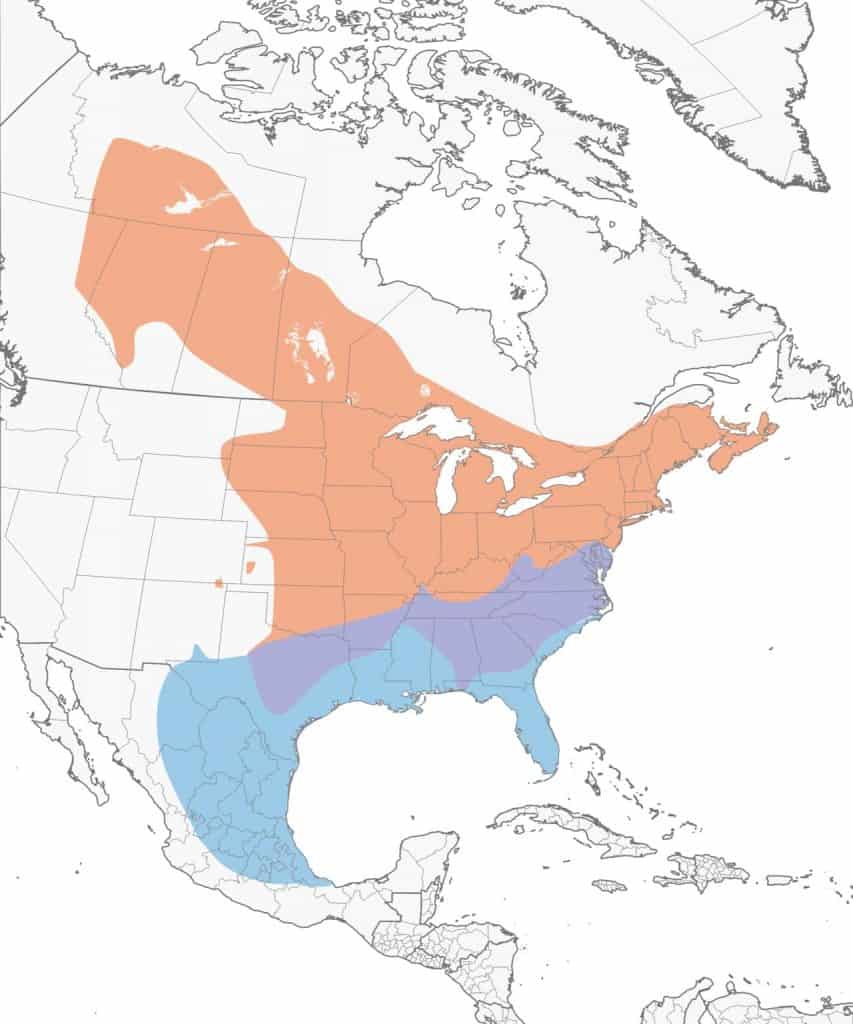
Eastern Screech-Owl
| Appearance | The eastern screech-owl is a small owl about 8 1/2″ long with a big head, little tufts of ears sticking up, and yellow eyes. There are 2 variations of coloration – primarily reddish/brown (rufous) and primarily gray. They’re darker above with white spots and tiny streaks and underparts are marked with vertical dark streaks. |
| Diet | Their diet is mostly comprised of songbirds and rodents. They also eat insects, earthworms, snakes, lizards, frogs, and crayfish. |
| Feeder Food | Eastern screech-owls do not visit feeders. |
| Habitat | Wooded habitats include forests, wooded lots, suburban backyards, and large city parks. |
| Nesting | Eastern screech-owls nest in existing tree cavities and sometimes manmade nesting boxes. They have 1 broods/season and 2-6 eggs/brood that are all white. Incubation is for 27-34 days and fledglings leave the nest about 26-30 days after hatching. |
Range Map
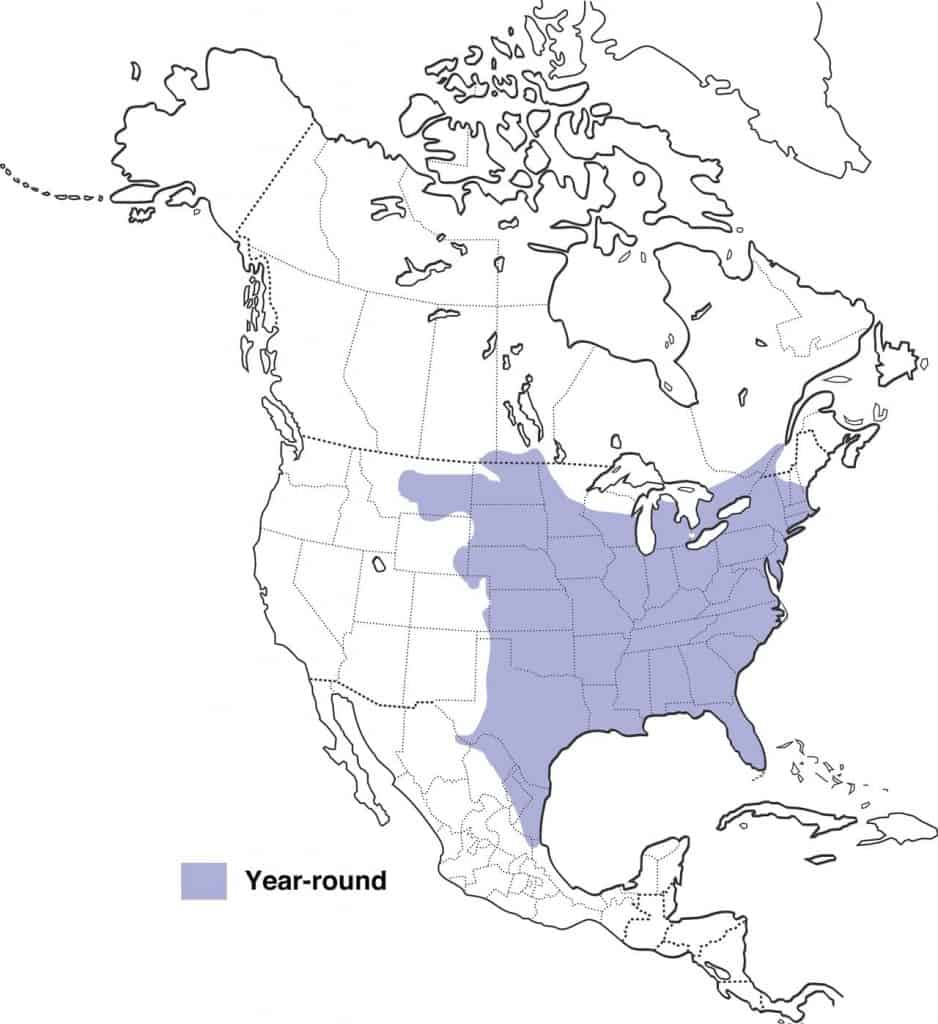
Eastern Towhee
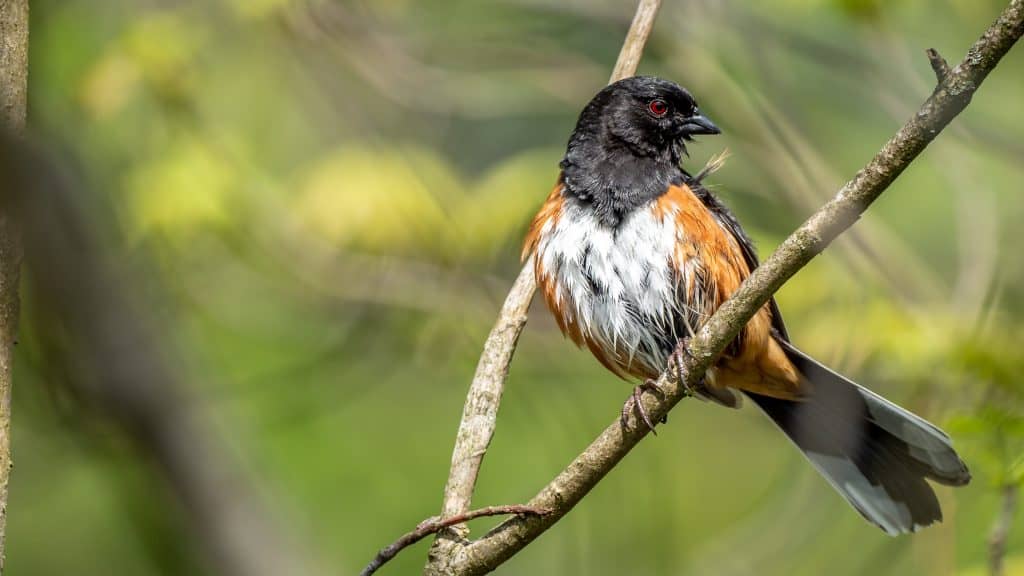
| Appearance | Small-medium-sized bird about 7-8″, mostly charcoal black with rusty-orange on the sides and a white belly. They have a long black tail with a white tip. The bill is short and pointy. They have ruby red eyes. The Female is the same but brown not black. |
| Diet | Insects, seeds, and fruit. |
| Feeder Food | Ground feeder and will eat black-oil sunflower seeds, cracked corn, millet, milo, and peanut hearts. |
| Habitat | Scrubby areas along wooded edges, thick fields, and backyards. |
| Nesting | The cup-shaped nest is typically located on the ground. They have 2 broods/year, and 3-4 eggs/brood. Eggs are ivory with brown spots and incubation lasts 12-13 days. |
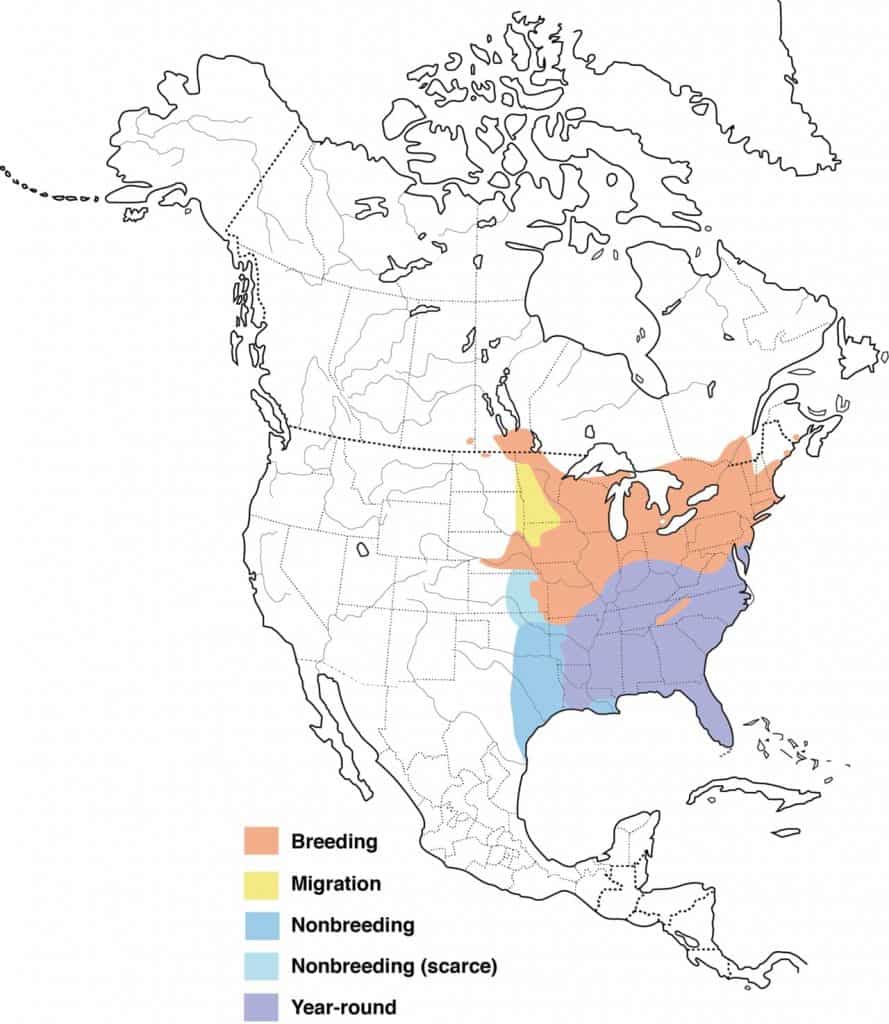
Eastern Wood-Pewee

| Appearance | Small bird about 6″ long. They are mostly gray/brown with an ivory belly, throat, and wing bars. They have short legs, upright posture, and short crowns. Short, pointy bill with orange-yellow underneath. Male and female look the same. |
| Diet | Small insects, berries, and seeds. |
| Feeder Food | Unlikely to visit a feeder. |
| Habitat | Forests and wooded areas that are thick with deciduous trees but sometimes open areas. |
| Nesting | They nest in trees high off the ground more than 15′ up. They have 2-4 eggs/brook. Eggs are ivory with brownish speckles. Incubation lasts 12-14 days. |
Range Map
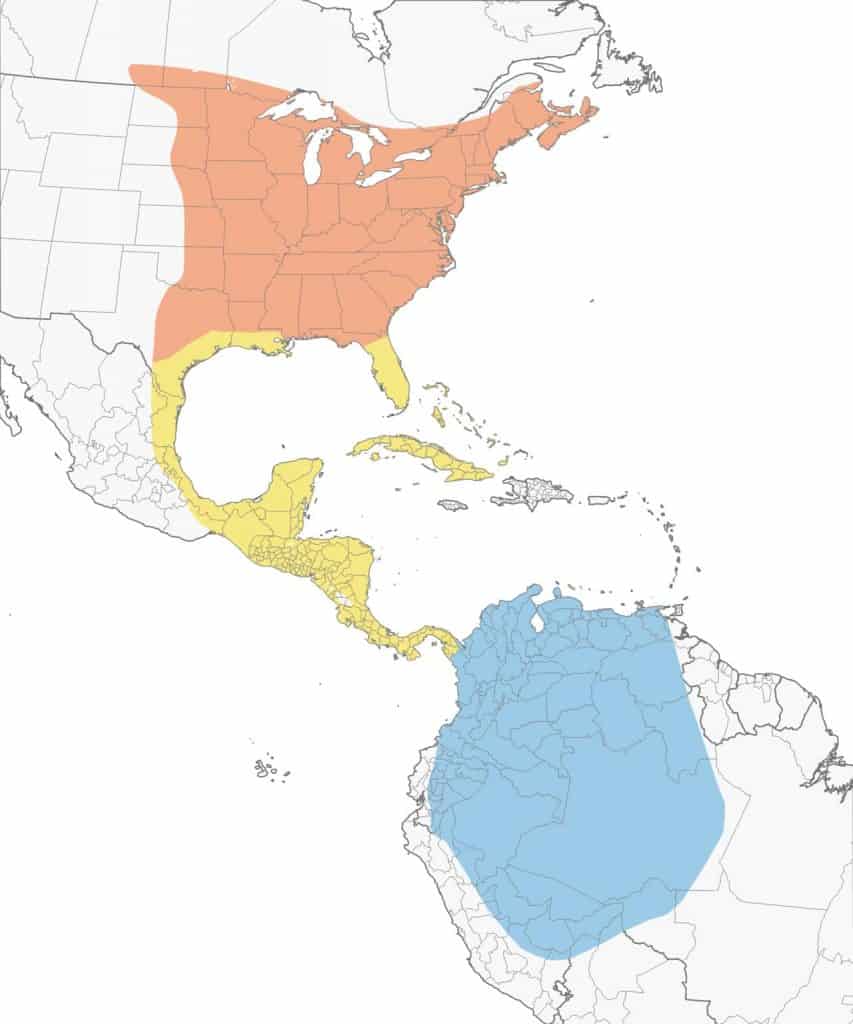
European Starling
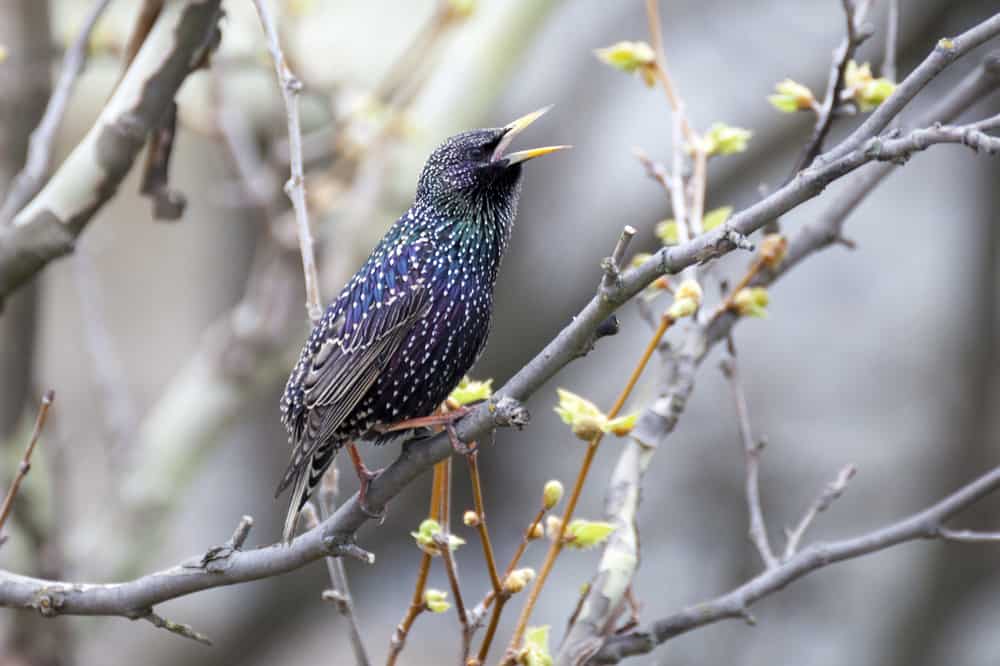
| Appearance | Medium-sized bird about 7 1/2″ long with iridescent shades of purple and black with white speckles throughout. They have a long pointed gray bill in fall and yellow in spring. The tail is short. The Female looks the same. |
| Diet | Insects, seeds, fruit. |
| Feeder Food | Everything and anything you could offer at the feeder. |
| Habitat | Urban and residential areas throughout the US and Canada including backyard lawns, parks, and fields. |
| Nesting | Nest: They are cavity nesters Brood: 2 broods/year. Clutch: 4-6 eggs/brood Egg color: Glossy bluish or a pale green Egg size: 1.1 – 1.3 inches by 0.8 – 0.9 inches Incubation: 12-14 days. |
| Migration | North American European starlings are not migrators. They remain in their year-round range all seasons of the year. That said, some may head further south into Mexico for winter. Year-round range: Every US state and Canadian province, and Mexico. |
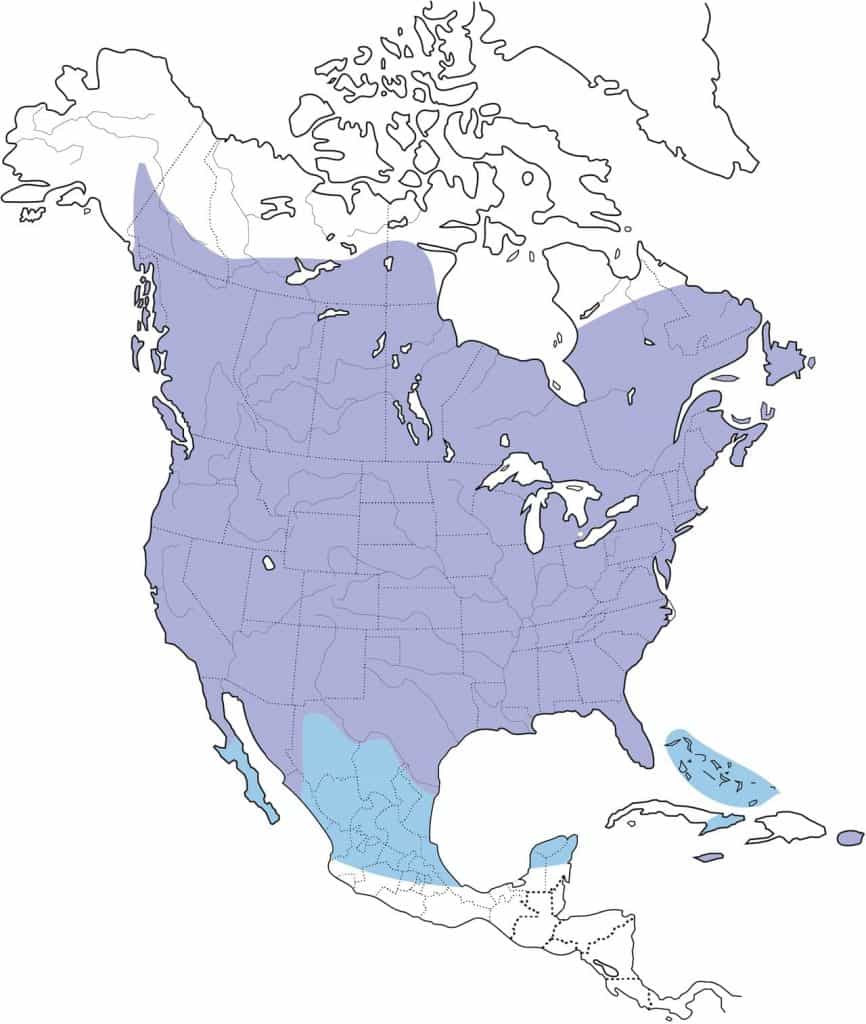
Evening Grosbeak
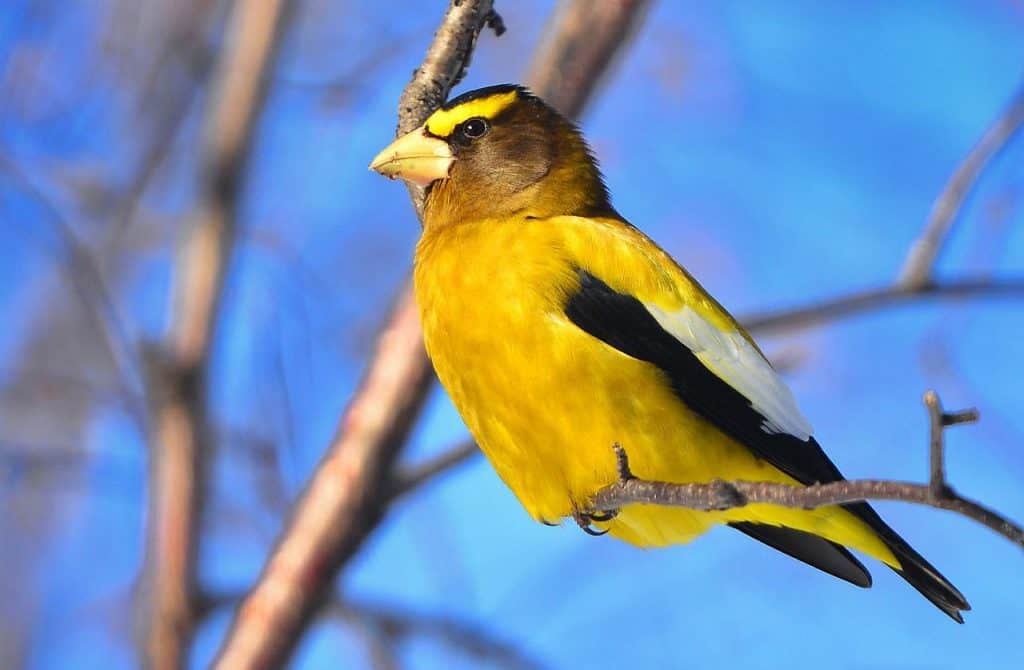

| Appearance | The evening grosbeak is a medium-sized bird about 8″ long. They have an olive-yellow head with a yellow streek above each eye extending across and above the bill. The wings and tail are black and white. The belly and rump are bright yellows. their beak is large, stocky, and yellow-blue/green. The female has softer colors than the male and has a gray head and throat instead. |
| Diet | Seeds, insects, fruit. |
| Feeder Food | Black-oil sunflower seeds and hulled sunflower seeds |
| Habitat | Forested areas |
| Nesting | Cup-shaped nest. They have 1 brood/season with 3-4 blue eggs with brown spots in each brood. Incubation is 12-14 days. |
Range Map
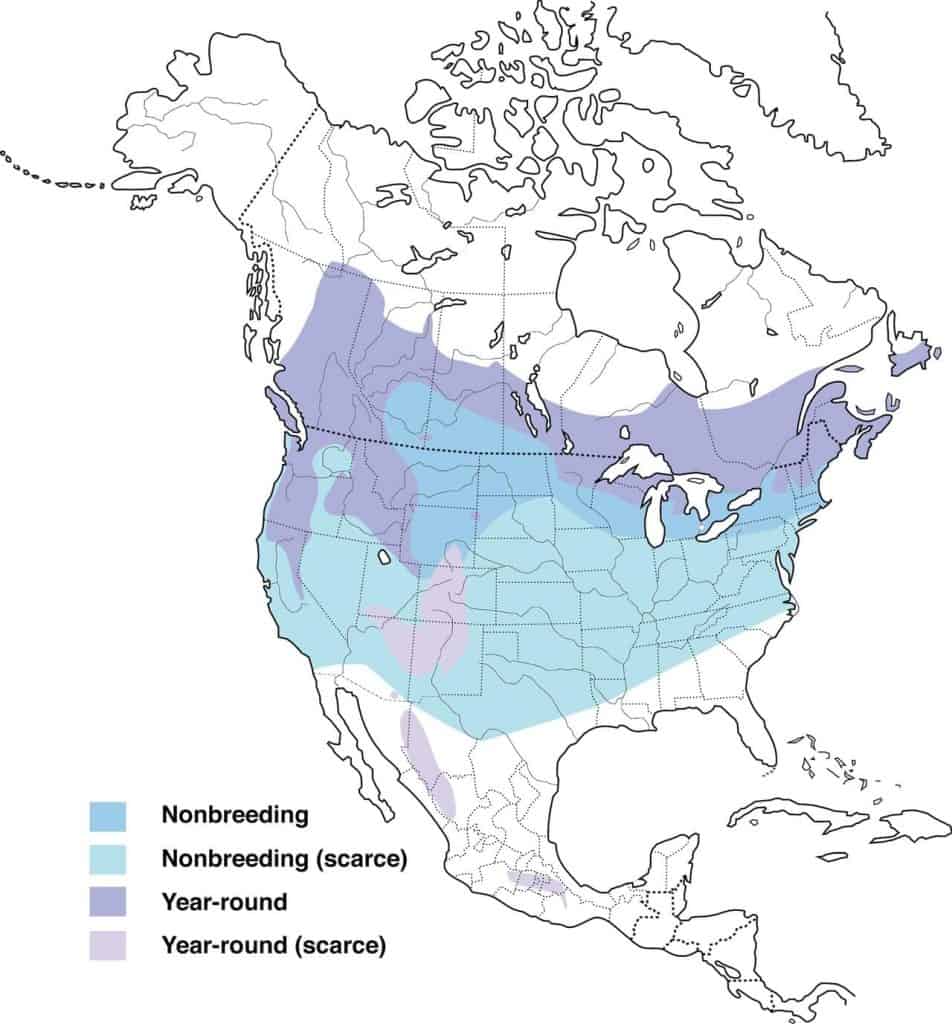
Field Sparrow
| Appearance | Small bird about 5 1/4″ long with muted coloring throughout. Gray face with a bright white eye ring, a rusty patch behind the eye, and a rusty crown. Underparts are gray with tan on the breast and sides. The short but stout bill is pink. The Female is similar but does not have a patch behind the eye, the crown is more muted, and the belly has light brown streaks. |
| Diet | Insects and small seeds. |
| Feeder Food | Hulled sunflower seeds, millet, and cracked corn when scattered under the feeder. |
| Habitat | Brushy woodlands with clearings and fields of tall grasses. |
| Nesting | Cup-shaped nest low in a shrub or on the ground. 3-5 eggs incubated for about 10-12 days. |
Range Map
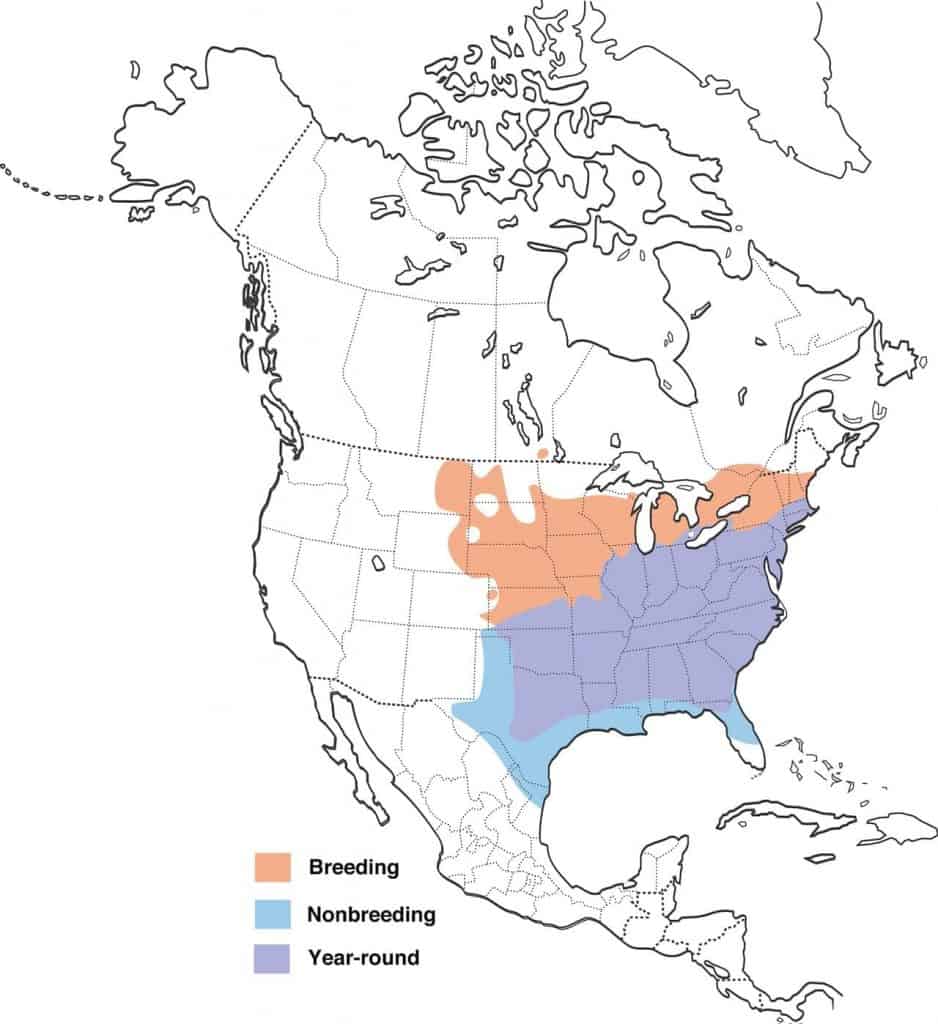
Fox Sparrow
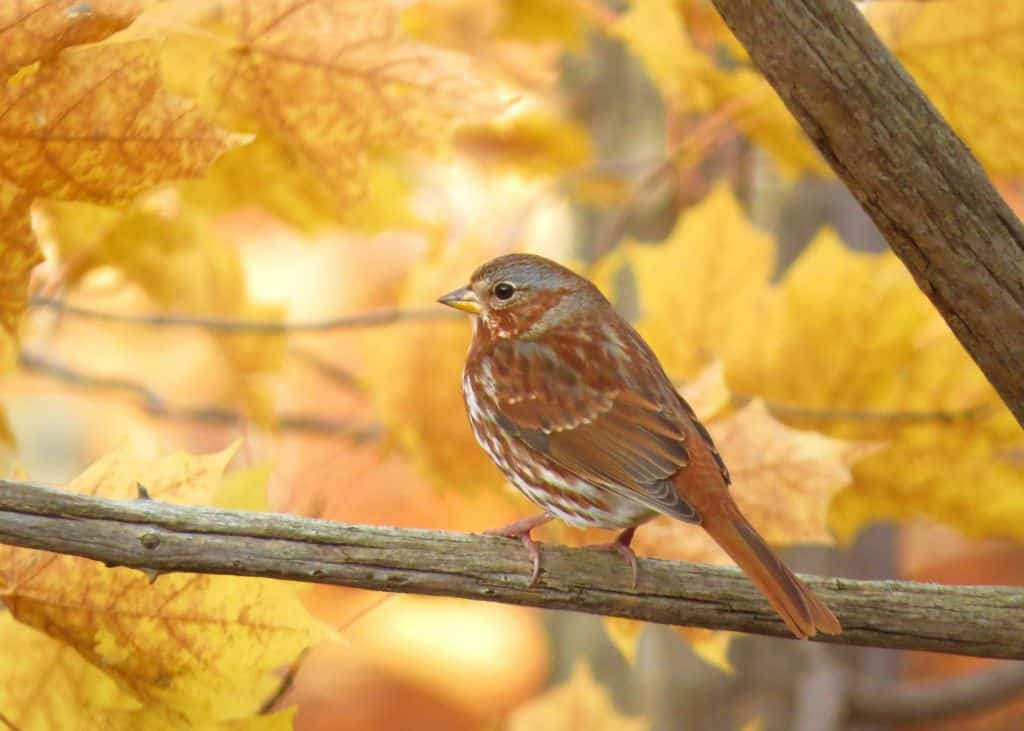
| Appearance | The fox sparrow is a medium-sized bird about 7 1/2″ long with rusty-red color. It has a heavy streaking of rust color on its breast and tail. The head and back are shades of gray. The female looks like the male. |
| Diet | Insects and seeds. |
| Feeder Food | Black-oil sunflower seed, hulled sunflower seed, nyjer, cracked corn, millet, and milo. |
| Habitat | Scrubby areas with thick vegetation. |
| Nesting | A cup-shaped nest. They have 2 broods/season with 2-4 pale green eggs with reddish spots, per brood. Incubation is for 12-14 days. |
Range Map

Golden-Crowned Kinglet
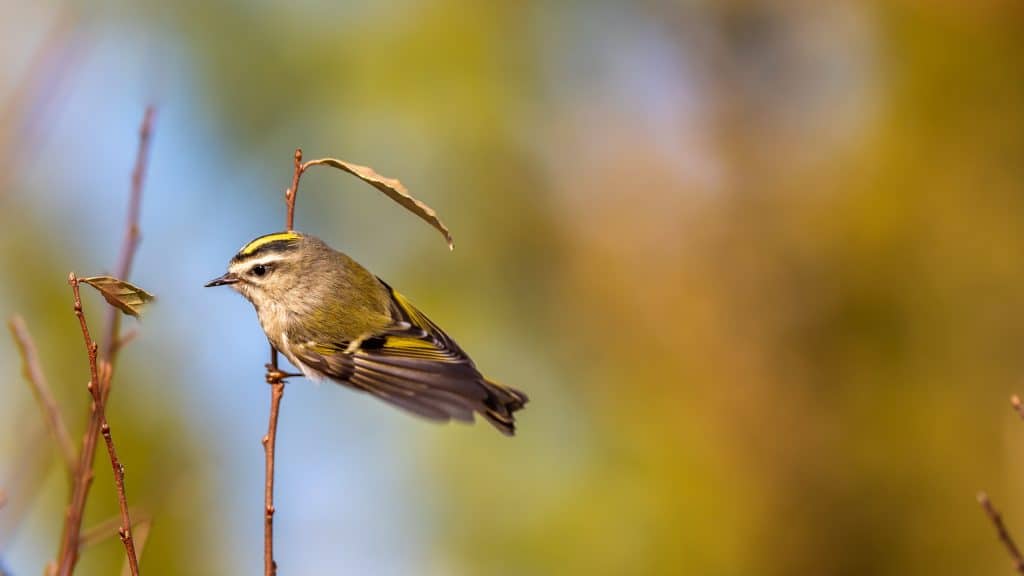
Appearance: Golden-crowned kinglets are small birds about 4″ long, olive-green in color with crowns striped with reddish/orange and white stripes above & below the eyes. Females are the same except for their crowns are yellow instead
Diet: Insects and spiders.
Feeder food: Suet.
Habitat: In their year-round area, they generally inhabit mountainous regions with abundant coniferous trees. They nest in mixed forested areas and within small groups of trees with minimal or no undergrowth.
Nesting: The golden-crowned kinglet builds a 3″x3″ cup-shaped, deep nest and places it at the intersection of several branches. They have 1-2 broods/season and 7-8 eggs/brood that are white/cream colored with specks of brown or lavender. Incubation lasts 15 days.
Migration: Golden-crowned kinglets are migrators. While many remain in their year-round range every season of the year, others migrate. The migrators head north into Canada, northern Minnesota, Michigan & Wisconsin for breeding in springtime then head south to the rest of the US for winter months.
Year-round range: Pacific coast of Alaska, British Columbia, Washington, Oregon, California, Idaho, eastern Oregon, western Montana, Utah, Colorado, Arizona, New Mexico, New England, and Mexico.
Breeding range: Canada (except Nunavut), southeast Alaska, northern Minnesota, Michigan & Wisconsin.
Winter range: All US states, southern Alberta, Saskatchewan, Manitoba, and the northern part of Mexico.
Range Map
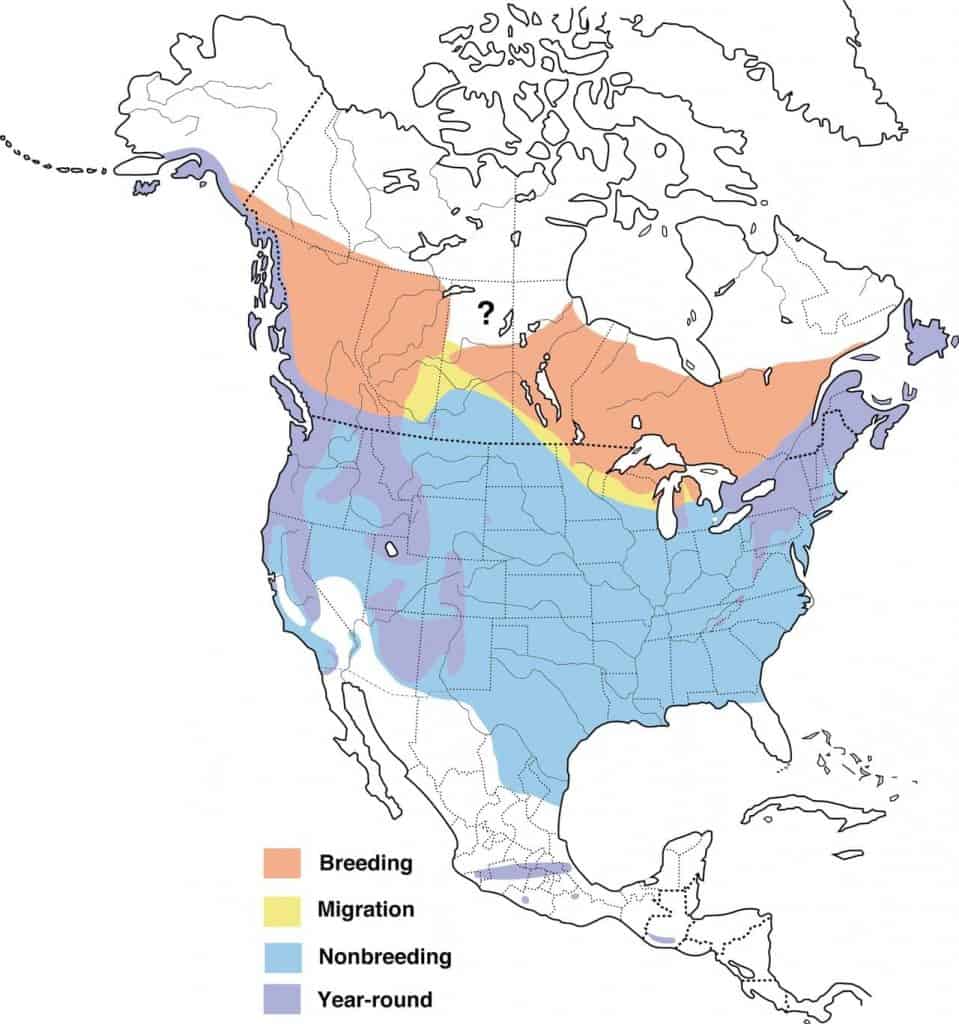
Golden-Winged Warbler
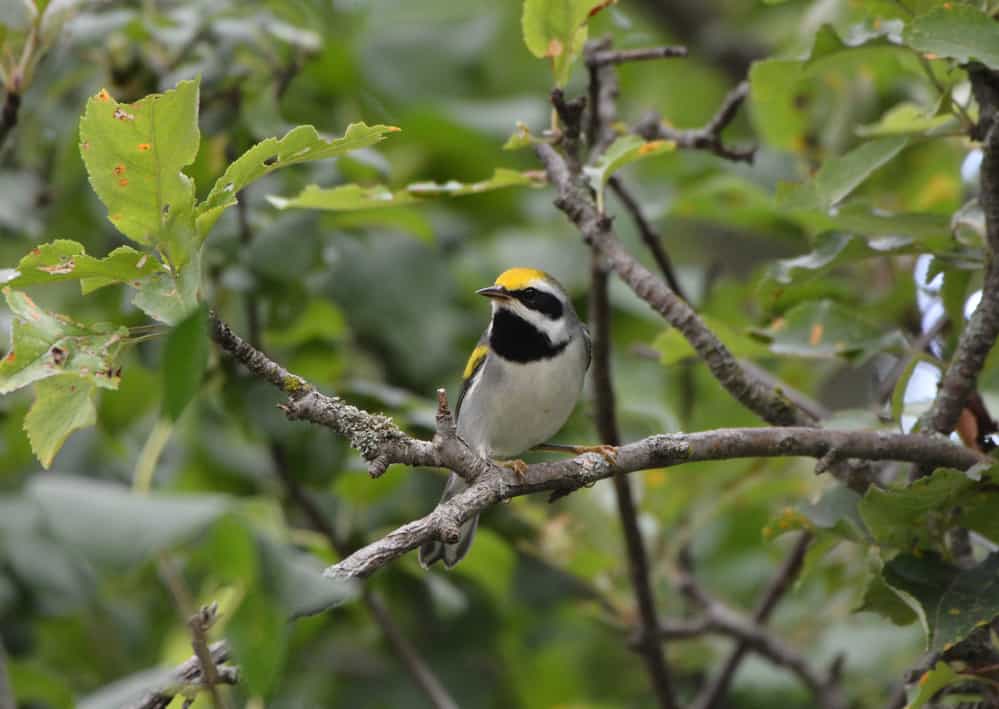
| Appearance | A small bird about 5″ long with a short tail and thin & pointy bill. They are silvery gray with a black mask and throat. A bright yellow crown and stripe of yellow on the upper wings. The female is similar with a green-yellow crown and dark gray throat & mask instead |
| Diet | Insects |
| Feeder Food | Unlikely to visit a feeder. |
| Habitat | During breeding, they can be found in shrubby open areas. Otherwise, the forest is their primary habitat. |
| Nesting | The nesting site is on the ground. They have 1 brood/year, 3-6 eggs/brood, eggs are ivory or pale pink with tiny spots. Incubation is from 10-12 days. |
Range Map
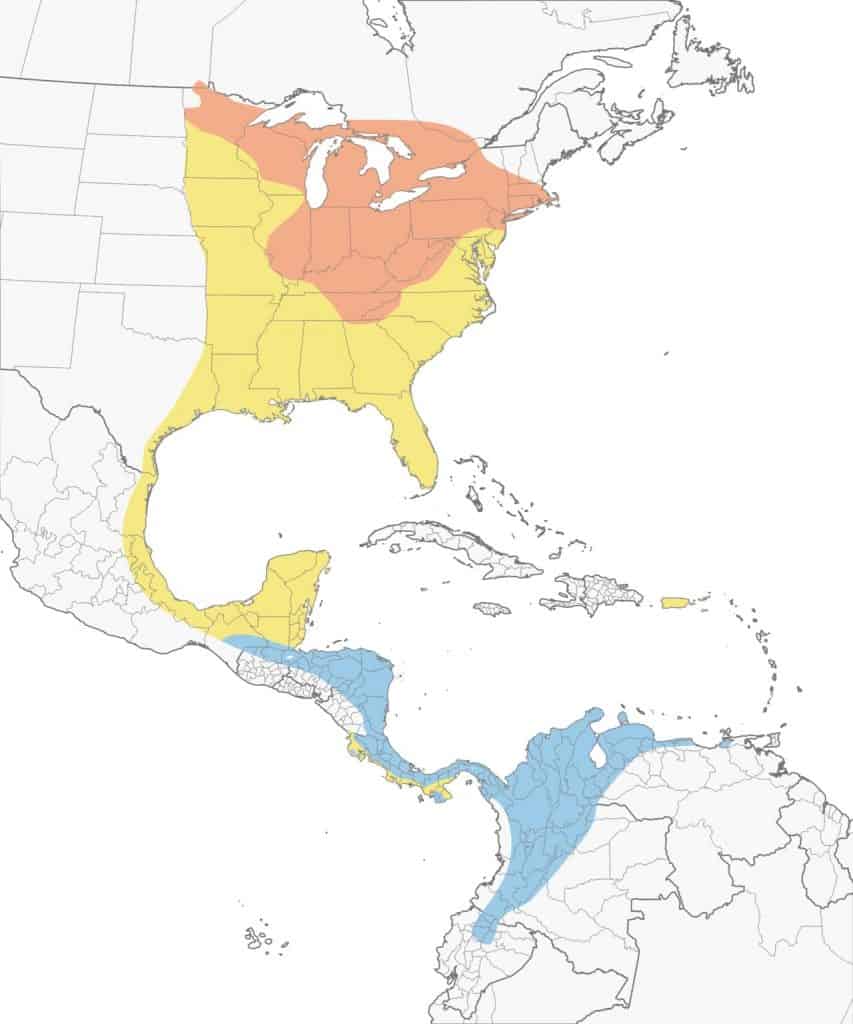
Gray Catbird
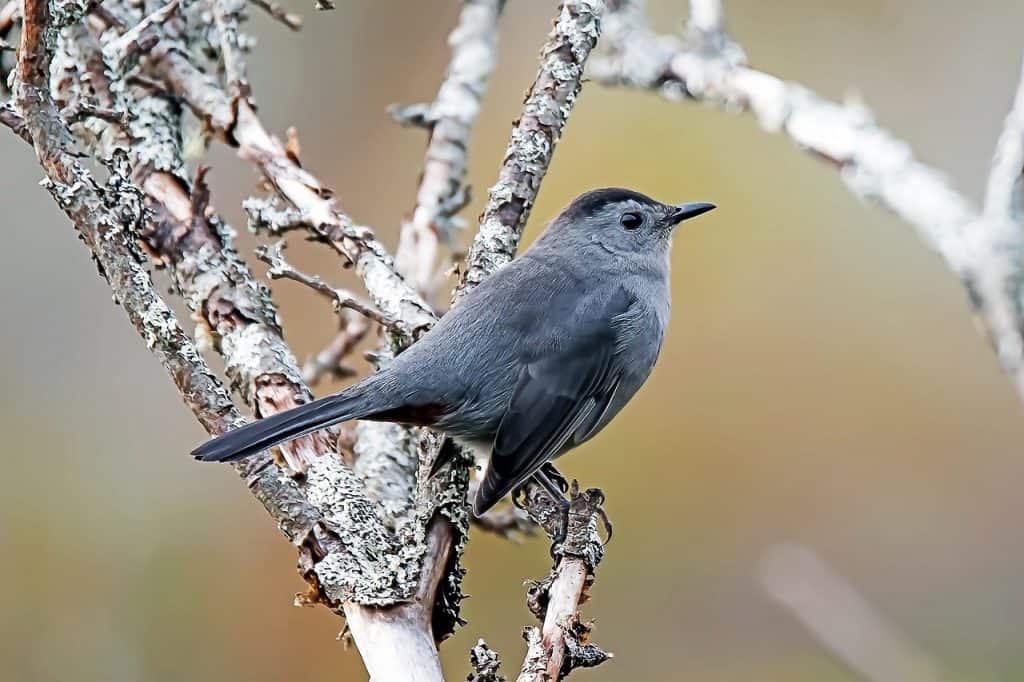
| Appearance | Medium-sized bird about 9″ long. Slate gray with a black crown and dark eyes. Bill is long, thin, and black. Usually concealed, a chestnut patch is under the tail. The female is the same. |
| Diet | Insects and fruit. |
| Feeder Food | Unlikely to visit a feeder. |
| Habitat | Open woodlands. |
| Nesting | Nest: The nest is cup-sized. Broods: 2 broods/year, Clutch: 4-6 eggs/brood Egg color: Bright, turquoise-green sometimes with fine, red spots or no markings. Egg size: 1 inch by 0.5 inches Incubation:12-13 days |
Range Map
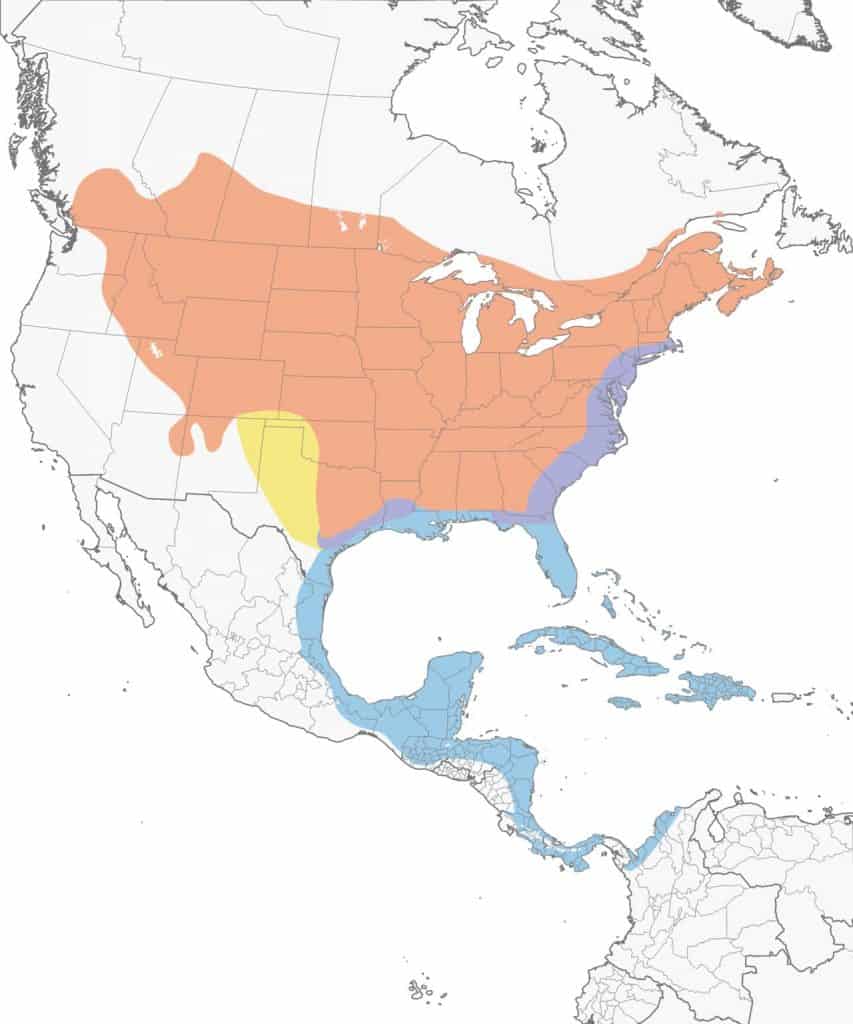
Great Black-Backed Gull
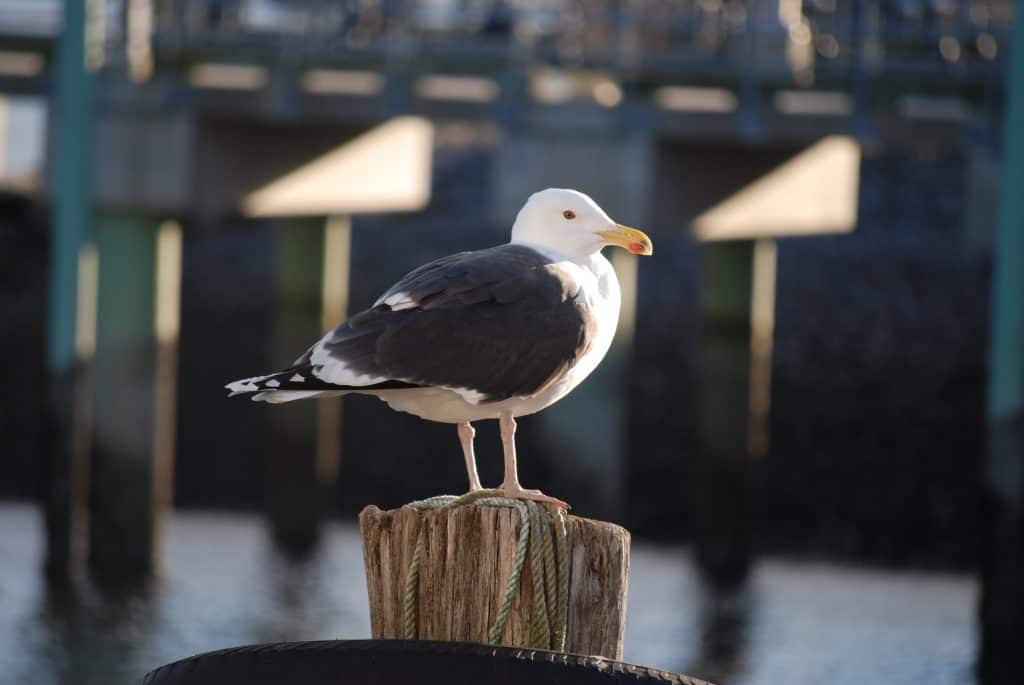
Appearance: The Great black-backed gull is the largest gull in the world at about 28-32″ long. They’re white with black upper wings and backs. The bill is yellow with a small red spot at the tip. Eyes are dark, legs pink, and white under the wings. The female looks the same.
Diet: They eat water prey such as fish, crabs, mussels, marine invertebrates, and other birds. They’re also scavengers so have no problem dining on dead fish, carrion, and human garbage.
Feeder food: They don’t visit feeders.
Habitat: Great black-backed gulls live along the Atlantic coast from Canada to Florida as well as inland surrounding the Great Lake.
Nesting: They have 1 brood/season and 2-3 light yellow/green eggs – often with spots. Incubation lasts 30-32 days and nestlings are ready to fledge after 1 day.
Range Map
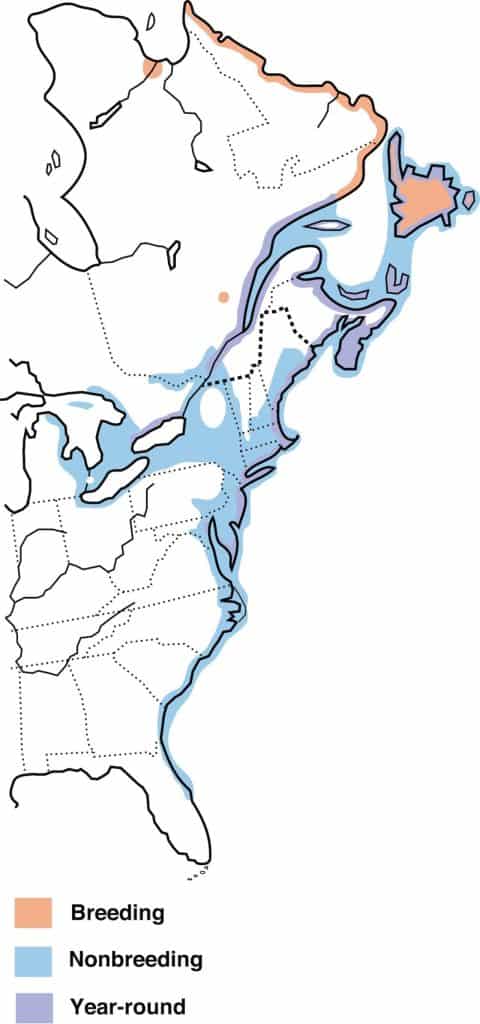
Great Blue Heron
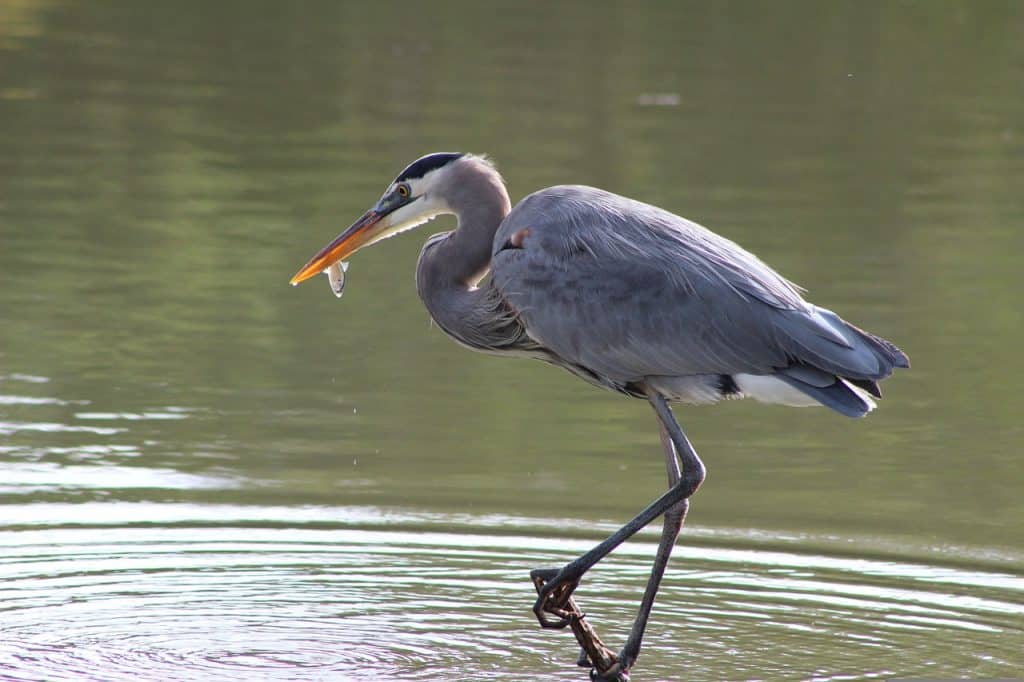
| Appearance | Great blue herons are enormous waterbirds about 45-55″ long. They have a large body with blue/gray feathers, long legs, a white face with a black streak on the cheek and crown, a long pointy orange bill, and a curvy neck which they often curl into the shape of an “S”. |
| Diet | Fish, frogs, salamanders, turtles, snakes, insects, small mammals, and birds. |
| Feeder Food | They don’t visit feeders. |
| Habitat | The Great Blue Heron is a highly adaptable bird evidenced in its wide year-round range that spans much of the US and British Columbia coast. They prefer calm freshwaters, rivers, and shallow coastal areas. |
| Nesting | Nest: A large, round platform-style nest is weaved by the female from sticks collected by the male and lined with pine needles, moss, grass, and other soft materials and placed on the ground. Brood: 1 – 2 broods/year Clutch: 2 – 6 eggs/brood Egg color: They lay large eggs ranging from pale blue to white. The lighter the color, the older the egg is. If you see near white eggs, they are close to hatching. Egg size: 2.4 – 3 inches by 2 inches Incubation: Both parents incubate the eggs for about 25-30 days. |
Range Map
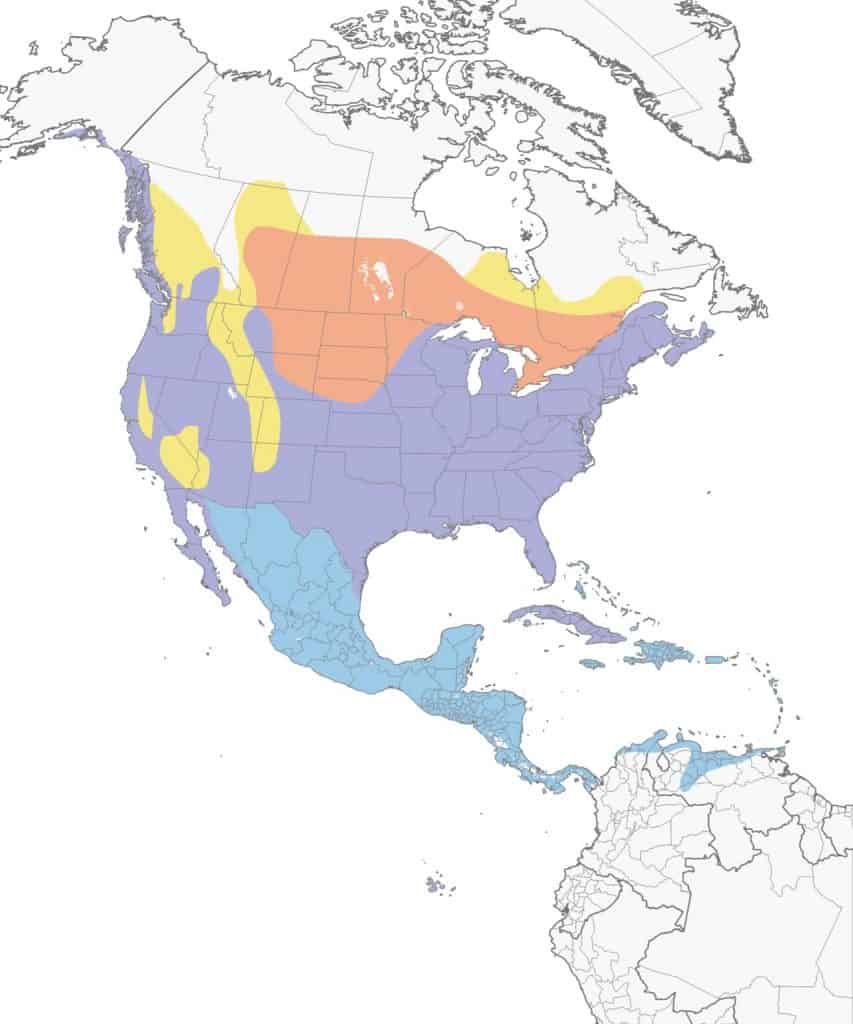
Great Crested Flycatcher
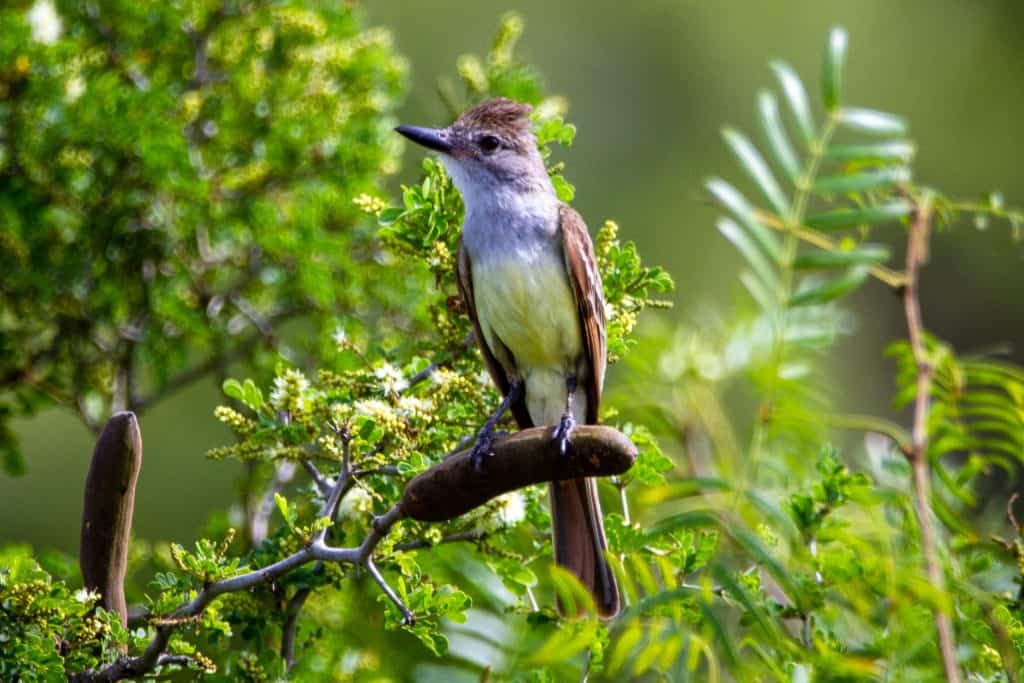
| Appearance | A medium-sized bird about 8 1/2″ long with dark olive-brown underparts, gray throat & breast, and lemon yellow belly. It has a small crest and long pointy bill. |
| Diet | Insects and small wild fruits. |
| Feeder Food | They do not visit feeders. |
| Habitat | Open deciduous forested areas. |
| Nesting | They build a bulky nest inside an old woodpecker hole or natural cavity. They have 4-8 eggs/brood that are ivory to light pink with brownish-purple spots. Incubation is 13-15 days. |
Range Map
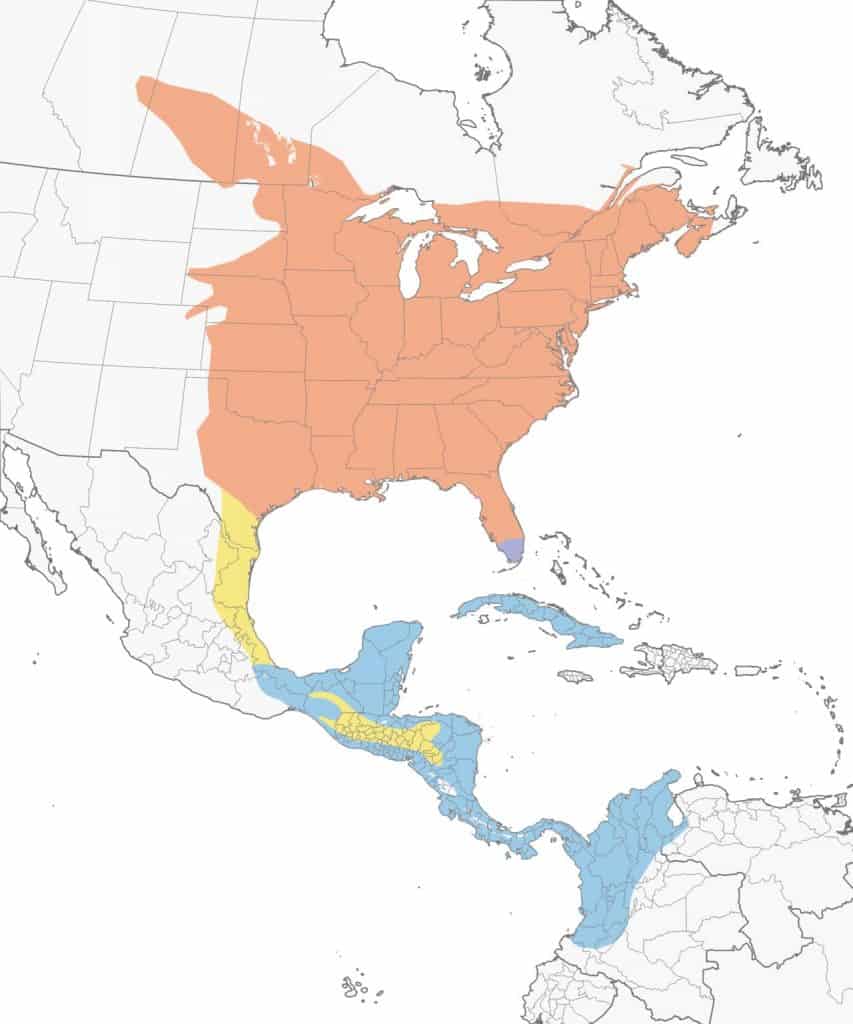
Great Gray Owl
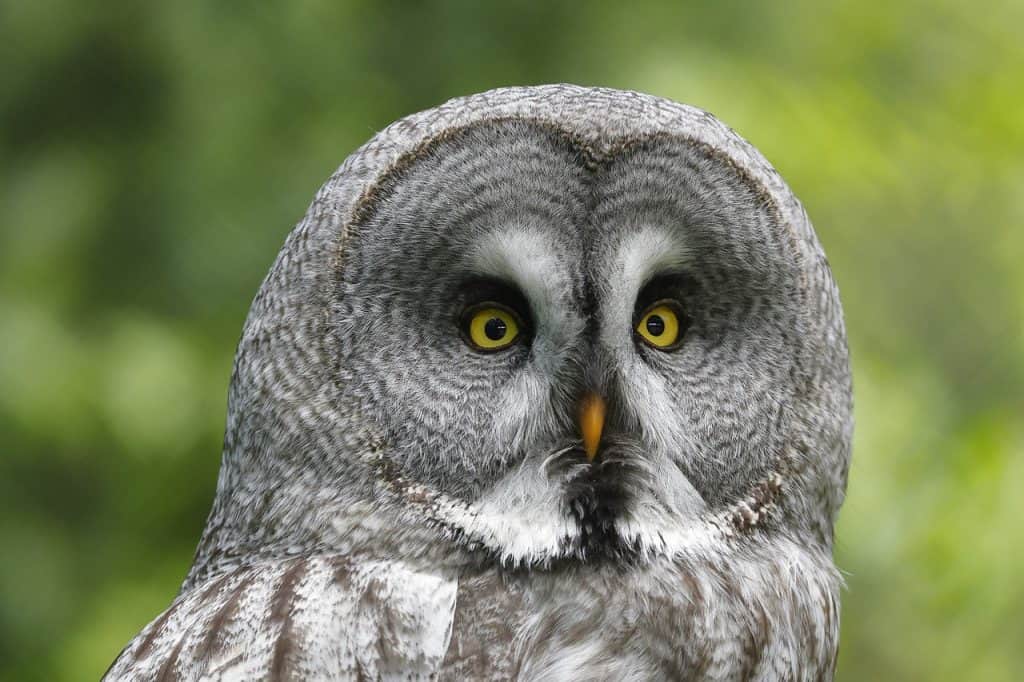
Appearance: Great gray owls are large birds about 24-33″ in length. They’re brown, silver, and white streaked, have very large heads, and have a large relatively flat face. Their eyes are close together and bright yellow and their beak is orange. Females are the same except bigger.
Diet: Small mammals.
Feeder food: Great gray owls are not feeder birds.
Habitat: The great gray owl prefers dense and moist evergreen forests in the far north.
Nesting: Great gray owls use existing nests built by other large birds or squirrels, or they lay their eggs on the top of dead trees or other plant material. They have 1 brood/season, 2-5 white eggs/brood, incubate for 28-36 days and fledglings leave the nest after 26-29 days.
Migration: Great gray owls are not migrators. That said, during the winter a population of them may expand a short distance outside their year-round range into Wyoming northern Minnesota, Wisconsin, Michigan, New York, and New England.
Year-round range: Alaska, northeast Washington, northern Idaho, western Montana, central Oregon, eastern California, and Canada’s provinces (except Nunavut).
Winter range: The year-round range plus into Wyoming northern Minnesota, Wisconsin, Michigan, New York, and New England.
Range Map
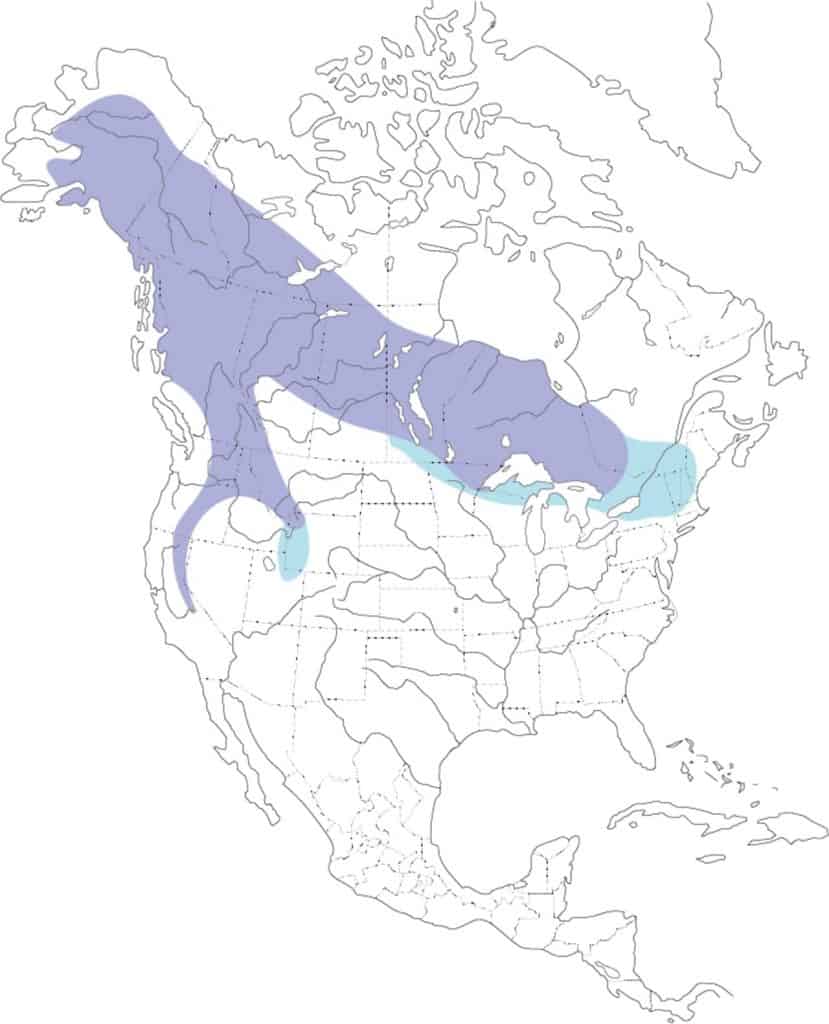
Great Horned Owl
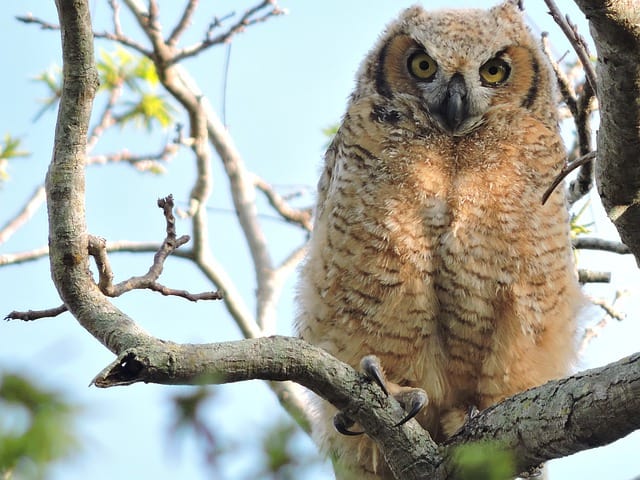
| Appearance | The Great horned owl is a large bird about 22″ long. They have a large barrel-shaped body with tufts of feathers that stick up and appear as though they’re ear (but they’re not). They’re mostly brown with dark bars and specks throughout and a subtle white stripe across the throat. Large yellow eyes with a short bill. |
| Diet | Mammals, large birds, snakes, and large insects. |
| Feeder Food | They don’t visit feeders. |
| Habitat | Woodlands with open areas but will live just about anywhere. |
| Nesting | They use the nest of another large bird typically located in a tree or will nest in a tree cavity. They have 1 brood/year and 1-4 eggs/brood. Eggs are white and round with a rough surface. Incubation lasts 30-387 days and fledglings leave the nest about 30-45 days after hatching. |
Range Map
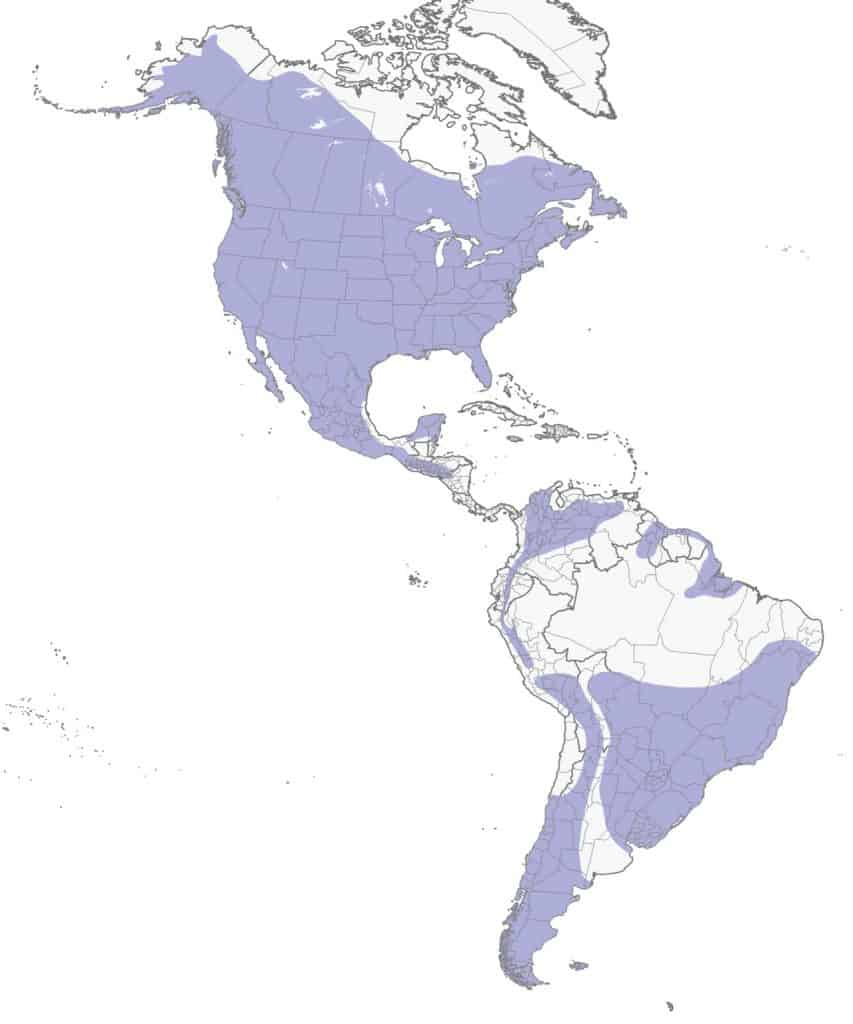
Greater White-Fronted Goose
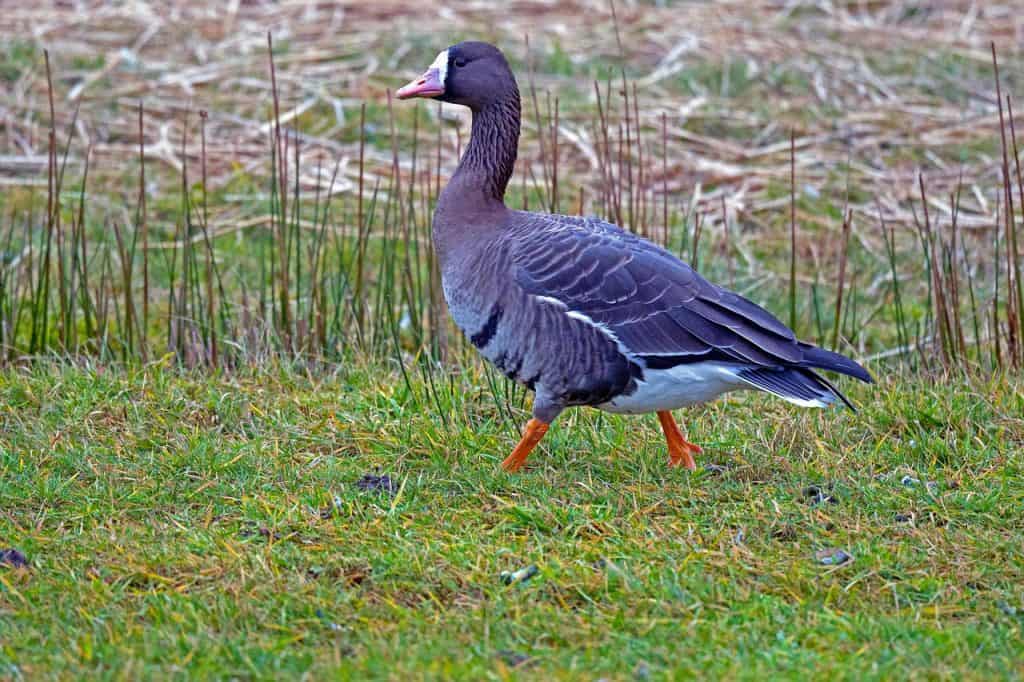
| Appearance | Large mostly brown waterbird about 25-32″ long. They have a heavy, stocky body with an orange bill and legs, white between the bill and head, and buffy underparts. |
| Diet | Diet includes plants such as grasses, berries, seeds, and grain. |
| Feeder Food | N/A |
| Habitat | Near wetlands, rivers, and ponds. |
| Nesting | The greater white-faced goose is a ground nester. The female constructs the nest on the shore of a lake or wetland area. She scrapes the ground and incorporates grass and sedge to form a large bowl-shaped nest. Broods: 1/season Clutch: 1-8 eggs/brood Egg color: white – tan Egg size: About 3.2″ x 2.1″ Incubation: Incubation lasts about 22-27 days and fledglings leave the nest after a short 2 days. |
| Migration | Greater white-fronted geese are migrators. In spring they migrate north into the northernmost part of Canada and Alaska to breed and raise young. Then in the fall, they head south and west for the winter. Breeding range: Alaska, and Canada’s northern Yukon, Northwest Territories, and Nunavut. Winter range: Along the pacific northwest from Washington to Mexico, southeastern Texas, Louisiana, and southeastern Arkansas. |
Range Map
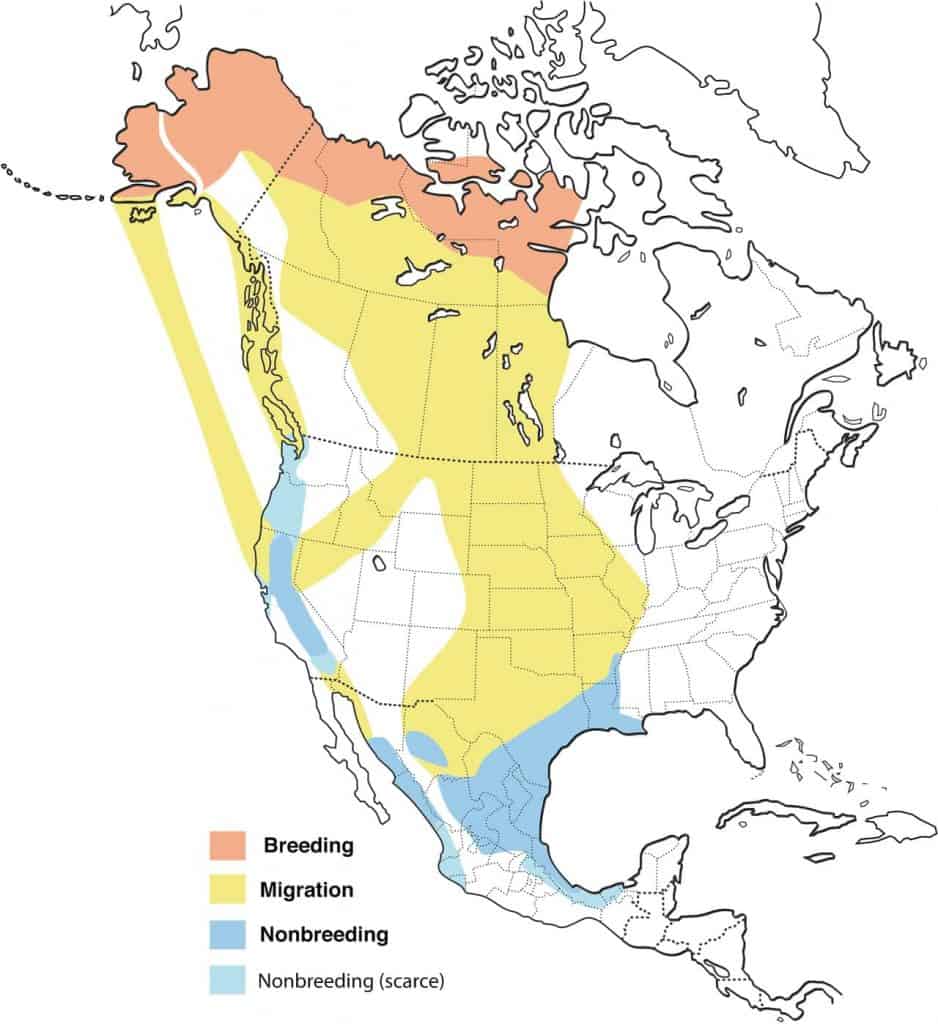
Green Heron
| Appearance | Large bird about 16-22″ long. They have a blue-green back, rusty red neck, and chest. The crest is dark green. Legs are normally yellow but turn bright orange during the breeding season. Female appearance is the same as the male. |
| Diet | Fish, insects, aquatic plants. |
| Feeder Food | They do not visit feeders. |
| Habitat | Wetlands include swamps, marshes, lakes, rivers, ponds, along the coast, etc. |
| Nesting | They build a platform-style nest and have 2 broods/year. 2-4 eggs/brood that are light green with no markings. Incubation is 21-25 days. |
Range Map
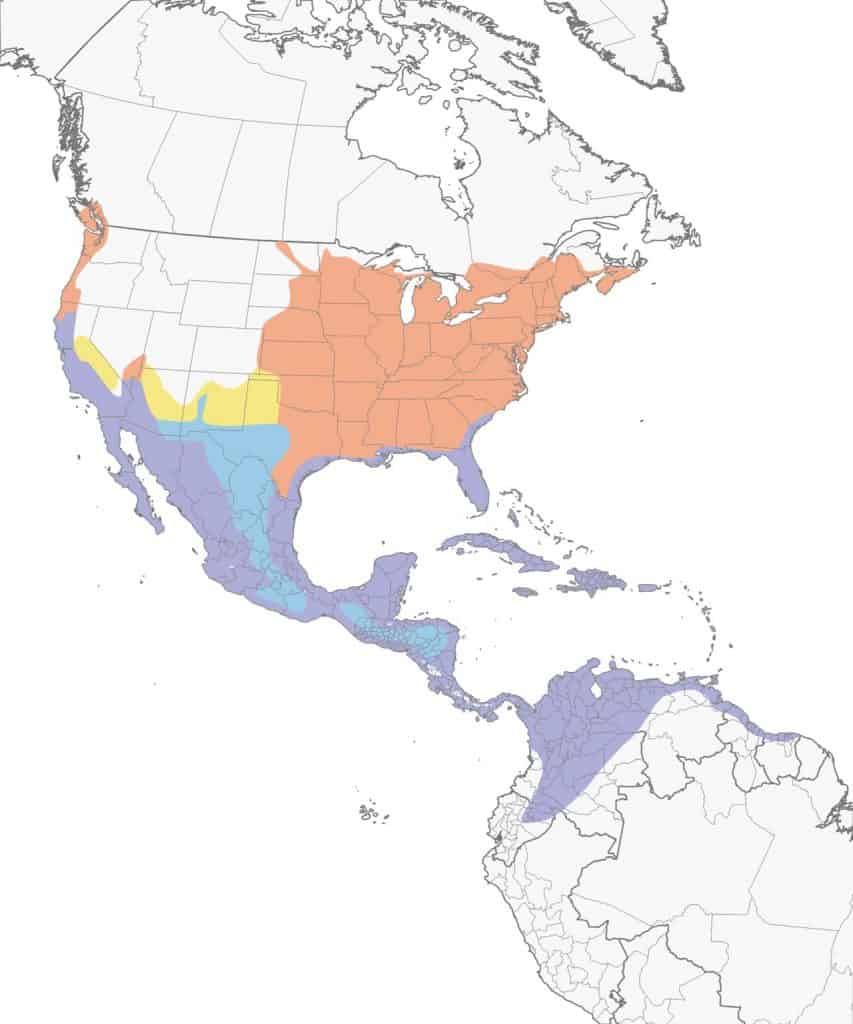
Gyrfalcon
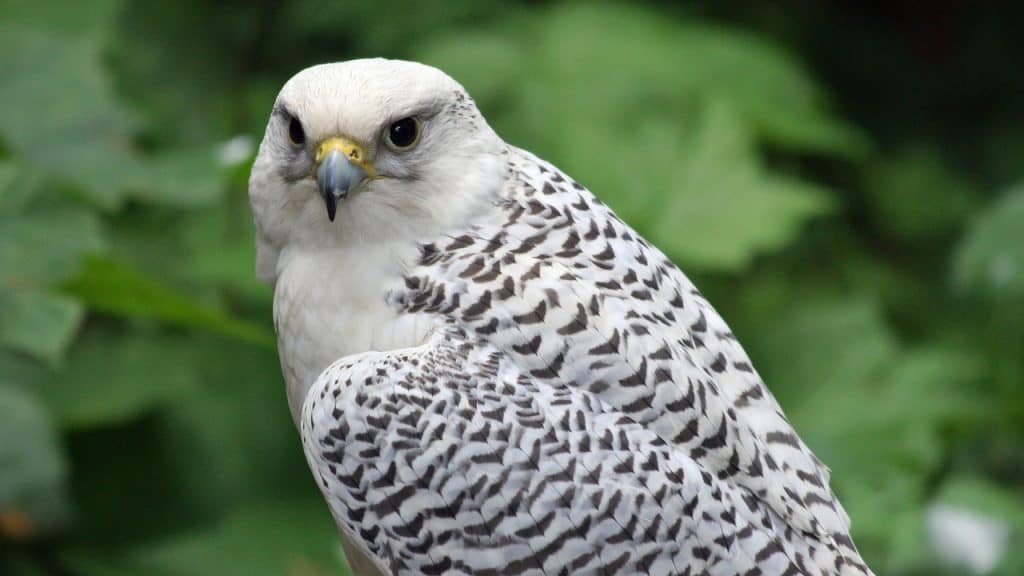
Appearance: Gyrfalcons are enormous birds about 19-26″ long. The more regal variety of this bird is white with black spots. However, they do come in other shades including white, gray, and dark brown. The wings, back, and tails are barred with either gray or dark brown. The wings and tail are long. The females are the same but much larger.
Diet: Birds and small mammals (e.g. rabbits, squirrels).
Feeder food: Not feeder birds.
Habitat: Gyrfalcons prefer the northern tundra both inland and along the coasts where seabirds and waterfowl are on the menu. Occasionally they can be found along the edges of forested areas. In lower elevations, they are found in open areas.
Nesting: Gyrfalcons build a rudimentary nest very high in a tree or along a cliff edge. They have 1 brood per season, 1-5 white or reddish-brown eggs/brood, incubation is 34-36 days and fledglings leave the nest after about 50 days.
Migration: Gyrfalcons are migrators. Although they maintain a year-round range in Alaska and northern Canada, many migrate even further north into Canada’s islands and Greenland for breeding. Then in the fall, they return to the year-round range for winter or migrate further south into Canada and northern US states.
Year-round range: Alaska, Yukon, northern Northwest Territories, northern Nunavut, and northern Quebec.
Breeding range: northern Canadian islands and Greenland.
Winter range: Alaska, Washington, Idaho, Montana, Wyoming, North & South Dakota, Minnesota, Wisconsin, Michigan, New York, Vermont, New Hampshire, Maine, and all Canadian provinces.
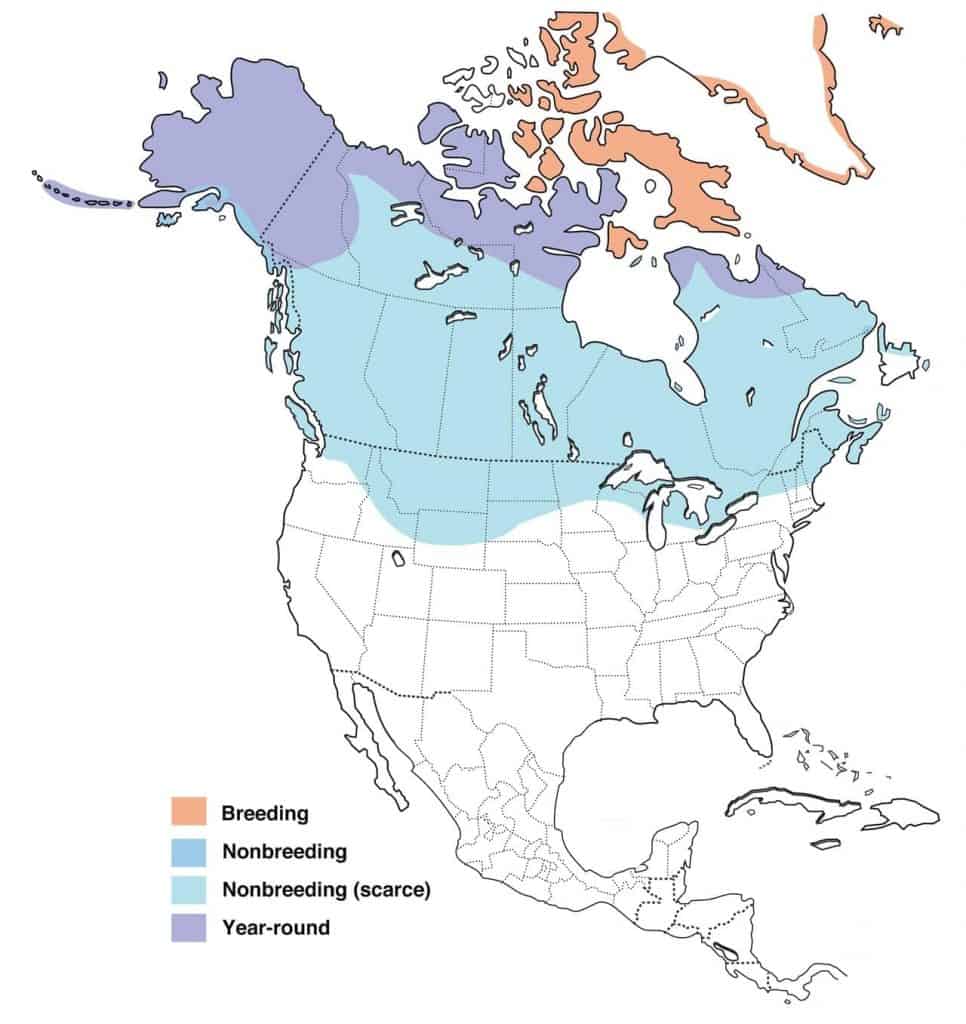
Hairy Woodpecker
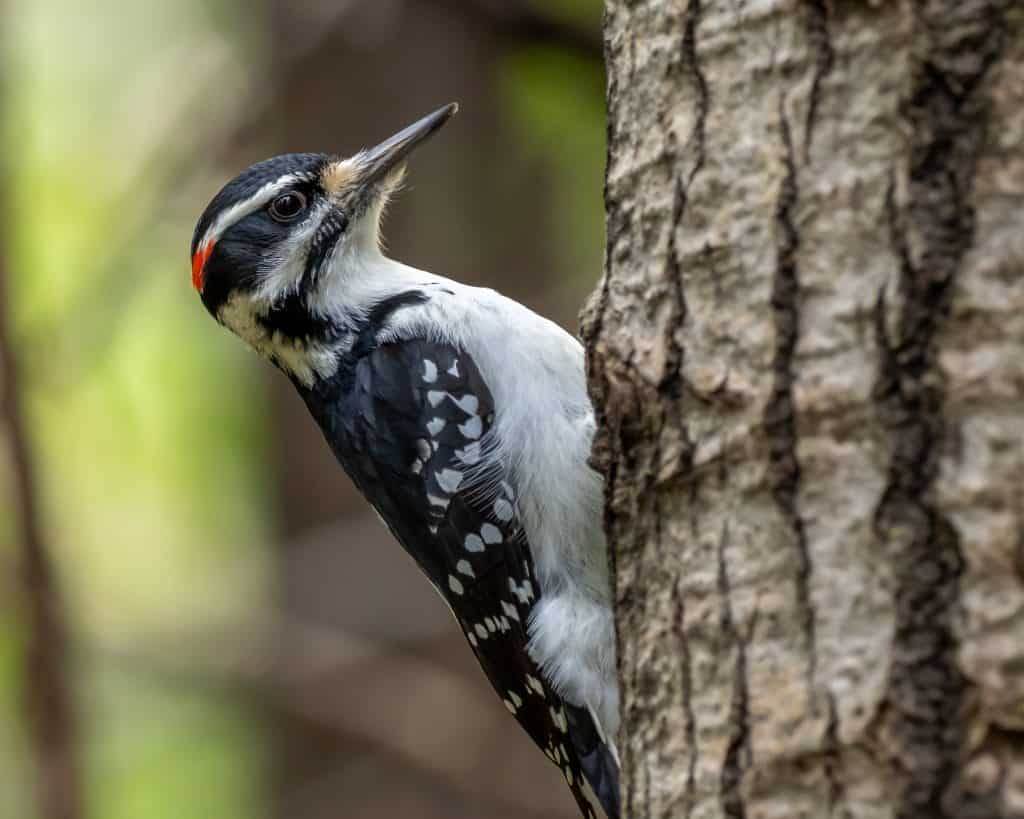
Appearance: A medium-sized black-and-white bird about 9″ long with a white belly, and black wings with white spots. A white stripe runs down the back. They have a red mark on the back of the head and a long black bill. The Female is the same except with no red mar
Diet: Insects, seeds, nuts.
Feeder food: Suet, hulled peanuts.
Habitat: Mature forested areas, urban and suburban areas where dense trees are found.
Nesting: They are cavity nesters generally excavating their own holes. They have 1 brood/year, and 3-6 white eggs per brood. Incubation is 11-15 days.
Migration: Hairy woodpeckers are not migrators. They remain in their year-round range all seasons of the year.
Year-round range: All US states, every Canadian province except Nunavut, Mexico, and Central America.
Range Map
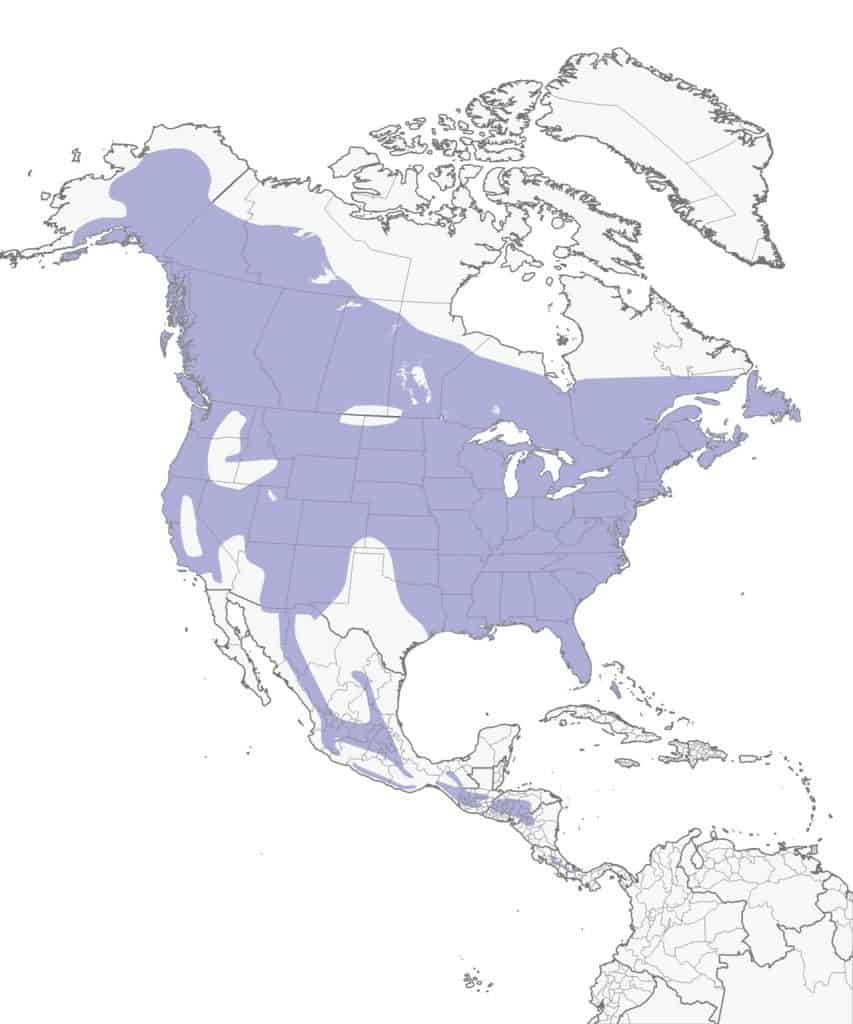
Harris’s Sparrow
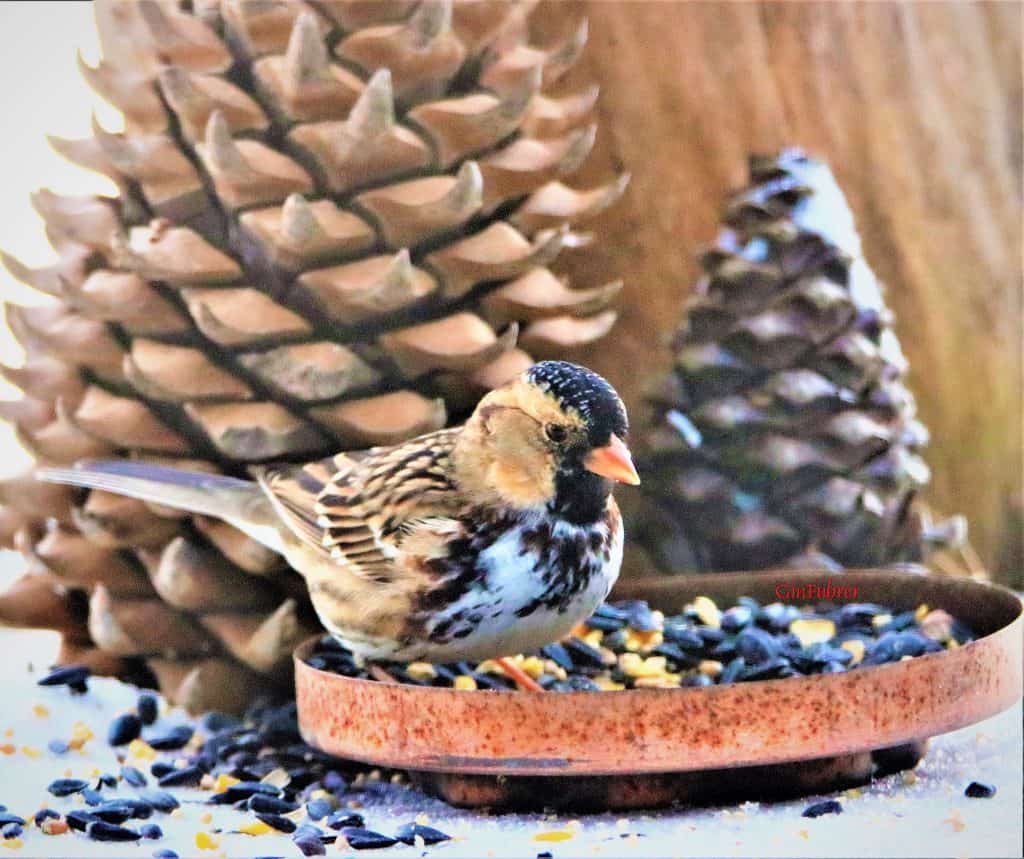
Appearance: The Harris’s sparrow is a medium-sized bird about 7 1/2″ long. It has black and charcoal in its head all the way to the back of its neck. The neck and belly are white with brown spots, brown wings, and a pink bill and legs. The female is the same.
Diet: Seeds, insects, berries.
Feeder food: Black-oil sunflower seeds, hulled sunflower seeds, cracked corn, and millet.
Habitat: Shrubby areas dense with vegetation.
Nesting: The cup-shaped nest is located on the ground. They have 1 brood/season with 4-5 white eggs with brown spots in each brood. Incubation is 13-14 days.
Migration: Harris’s sparrows are migrators. They migrate north in the spring to breed and raise their young. Then in the fall, they migrate south for the winter.
Breeding range: Canada’s Northwest Territories, Nunavut, northwest parts of Saskatchewan, and Manitoba.
Winter range: Kansas, Nebraska, Oklahoma, and Texas.
Range Map
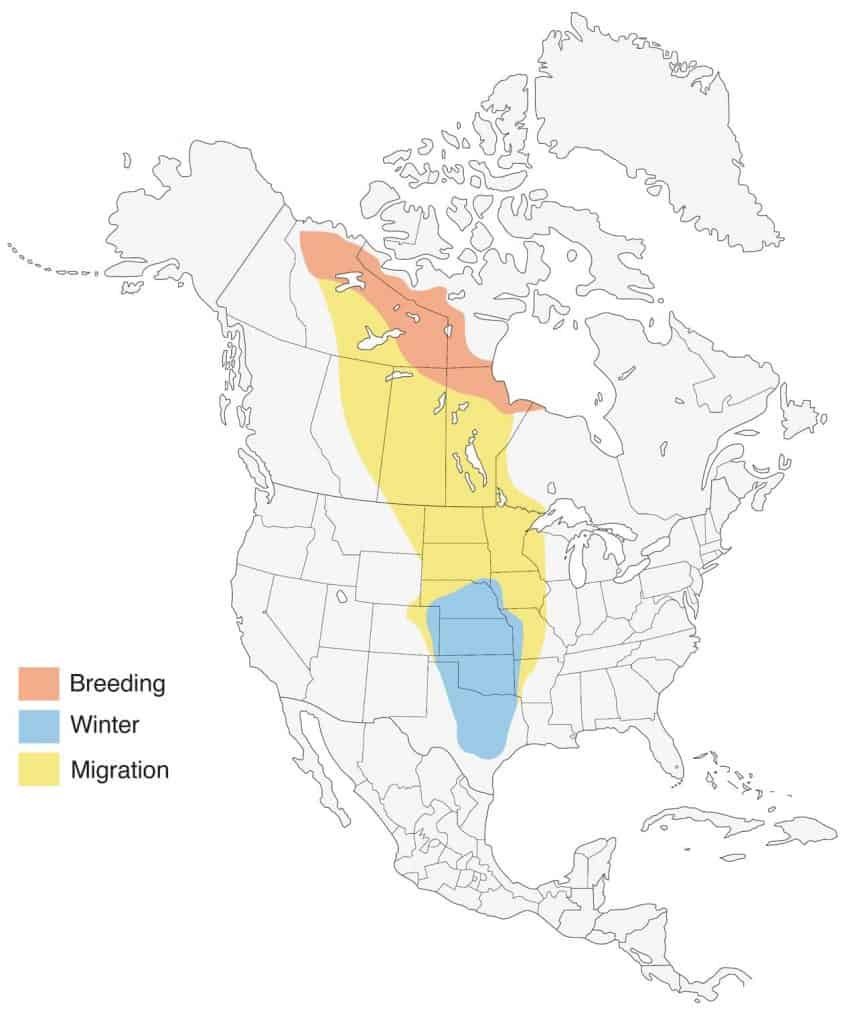
Hermit Thrush
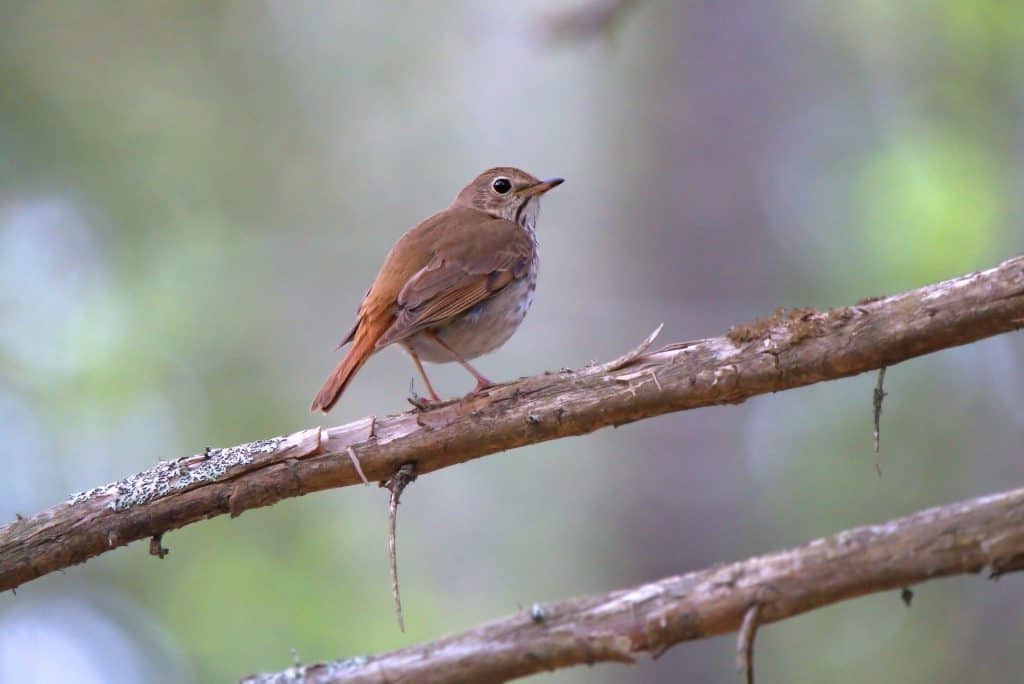
Appearance: The Hermit thrush is about 7″ long. In the east, they’re rich brown with brown flanks (belly area below the wing). In the west, they’re gray/brown with gray flanks. They have a cinnamon-colored tail, dark round eyes with a white eye-ring, and tan breasts with dark spots.
Diet: Insects and fruit.
Feeder food: Unlikely to visit a feeder.
Habitat: Forested areas that are rich with coniferous and hardwood trees.
Nesting: They build a cup-shaped nest made of grass and placed it on the ground. They have 1-2 broods/season, usually, 4 eggs/brood, and the eggs are light blue – sometimes with brown spots. Incubation is for 12-13 days and fledglings leave the nest about 12-13 days after hatching.
Migration: Hermit thrushes are migrators. In spring they head north to the western US states as well as Canada to breed and raise their young. Then in the fall, they migrate south to the southern part of the US, along the pacific coast, and Mexico for the winter. There are a few small patches throughout the US where populations of Hermit thrushes remain year-round.
Year-round range: Northern and central east California, western Nevada, southern Arizona, southern New Mexico, Virginia, and Pennsylvania.
Breeding range: Northern Washington, Idaho, western Montana, Wyoming, eastern California, Nevada, Utah, Colorado, New Mexico, New England, Alaska, and the Canadian provinces (except Nunavut),
Winter range: Pacific coast, southern Arizona, southeastern New Mexico, Texas, Oklahoma and states east of there.
Range Map
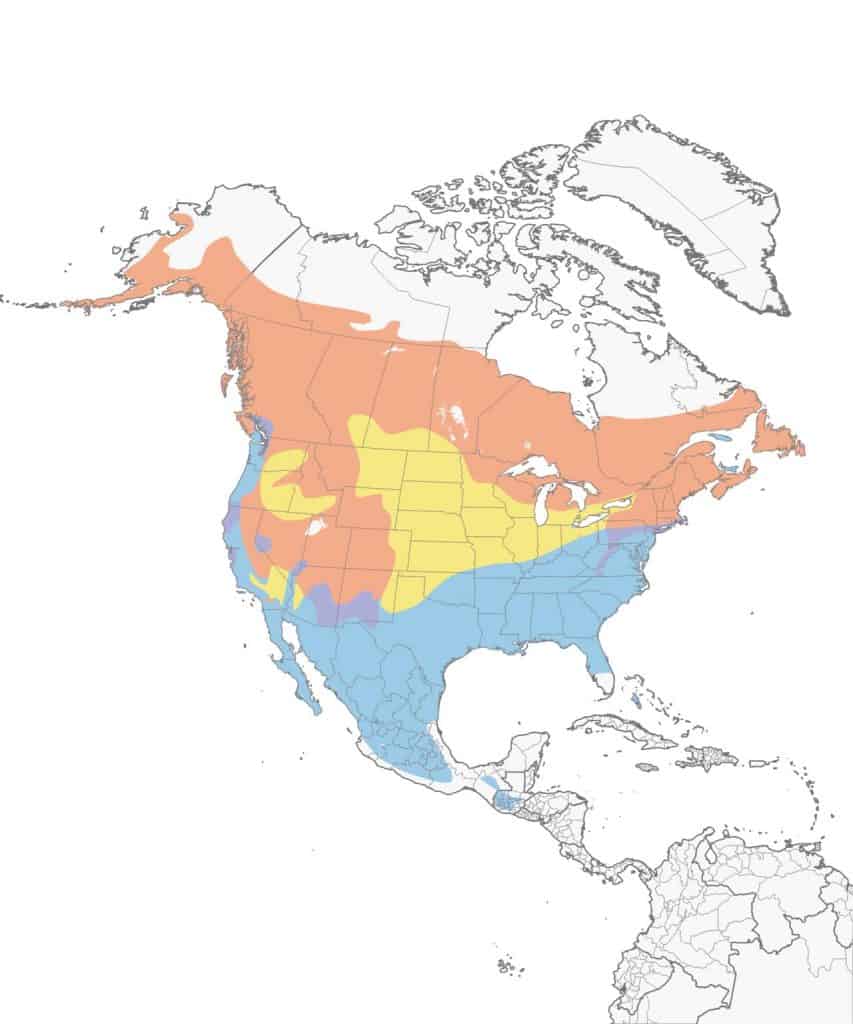
Herring Gull
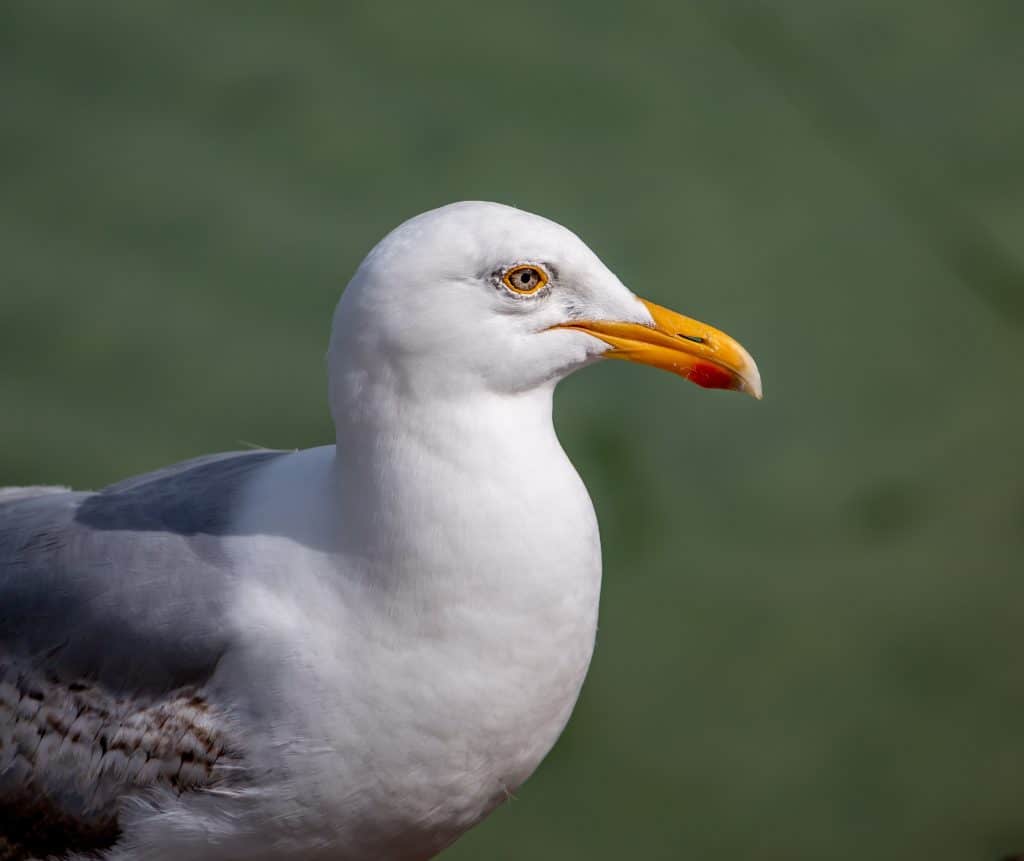
| Appearance | The herring gull is a large bird about 25″ long. They’re pal gray above with a white head and underparts. The head has brown specks except for the summertime when it’s pure white. They have yellow eyes and bills, and pink legs. |
| Diet | fish, marine life (shellfish, sea urchins, crabs…), insects, other bird eggs, and bird nestlings. |
| Feeder Food | They don’t visit feeders. |
| Habitat | Open water areas both coastal and inland. |
| Nesting | Herring gulls nest on the ground. They have 1 brood/season and 3 eggs/brood. The eggs are light green/tan with spots. Incubation is for 27-30 days and fledglings leave the nest after a few days. |
Migration: Herring gulls are migrators. While a population of them remain along the east coast year-round, others migrate north to Canada and Alaska in the spring to breed and raise young. In the fall, they migrate south for winter.
Year-round range: Southern Alaska, northern Wisconsin, Michigan, New York, and the east coast south to South Carolina as well as a narrow string in southern Quebec.
Breeding range: Alaska, northern Vermont, New Hampshire, and Maine, as well as all of Canada.
Winter range: Washington, west coasts of Oregon & California, Colorado, New Mexico, Kansas, Oklahoma, Texas, southwest Wisconsin, Illinois, Iowa, Arkansas, Missouri, Alabama, Mississippi, Georgia, Florida, and Mexico’s coasts.
Range Map
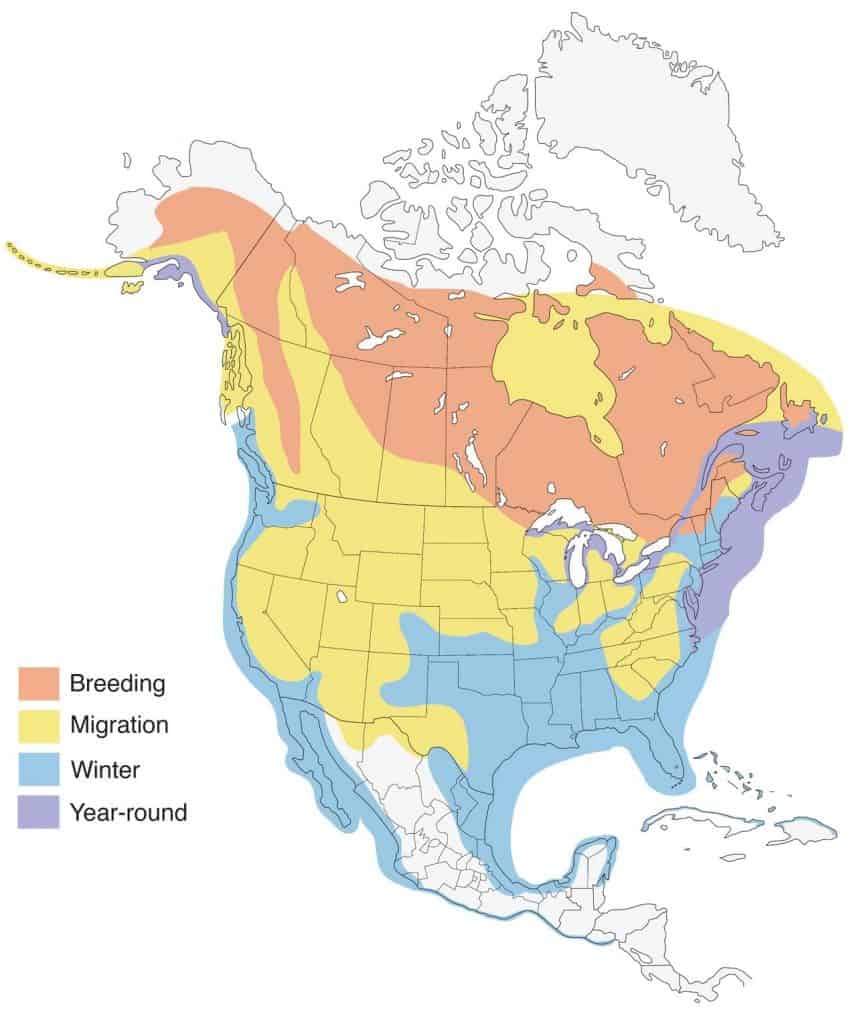
Hoary Redpoll
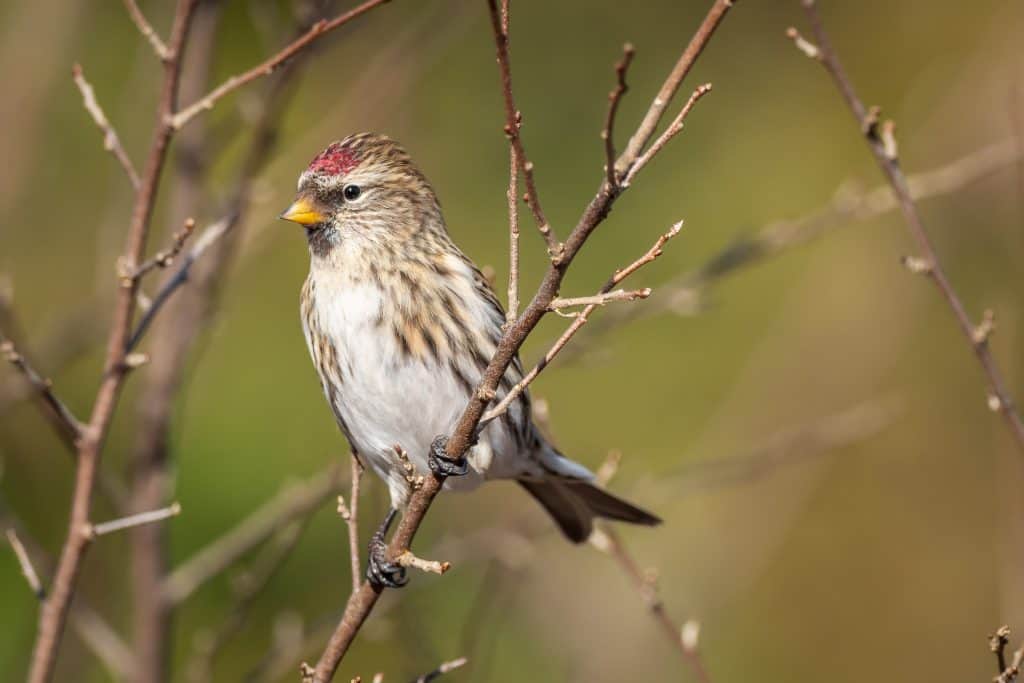
Appearance: Hoary redpolls are small birds about 5″ long with brown/gray streaks throughout, pink belly, charcoal tail & wings, and the infamous red patch on the forehead. Their bill is yellow, short, and stubby. Females are similar with less streaking and a white belly.
Diet: Seed from trees, insects, and spiders.
Feeder Food: Thistle (nyjer) seed.
Habitat: Hoary redpolls live in the far north of Canada and prefer areas with scattered shrubs or short trees.
Nesting: Hoary redpolls build a cup-shaped nest of twigs and grasses, then place them in a shrub or shorter tree. They have 1 brood/year, and 1-6 green/blue eggs/brood.
Migration: Hoary redpolls are migrators. In spring, , they migrate north to the northern edges of Canada. Then in the fall, they migrate south into Alaska, northern parts of North Dakota, Minnesota, Michigan, and southern Canada. They remain in their year-round range all seasons of the year but that area is confined to the western coast of Alaska and northeast Nunavut (Canada).
Year-round range: Western coast of Alaska, and the eastern part of Canada’s Nunavut.
Breeding range: Northern edge of Alaska, Yukon Territory, and Northwest Territories.
Winter range: Alaska, northern parts of North Dakota, Minnesota, and Michigan, and Canada’s Yukon Territory, Northwest Territories, northeast Alberta, Saskatchewan, Manitoba, Ontario, and Quebec.
Range Map
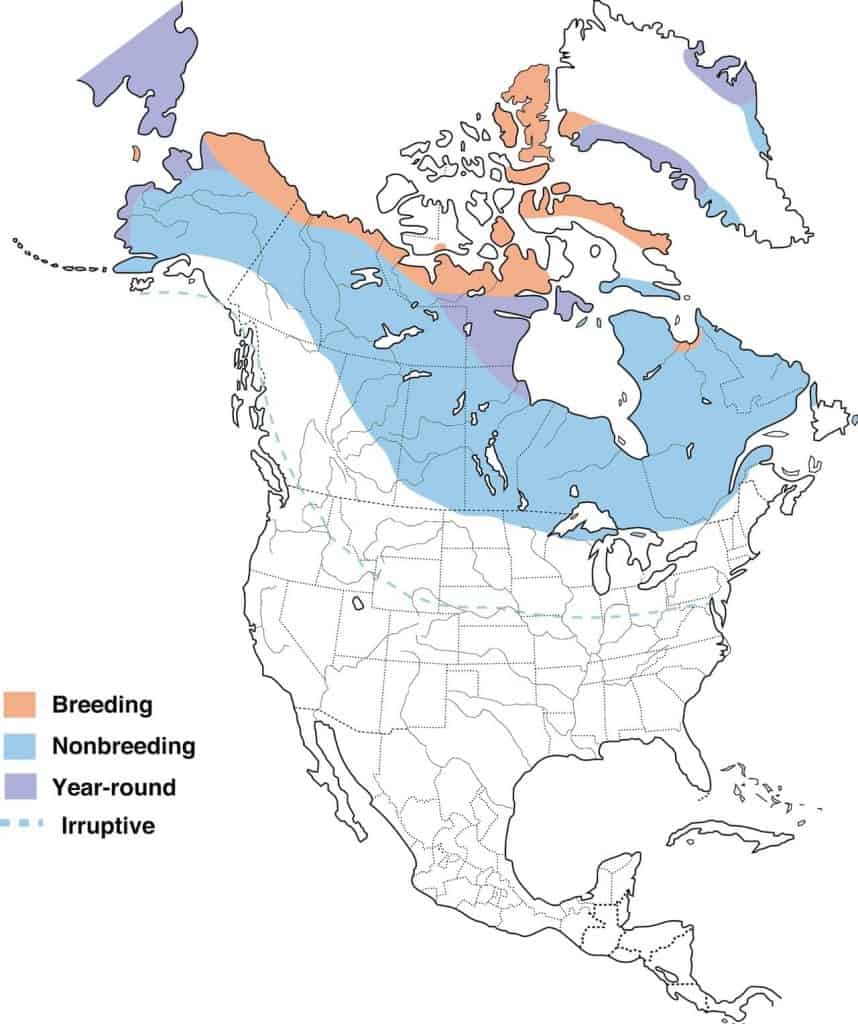
Horned Lark
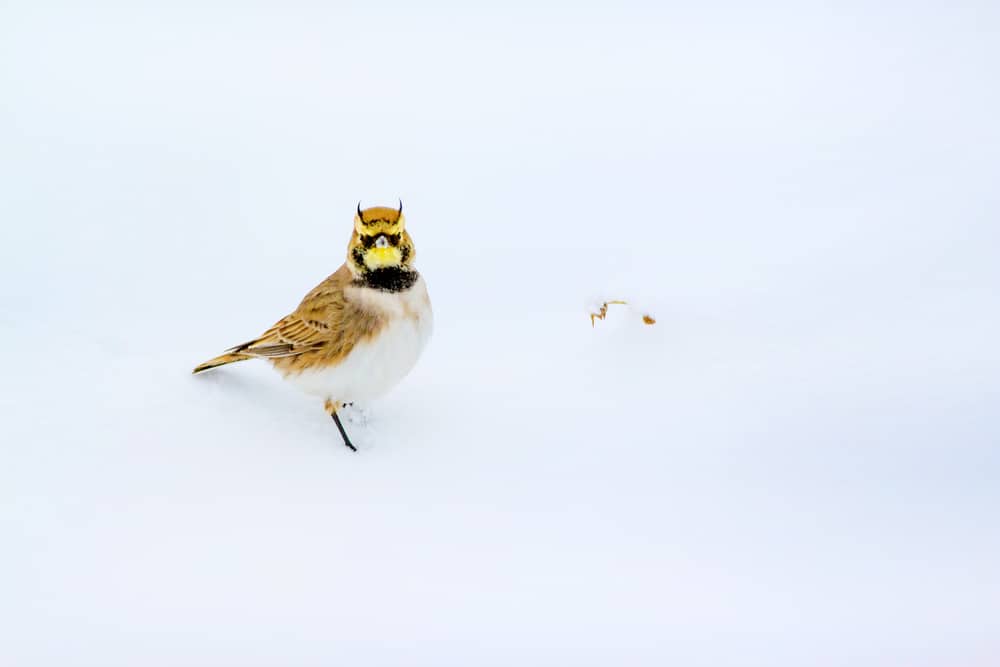
| Appearance | Medium-sized bird about 8″ long. Tan to brown with a black necklace and yellow chin. Bill is black. They have two tiny “horns” on the top of their head. The tail is black with white outer feathers. |
| Diet | Seeds and insects. |
| Feeder Food | They do not visit feeders. |
| Habitat | Short grassy areas such as prairies, deserts, beach dunes and farmers’ fields. |
| Nesting | They have 2 broods/year, 3-4 eggs/brood that are gray with brown markings. The nest is located on the ground. Incubation from 11-12 days. |
Range Map

House Finch
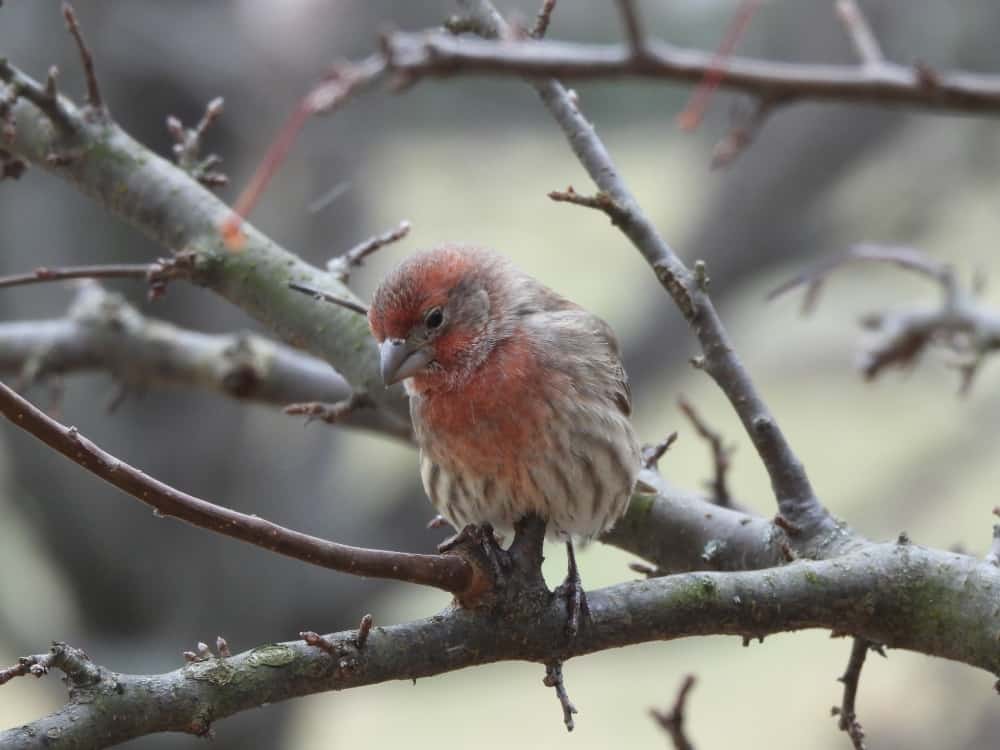
| Appearance | Small bird about 5″ long, orange/red face chest, and rump. Brown wings streaked with white. White belly with brown streaks. The Female and juvenile are brown with streaks of white. |
| Diet | Seeds, fruit, tree buds. |
| Feeder Food | Black oil sunflower seed is their favorite. |
| Habitat | House finches are found in the western and eastern parts of the US. They prefer to live around human dwellings (buildings, backyard trees, shrubs, barns. Also are found in parks and other urban areas. |
| Nesting | Nest: Small cup about 3-7″ wide, constructed from stems, leaves and plant roots, and feathers. The nests are built in coniferous or deciduous trees or even any place that holds a nest (ledges, vents, hanging plants). Broods: 1-6 broods/season Clutch: 2-6 eggs/brood (typical is 4-5) Egg color: Eggs are pale blue and speckled with black and purple dots. Egg size: 0.6 – 0.8 inches by 0.5 inches Incubation: 13-14 days and the young fledge between 12-19 days. |
| Migration | House finches are not migrators They remain in their year-round range for all seasons. Year-round range: Every US state except North & South Dakota, southern Ontario & British Columbia, and Mexico. |
Range Map
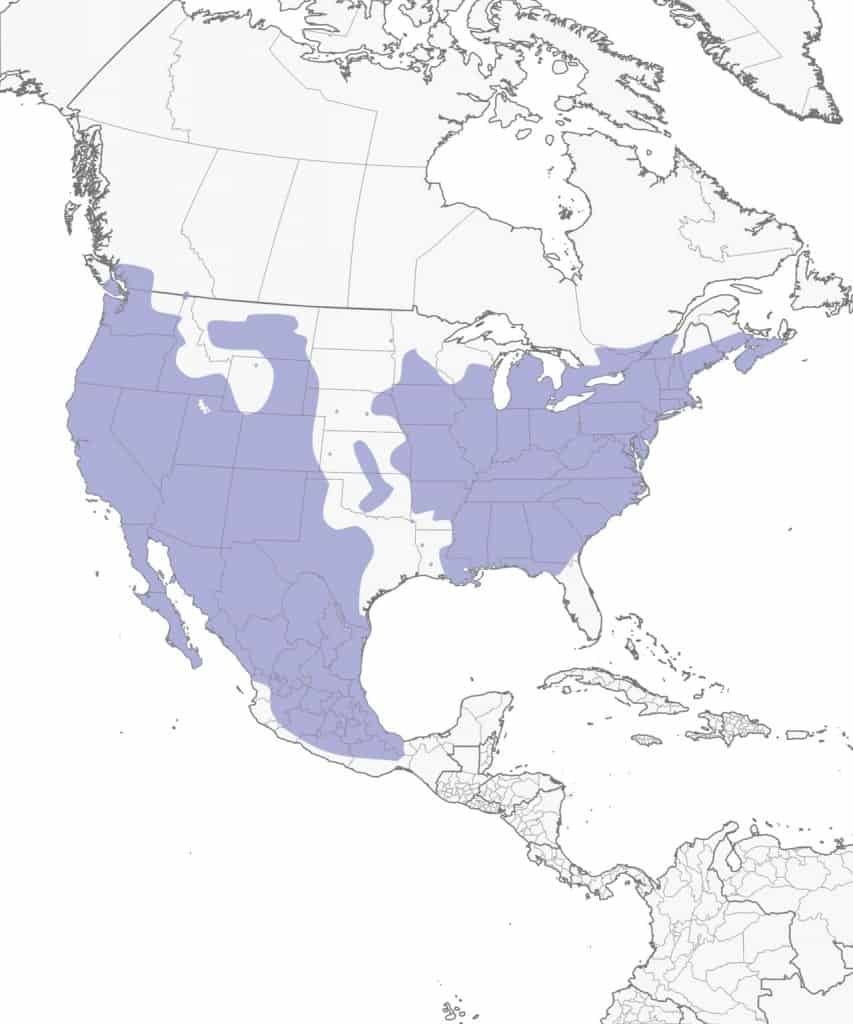
House Sparrow
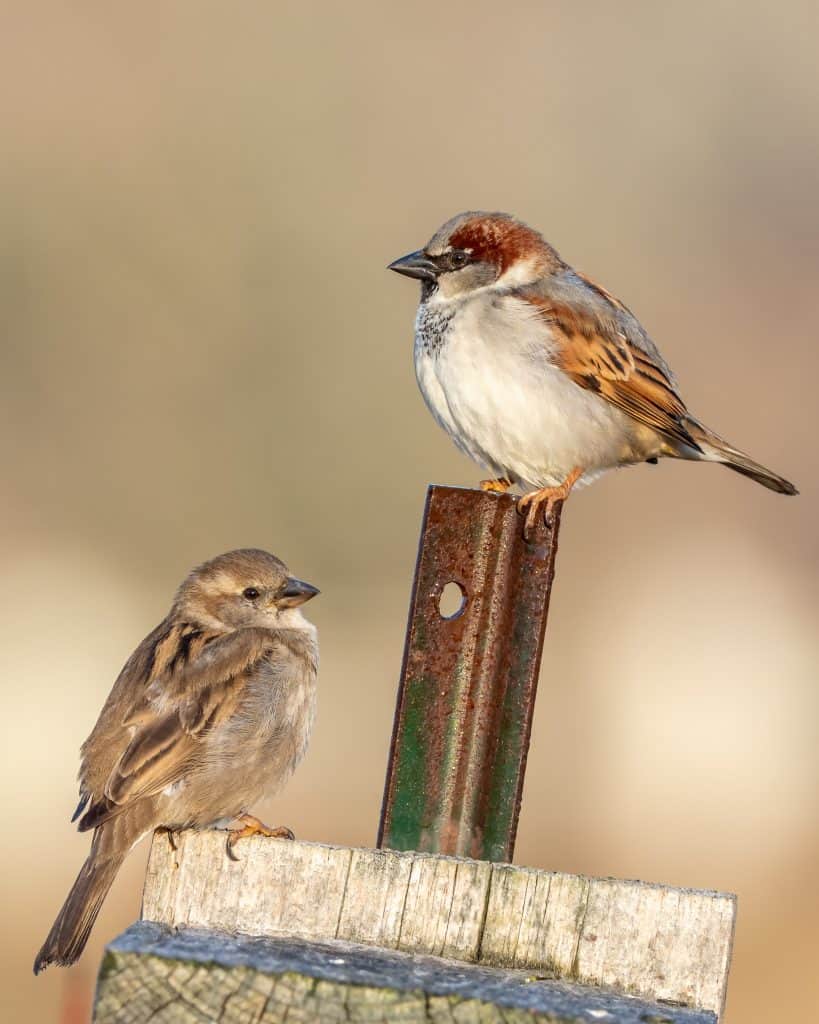
Appearance: The house sparrow is a small bird about 6″ long. They’re brown with a large black spot on the chin down to the chest. They have white wing bars, a gray belly & crown. The female is a bit smaller, all light brown and not black.
Diet: Seeds, insects, fruit.
Feeder food: Black oil sunflower seed, cracked corn, peanut hearts, millet, and milo.
Habitat: Around people and buildings in the city, towns, villages, suburbs, and farms.
Nesting: Dome-shaped nest within a cavity. They have 2-3 broods/year, and 4-6 white eggs with brown markings. Incubation is 10-12 days.
Migration: House sparrows are not migrators. They remain in their year-round range every season of the year. Their year-round range is massive encompassing nearly every part of North America (except Alaska and far northern Canada), Mexico, and Central America.
Range Map
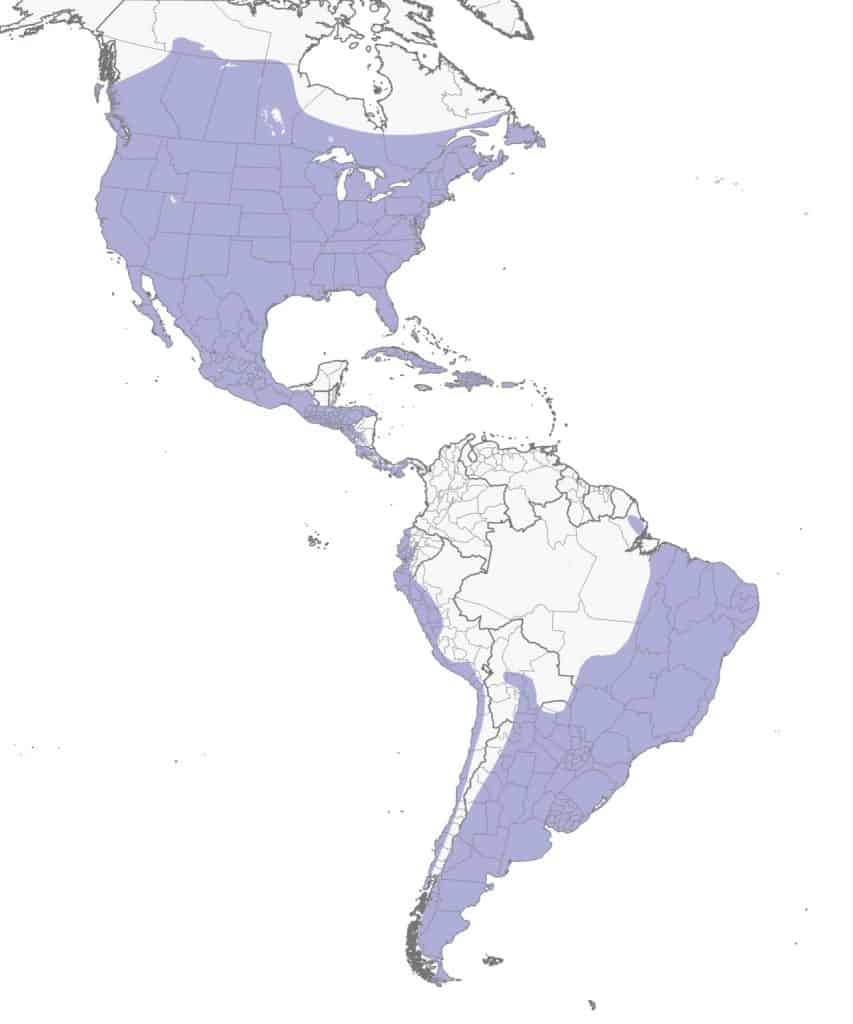
House Wren
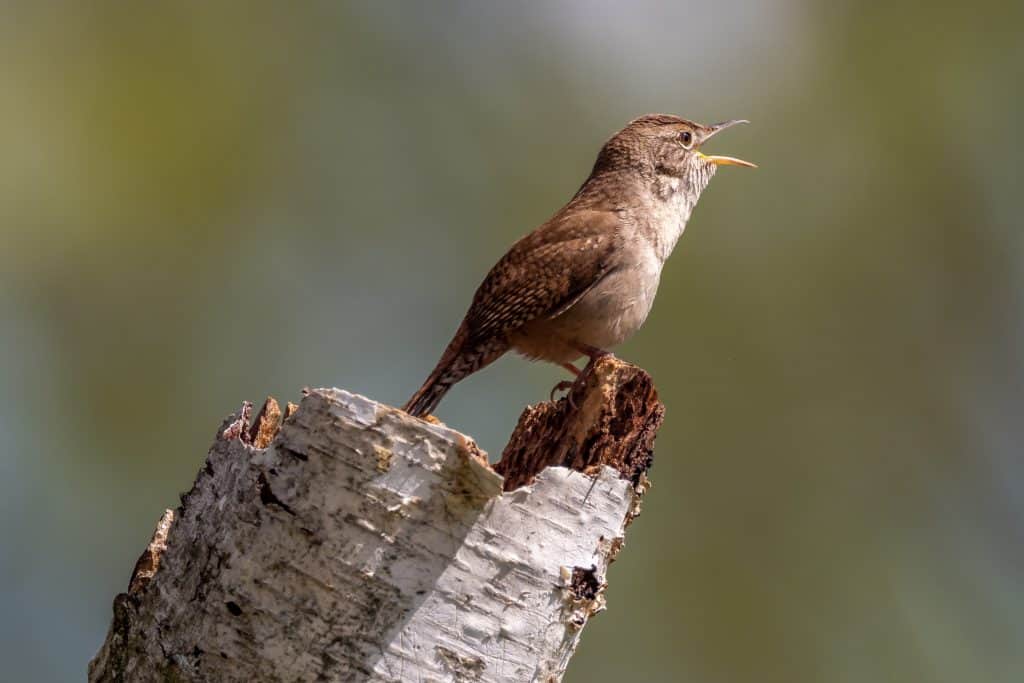
| Appearance | Small bird about 5″ long. Brown bird with faint patterns throughout and a muted throat and belly. Long pointy bill and dark eyes. |
| Diet | Insects. |
| Feeder Food | Unlikely to visit a feeder. |
| Habitat | Shrubby edges of woods, towns, and suburbs. |
| Nesting | They are cavity nesters so will use an old woodpecker hole or manmade nesting box. They have 1-2 broods/year, 3-10 eggs/brood incubated for 14 days. Eggs are white, light pink, or light gray with brown blotches. |
Range Map
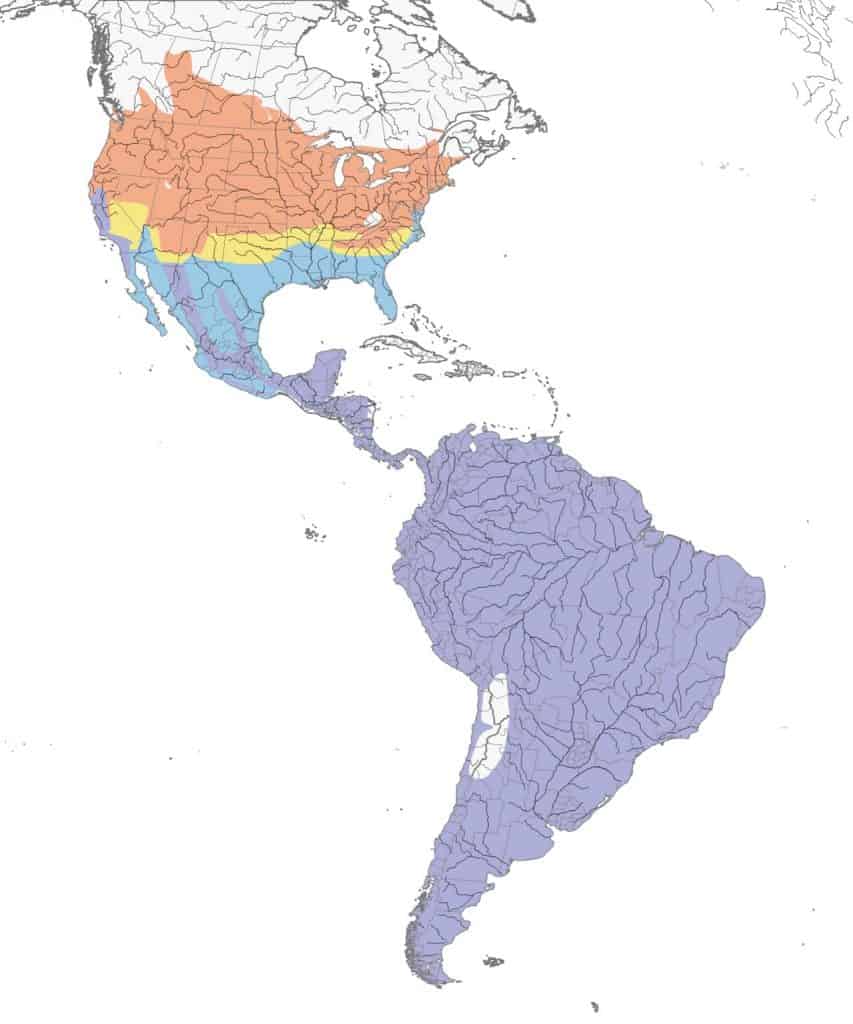
Indigo Bunting
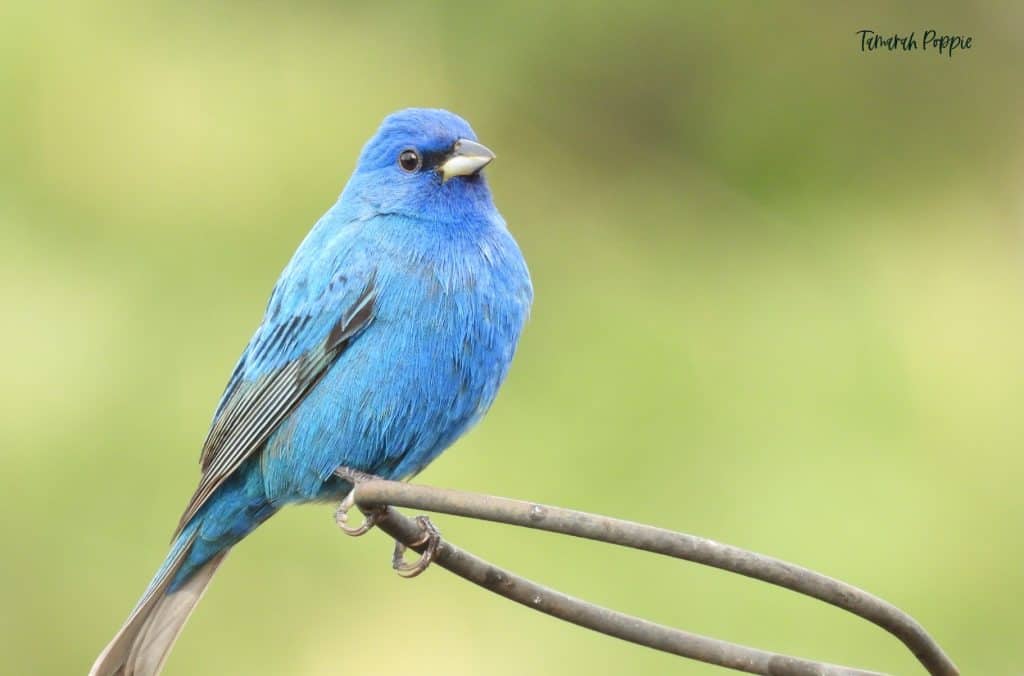
Appearance: Brushy fields, on weedy plants, scrub, and along the edges of the woods. Also in clearings within deciduous woods and edges of swamps.
Diet: Small seeds, insects, and fruits.
Feeder Food: Although not a regular at the feeder you may entice them with nyjer/thistle and white millet seeds.
Habitat: Brushy fields, on weedy plants, scrub, and along the edges of the woods. Also in clearings within deciduous woods, and edges of swamps.
Nesting: Cup-shaped nest in shrubs or trees 3′ high. Shrubs or trees 3′ high. 1-3 broods/season, 3-4 eggs/brood, eggs are white with few brown spots.
Range Map
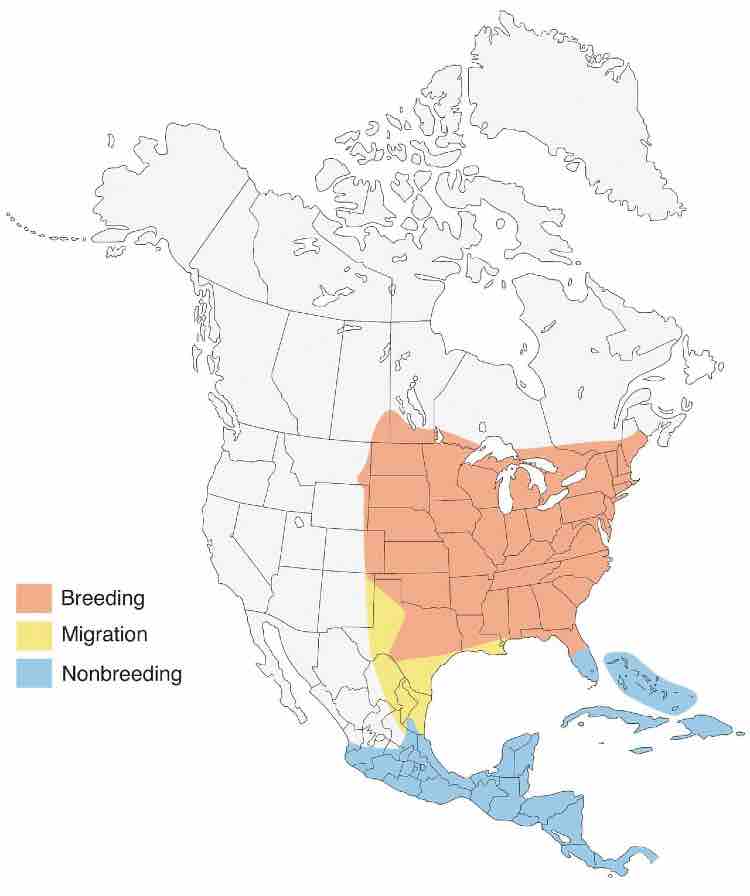
For more detail about the Indigo Bunting such as its mating & nesting, how to attract them to your yard, and more: check out Proven Ways to Attract Indigo Buntings.
Killdeer
| Appearance | Medium-large sized bird about 11″ long. Brown with black two bands around the neck, a white belly, red-orange rump, large orange eyes, long beaks, and long legs. Female looks like the male. |
| Diet | Insects. |
| Feeder Food | They don’t visit feeders. |
| Habitat | Open grasslands. |
| Nesting | They nest on the ground. They have 2 broods/year, 3-5 tan eggs/brood, and incubation is 24-28 days. |
Range Map
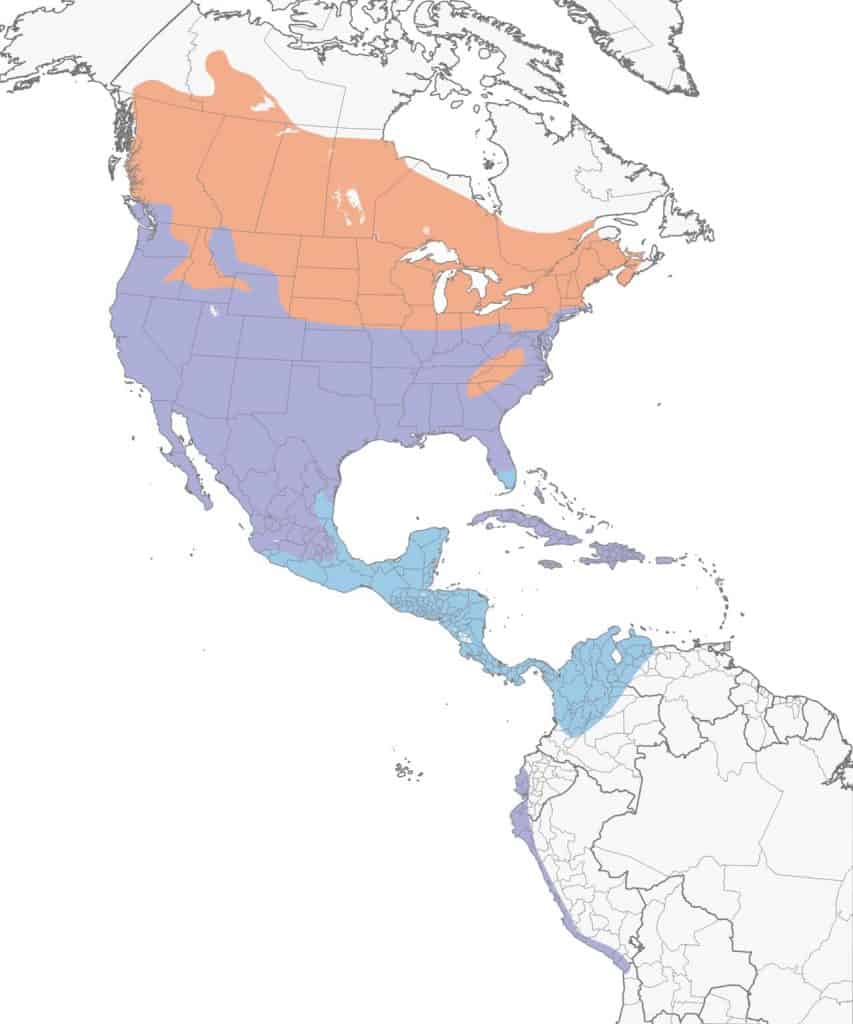
Kirtland’s Warbler
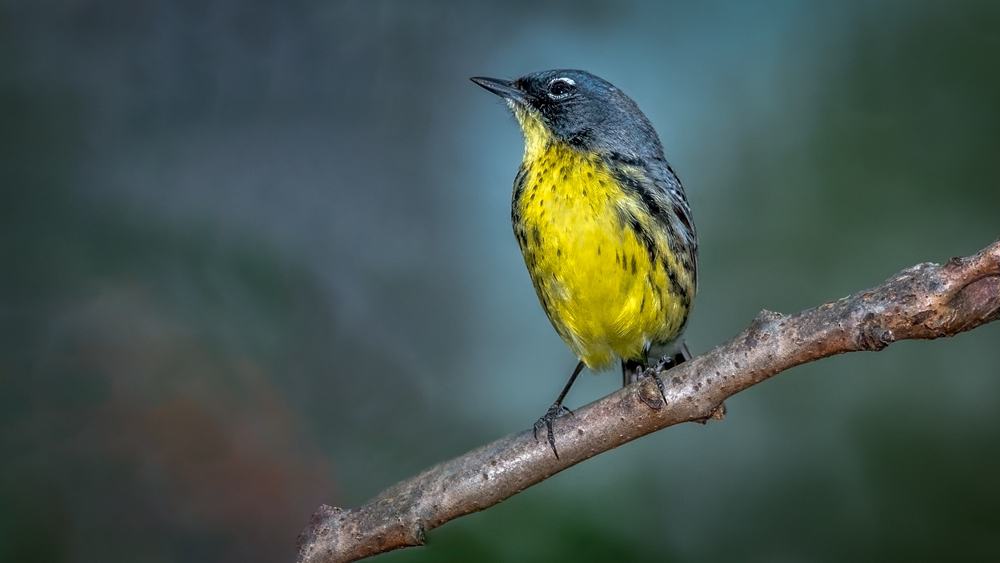
| Appearance | Small bird about 5 1/2″ long. They are steel gray above with yellow throat, chest, and belly. White crescents appear above and below each eye. On the male, a dark mark appears in front of the eyes but does not on the female. The female also has more muted colors than the male. |
| Diet | Insects and fruit. |
| Feeder Food | Unlikely to visit a feeder. |
| Habitat | They primarily are found in wooded areas, specifically where younger Jack pine trees exist (e.g. less than 15 years old) |
| Nesting | The nest is located on the ground. They have 1-2 broods/year, 3-6 eggs/brood that are white or ivory with brown specks. Incubation is from 13-15 days. |
Range Map
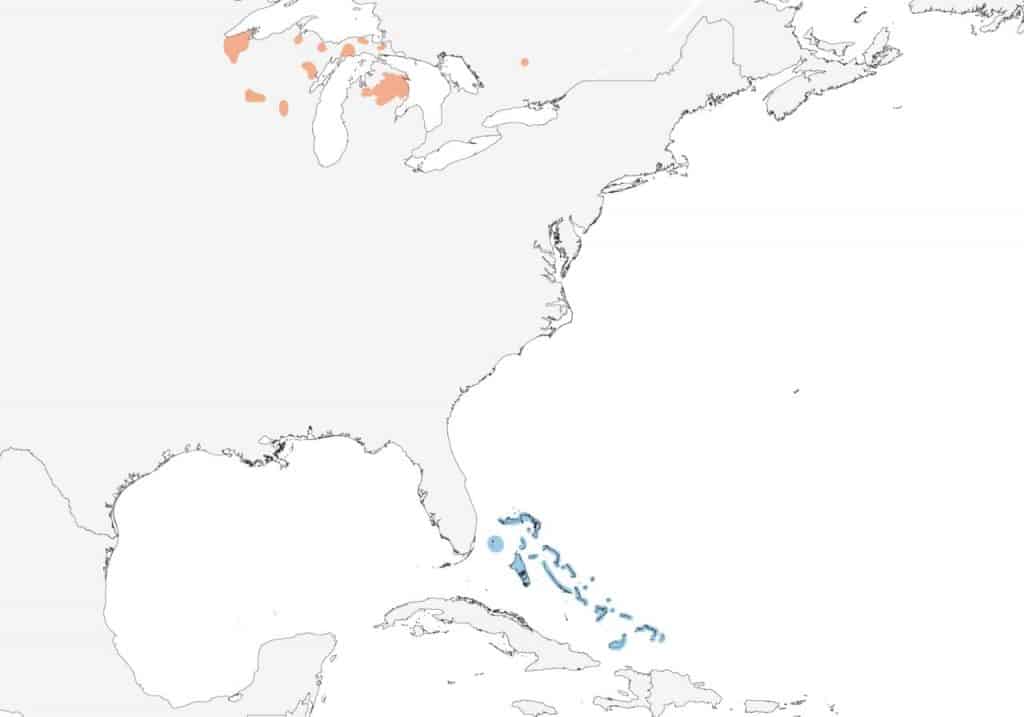
Magnolia Warbler

| Appearance | Small bird about 5″ long with slate gray top and bright yellow under with black stripes. A black mask surrounds the eyes with a white strip above that. Short pointy bill and long, narrow tail. The female is lighter gray with a yellow belly but only a faint black stripe. She has no black mask, her eyes have white eye rings and splotches of yellow on her back. |
| Diet | Insects and sometimes fruit in fall. |
| Feeder Food | Unlike to visit feeders. |
| Habitat | Thickly forested areas with conifer trees. |
| Nesting | They nest deep in coniferous trees. They have 1-2 broods/year, 3-5 eggs/brood that are white some speckled. Incubation lasts 11-13 days. |
Range Map
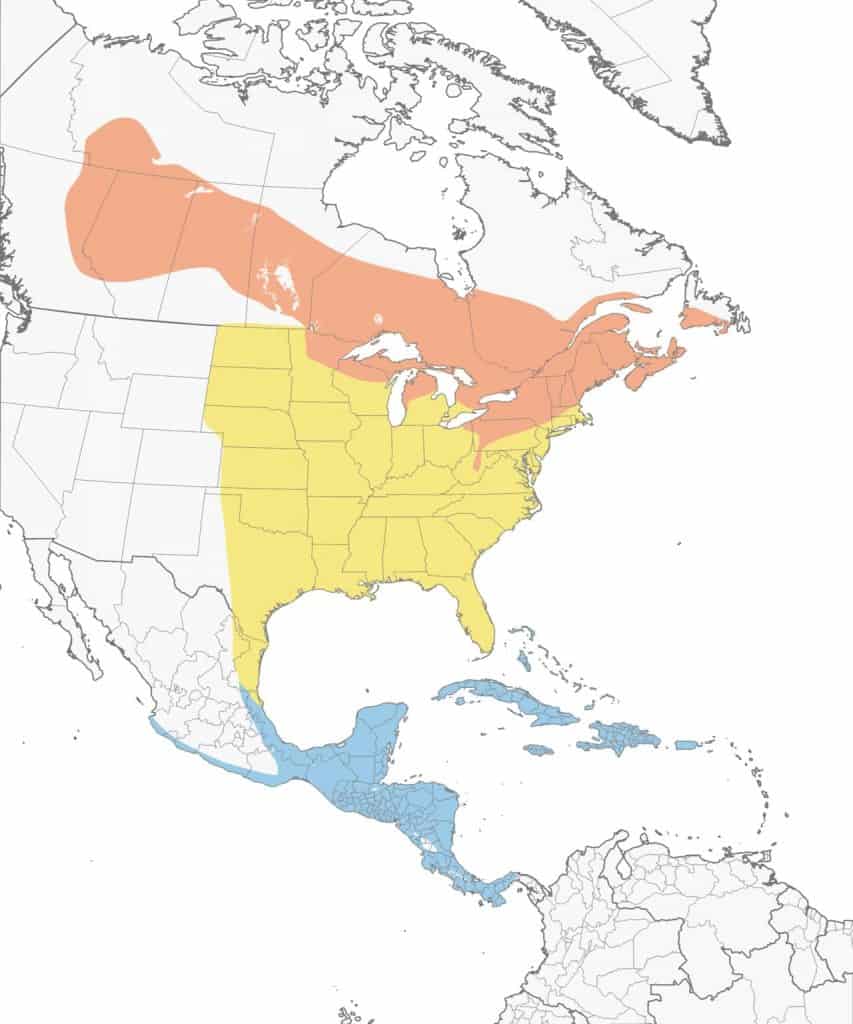
Mallard
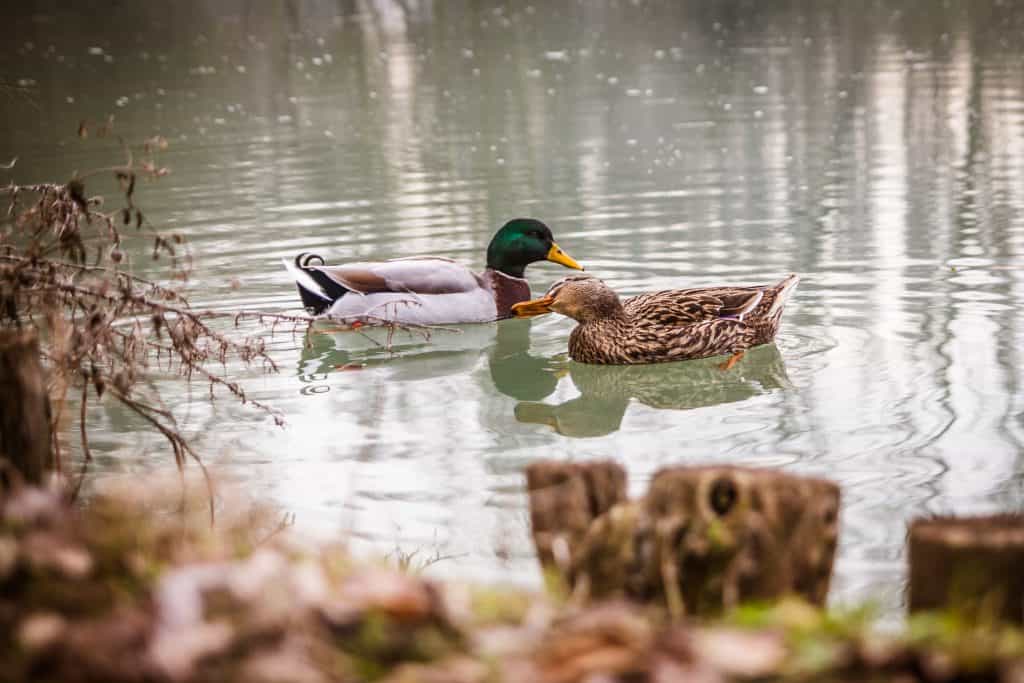
| Appearance | Mallards are large ducks about 23″ long. The male has a metallic green head, chestnut breast, and yellow bill. The female is a mottled brown with an orange bill and heavily streaked dark brown. |
| Diet | Insect larvae, snails, seeds. |
| Feeder Food | They’re not feeder visitors. |
| Habitat | Around freshwater habitats. |
| Nesting | Mallards nest on the ground near water. The nest is typically made from plant materials and lined with feathers and down. They have 1-2 broods/season and 10-12 eggs/brood. Incubation lasts for 28 days and fledglings leave their mom at about 7-8 weeks. |
Range Map
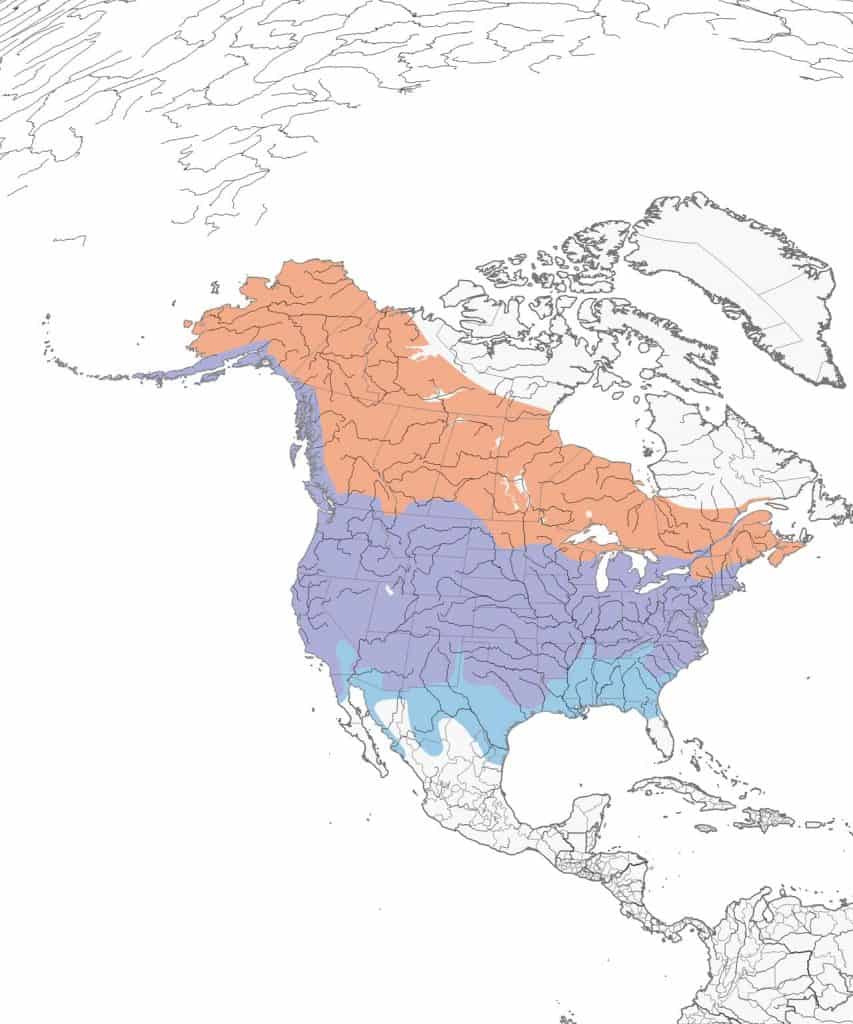
Mourning Dove
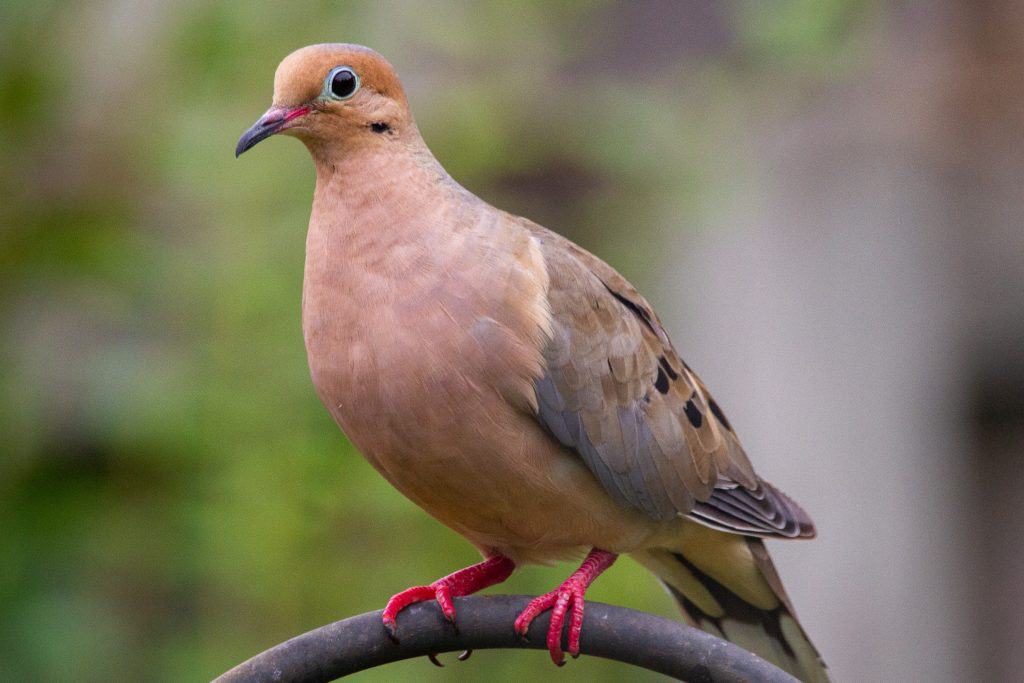
| Appearance | The mourning dove is a large bird about 12″ long and smooth with fawn colors. Black spots on the wings and tail. A single black spot below and behind the eyes. Wide brown tail with white edges. Red-orange legs. Gray patch between the head and back and iridescent colors around the neck. Large black eyes with light blue around the eyes. Pointy bill. |
| Diet | Seeds. |
| Feeder Food | Will come to eat seeds that drop below the feeder. |
| Habitat | Open areas. |
| Nesting | They build a platform-style nest that’s located on a tree branch. Sometimes will nest on the ground. They have 2 broods/year and 2 eggs/broods that are white. Incubation is 13-14 days. |
Range Map
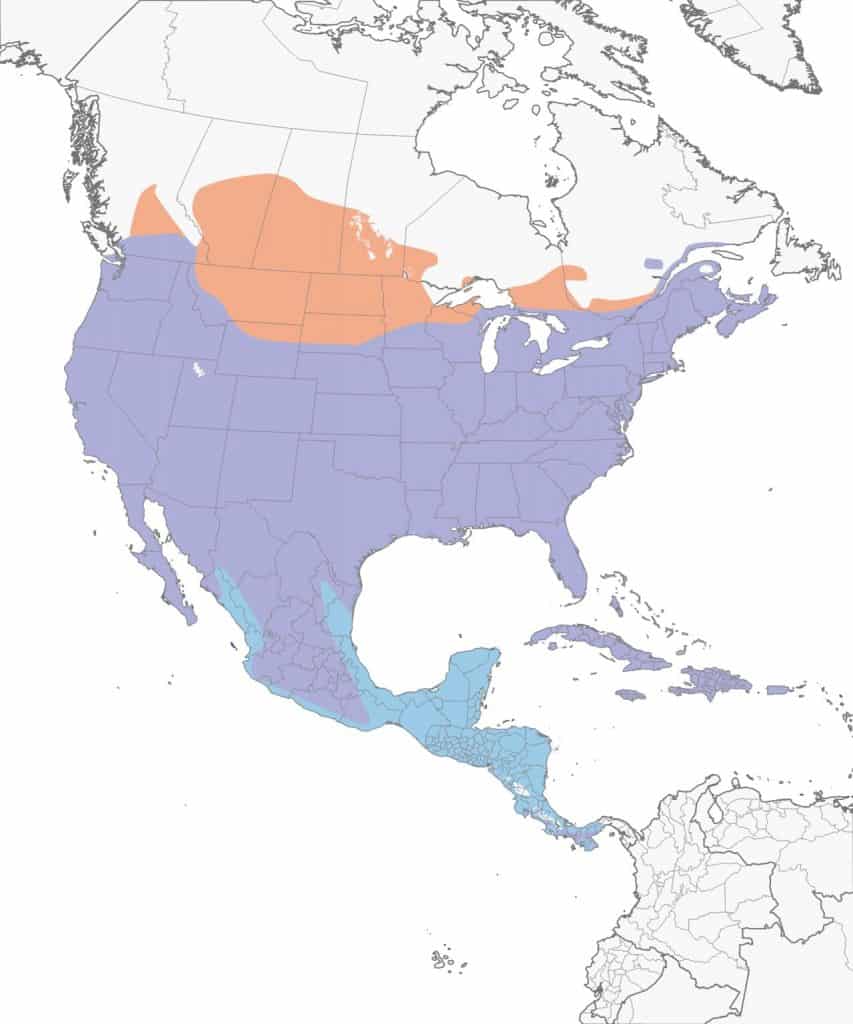
Mute Swan
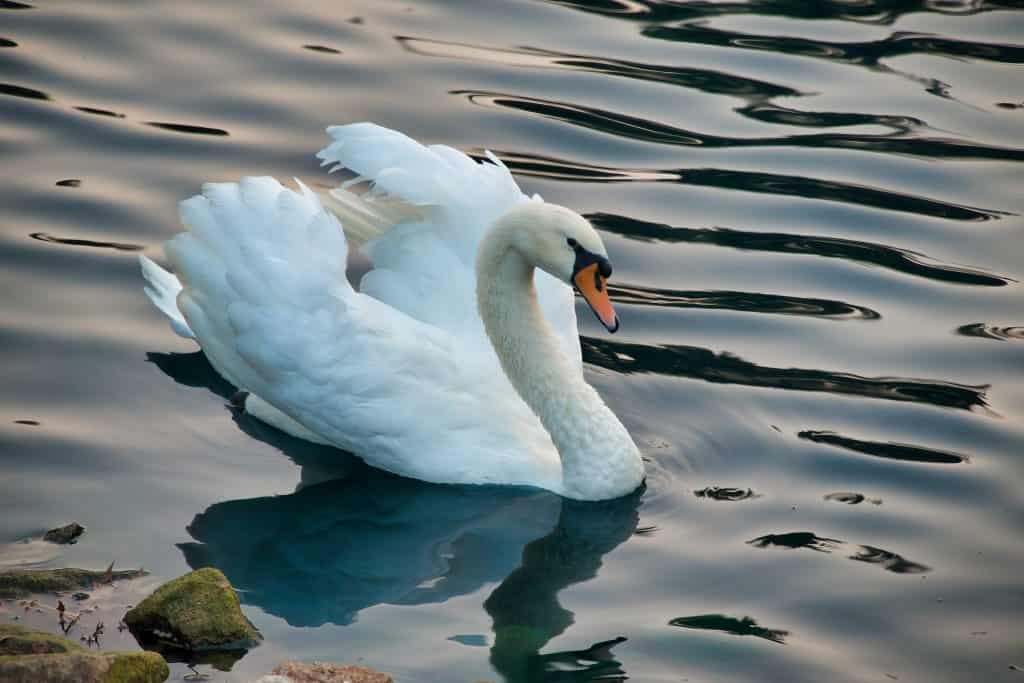
| Appearance | Mute swans are enormous waterbirds at about 50-60″ in length. They’re white with an orange bill and black at the base of the bill on the face. |
| Diet | Fish and plant material |
| Feeder Food | N/A |
| Habitat | Mute swans are found floating on the water in urban ponds (parks), lagoons, rivers, lakes, and coastal areas where saltwater meets freshwater rivers and streams. |
| Nesting | Mute swans are ground nesters. They construct the nest on beaches, dikes or even on nearby islands. Clutch: 5-7 eggs/brood on average Egg color: pale green Incubation: Incubation is about 36 days. The young fledge after about 4-5 months. |
Range Map
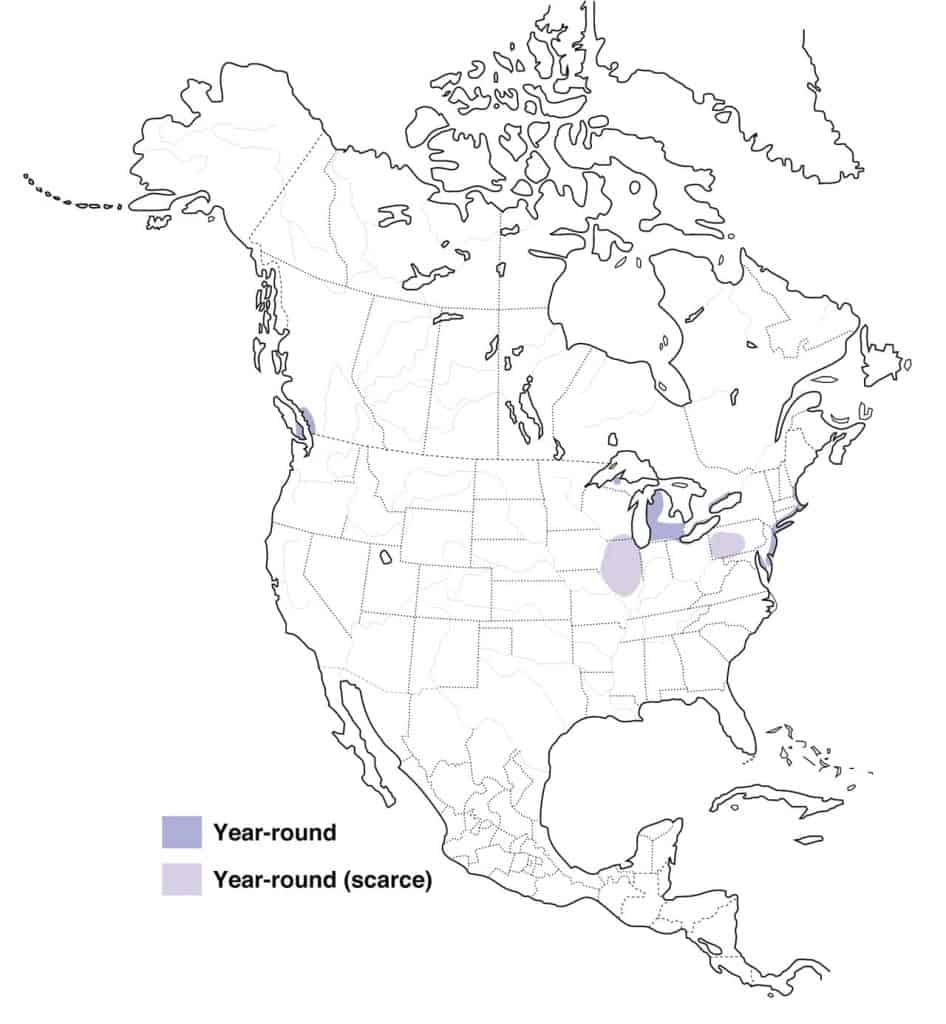
Northern Bobwhite
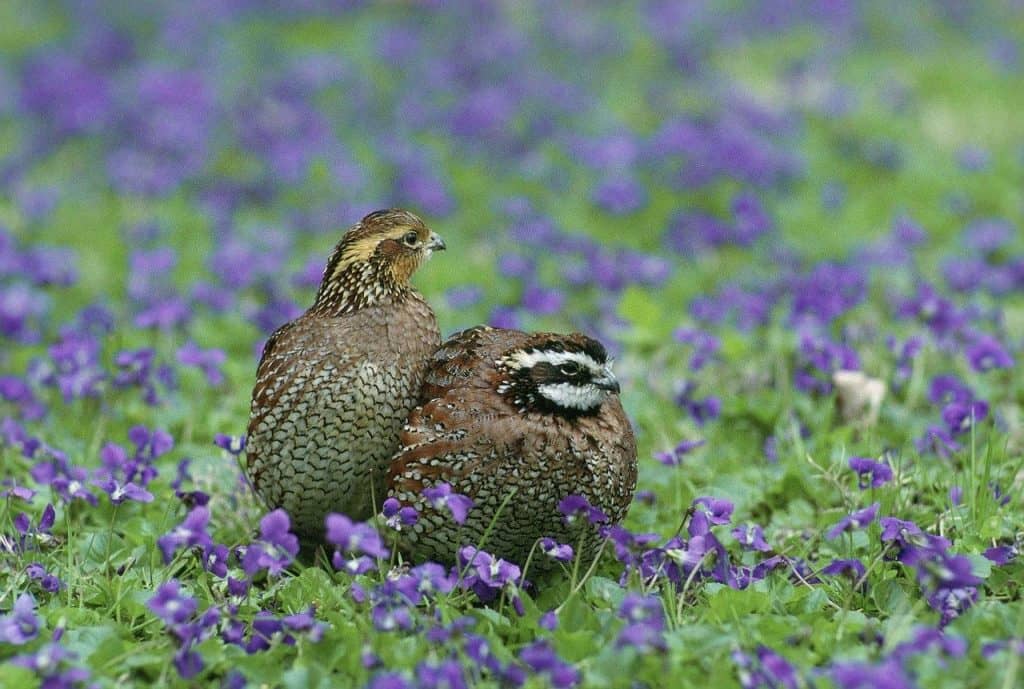
Appearance: Northern bobwhites are a type of quail and are about 10″ long. They’re reddish-brown with streaking and spotting throughout. They have a whisp of a crown (hardly noticeable), and a white stripe starts at the bill and goes over the eye all the way to the back. Their throat is also white. Females are the same except the head is brown and tan.
Diet: Seeds, berries, and insects.
Feeder food: They will indulge in seed or crack corn scattered beneath the feeder.
Habitat: Found in rural and farm areas.
Nesting: Northern bobwhites nest on the ground in a sheltered location. They have 1-3 broods/season and 12-14 eggs/brood. Incubation is for 23 days and fledglings leave the nest about 7-10 days after hatching.
Migration: Northern bobwhites are not migrators. They remain in their year-round range every season of the year.
Year-round range: Eastern half of the US, Washington, Oregon, Idaho, and Mexico. ,
Range Map
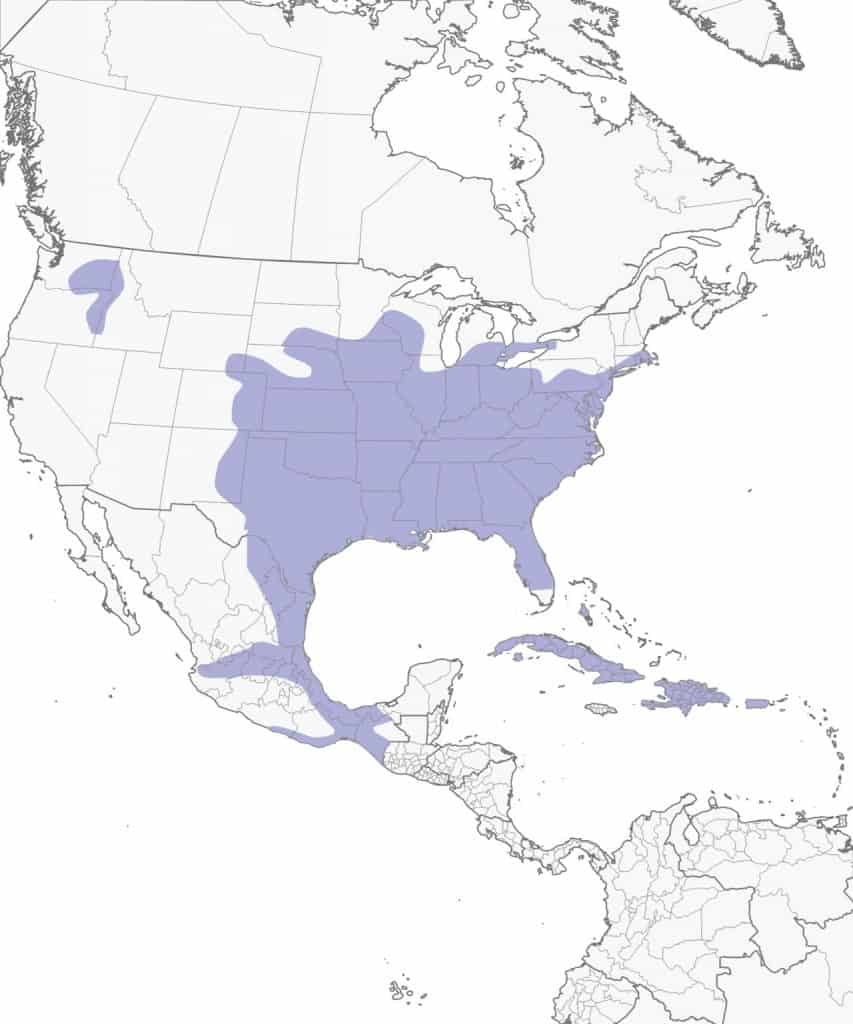
Northern Cardinal
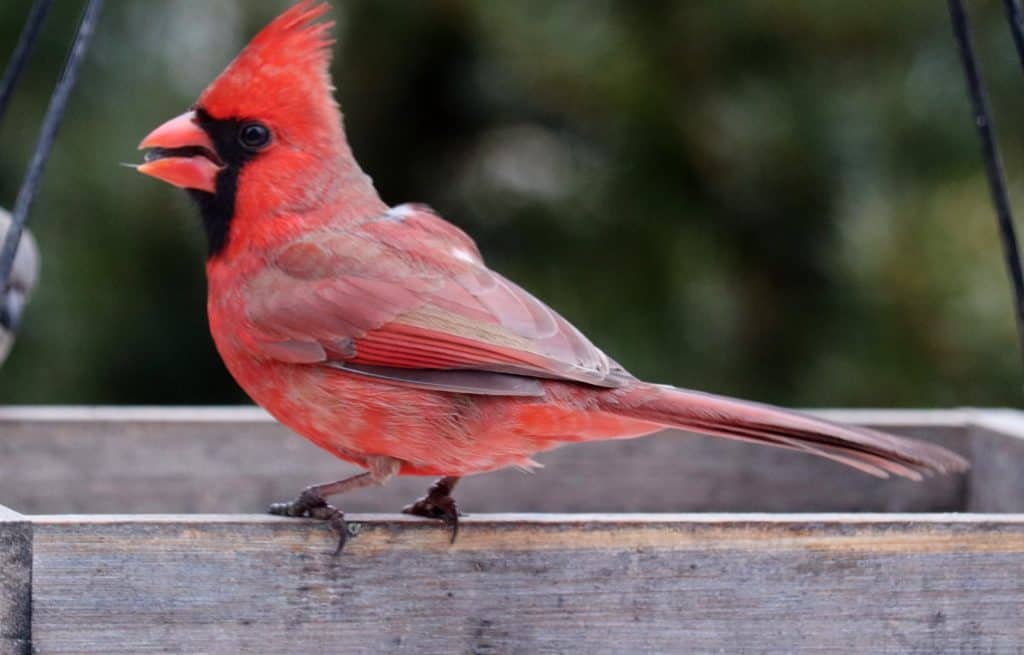
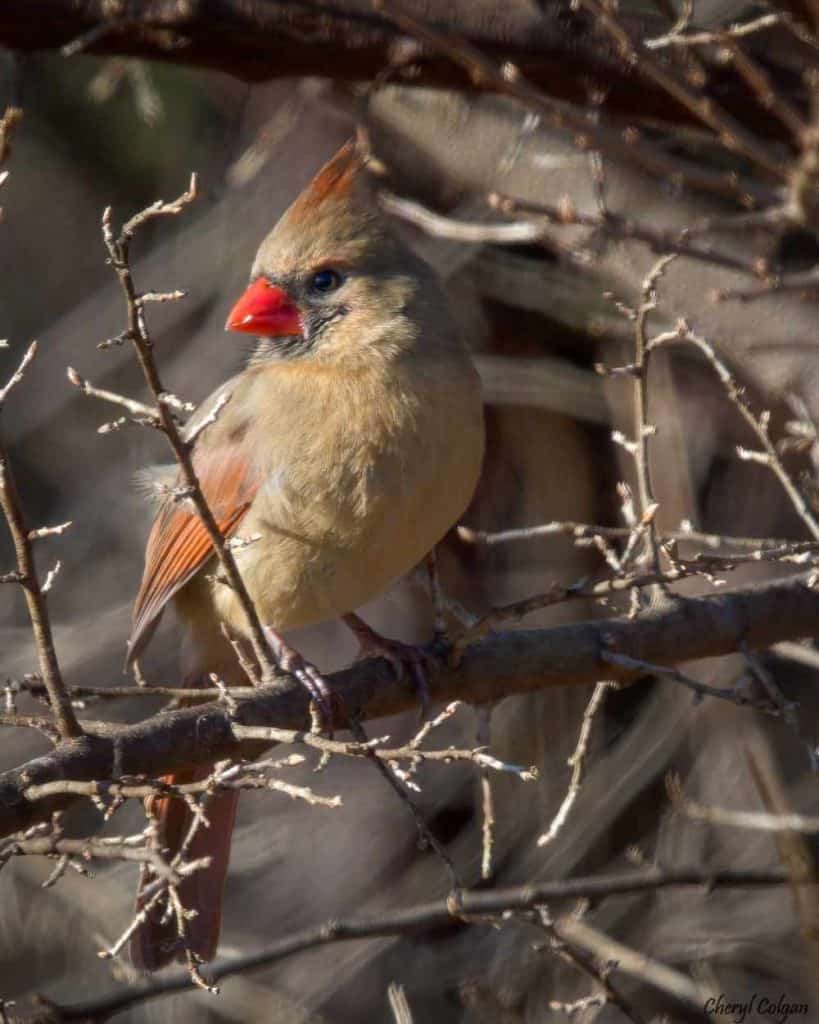
Appearance: Northern cardinals are medium-sized bright red birds about 8 1/2″ long with a black mask, red crown, orange beak, and black areas on wings and tail. The female also has an orange beak but her body is buffy brown with tinges of red on her wings, tails, and crest. The mask around her fact is charcoal.
Diet: Insects, spiders, centipedes, snails, and slugs. Fruit and seeds from plants.
Feeder food: Black-oil sunflower seed, safflower seed, mealworms, striped Sunflower seed, hulled peanuts, and cracked corn.
Habitat: Edges of wooded areas to thickets, tangled vines, city parks, and our backyard gardens.
In the southwest live around desert washes, areas thick with mesquite, and along the riverbanks of wooded areas.
Nesting: Open-cup nest in a dense shrub about 3-10′ up. They have 2-3 broods/year, and 1-5 eggs/brood that are beige with brown spots. Incubation is 12-13 days.
Migration: Northern cardinals are not migrators. They remain in their year-round range every season of the year.
Year-round range: Eastern half of the US, Arizona, New Mexico, and Mexico.
Range Map
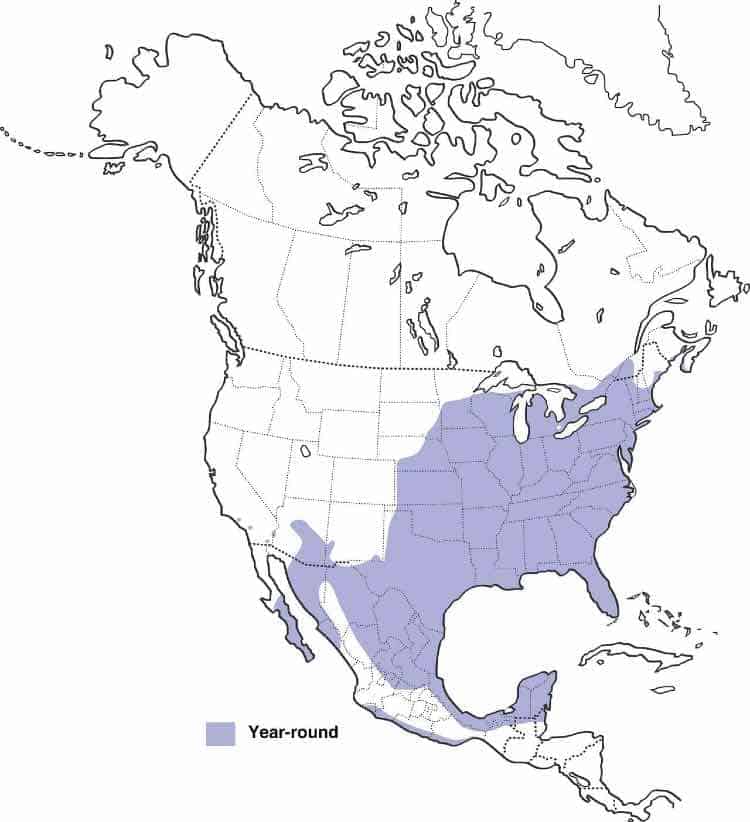
Northern Flicker
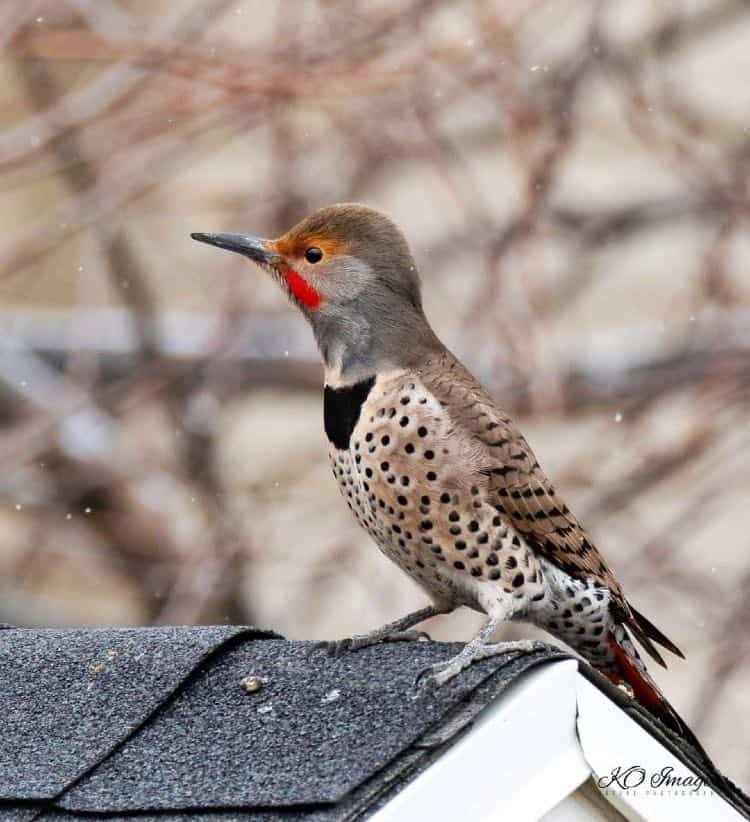
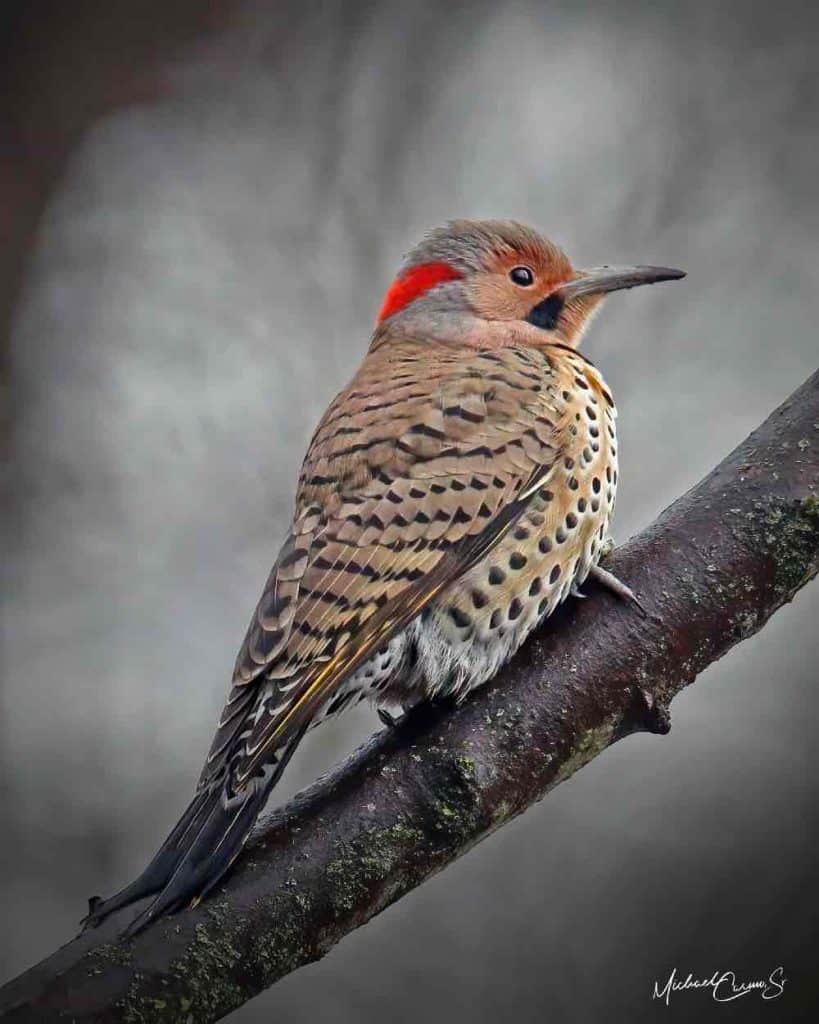
Appearance: A large bird about 12.5″ long. They have brown backs with black bars, a black crescent on the upper chest, and white with black spots on the belly and underparts.
• In the eastern part of their range, they are referred to as “yellow-shafted northern flickers” and have bright yellow underwings and undertail. They have a gray crown, tan face, and a red patch on the nape. The male has a black swipe on his cheek, the female does not.
• In the western part of their range, they are referred to as “red-shafted northern flickers” and have pink underwings and undertail, brown crown, gray face, and crown & nape are brown. The male has a red swipe on his cheek, the female does not
Diet: Insects, especially ants.
Feeder food: Hulled peanuts and suet.
Habitat: Open areas near trees.
Nesting: They are cavity nesters and have 1 brood/year. 5-8 white unmarked eggs per brood. Incubation is 11-14 days.
Migration: Northern flickers are migrators. Scientists believe the timing and duration of their migration from the breeding range to their winter range are dependent on weather. They generally migrate at night and travel in large but loose flocks of up to 100 or so birds.
Year-round range: Each US state as well as parts of British Columbia,
Breeding range: Alaska, Canada, and inland parts of their year-round range in Washington, Oregon, and California.
Winter range: Many will winter in the year-round range while others head further south into southeast California, southwest Arizona, Texas, and Mexico.
Range Map

Northern goshawk
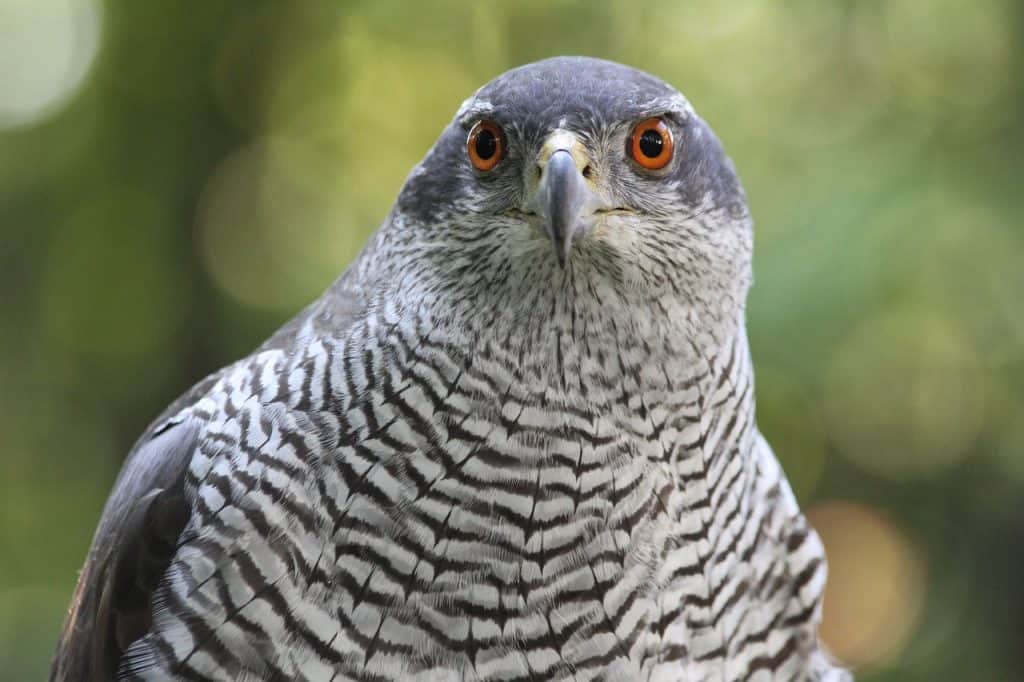
Appearance: Northern goshawks are large birds about 21-30″ long.
Diet: Mammals (e.g. rabbits, squirrels), large birds (e.g. grouse, woodpeckers, blue jays, crows), reptiles, insects, and even carrion.
Feeder food: They don’t eat feeder food.
Habitat: This bird prefers forest areas comprised of both coniferous and deciduous trees.
Nesting: Northern goshawks place their nest in a large, tall tree next to the trunk or horizontally along forked branches. In the east they choose deciduous trees, in the west, it’s usually conifers. They’ll build or use an existing nest from a prior brood. They have 1 brood/season, 2-4 blue/white eggs/brood, incubate for 28-38 days and the fledglings leave the nest after 35 days.
Migration: Northern goshawks are migrators. While many remain in their year-round range all seasons of the year, some will head further south for the winter.
Year-round range: Alaska, Washington, Oregon, California, Idaho, Montana, Wyoming, Nevada, Utah, Colorado, Arizona, New Mexico, Minnesota, Wisconsin, Michigan, Pennsylvania, New York, New England, all of Canada, and Mexico.
Winter range: Their year-round range plus North & South Dakota, Nebraska, Illinois, and Ohio.
Range Map
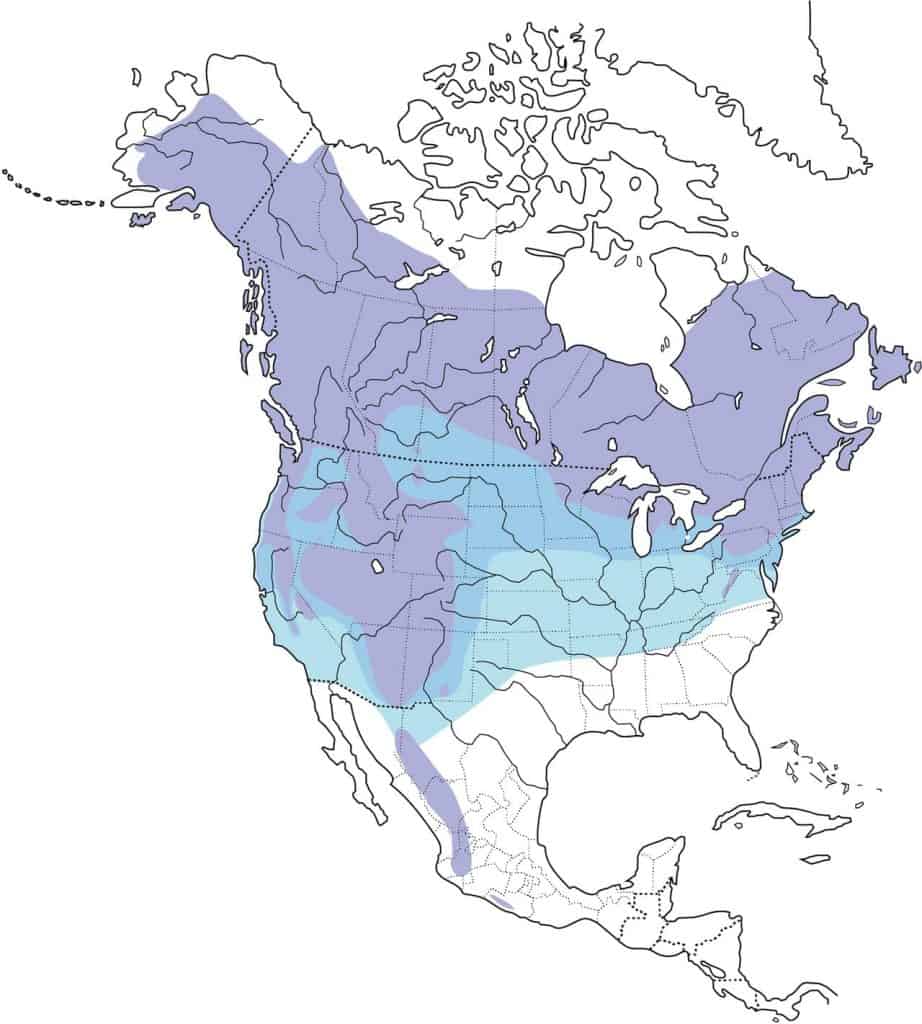
Northern Mockingbird
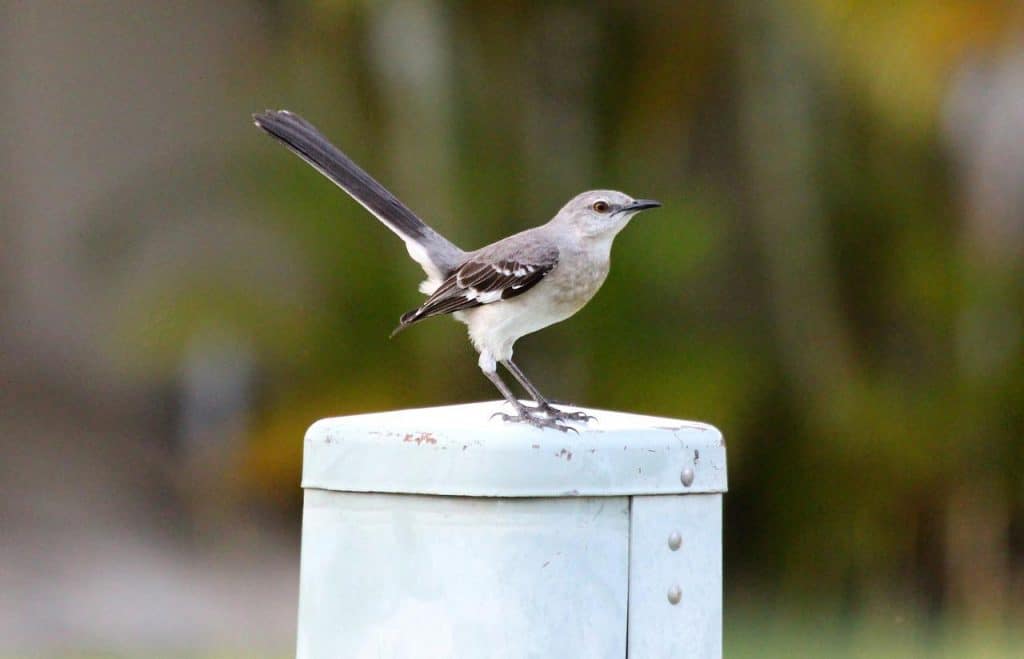
Appearance: Northern mockingbirds are about 10″ long. They have gray above and white below. Wings are dark gray with patches of white. They have long beaks and yellow eyes.
Diet: Insects and berries.
Feeder food: Suet
Habitat: Northern mockingbirds prefer thickets and brushy areas with open areas nearby.
Nesting:
- Nest: They nest in a thick shrub or tree between 1-10′ up. Northern mockingbird males select several nesting sites and begin building nests in each. The female will pick her favorite and finish the nest. They won’t abandon these nests but move to another with each brood
- Brood: 2-3 broods/season
- Clutch: 2-6 eggs/brood
- Egg color: Light blue to greenish-white sporting brown or red spots.
- Egg size: 1.1 inches by 0.8 inches
- Incubation: 12-14 days and fledglings leave the nest at 11-15 days.
Migration: Northern mockingbirds do not migrate. They remain in their year-round range all seasons of the year.
Year-round range: Every US state, the southern edges of Canada’s British Columbia, Alberta, Saskatchewan, Manitoba, Ontario, Quebec, and Mexico.
Range Map
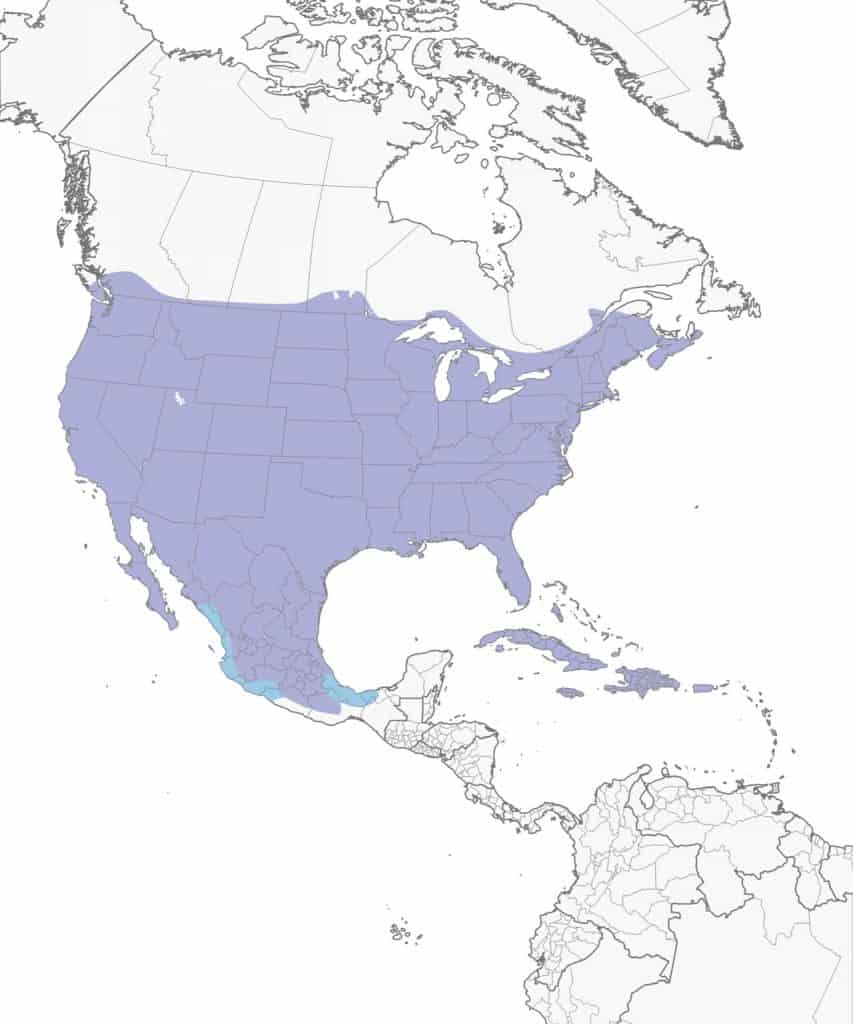
Northern Parula
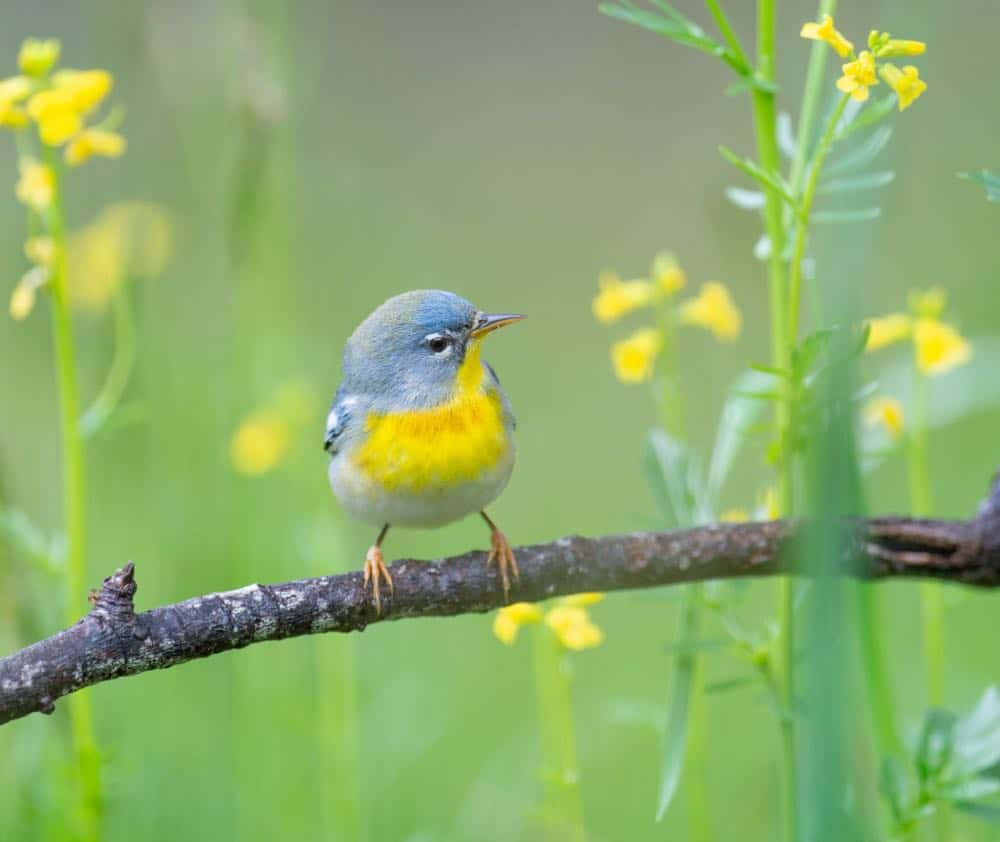
Appearance: Northern parula is a small bird about 4.5″ long, blue/gray with a yellow throat and back patch, bluish-gray overall with a yellow-green patch on the back, a brown band on the lower, and white strips above and below each eye. Females are similar but more muted colors. neck, and 2 white wing bars.
Diet: Spiders, insects, berries, seeds, nectar.
Feeder food: Unlikely to visit a feeder.
Habitat: Prefer forested areas especially when water is present (streams, marshes) and in the lowland where moss is present.
Nesting: Nests are built in mossy vegetation as high up as 100′ at the end of a branch. 1-2 broods/season, 2-7 eggs/brood, eggs are about .65″ long, white with red/brown/purple speckles, and incubation lasts about 12-14 days.
Migration: Northern parulas are migrators. In the spring, they migrate north to breed and raise their young. Then in the fall, they migrate south for the winter.
Breeding range: The US states south and east of Kansas, northern Minnesota, Wisconsin, & Michigan, Pennsylvania, New York, New England, and the southern parts of Canadian provinces Manitoba, Ontario, and Quebec.
Winter range: Southern tip of Florida, the Caribbean islands, Mexico, and Central America.
Range Map
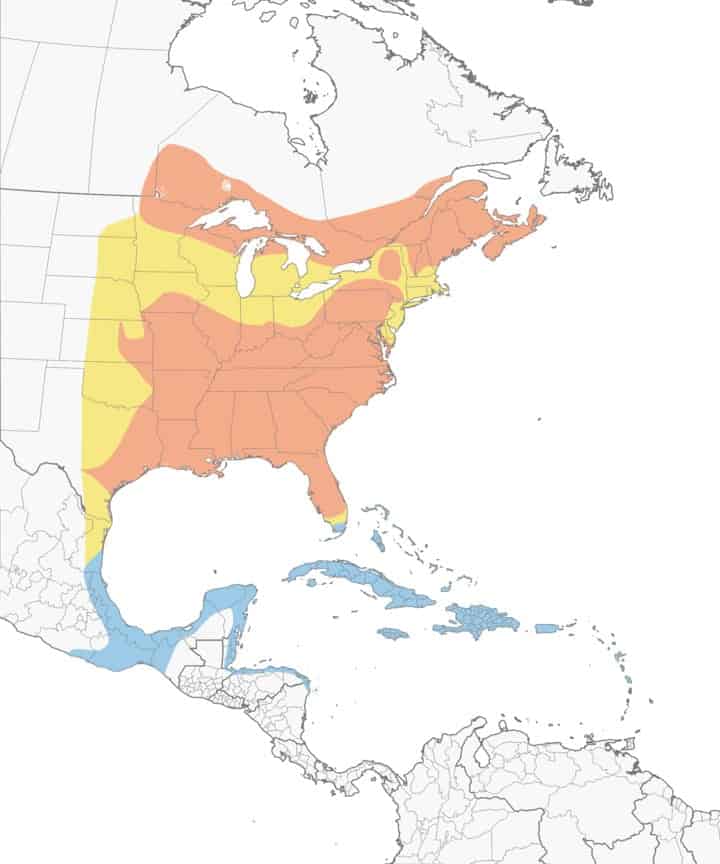
Northern Shoveler

| Appearance | Northern shovelers are medium-sized waterbirds at about 17-20″ in length. They have shovel-shaped heads. The male has a dark green head, black back and feathers, white neck, and brown chest. The female has an orange bill & eggs with brown and white markings throughout her body. |
| Diet | Mollusks, insects, crustaceans, sometimes small fish, aquatic plants, and seeds. |
| Feeder Food | N/A |
| Habitat | Northern shovelers can be found in shallow wetland areas with plenty of vegetation. They’ll also be found in salt marshes, lakes, flooded fields, and other overflow areas that collect water. |
| Nesting | Northern shovelers are grounds nesters. The female generally Broods: 1 broods/season Clutch: 8-12 eggs/brood Egg color: pale olive Egg size: About 2″ x 1.4″ Incubation: Incubation lasts 21-27 days. The young follow their mom out of the nest within a few hours of hatching. They’re able to fly about 52-60 days after hatching. |
Range Map
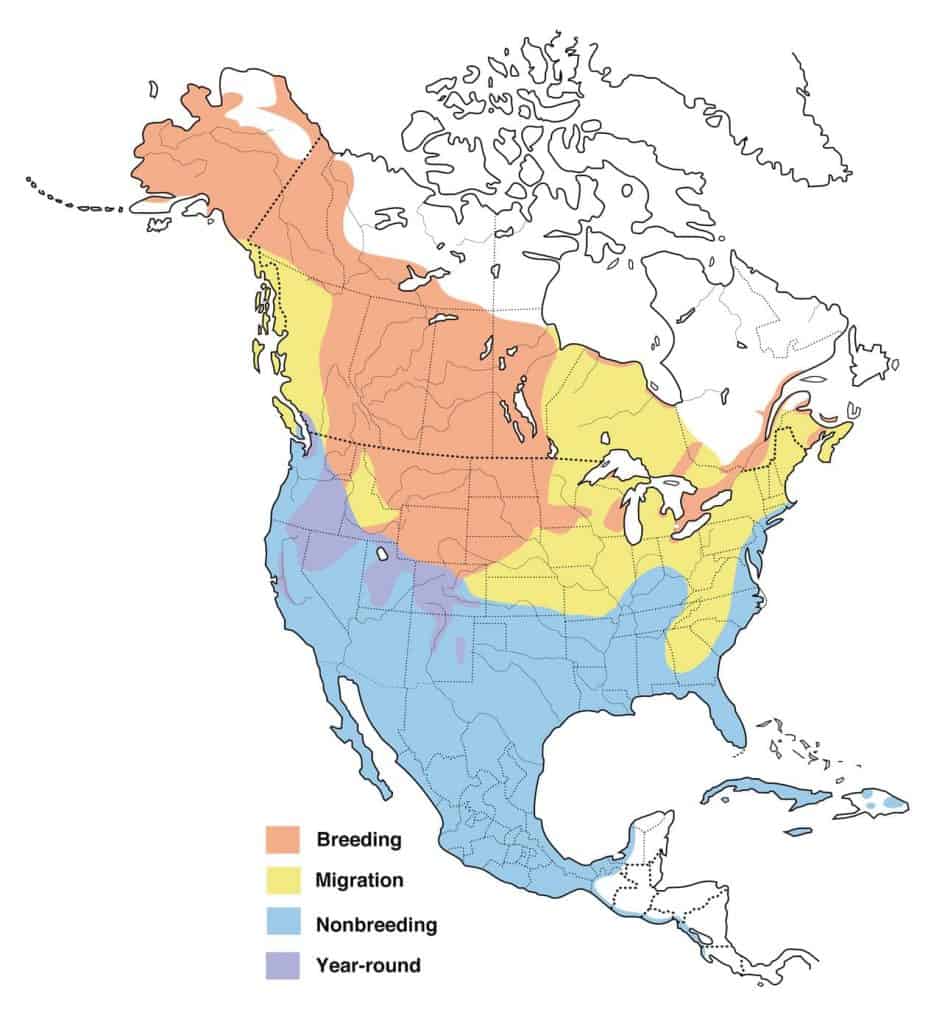
Northern Shrike
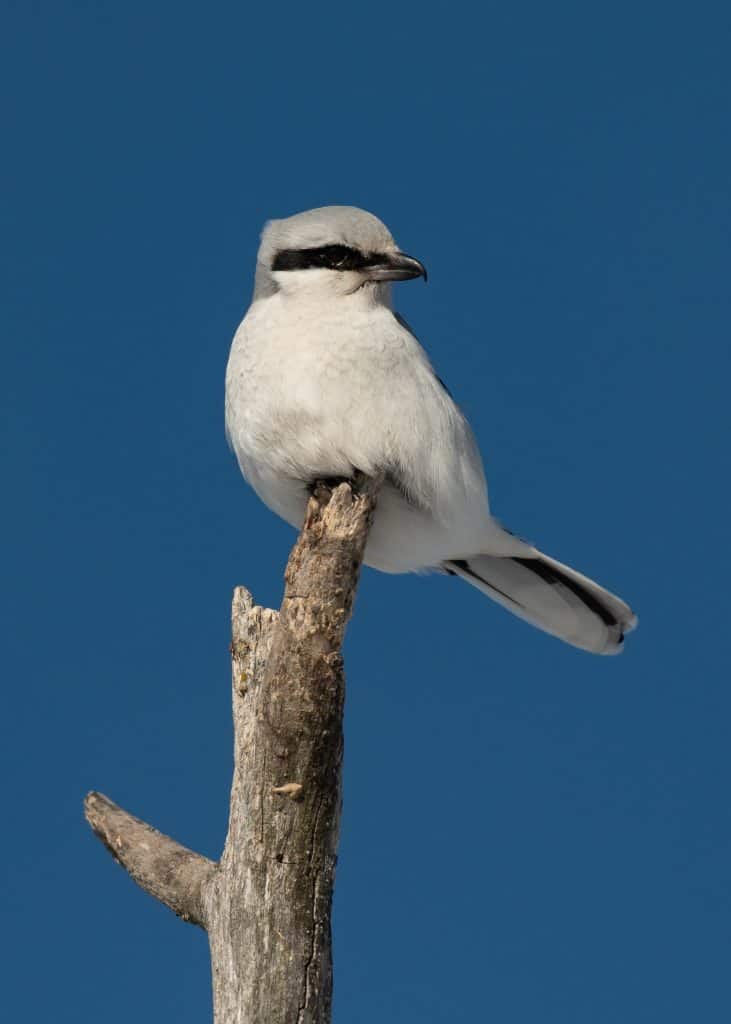
Appearance: Northern shrike is a medium-sized bird about 9.5″ long. They’re gray with white bellies, black wingtips & tails, and a black mask that extends from each eye back to the ear area. Their short bill is notched at the end. Females are the same. Immature northern shrikes are browner.
Diet: Insects, birds, and small mammals.
Feeder food: They may show up at the feeder to hunt feeder birds!
Habitat: Northern shrikes prefer the northern tundra regions, especially where the thick forest meets the tundra. They also are found in open areas.
Nesting: Northern shrikes nest in trees and shrubs, usually 8 feet or higher. They’re not opposed to reusing nests from other birds. They have 1 brood/season, 4-9 gray/green or white eggs/brood, incubation is 14-21 days, and fledglings leave the nest after about 20 days.
Migration: Northern shrikes are migrators. In the spring they migrate north into Alaska and northern Canada regions to breed. Then in the fall, they migrate south into the northern half of the US and southern Canada.
Breeding range: Alaska, Canada’s Yukon Territory, Northwestern Territories, northern Ontario, and Quebec.
Winter range: Northern US states, western states, and Canada’s northern provinces.
Range Map
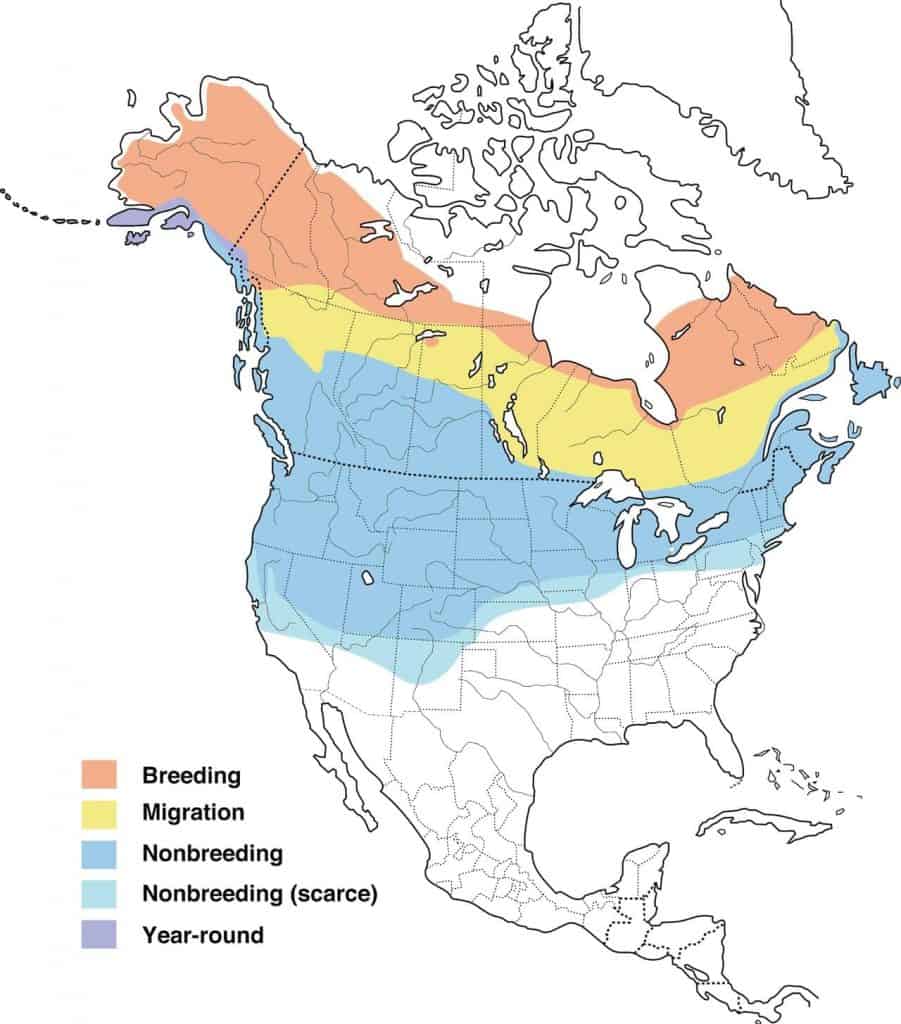
Oak Titmouse
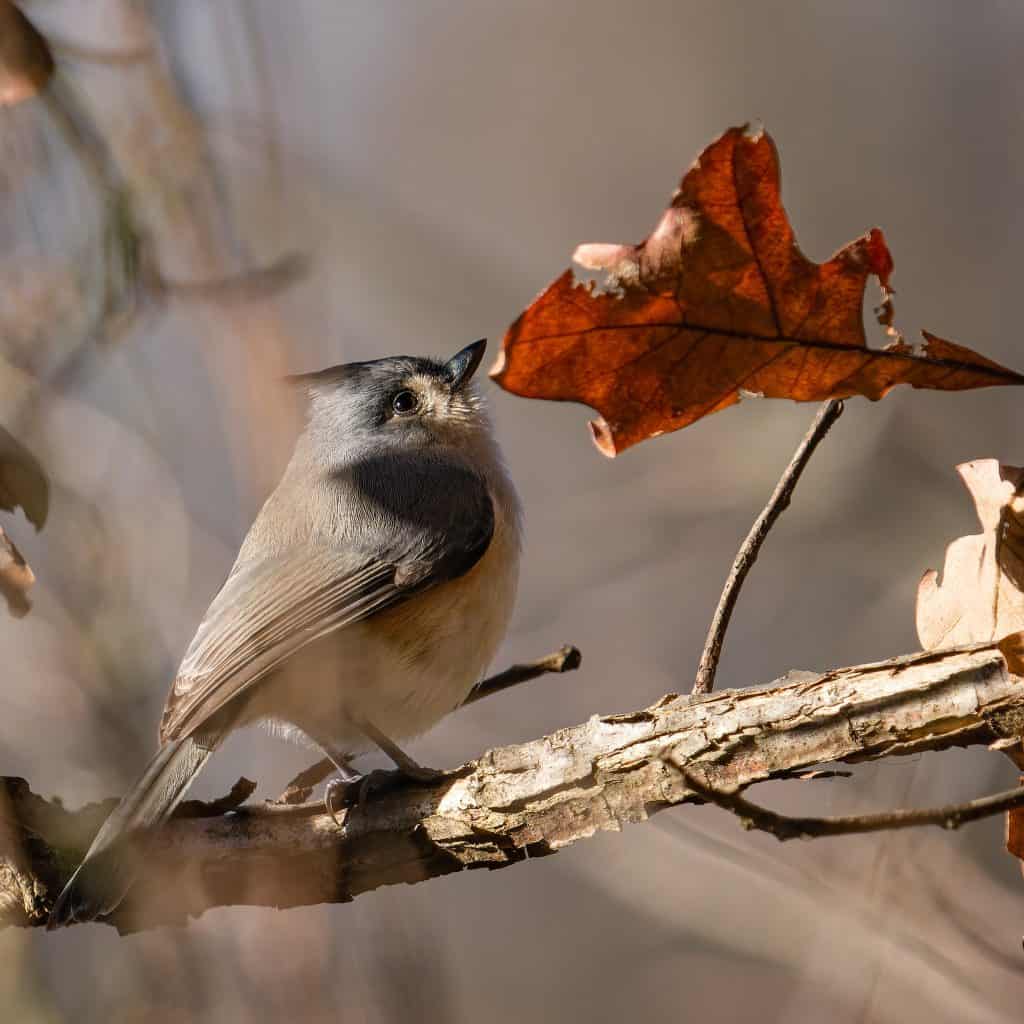
Description: The oak titmouse is a small bird about 5″ long. They have a short crest that they raise/lower depending on level of agitation. They’re primarily grayish brown with paler colored underparts. The females look the same.
Diet: Insects, seeds (especially acorns), buds, berries, and fruits.
Feeder food: Hulled sunflower seed, black-oil sunflower seed, safflower seed, whole peanuts, suet, and mealworms.
Habitat: Wooded areas.
Nesting: Oak titmice are cavity nesters. They prefer an old woodpecker hole or other natural cavity but will also use a manmade nest box. They have 1-2 broods/season, 6-7 white (sometimes speckled) eggs/brood, incubate for 14-16 days, and fledglings leave the nest at about 16-21 days.
Migration: Oak titmice are not migrators. They remain in their year-round range all seasons of the year. Year-round range includes the eastern 1/2 of the U.S.
Range Map
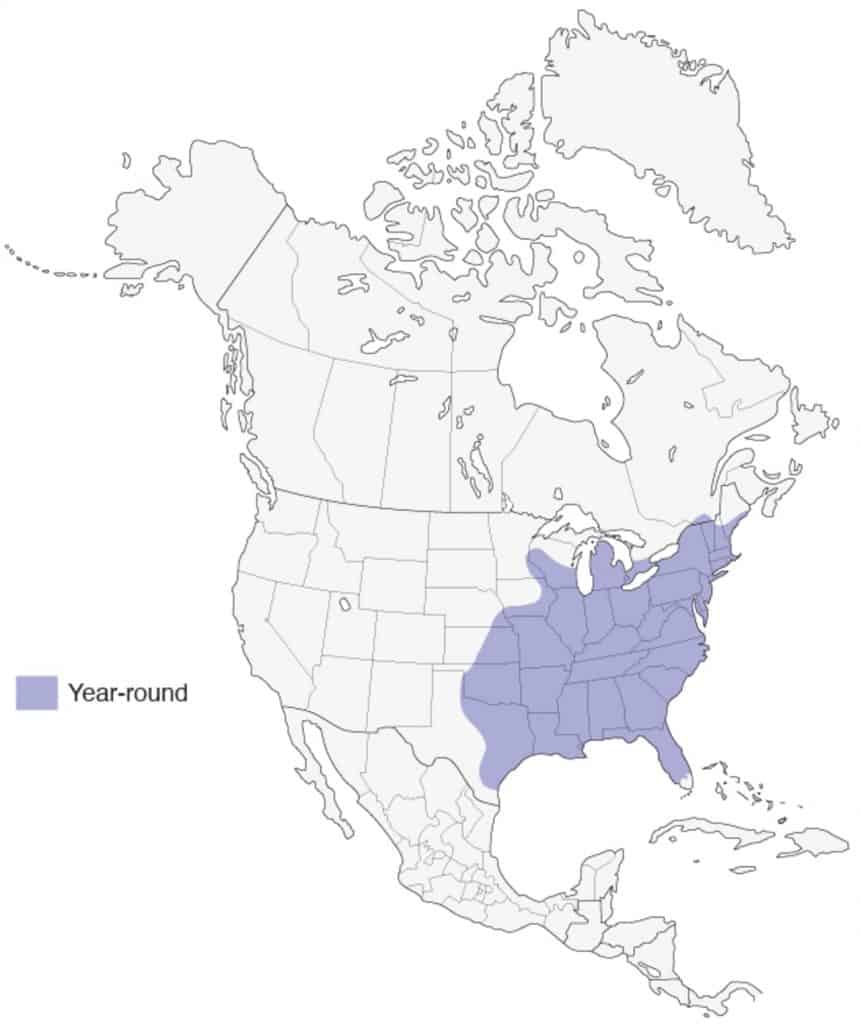
Orange-Crowned Warbler
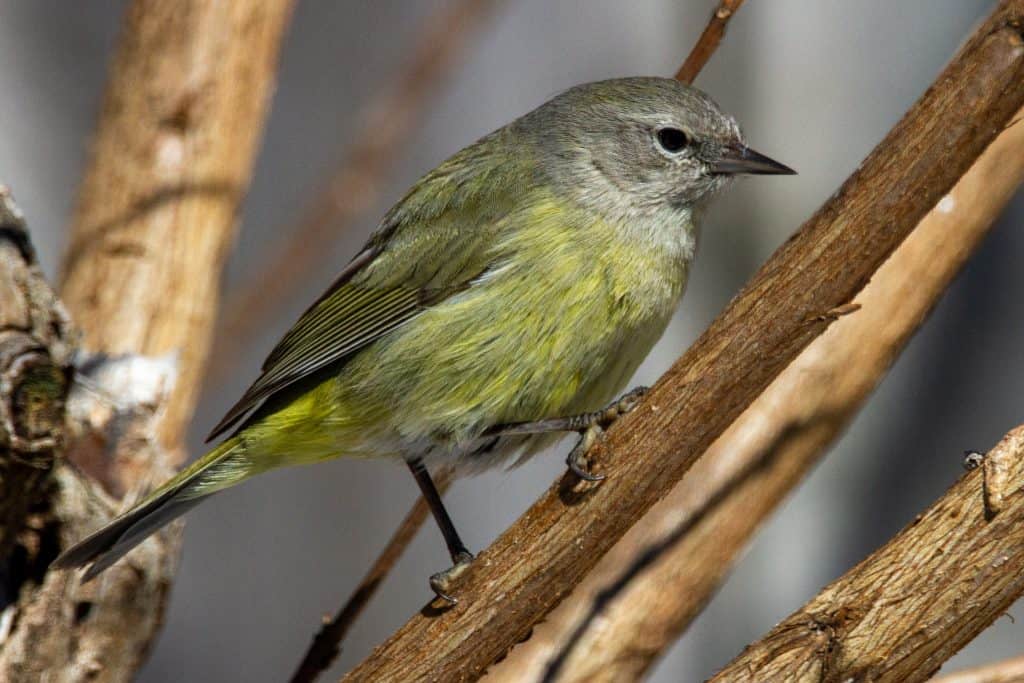
Appearance: The orange-crowned warbler is a small bird about 5″ long. They are olive-green and yellow throughout with an orange crown that is barely visible. There’s a subtle dark line that runs through the eyes. They have yellow underneath that’s smudged with olive green.
Diet: Insects, small berries, and nectar.
Feeder food: Suet and peanut butter spread.
Habitat: The orange-crowned warbler is found in a variety of habitats within its range from low-growing shrubs and thickets to coastal canyons and backyard gardens.
Nesting: They build a cup-shaped nest of twigs and other plant material placed on or near the ground. They have 1 brood/season and 3-6 eggs/brood. The eggs are white/creamy with spots. Incubation is for 11-13 days and fledglings leave the nest at 10-13 days.
Migration: Orange-crowned warblers are migrators. In the spring they migrate north and west to breed and raise young. Then in the fall, they migrate south for winter. That said, they have a small year-round range along the pacific coast (Washington, Oregon, and California) where they remain year-round.
Year-round range: Along the pacific coast of Washington, Oregon, and California.
Breeding range: Alaska, Washington, Idaho, western Montana, Wyoming, Oregon, northern California, Nevada, Utah, Colorado, New Mexico, and all Canadian provinces except Nunavut.
Winter range: Southwest California, southwest Nevada, Mexico, the southern parts of Texas, Mississippi, Alabama & Georgia, South Carolina, southern Texas, Louisiana, Florida, and Mexico.
Range Map
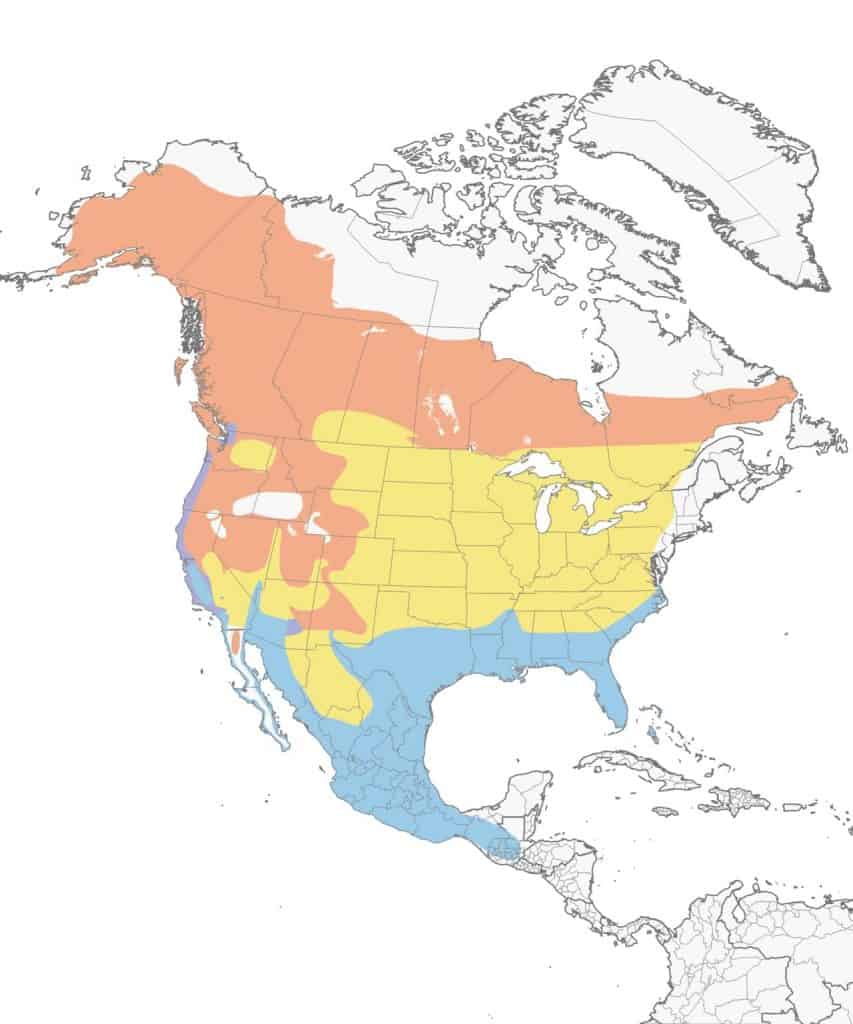
Ovenbird
| Appearance | Small bird about 5″ long. Olive-green with dark brown stripes on chest and belly, black and orange stripes on crown. Black eyes surrounded by a white eyering. Pink legs and short pointy tan bill. The female is the same. |
| Diet | Insects, sometimes seeds. |
| Feeder Food | Unlikely to visit a feeder. |
| Habitat | Forested areas with deciduous and coniferous trees that offer a canopy. |
| Nesting | They nest on the forest floor deep inside the thick trees. They have 1-2 broods/year, 3-6 eggs/brood that are white with brown specks. Incubation is 11-14 days. |
Range Map
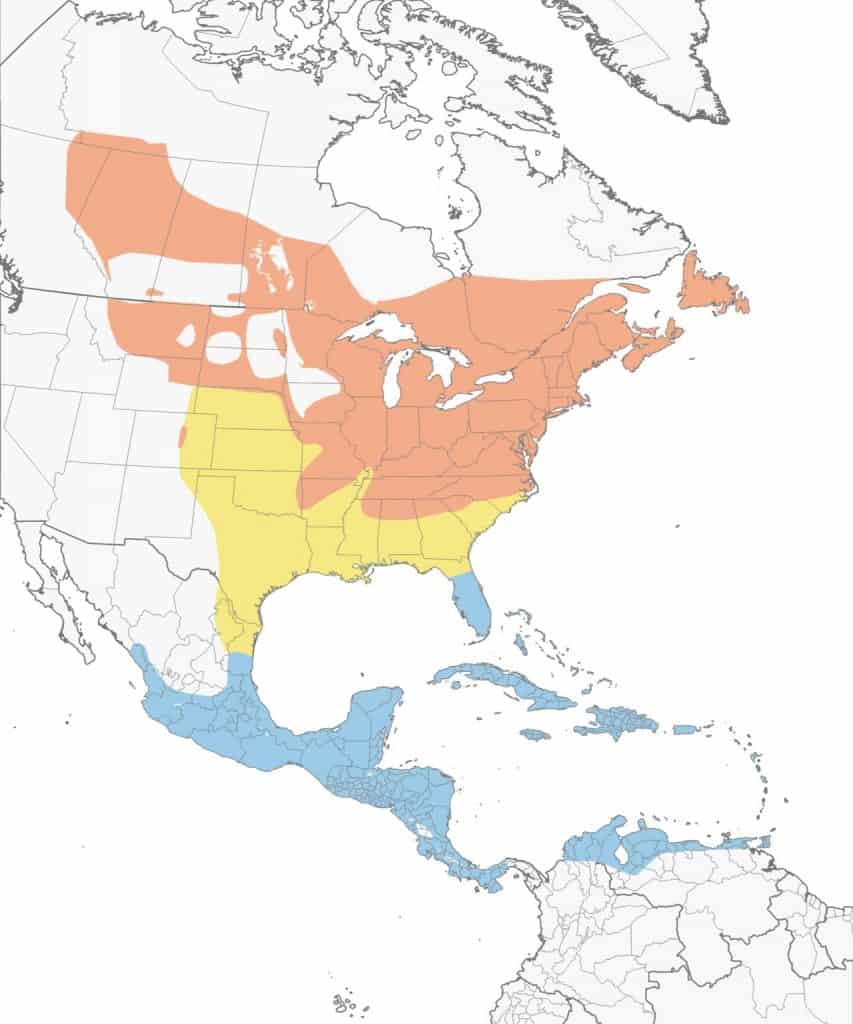
Pileated Woodpecker
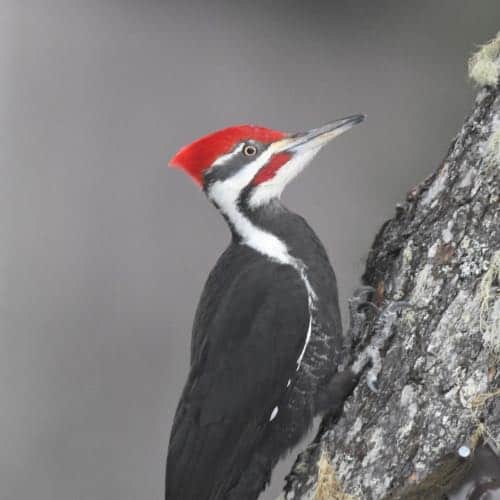
Appearance: A large bird about 19″ in length. They’re mostly black with white stripes on their face and neck with white underwings. The flaming red triangle-shaped crest is unmistakable and the male also has a red stripe on his cheek. The female is the same except her crest does not go all the way to her bill. And, she does not have a red stripe on her cheek.
Diet: Insects, especially carpenter ants.
Feeder food: Suet, shelled peanuts, safflower seed, sunflower seed, and
songbird fruit & nut seed mix.
Habitat: Forests and wooded areas that offer tall deciduous (leafy trees like maple & beech), coniferous trees (like evergreen & pine), and lower fruit & nut-bearing trees & shrubs.
Nesting: They excavate their own cavity in a tree. They have 3-6 white eggs per brood and incubate them for 15-18 days.
Migration: Pileated woodpeckers are not migrators. They remain in their year-round range every season of the year.
Year-round range: Canada’s southern provinces, the west coast of Washington, Oregon & California, and the eastern half of the US.
Range Map
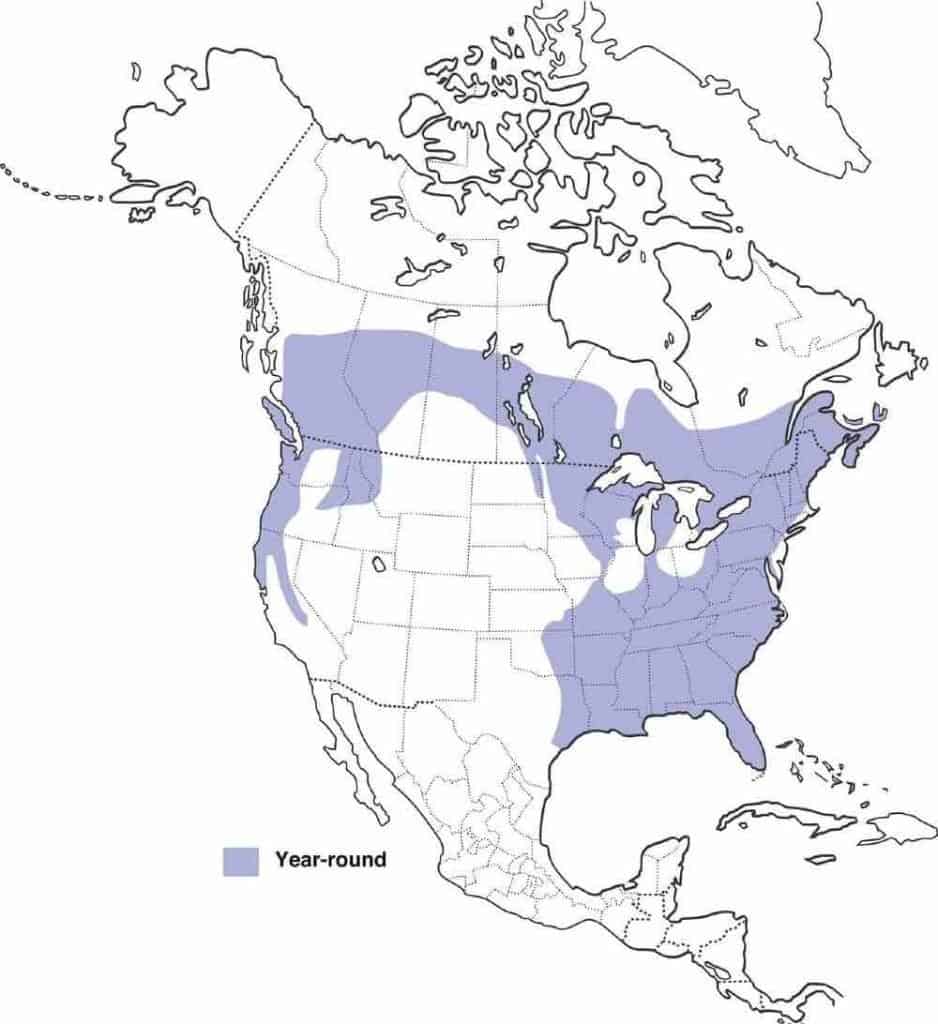
Pine Grosbeak
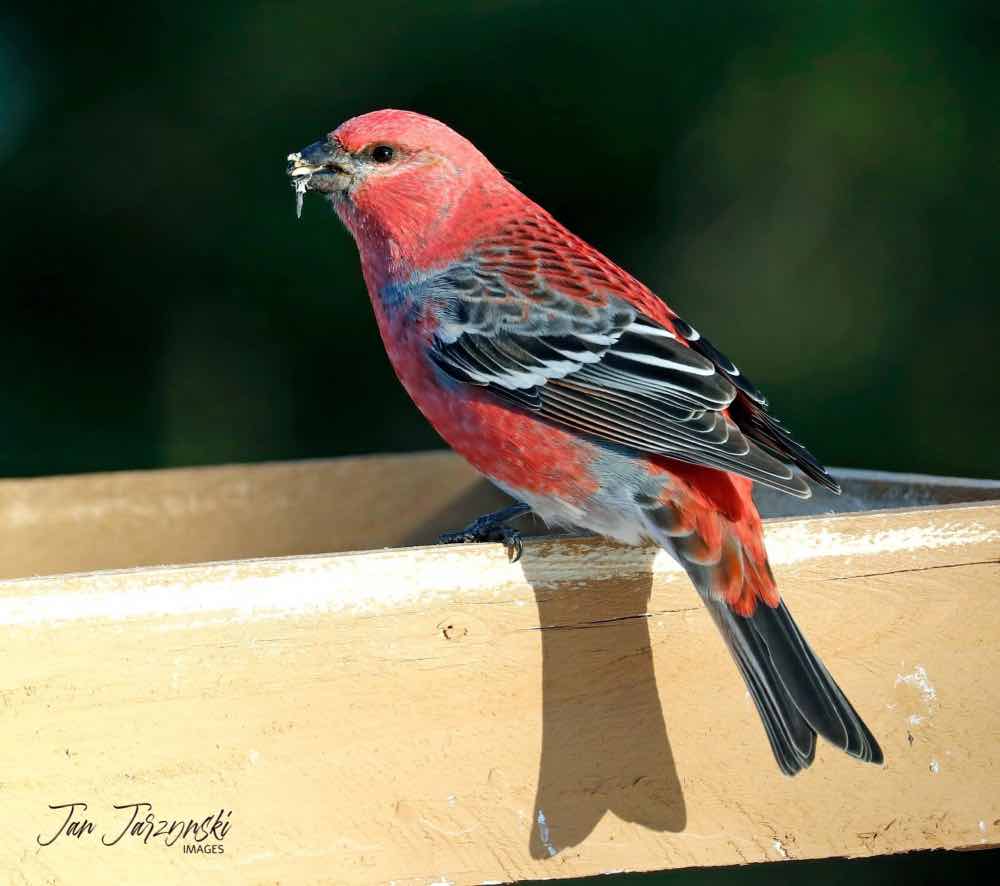
| Appearance | Sturdy bird approx 8-10″ long, soft pinkish-red with gray & charcoal body, short charcoal beak, medium tail with black tip, wings of black, white, and red. No crown. The Female is gray with a yellow head and tail. |
| Diet | Mostly seeds and fruits from their habitat (pine trees). Sometimes supplements with insects. |
| Feeder Food | Black-oil sunflower seeds and suet. |
| Habitat | Open areas with coniferous trees and deciduous trees in winter. |
| Nesting | About 20′ up in evergreen trees rests their rather large nest constructed with roots and twigs then lined grass, pine needles, and feathers. 1 brood/season, 3-4 eggs/brood, incubation lasts 13-14 days and they fledge between 13-20 days. Eggs are light blue and dotted. |
Range Map

Pine Siskin

Appearance: Small brown bird about 5″ long with streaks on the back, breast, and belly. They have some yellow in the wing bars at end of the tail. The Female is the same.
Diet: Seeds, insects.
Feeder food: Black-oil sunflower seeds, hulled sunflower seeds, suet & fruit.
Habitat: Open areas, wooded edges.
Nesting: Cup-shaped nest for 2 broods/year. 3-4 eggs/brood that is green/blue with brown spots. Incubation is 12-13 days.
Migration: While some pine siskins remain in their year-round range, most are migrators. In spring, the migrators head south to Canada to breed and raise their young. Then in the fall, they migrate south for the winter.
Year-round range: The northern edge of the US, the Pacific Northwest states, the southern edge of the Canadian provinces, and the central strip of Mexico.
Breeding range: Alaska’s southeastern corner, the southern part of Canada’s Northwest Territories, the northern part of British Columbia, Alberta, Saskatchewan, Manitoba, Ontario, and Quebec.
Winter range: The entire US (outside of the year-round range).
Range Map
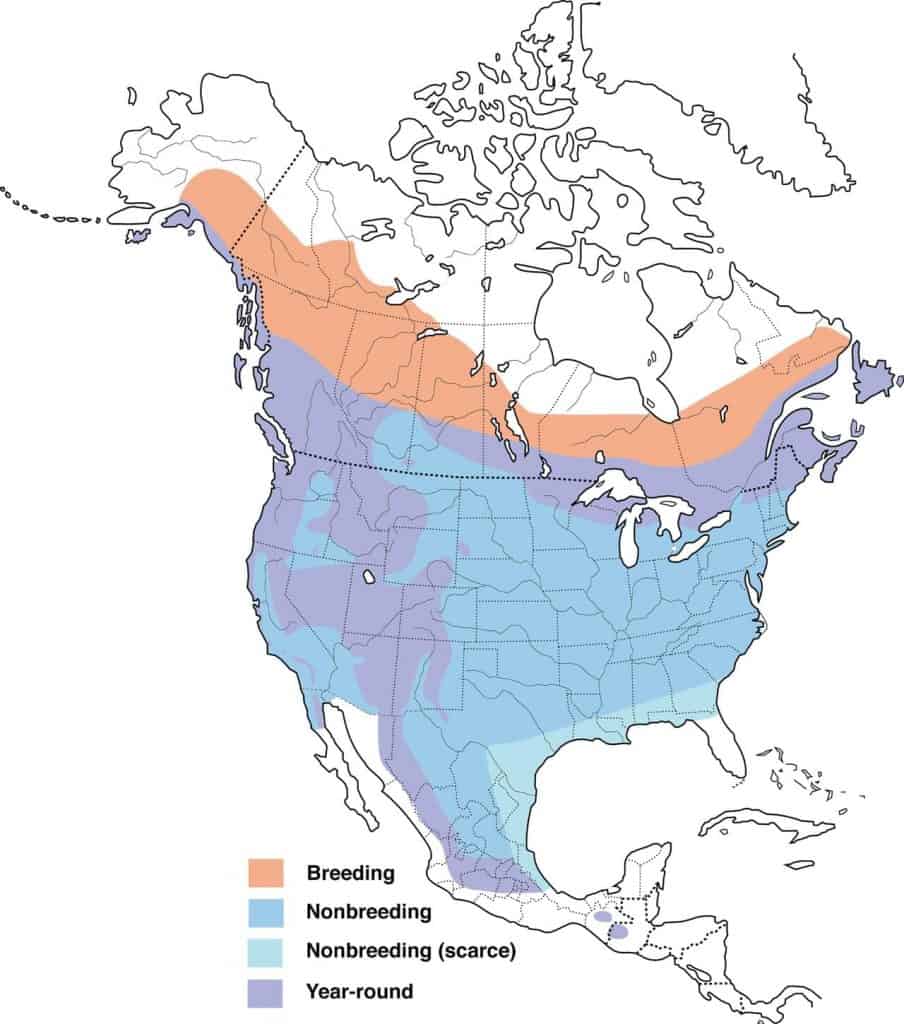
Pine Warbler
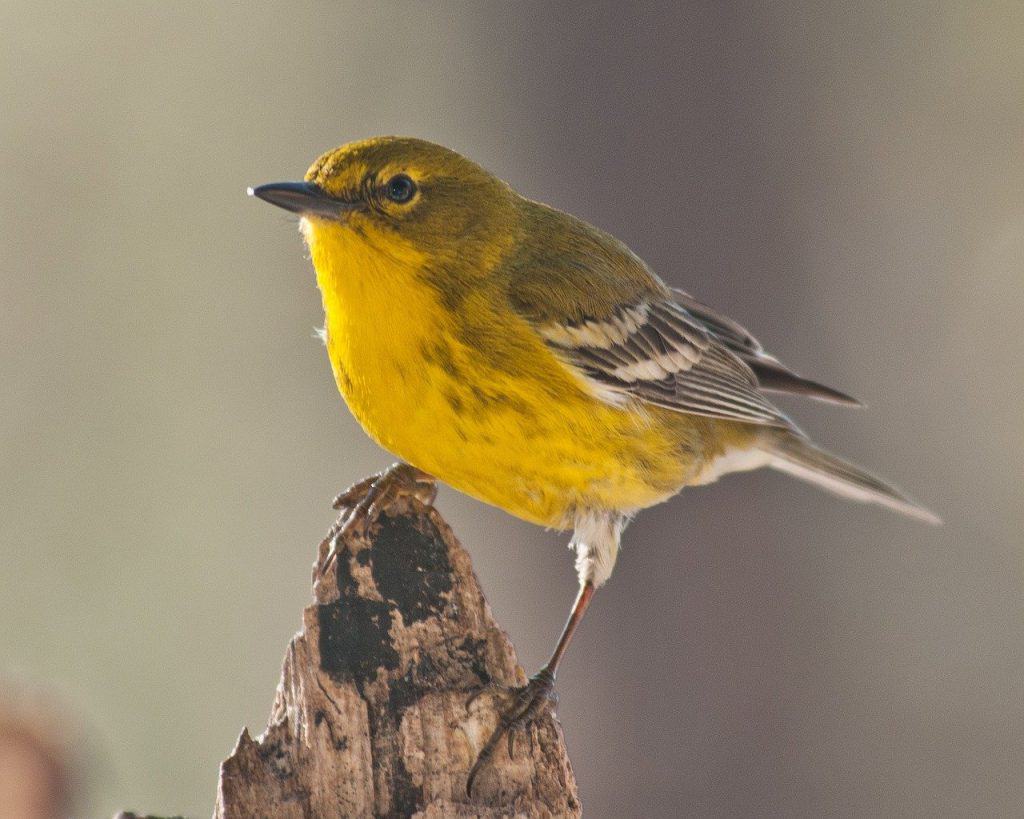
Appearance: The pine warbler is a yellow bird about 5 1/2″ long. The wings are brown with white and rump tan. They have short stubby bills, a subtle dark streak behind the eye, and bright yellow eyering. The female is duller and has a white belly.
Diet: Insects, berries, and seeds.
Feeder food: Millet, sunflower seed, cracked corn, peanuts, and suet.
Habitat: Mixed forested areas.
Nesting: Pine warblers build their open-cup nest high in a pine tree – as high as 50′ up. They have 1-2 broods/season and 4 eggs/brood. Incubation is for 10 days and fledglings leave the nest after 10 days.
Migration: Many pine warblers are migrators. While a population of this species remains in their year-round range all seasons of the year, many migrate north and east to in spring to breed and raise their young. Then in the fall, the migrators return south to the year-round range of further southwest to the winter expanded range.
Year-round range: Texas, Oklahoma, Arkansas, Mississippi, Alabama, Georgia, Florida, South Carolina, North Carolina, and Virginia.
Breeding range: northern Minnesota & Wisconsin, Michigan, southern Illinois & Indiana, eastern Ohio, Kentucky, Tennessee, and New England.
Winter range: Southeast Texas, southern Arkansas, and Louisiana.
Range Map
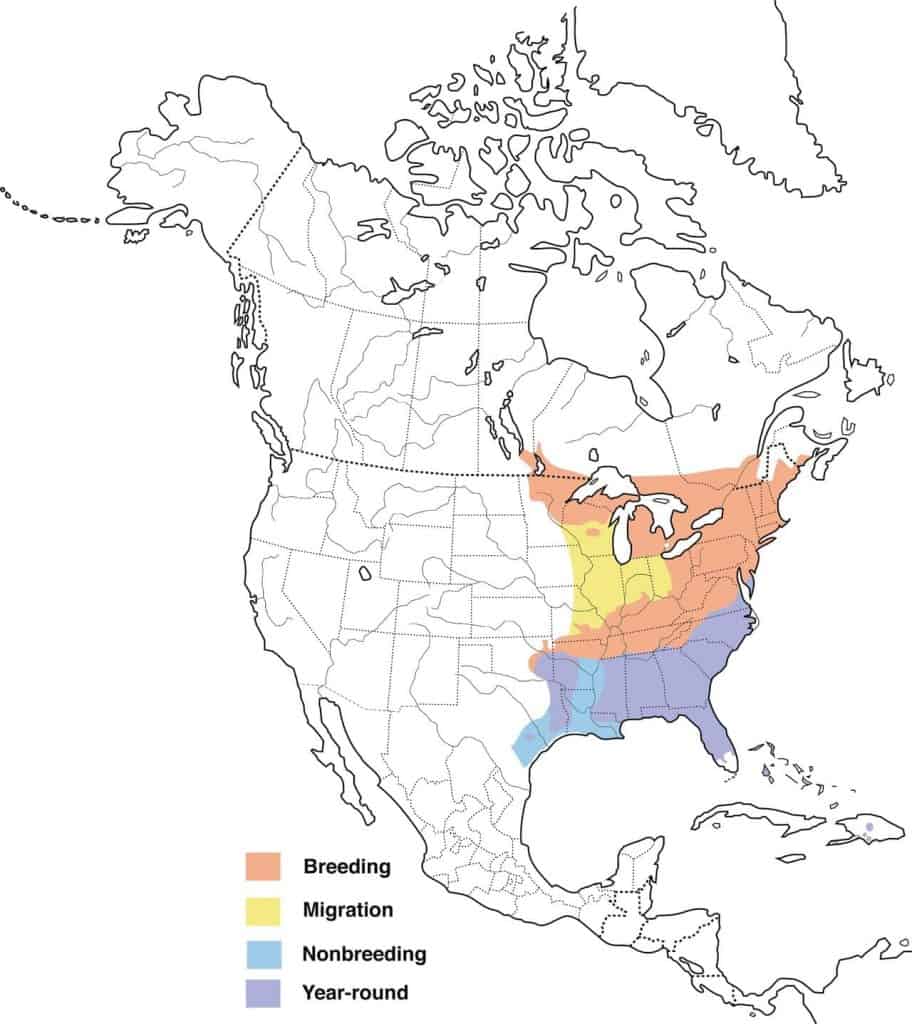
Prairie Warbler
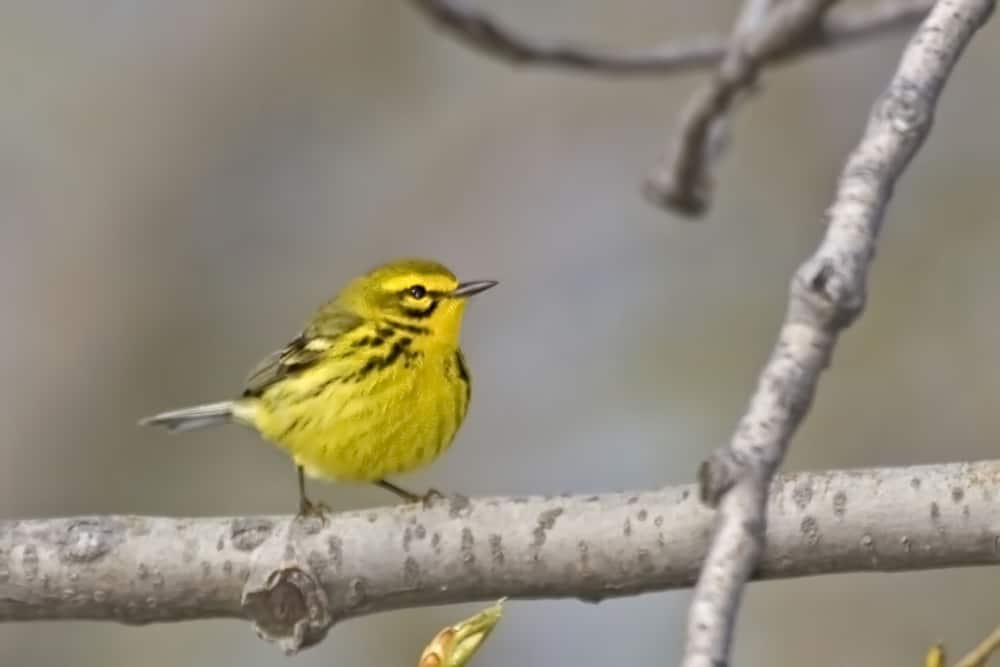
| Appearance | A small yellow bird about 4 1/2″ long with black streaks on the belly, black eyeline,r and swipe under the eye. A chestnut patch shows on the back. Females are the same but more muted with a gray head and white eyering. |
| Diet | Insects and snails. Fruit and other plants on occasion. |
| Feeder Food | Unlikely to visit a feeder. |
| Habitat | Low woody vegetation with plenty of open canopies, edges of wooded areas. |
| Nesting | Nests are cup-shaped and located in thick tangles of shrubs less than 7 feet high. They have 1-2 broods/year, 3-5 eggs/brood that are brown/gray with scattered spots. Incubation is 10-15 days. |
Range Map
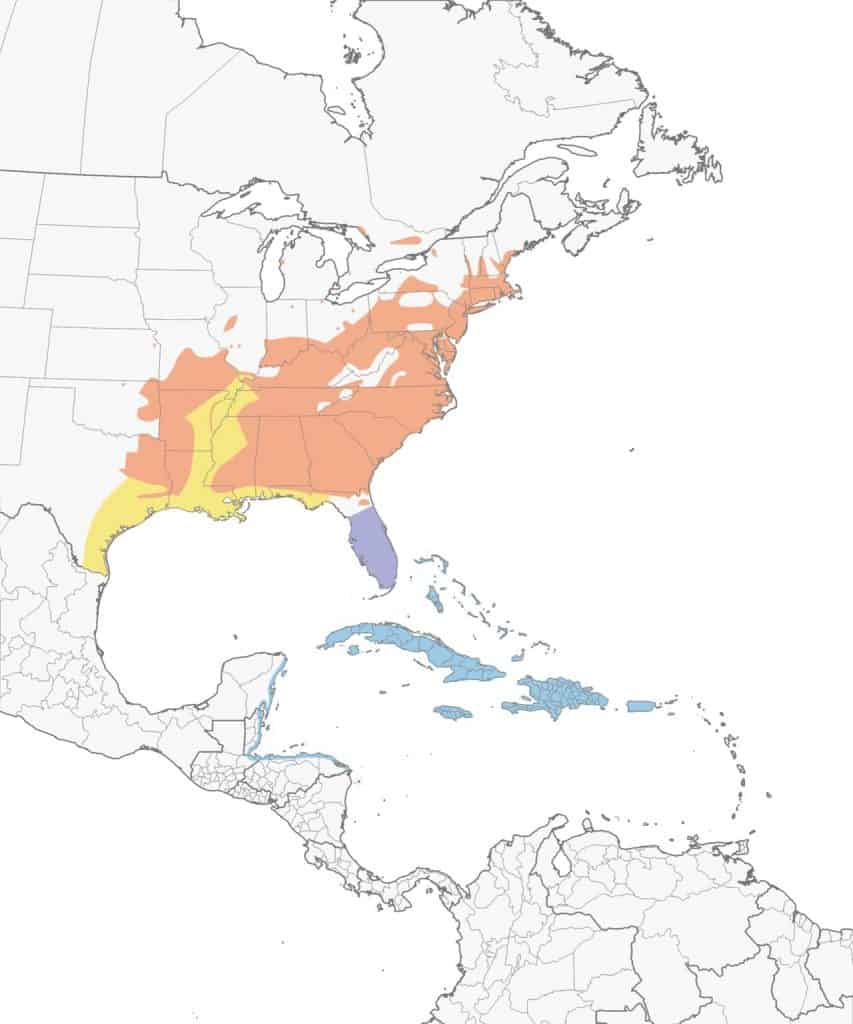
Purple Finch

Appearance: Small bird about 6″ long with a raspberry-red head with lighter shades on the breast, back, and rump. The wings and tail are brown. Females are brown with brown striped breasts and white streaks across their eyes.
Diet: Seeds, insects, and fruit.
Feeder food: Black oil sunflower seeds are their favorite.
Habitat: Prefer coniferous forests in summer along with mixed forests near streams and tree-lined backyards.
Nesting: Purple finches’ nests are found anywhere from 2-60′ off the ground on a tree branch and constructed from twigs, sticks, and plant roots. Lined with grass and hair.
Migration: Purple finches are migrators. While many of them remain in their year-round range, others migrate north in the spring to breed and raise young. Then in the fall, the migrators head south for the winter.
Year-round range: The Pacific coast of Washington, Oregon, and California, and Canada’s British Columbia.
Breeding range: Just east of the year-round range along the Pacific northwest states and Canada’s provinces except for Nunavut.
Winter range: The eastern half of the US (except New England) and southern Arizona.
Range Map
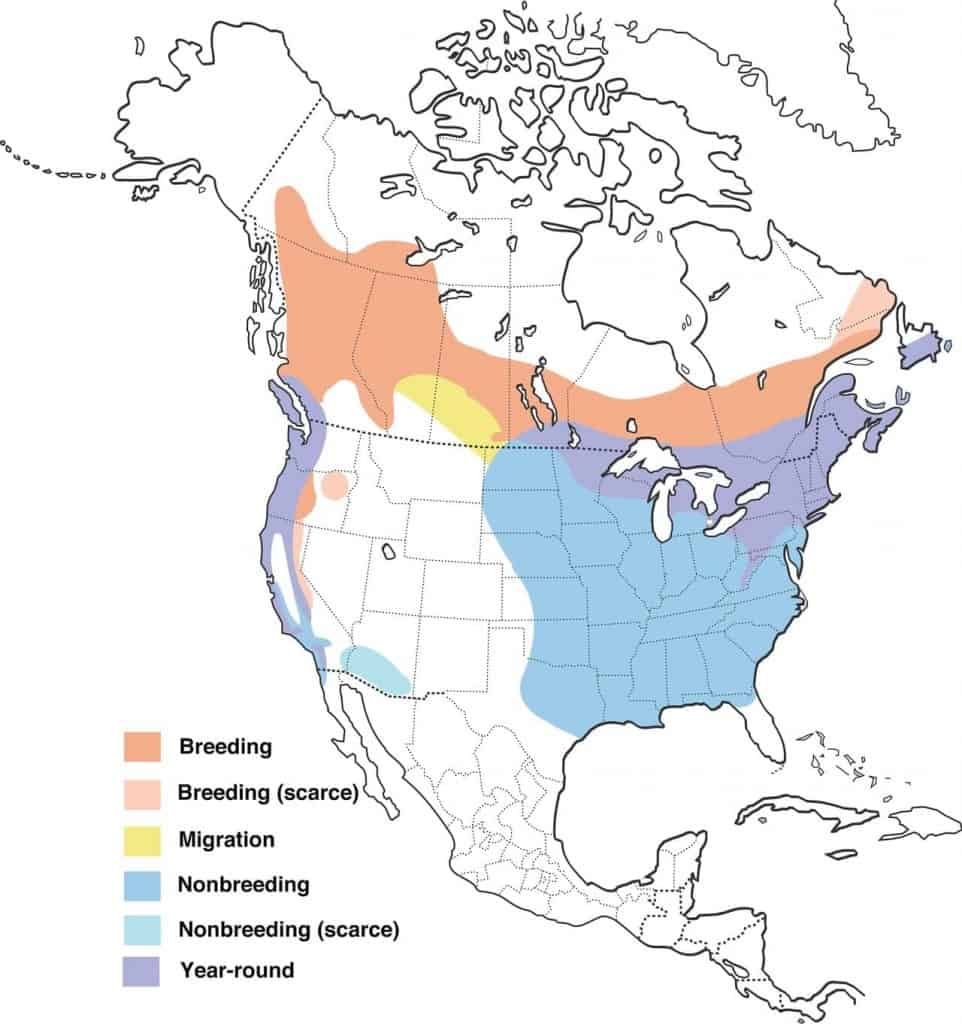
Purple Martin
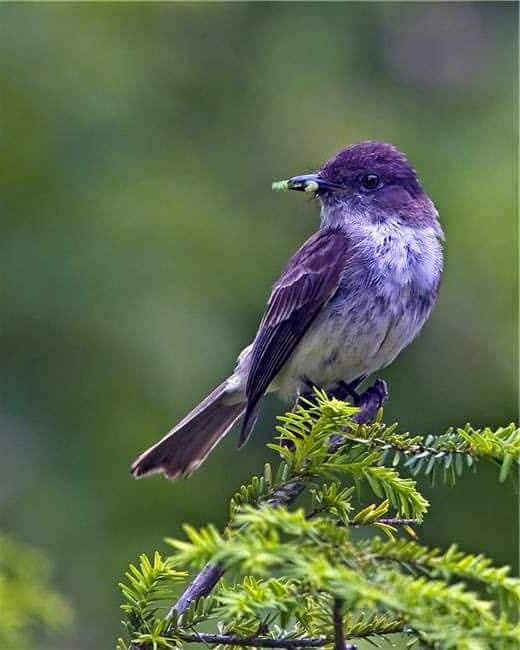
Appearance: The purple martin is a medium bird about 8.5″ long with a blue/purple head, back, and belly with black wings and tail.
Diet: Insects especially dragonflies.
Feeder food: Unlikely to visit a feeder.
Habitat: Usually within 100′ of human dwelling. Purple Martins exist in large colonies.
Nesting: Purple martins are cavity nesters. They primarily use manmade nest boxes which accommodate a colony of birds. They have 1 brood/season, 4-5 white eggs/brood, 15-18 days incubation, and fledge after 26-30 days.
Migration: Purple martins are migrators. They spend the winters in South America and migrate north to breed and raise young.
Breeding range: Pacific northwest coast of Washington, Oregon, and California, parts of Arizona, Utah, and Colorado, the eastern half of the US, and the southern parts of Canada’s Alberta, Manitoba, Saskatchewan, and Ontario.
Winter range: South America
Range Map

Red Crossbill
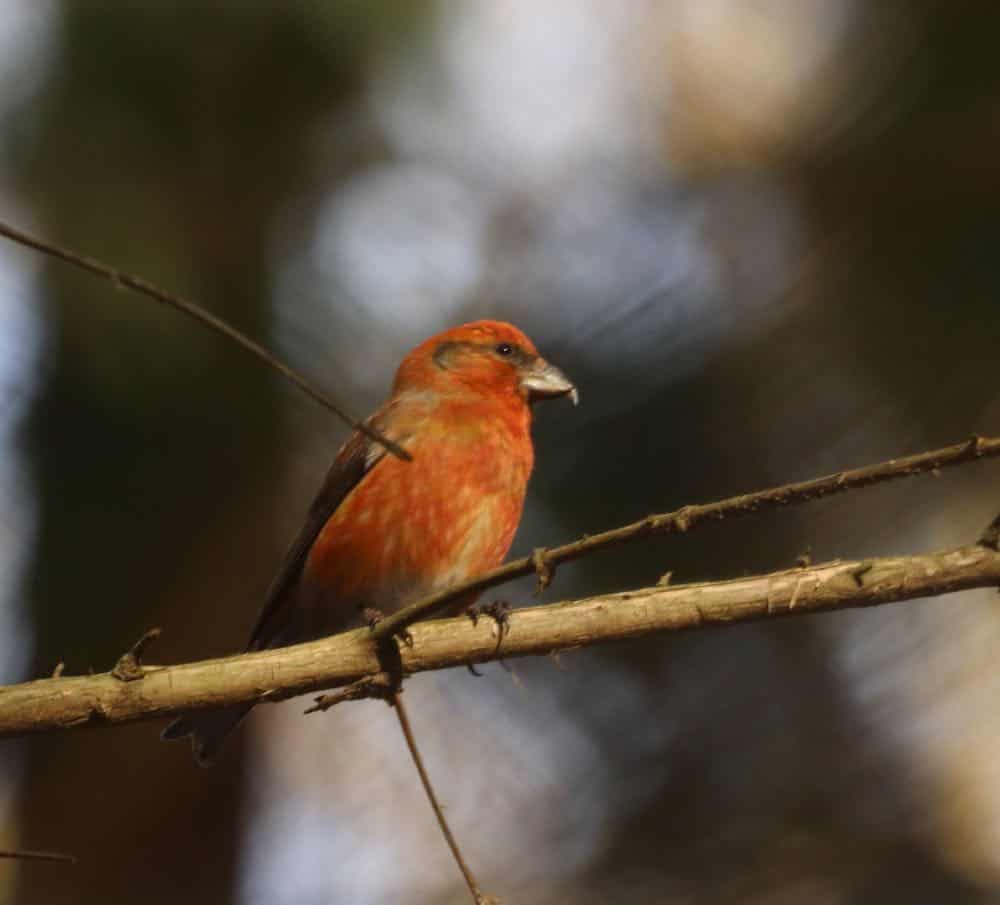
Appearance: The red crossbill is a small bird about 6.2″ long, dark red-orange with brown singes and tail. Their bill is long, pointed, and “crossed”. A brighter color of red on the head and rump. No crown. The female and young are pale yellow and gray.
Diet: Seeds – especially those inside pinecones. The bird’s “crossbill” is designed to pry open pinecones to get at the seed inside.
Feeder food: Black oil sunflower seed.
Habitat: Red crossbills either remain in their year-round territory for winter or expand south to create a wide winter range that includes Canada, the Pacific Northwest, states west of the Great Plains, Minnesota, Wisconsin, Michigan, New York, Vermont, Connecticut, and Massachusettes. They prefer mature coniferous forests.
Migration: While many red crossbills remain in their year-round range all seasons of the year, many migrate south for the winter.
Year-round range: The western half of the US, Mexico, and all Canadian provinces except Nunavut.
Winter range: Primarily northern Nevada, eastern Montana, North Dakota, South Dakota, northern Kansas, southern Minnesota & Wisconsin, northern Michigan, Pennsylvania, and New England. To a lesser degree, the remaining southern US states.
Range Map
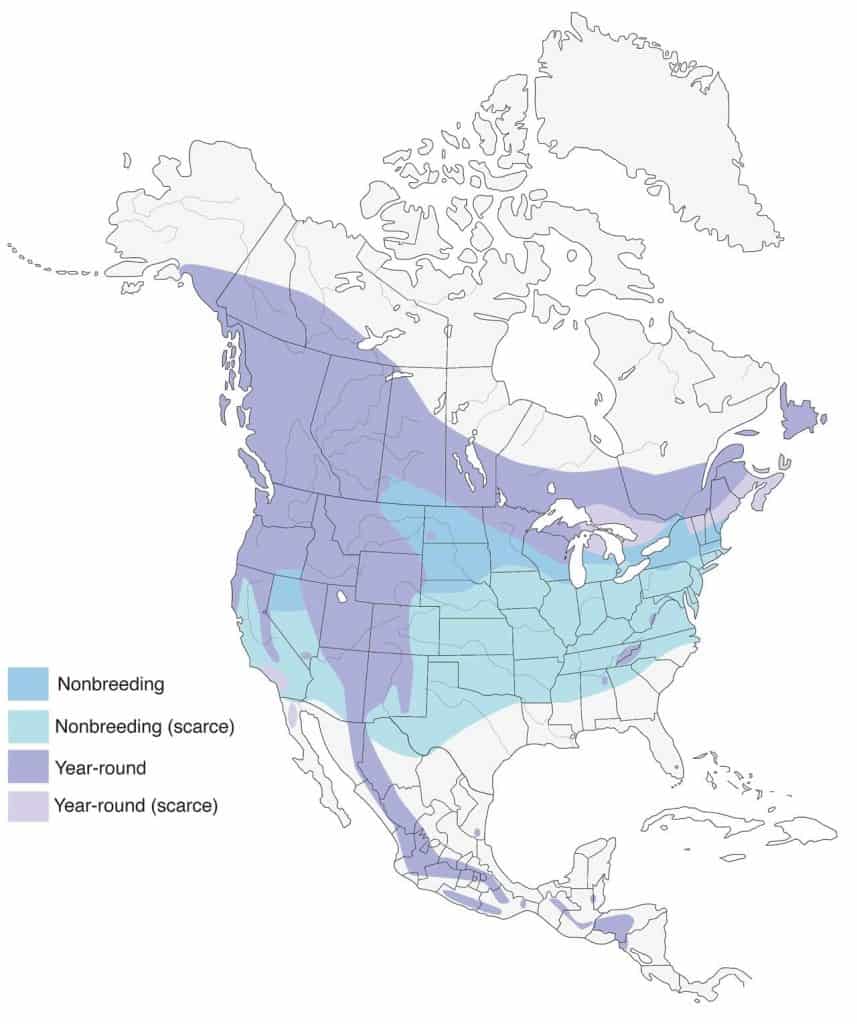
Red-Bellied Woodpecker
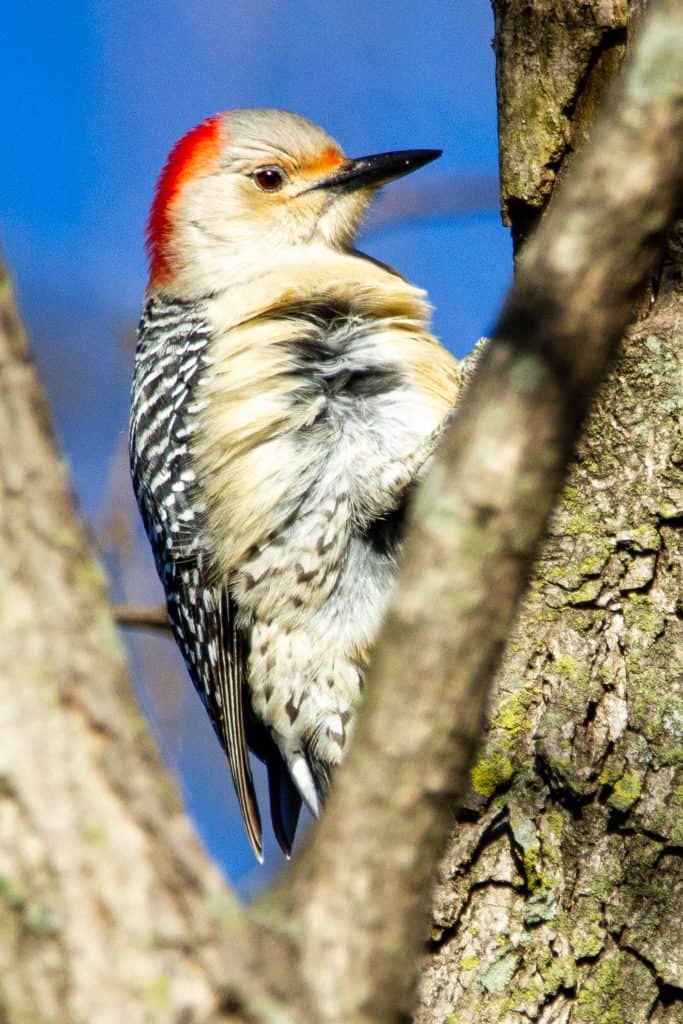
Appearance: The red-bellied woodpecker is a medium-sized bird about 9 1/4″ long. They have a zebra-like striped back with a white rump. The red crown extends down the nape of the neck. The chest is tan with just a tinge of red on the belly. The females are the same except they don’t have a red crown.
Diet: Insects, nuts, fruit.
Feeder food: Suet, hulled peanuts.
Habitat: In or near forests and woodlands.
Nesting: Red-bellied woodpeckers are cavity nesters and prefer dead trees or fence posts. They have 1-3 broods/year and 2-6 eggs/brood. Eggs are white without markings. Incubation is 12-14 days.
Migration: Red-bellied woodpeckers are not migrators. They remain in their year-round range all seasons of the year.
Year-round range: Eastern half of the US but not New England.
Range Map
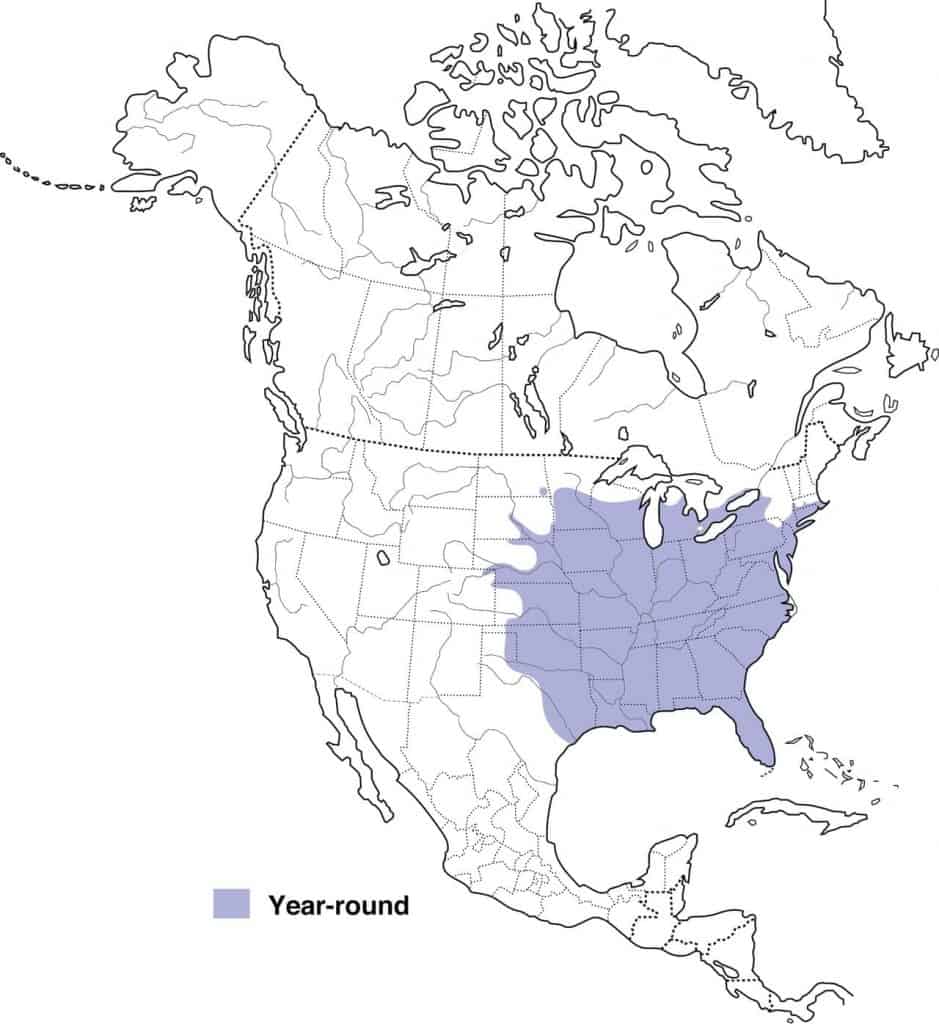
Red-Breasted Nuthatch
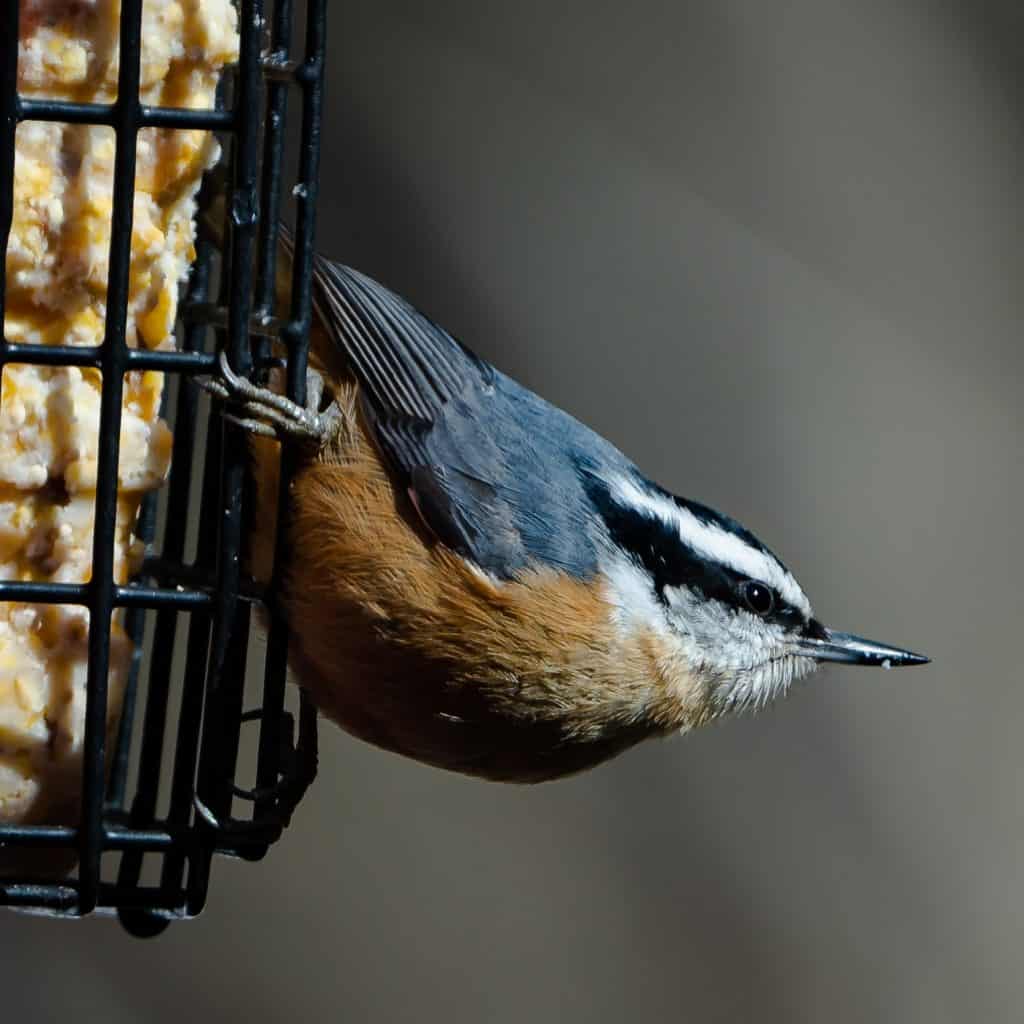
Appearance: The red-breasted nuthatch is a small bird about 4.5″ long, with gray/blue backs, a white head with black stripes running over either eye, orange-cinnamon-colored breast, and a pointy pick-like beak. The females look the same except their underside is a more faded color. Usually spotted climbing upside-down on a deciduous tree foraging for insects beneath the bark.
Diet: Insects, spiders, and other bugs.
Feeder food: Suet, sunflower seeds, shelled peanuts, fruit.
Habitat: Forested areas primarily comprised of coniferous trees (i.e. pines). Woodsy areas of deciduous trees in the east. Southern birds prefer mountainous regions until winter comes in which case they head to lower land.
Nesting: Red-breasted nuthatches are cavity nesters and they prefer to excavate their own holes. They have 1 brood/season, and 6 eggs/brood, eggs are white & speckled with red-brown.
Migration: Red-breasted nuthatches are partial migrators. While many remain in their year-round range, others migrate south for winter.
Year-round range: Southern Alaska, states in the western third of the US, northern Minnesota & Wisconsin, Michigan, Pennsylvania, and New England as well as all Canadian provinces except Nunavut.
Winter range: US states that are not part of the year-round range.
Range Map

We midwesterners are lucky – we get to experience so many different species of birds that live or are just passing through. Keep this article handy. When you see an amazing wild bird in Michigan I guarantee you’ll want to know the species and details about it. Trust me!
Happy Birding!
Sources
All About Birds. The Cornell Lab of Ornithology. 2021
eBird. The Cornell Lab of Ornithology. 2021
Noah, Strycker, and Alderfer Jonathan. National Geographic Backyard Guide to the Birds of North America. 2nd ed., National Geographic, 2019.
